Wander-Lush

The Ultimate Spanish Road Trip Itinerary: Barcelona to Seville
Plan your dream road trip through Spain with this epic Spanish road trip itinerary! I’ll show you how to spend a perfect 3 weeks in Spain travelling from Barcelona to Seville, plus everything you need to know about renting a car to self drive in Spain.
I was part-way through planning a six-week Eurotrip with my partner when I became fixated on visiting Spain.
Spain had never really factored into my travel plans. But as soon as I realised just how much variety the country has to offer – from majestic mountain villages and enthralling cities to romantic small towns and a postcard-perfect coastline – not to mention the sheer number of historical and UNESCO sites held within its borders – I decided we should spend a whole three weeks in Spain.
Wanting to pack as much into our short stay as possible, we thought renting a car for a Spanish road trip would be the best way to see the main sights plus a few smaller towns.
We were right – the action-packed Spain itinerary we devised saw us criss-cross the country from north to south, taking in most of the country’s top attractions .

Spain is one of the top places for a self drive holiday in Europe. Both rental cars and petrol are relatively affordable. Travelling in shoulder season (November), we were often the only car on the road. For the most part, parking is cheap, even in hot spots like San Sebastian.
Best of all, having our own transport opened up a lot of opportunities to visit smaller towns and squeeze more into each day than our slow travel style would normally permit. Our trip was certainly fast-paced, but it was worth it to get a good overview of Spain in a short period.
This tried-and-tested itinerary for a three week self drive road trip across Spain includes my top recommended activities for key cities, ideas for where to break the journey, some handy Spain driving tips, and much more.
Please note: This post contains affiliate links, meaning I may earn a commission if you make a purchase by clicking a link (at no extra cost to you). Learn more.
Where to hire a car in Spain
Hiring a car in Spain is an efficient and affordable way to see a large part of the country in a short period of time. Since a lot of visitors drive in Spain, the market for rental cars is competitive, meaning you can usually get a pretty good deal.
We planned our Spain road trip from Barcelona, so we decided to rent our car on our last day in the city. I recommend collecting your car from Barcelona-Sants train station because it’s easy to get to using public transport, and easy to leave from to get to the highway.
There are two main things to consider when choosing a hire car: transmission type, and size of the vehicle. Manual cars are much more ubiquitous in Spain so it can be harder to find an automatic car to rent. In addition, you should prioritise hiring a small car that will be easier to park on the street and can better navigate narrow village roads (these were our two biggest qualms about driving in Spain!).
Discover Cars lets you easily browse and compare different rentals cars from a variety of international and local agents. It lets you choose the exact features you want, and offers a full range of price and date options so you can find the best value for money. Visit Discover Cars and plug in your dates to see what’s available .
At the end of the itinerary, I’ve included a few driving tips for Spain.
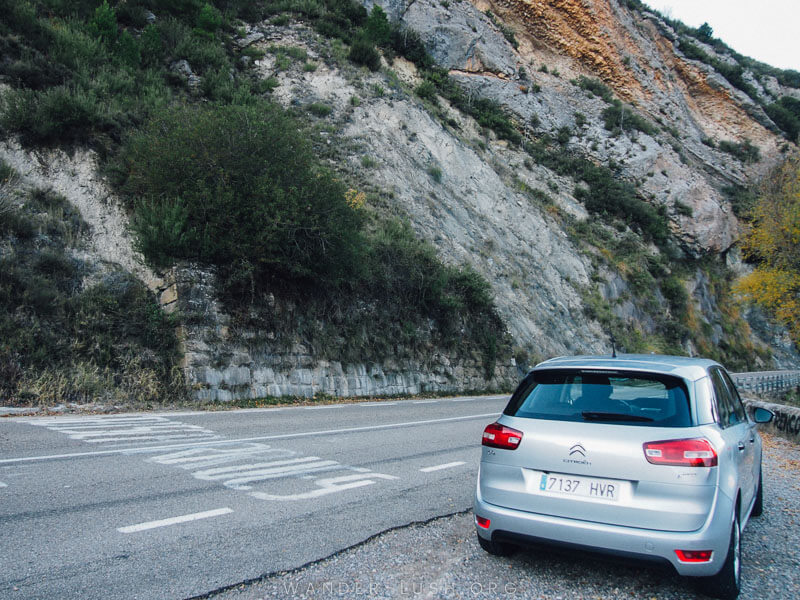
About this Spain itinerary
Looking back over our itinerary makes my head spin a little! We drove almost every day and covered a lot of ground, but by splitting the long drives up into smaller journeys, we still got to visit some interesting local towns.
Spanish highways are incredibly easy to drive on and the scenery is invariably stunning no matter where in the country you are. Because of this, driving never really feels like a drag – it’s all part of the experience.
We started our road trip in Spain from Barcelona and finished up in Seville. From there, we continued on to Tarifa by bus and caught the ferry to Tangier, Morocco. You can adapt this itinerary to create a loop, but I recommend paying the one-way car rental fee so you don’t have to backtrack. If your Spain trip ends there and you’re not continuing on to Morocco , you can fly straight out of Seville.
There are endless options and itinerary combinations for seeing Spain by car. I’m not saying mine is the best road trip in Spain – but I can tell you that it’s tried and tested. Of course there are some things missing (you can’t possibly see all of Spain in 3 weeks), but after I did this road trip, I felt like I’d seen the main highlights.
If I had my time again, I would extend our stay in Madrid by a few days.
A good way to save time is by taking advantage of the Spain day trips and tours mentioned in this itinerary. If you think there’s too much packed in, you can easily take out a few places and stay in certain locations for longer (Madrid and Granada would both be ideal places to extend your time).
How much time do you need to drive across Spain?
A Spain road trip can be as long or as short as you want it to be. As you’ll see from the map, we covered most of the country (apart from the north-west) in 21 days touring Spain by car.
Remember you don’t want to rush driving across Spain too much. Three weeks is the absolute minimum amount of time you need for a Spain road trip like this one – unless you’re prepared to seriously cut down on the number of places you visit.
This 3-week self drive Spain itinerary is fast-paced, but if it’s a once-in-a-lifetime trip to Spain that you’re planning, you probably won’t mind hustling to see as much of this beautiful country as humanly possible.
If you have less time in Spain, you can do a shorter itinerary that focuses on the North of Spain (Basque Country) or the South of Spain (Andalusia).
Spanish road trip route overview & drive times
Let’s start with a basic overview of our Spain road trip itinerary and the 17 cities, towns and villages we visited in Spain in 3 weeks.
Remember you don’t have to follow this itinerary exactly – you can use it as a Spanish road trip planner to pick and choose the destinations that most appeal to you.
- Days 1-3: Barcelona
- Day 4: Barcelona to Sos del Rey Católico via Zaragoza (400km; 4.5 hours of driving)
- Day 5: Sos del Rey Católico to Bilbao via Pamplona and San Sebastián (217km; 2 hours of driving)
- Day 6: Bilbao
- Day 7: Bilbao to Madrid via Segovia (400km; 4 hours of driving)
- Day 8: Madrid
- Day 9: Madrid to Toledo (72km; 1 hour of driving)
- Day 10: Toledo to Valencia via La Mancha (270km; 4 hours of driving)
- Day 11: Valencia
- Day 12: Valencia to Cartagena (270km; 3 hours of driving)
- Day 13: Cartagena to Lanjarón (330km; 3.5 hours of driving)
- Day 14: White Villages and the Sierra Nevada
- Day 15: Lanjarón to Granada (46km; 45 minutes of driving)
- Day 16: Granada to Córdoba (200km; 2.5 hours of driving)
- Day 17: Córdoba
- Day 18: Córdoba to Seville (145km; 1.75 hours of driving)
- Days 19-20: Seville
- Day 21: Depart Seville – or Seville to Tangier via Tarifa
This Spain itinerary covers a whopping 2,450km (1,523 miles). Remember that not all the driving is back-to-back, there are some rest days in between!
Spanish road trip map
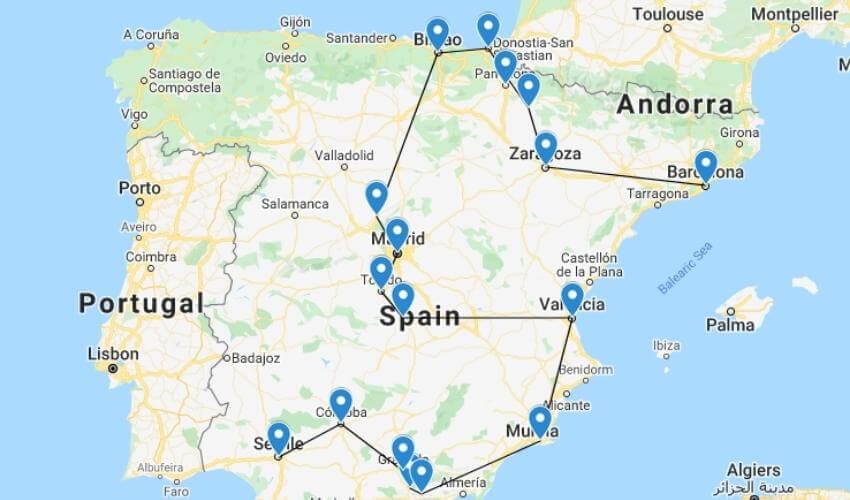
Detailed self drive Spain itinerary
This section includes a detailed day-by-day breakdown of our 3 weeks in Spain, including the best things to do in each city, where to stay, and where to break up longer drives.
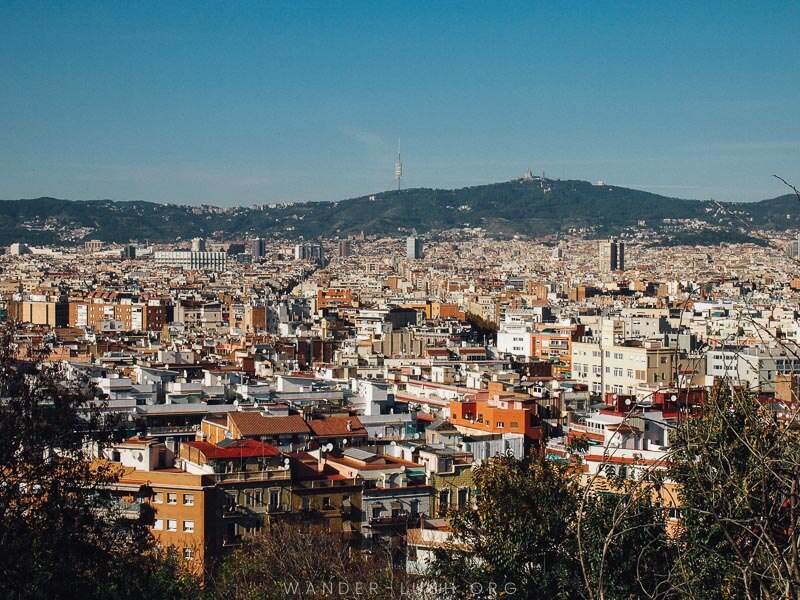
Vivacious Barcelona is the perfect place to start your Spain road trip itinerary. Capital of the autonomous Catalonia region and the second-largest city behind Madrid, Barcelona is quintessentially Spanish and offers a perfect introduction to many of the things that make Spain so great – incredible architecture, beautiful beaches, and fabulous cuisine.
On top of that, Barcelona is logistically the best place to start a trip through Spain. It’s home to an international airport, a train station with services from most other countries in the region (we arrived by night train from Geneva), and a ferry terminal.
I recommend spending at least 3 days in Barcelona to get a good feel for the city and see the main highlights. The city has a great public transport system, so you don’t need a car here – in fact, it would be a major burden.
I highly recommend picking your car up on the day you leave Barcelona. Most rental companies have offices at Barcelona-Sants, the city’s main train station. This is a good place to start as the traffic isn’t too hectic and you can easily get to the highway.
Where to stay in Barcelona
Barcelona is huge – where you stay can make or break your trip. Take some time to familiarise yourself with Barcelona’s inner-city neighbourhoods so you can make an informed decision.
Here are a few recommendations for where to stay in Barcelona – car or no car.
- Ayre Hotel Rosellón . Located in the shadow of the Sagrada Familia, you won’t find a better patio view anywhere else in Barcelona (just look at the pictures if you don’t believe me!). Parking at the hotel is guaranteed and only costs a modest 16 Euros extra per night.
- Barcelona Catedral Hotel . This modern boutique hotel has light-filled, spacious suites, a rooftop pool and patio, and offers free walking tours for guests. Note that secure parking costs a bit extra, and you’ll need to reserve a spot in advance.
- Motel One Barcelona-Ciutadella . Don’t let the name ‘motel’ fool you – this is a boutique hotel through and through. If you can tear yourself away from the trendy lounge-bar and rooftop terrace overlooking the city, it’s a short 20-minute walk to Las Ramblas. Private parking is offered at a nearby location and costs an extra 20 Euros.
- Unite Hostel Barcelona . My top budget choice in Barcelona, this boutique hostel offers dorms and private rooms, all bright, clean and minimally furnished. The yoga studio and co-working spaces are the cherry on top. Reserve on-site parking in advance for 18 Euros/night.
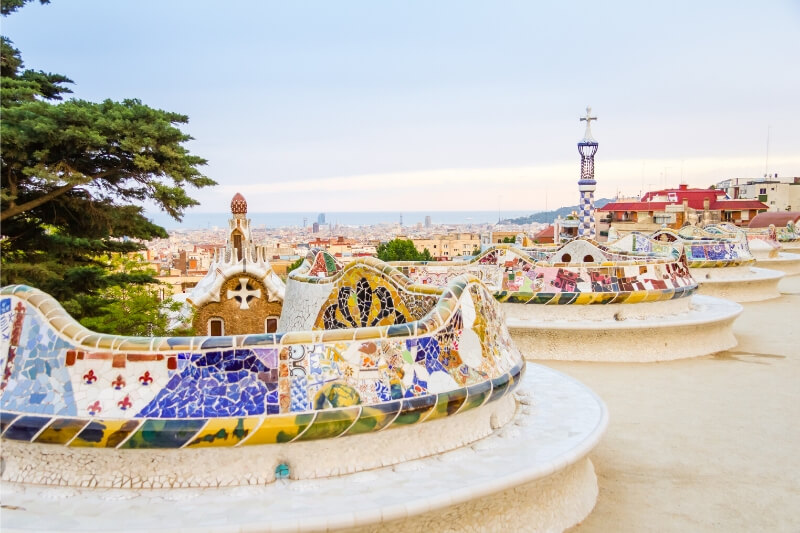
Things to do in Barcelona
In all honesty, planning a Barcelona itinerary can be a bit overwhelming. There’s just so much to see and do. I’m only recommending a few select activities and restaurants that we really enjoyed – know that there is a lot more out there!
Start by pounding the pavement on Sandeman ‘s free city walking tour . This will help you get your bearings while introducing you to some of Barcelona’s must-sees, including the Gothic Quarter and Barcelona Cathedral.
La Sagrada Familia , the grand cathedral designed by Gaudi, is the symbol of Barcelona. You should prioritise visiting on your first or second morning. Skip-the-queue tickets are essential – or else you risk spending hours waiting in line. Pre-buy your skip-the-line tickets for the Sagrada Familia online.
Gaudi’s other works in Barcelona, including the iconic Park Güell Monumental Zone (buy fast-track tickets here ) and Casa Batlló are absolutely worth a visit as well. Even if you’re not that interested in architecture, these buildings all capture the spirit of Barcelona and tell a fascinating story of Spanish and Catalonian history. The experience is even richer if you’re accompanied by a guide who can illuminate the symbology.

Ride an e-bike around the gorgeous Gothic Quarter to explore one of Barcelona’s most charming neighbourhoods. For a break from the hubbub, head for the hills and spend an afternoon wandering around the cactus gardens at Montjuïc . Take the cable car over La Barceloneta beach for fantastic views, and visit the beach itself if the weather is right.
Don’t skimp on the food, either! Barcelona is packed with incredible restaurants . We especially loved eating Spanish ‘ hamburguesas ‘ at Hamburguesería Bacoa and pigging out on homemade churros at Bar Churrería Layetana . If you’re a foodie, this market to table tour of Mercado de La Boqueria , Barcelona’s biggest produce market, is a must-do.
Take advantage of the free entry to Museu Picasso every Friday night – it’s busy, but it’s a wonderful experience. And for something truly memorable, try to see a gig at the Palau de la Música Catalana (we watched an unforgettable performance by the late, great Sharon Jones). If there’s nothing on, I highly recommend booking in for a short guided tour – it’s truly one of the most majestic buildings I’ve ever been in (aside from Sagrada Familia!).
Recommended day trips from Barcelona
If you decide to extend your stay in Barcelona, there are lots of fantastic day trip opportunities within a few hours’ drive of the city.
- Get your Game of Thrones on in charming Girona
- Visit family run wineries and taste tapas in the Penedès region
- Discover the mysteries of Montserrat solo or with a guide
No car? This 12-day journey around Spain by train , starting from Barcelona, takes in some of the country’s best cities and beaches.

It’s time to hit the road! After collecting your car in Barcelona, start heading due west towards the Bay of Biscay. The drive to Zaragoza takes 3 hours. If you want to make it in time for lunch, try to leave the city as early as possible (by 8am at the latest). That way you’ll also beat most of the traffic.
Zaragoza lies smack-bang in the middle of northern Spain. Capital of the autonomous Aragon region, it’s one of the country’s most underrated cities and an ideal place to break for lunch and a short walk.
On reaching Zaragoza, we stopped at a small tavern in the shadow of the Aljafería Palace and ate a bowl of fideos negros (black noodles simmered in fish stock). There are plenty of restaurants and gastrobars around the river, close to the historic centre. However, it might be tricky to find a car park, so I recommend heading to the city’s western fringe like we did.
Sos del Rey Católico

When I picture an archetypal Spanish town, the Sos is what comes to mind. This little village on the frontier of the Pyrenees is located another 1.5 hours’ drive north of Zaragoza, so I recommend leaving after lunch no later than 1pm to maximise your time in Sos.
Ferdinand II of Aragón, husband of Isabel I of Castilla and one-half of the most influential royal couple in Spanish history, was born here in Sos. The little town is loaded with history and packed with charm.
The town is petite and easily navigated during an evening or early morning stroll ; admire the flower boxes, pop in and out of charcuterie shops, and listen to the church bells toll.
We stayed a night at the Parador de Sos del Rey , which sits on a low rise overlooking the Sos’ ancient cobbled streets (you might recognise it from the 2017 film The Trip to Spain ) and had a very memorable meal at the Parador’s Cinco Villas-themed restaurant.
Where to stay in Sos del Rey: Hotels with parking
- Parador de Sos del Rey Catolico . It’s honestly worth the splurge to stay at this Parador. Set in a historic Aragonese mansion that overhangs Sos’s winding streets, it’s one of the most romantic hotels I’ve ever had the pleasure of spending a night in. Rooms are plush as, and the set dinner at the on-site restaurant is a must-try (I’ve never eaten so much food in my life). Parking on the grounds is free and easy.
- El Peiron . For a budget-friendly alternative, this hotel has a similar 17th century ambiance. Cozy rooms feature large beds and exposed stone walls. The location on Sos’s main street, close to some of the village’s best tapas bars, will make you feel like you’re part of the city (unlike the Parador, which makes you feel like absolute royalty). Free street parking is available near the hotel.

On your next full day of driving, break the 2-hour journey to the Bay of Biscay by stopping off in Pamplona for lunch. This will be your first taste of Basque Country tapas ! Pamplona is the perfect place to practice the art of ordering ahead of your arrival in San Sebastián.
Outside of the famous San Fermin (Running of the Bulls) cultural festival , which takes place in Pamplona every July, the streets are surprisingly peaceful and sparse. Bakeries and boutiques run the length of the main pedestrian drag and are well worth a browse.
San Sebastián

Most people head straight for San Sebastián’s pintxos bars , but don’t forget to take a stroll along the waterfront promenade , too. After a day’s drive, this is exactly what you need to stretch your legs and re-fuel.
We spent a few early evening hours in San Sebastián, and while I didn’t really fall head over heels for the town like I’ve known other people to do, it’s a worthwhile stopover on the way to Bilbao. If food is in your wheelhouse, you can easily switch your itinerary and stay in San Sebastián instead of Bilbao.

Bilbao and San Sebastián are only an hour’s drive apart, so you can plausibly stay in one city and visit the other as a day trip. If I had my time again, I would probably stay in San Sebastián instead.
The futuristic Guggenheim Museum is Bilbao’s main attraction, but I found the rest of the city a little bland. One full day is ample time to see the museum and explore Bilbao’s riverfront.
In 24 hours, you can discover the city by bicycle and tour a few of the key Game of Thrones filming locations around Bilbao. An in-depth Basque County gastronomy tour is worth considering if you’re particularly interested in food and wine (let’s face it, if you’re planning a trip around Spain, you probably are!).
Where to stay in Bilbao: Hotels with parking
- Hesperia Bilbao . These trendy self-contained apartments are a 10-minute walk from the city centre (just across the river from the Guggenheim) and feature everything you need for a comfortable stay in Bilbao. There’s even a Japanese restaurant and a rooftop terrace bar – because both those things are basically travel essentials nowadays. Secure parking can’t be reserved but is available at an extra charge.
- Ercilla Hotel . For something with a touch more old-world charm, this boutique hotel offers pretty rooms with herringbone floors and chequerboard tiles. The restaurant serves traditional Basque food, and there’s a panoramic bar here as well. Park on-site for 20 Euros (reservations essential).
- Parador de Limpias . If you don’t mind staying outside the city, this Parador is a 50-minute drive from Bilbao. The former summer residence of King Alfonso, the setting amongst private gardens and a protected woodland is just divine. Free parking is plentiful.

After a short but sweet introduction to Basque Country, it’s time to leave the coast and start driving inland towards Madrid.
Segovia is 100km shy of Spain’s capital city. Coming from Bilbao, you’ll naturally pass through it – so there’s no reason not to stop off and check out two of Central Spain’s most impressive historical sights.

Aqueduct versus alcazar – when an urban landscape is a battle between the most important Roman civil engineering work in Spain and a Moorish palace so beautiful that it’s instantly recognisable from pop-culture, you know you’re in for a treat.
Segovia is a complete contrast to Madrid. Park your car on the hill leading up to the aqueduct and ease your way into the capital by wandering around this charming town for a few hours first.

Climb the concealed staircase to the right of Segovia’s UNESCO-listed aqueduct for a different perspective on this feat of engineering. Visit The Alcazar , apparently Walt Disney’s architectural inspiration when creating Cinderella’s castle.
Between 10.30am and 4.30pm you can join a 60-minute guided tour of Segovia Cathedral , another of the city’s landmarks. This particular tour also allows you to climb the 500-year-old bell tower for a panoramic view of Segovia.
And as a reward for all that walking, treat yourself to a Pasteleria Limon y Menta , Segovia’s signature pastry. It’s lemony, it’s minty, and it’s wrapped in caramelised marzipan. Yum!
If you opt to drive straight into Madrid, you can always visit Segovia on a day trip.

Our first experience of Madrid was the nightmarish drive through the city at peak hour. Don’t make the same mistake we did – try to arrive in Madrid before nightfall!
Where to stay in Madrid: Hotels with parking
- Only YOU Hotel Atocha . The design of this jaw-droppingly beautiful hotel draws on the 19th-century building its housed inside. Deluxe rooms face onto an inner courtyard and are bright and airy as a result while still feeling private. There’s a cafe, bakery and lounge, and breakfast is served on the 7th floor with city views. The Prado Museum is only 900m away, making this a great choice for museum and culture lovers. Parking on-site is guaranteed and costs extra.
- Hostal Patria Madrid . Coming in at under $100 a night, this hotel is excellent value for money in Madrid. Rooms are basic but comfortable with Scandi-style furnishings, and the location on a popular cafe strip is perfect for hungry travellers. Parking (reservation required) costs a very reasonable 17 Euros.
- Parador de Alcala de Henares . If you want to avoid driving into Madrid (smart choice!), this Parador is 45 minutes outside of Madrid. The 16th-century convent building reminds me of a Silk Road Caravanserai. There’s an outdoor pool, and parking on the grounds costs a little bit extra.
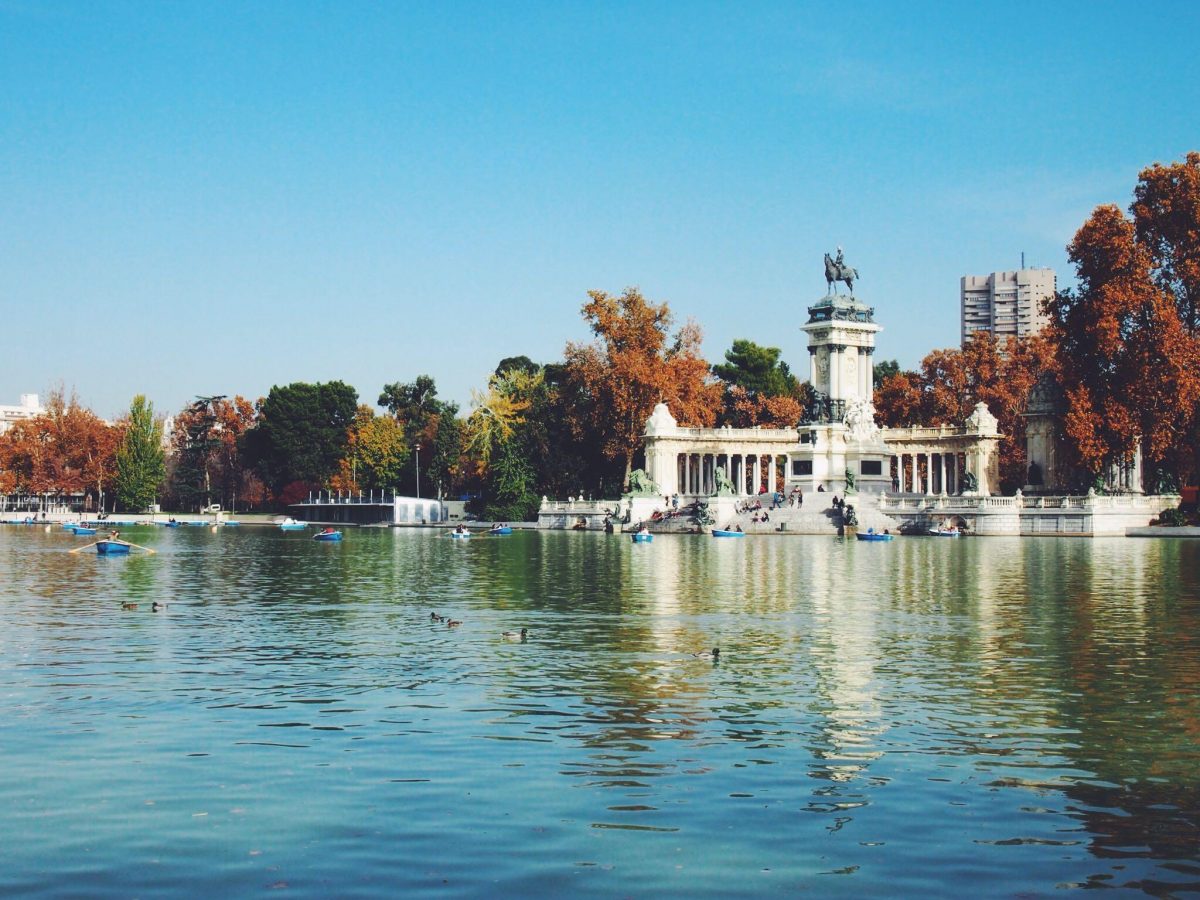
Things to do in Madrid
An easy walk or cycling tour through the city is the best way to see central Madrid. Make sure you explore the gorgeous Real Jardín Botánico , wander through the bookstalls that line Cuesta del Moyano , and top it off with sunset at the Temple of Debod , an ancient Egyptian temple that was dismantled, shipped to Spain, and reassembled in all its glory on a hill in the city centre. A live flamenco performance is the perfect way to end your first day in Spain’s capital.
For a dose of history and culture, visit Madrid’s four most iconic landmarks: The Plaza de Toros de Las Ventas , the Royal Palace , the Plaza Major , and of course the Prado Museum .
Here are my top tips for exploring historic Madrid:
- Join a tour of Las Ventas to access some of the building’s hidden nooks and crannies.
- Take in the scale of the magnificent Plaza Major on a bicycle. This 3-hour small group tour takes in many of the city’s highlights.
- Let a professional guide show you around the Throne Room, Banquet Hall and Private Royal Apartments inside the Royal Palace. This 2-hour tour is excellent value for money.
- Skip the line by buying your Prado tickets online in advance through Get Your Guide .
Recommended day trips from Madrid
- Visit the UNESCO World Heritage Site, Cuenca , and its amazing ‘hanging houses’
- See the ‘three cities’, Segovia, Avila and Toledo, on a day trip (a good option if you want to condense your Spain road trip itinerary and stay longer in Madrid)
- Tour the wineries around Madrid and taste the local drop
- Cast your eyes on the surreal landscape of El Escorial and the Valley of the Fallen

Leaving Madrid, start your journey to Southern Spain’s enchanting Andalusia region. Over the next 12 days, you’ll be driving from Madrid to Granada and Cordoba via some of the loveliest small towns and historical villages in the country.
The first of these, Toledo , is just an hour outside Madrid. After the chaos of the capital, it’s a salve. Toledo’s mix of old-world charm, literary heritage and multicultural influences makes it one of my favourite places in all of Spain. I highly recommend staying for at least one night.
Toledo is the first place where you can see, hear and smell the Middle Eastern/North African influence that becomes more and more pronounced the further south you travel. We had a wonderful introduction to Syrian and Turkish food in Toledo, which became our go-to cuisine for the remainder of our trip.
Where to stay in Toledo: Hotels with parking
- Hotel Santa Isabel . A great budget choice at under $40 per night, this charming guesthouse is right in the heart of Toledo. Private balconies overlooking the town rooftops and a central courtyard are terribly quaint. Rooms are a bit boxy, but nicely finished and clean. Reserve parking in advance for 12 Euros per night.
- Parador de Toledo . This is another great candidate for a little splurge. Set 4km from the centre of Toledo in a low-set historic building, rooms here are a bit more outdated than at other Paradors, but the outdoor pool and panoramic terrace are lovely. Parking is free.

Toledo is the spiritual home of Don Quixote , Spain’s literary legend. A great way to see the old town is by walking the Don Quixote Trail . Alternatively, let a Toledo local show you around on a private walking tour .
Fall in love with Syrian food at Posada El Cristo de la Luz , then down a sampler box of marzipan from Santo Tome (the signature sweets of Toledo).
For more Toledo inspiration, see this list of the top 10 things to do in Toledo .
Consuegra, La Mancha

I’m a huge fan of Miguel de Cervantes’ Don Quixote , but even if you’ve never read the book, a quick detour through Spain’s iconic La Mancha landscape, with its towering windmills and patchwork fields, is an absolute delight.
Leaving Toledo and driving east, aim to arrive in the small town of Consuegra in the early morning before the tour buses pull in at around 10am.
Stop at one of the provincial bakeries for a quick bite. You can then drive all the way to the top of the hill and explore the windmills on foot.

Spain’s third-largest city, Valencia has all the charm of Barcelona and all the amenities of Madrid with a laid back, beach-town feel. This is the Orange Blossom Coast , and the streets of Valencia are lined with citrus trees (which you must pick and sample – luckily our Airbnb came with a juicer!).
Valencia is also the traditional home of paella and Spain’s signature beverage, horchata. While we weren’t all that impressed with the City of Arts and Sciences , we loved cycling through the elongated Cabecera Park that runs through the heart of the city. (Perhaps we should have opted for the rooftop wine and tapas tour instead!) If you’re an outdoorsy type, you’ll adore Valencia.
Driving in Valencia is relatively easy compared to Barcelona or Madrid, so you can stay in the city centre without having to worry too much about traffic or navigating the roads.
Where to stay in Valencia: Hotels with parking
- HQ Rooms Apartments San Vincente . Spacious and featuring all the mod-cons, this self-containted apartment sleeps up to 8 people and comes with a large private balcony. It’s 1.5km from the centre of the city, and there are bicycles available to rent for a small fee. Parking costs an extra 15 Euros.
- Palacio de Rojas . 350m from Valencia’s Central Market, it doesn’t get much more inner-city than this. The canary yellow facade, the indoor-outdoor living spaces, the high ceilings and the heavy doors… This must be one of the most beautiful hotels in all of Spain. Seriously. Palacial apartments sleep up to 9 people and all feature a full kitchenette. Underground parking is available for an additional 15 Euros.
Things to do in Valencia
You’ll probably be quite content hiring a bicycle and exploring Valencia at your own pace. If you want a deeper look, try joining a private walking tour with a local .
For a hands-on activity, I highly recommend taking a paella cooking class and learning just why Valencia is the birthplace of Spain’s most famous dish. Head to the Plaça de Santa Caterina to try a glass or horchata (or two) at one of the open-air cafes. Horchateria Santa Catalina is my personal favourite.
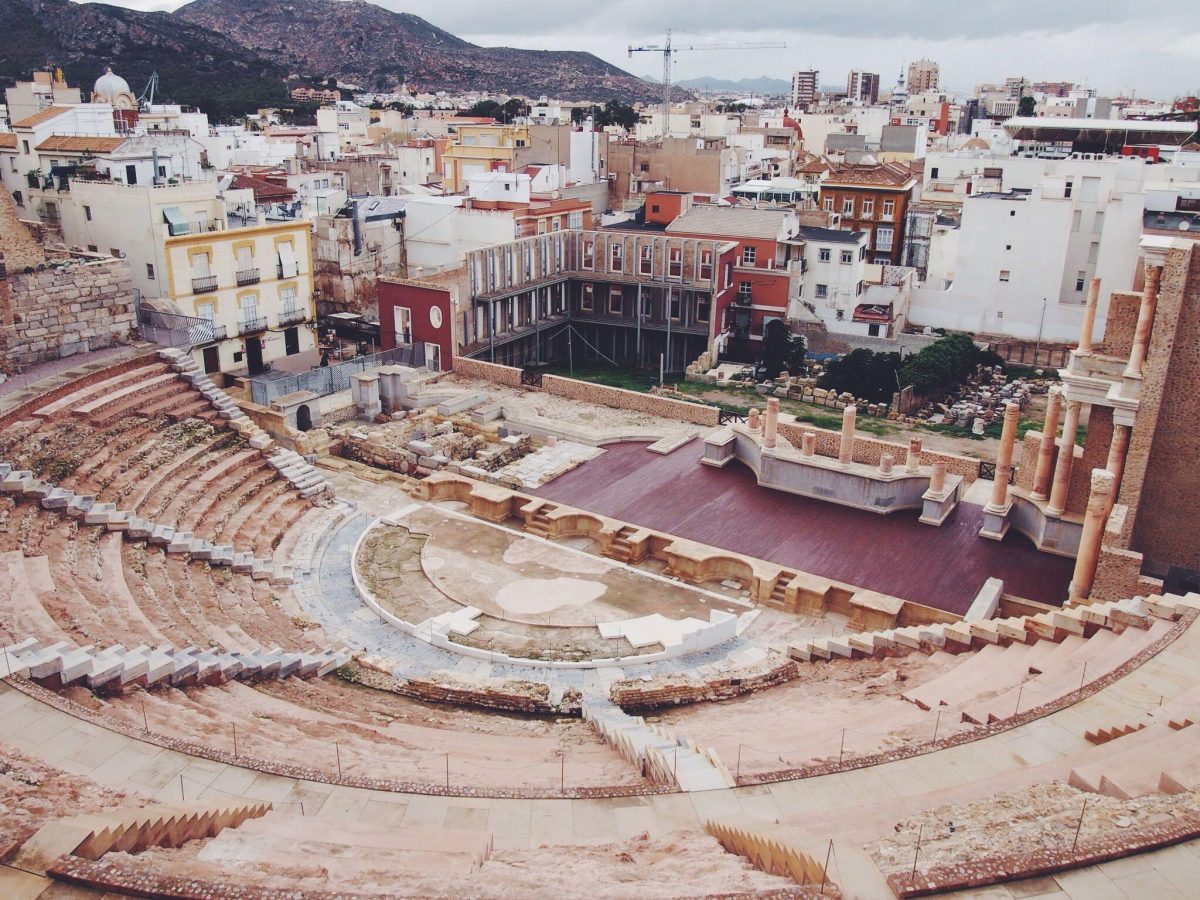
Three hours’ drive down the coast from Valencia, Cartagena is another of Spain’s most underrated cities. We rolled into the sleepy historic centre in the early afternoon and were greeted by a medieval festival, the annual Mercado Medieval (how’s that for timing!).
Catagena’s Roman amphitheater is one of the best-preserved in all of Europe, and exploring the state-of-the-art museum was honestly one of the most enjoyable ‘historical’ experiences I had in Spain. It’s fascinating to see how the city has been built-up around the ruins.
Cartagena is small so you only need a day or two at the most. Start by getting your bearings with a walk around the inner city. The food scene here is great, so I also recommend doing a gourmet tapas tour .
Where to stay in Cartagena: Hotels with parking
- NH Cartagena . Elegant rooms with a view of Cartagena port are the stand-out feature of this efficient hotel. It’s only 200m from the Roman Theatre but in a quiet corner of town, so you can still get a good night’s sleep. Reserve paid on-site parking at the time of booking.
The Sierra Nevada: Lanjarón and the White Villages

Leaving Cartagena behind, you’ll next be driving the coast of Spain (at least a portion of it) and dipping inland to visit one of Spain’s most beautiful natural landscapes, the Sierra Nevada.
Once you hit the mountainous Las Alpujarras region, you’ll realise what a blessing your hire car truly is. Navigating the windy, steep, narrow roads around the white villages was nail-biting at times, but I can’t imagine trying to get around any other way.
Base yourself in Lanjarón , the area’s most populous village and home to a number of quirky accommodations, including the healing retreat/yurt we stayed in.
Once a hippie mecca and still famed for its spring water and olives , Lanjarón is a gateway to the smaller villages of Pampaneira, Bubio and Capileira . If you can brave the altitude, add Trevélez (Spain’s highest settlement) to your driving itinerary.
Some of the villages take a good few hours to get between, especially in inclement weather, so I recommend setting aside at least two days to explore the area, more if you intend on hiking between the villages .

Where to stay in Sierra Nevada: Hotels with parking
- Hotel Alcadima (Lanjarón). Homely suites at this quaint little hotel are excellent value for money. Indoor and outdoor pools, plus a kids’ play area, make it a great choice for families. The restaurant specialises in roast lamb with cinnamon. Need I say more? Parking costs an extra 10 Euros.
- Enchanting Yurt (Lanjarón). One of the coolest Airbnbs we’ve ever stayed at, this whimsical yurt is set in an olive grove at the foot of the mountains. It’s absolutely magical, and the Israeli hosts are very kind and welcoming. Free parking is plentiful.
- Parador de Nerja (Nerja). Another town, another Parador! This one is a bit different because it’s set inside a modern building on a cliff top overlooking the ocean. An elevator ferries guests down to the nearby beach (how cool!). Private parking is available for an additional charge. Note that it’s a 60-minute drive to Lanjarón.

Granada boats a quixotic mix of Spanish and Moorish cultures. The Alhambra is an architectural triumph – if it’s not on your itinerary, you’re doing Spain wrong!
You need to buy tickets to the Alhambra and Generalife Palace and Gardens a day or two ahead of your visit (or a week in advance if you’re travelling in summer). The easiest way to do that is by booking online through Get Your Guide .
On the day of your visit, make sure you leave early to account for the time it takes to access the complex (which includes a long, beautiful walk through the forest if you’re using public transport).
Where to stay: Granada hotels with parking
- Eurostars Catedral . The exception location 70m from Granada Cathedral is only topped by the traditional coffered wooden ceilings inside some of the suites. Rooms are otherwise modern and luxurious with more subtle nods to the building’s history sprinkled throughout. Parking costs an extra 22 Euros per day.
- Anacapri . This 18th-century house turned boutique hotel wears its heart (and its history) on its sleeve. The inner courtyard is outstanding, and rooms are very comfortable. It’s even closer to the cathedral and just 20 minutes’ walk from the Alhambra, right next to the start of the pathway. No reservation is required for the off-site parking (an extra 20 Euros per day).
- Alhambra Palace . Just shy of the city walls to Granada’s iconic UNESCO attraction, this hillside hotel has spectacular views, Moorish-inspired decor, and of course, quick access to the Alhambra. Secure parking is off-site and costs 22 Euros.
Things to do in Granada
After the once-in-a-lifetime experience of The Alhambra, everything else pales in comparison! However, Granada has a lot more to offer, which is why I suggest staying an extra night (or even longer, if you can).
Discover the city’s most charming neighbourhoods , Albaicín and Sacromonte, on foot with a walking tour. Watch a traditional flamenco performance inside Albaycin, and treat yourself to an authentic Arabian hammam bath .
There is a secret sunset spot in the hills above Granada where you can watch the warm light bathe the entire Alhambra complex before someone flicks the switch and it lights up like a beacon on the hill. Don’t miss it!

From The Alhambra to Códoba’s Mezquita, a fascinating mosque-cum-church that is home to a set of much-photographed candy cane archways. Córdoba is an archetypal Andalusian city (my favourite in the region) and has many other offerings, including a pleasant waterfront and some incredible vegetarian restaurants.
Every year, Córdoba hosts the Patio Festival , which showcases the amazing indoor gardens that are a traditional part of every home here. Make sure you peek inside a few doorways as you’re wandering the town’s lanes. This is also a good place to catch a Flamenco/equestrian show – our pick is the Royal Stables of Córdoba .

Where to stay: Córdoba hotels with parking
- Hotel Boutique Patio del Posadero . This intriguing little hotel features bespoke rooms and a beautiful patio (as is the style in Cordoba). The outdoor swimming pool and terrace lounge are perfect for summer. Reserved parking costs extra.
- Hotel Cordoba Center . A bit further from the mosque, this ultra modern hotel sits on the city’s Golden Block next to the AVE Train Station. The 7th floor pool and Jacuzzi are particularly noteworthy, but it lacks the charm of some other Cordoba hotels. Non-reserved parking is located on site.
- Parador de Cordoba . It’s almost your last chance to stay in a Parador! Cordoba’s is a fine choice – another renovated summer palace, it’s located north of the centre and boasts a massive pool plus sprawling gardens (the grounds, Los Naranjos, are where the first palms brought to Europe were planted.) Rooms are extremely spacious and well-appointed. Parking is free.

Things to do in Córdoba
Join the official Mezquita tour (price includes entry) and see this incredible UNESCO mosque-cathedral up close. In the summer, cycle the waterfront on a bicycle tour , or visit seven of Cordoba’s most impressive patio gardens and learn about the history of the city’s courtyard tradition.
If you have an extra day, venture outside the city to see the impressive Azahara Medina .

An entire day can easily be spent inside Seville’s Alcazar complex , another incredible palace – this time in the Andalucian style – that mirrors The Alhambra in its layout and design. GoT fans will recognise the Alcazar as the setting for the Water Gardens of Dorne.
Seville is a sun-bathed walking city, and the Plaza de Espana , Barrio Santa Cruz and Parque de Maria Luisa are all worth a wander.
I found Seville a lot grungier than other places in Spain. The streets are filled with cool v intage stores and hip cafes , and the city has a great vibe.
We returned our rental car in Seville and got around the city very easily using public transport. I recommend you do the same.
Where to stay in Seville: Hotels with parking
- Hotel Las Casas de la Judería . If it’s atmosphere you want, look no further. This charming hotel is set with 27 traditional houses (yes, it’s big), all connected by courtyards and internal passageways. Traditional decor including antique furniture and French windows is straight from the history books, while the rooftop pool brings the property up to date. Some of the rooms are just spectacular – I couldn’t imagine a better way to end your Spain road trip than with a few nights here. The location in the old Jewish Quarter means there’s lots to be explored nearby, including the cathedral, which is just a 7-minute walk away. Off-site parking costs 24 Euros.
- Melia Sevilla . Modern, minimal and a complete contrast to the previous property, this hotel is centrally positioned off Plaza España. Twin hot tubs and a hamman round-out the ample services. Public parking near the hotel costs 24 Euro. Staff can help you coordinate, but I recommend you return your hire car before you check in.
- Hotel Rey Alfonso X . This trendy hotel features a summer pool that overlooks Seville’s oldest church. Business-like rooms are smart if not a little soulless. On-site parking costs extra (enquire at the time of booking).

Things to do in Seville
The Alcazar should be top of your list for things to do in Seville. This skip-the-line ticket includes a guided tour.
Marvel at Seville’s Cathedral and Giralda Tower , watch a flamenco show at Museo del Baile Flamenco (the birthplace of this Intangible Heritage icon), and walk through the gorgeous Santa Cruz Jewish Quarter (don’t forget your camera!).
If you want to get even further off the beaten path in Seville , I highly recommend this alternative market and walking tour .
Seville is a great place for a Spanish cooking class . This one shows you how to prep several popular Seville-style tapas , and includes bottomless sangria.

Recommended day trips from Seville
- The British Overseas Territory of Gibraltar is just a short drive from Seville
- See Ronda , a small town set on a dramatic gorge
- Village hop through the Andalusian countryside
- Visit the port city of Cadiz and the Moorish Jerez, two of Southern Spain’s most stunning cities
- Get another stamp in that passport! – take a full day trip from Seville to Tangier, Morocco
Quick tips for driving in Spain
Here are a few pointers to make your Spain road trip as smooth as possible.
Things to remember when renting a car in Spain
Obtain an International Driving Permit before you leave home. Most rental car companies require an IDP by law (you also have to carry your regular driver’s license).
Book your rental car well ahead of time , especially if you want an automatic transmission as they are in short supply. We could only find a few automatic cars available in Barcelona, and they were more expensive than manual. I highly recommend using Discover Cars to compare rental prices and reserve your car in advance .
Choose the smallest car possible. In between the narrow village streets and tight street parking spaces, you’ll want to go with the smallest car you feel comfortable with. Driving around Spain in a small car (a Hyundai or a Corolla, for example) is perfectly safe provided you stick to the highways and don’t go off-road.
Bring your own GPS (with maps for Spain and Portugal pre-loaded) to avoid the GPS rental fee. Alternatively, use your phone to navigate with Google Maps or Maps.Me – it works just fine, provided you have the map pre-downloaded for offline use or you have a Spanish sim card with plenty of data.
General driving tips & Spain road rules
Plan your route to avoid toll roads. Some tolls are very expensive – up to 20 Euros – but we managed to avoid most of these by taking indirect roads and alternate highways.
Avoid driving in the bigger cities , especially Madrid. Pick up and drop off your hire car from an office in the outer suburbs or the airport to avoid inner-city congestion.
Note the blood alcohol limit. If you plan on visiting any wineries while you’re driving across Spain, remember that the blood alcohol limit in Spain is 0.05% (or 0.01% if you’ve had your license for 24 months or less).

Tips for parking in Spain
Look for ‘Blue Zones’. If you’re visiting cities and towns for the day and need a place to leave your car away from your accommodation, you’ll need to get a grasp on how the street parking works in Spain. Blue Zones (portions of curb marked with a blue line) designate paid parking spots. Wherever you see Blue Zones, you’ll see a meter or automatic machine nearby where you need to register your car. Take the ticket and display it prominently on the dash, with the date and times face-up.
Yellow lines designate disable parking spots. You’ll need a displayed permit to park here. Other coloured zones vary from city to city but usually indicate Resident Zones. If you’re not registered to a nearby address, you obviously can’t park here.
Park during siesta hours. Depending on the city, metered parking is sometimes free between 2pm and 4pm Monday to Friday and after 2pm on Saturdays. If you want to save a buck, try finding a car park during siesta hours.
What to pack for your Spain road trip
A few of my favourite must-pack essentials to make your road trip around Spain comfortable, safe and hassle-free.
Travel insurance for Spain
The one thing I never travel without. When it comes to medical expenses, accidents, travel delays and the like, preferred partner for long-term travel insurance is SafetyWing .
When renting a car, make sure you read the PDS to see what you’re already covered for. I always recommend purchasing extra insurance just in case, either via the rental agent or through a provider such as Insurance4CarHire.
Handy gadgets
Travel adapters. If you carry a universal adapter, you’ll never get caught out with the wrong plug. This portable travel plug works in more than 150 countries (including Spain and the rest of the EU) and features 4 USB ports for charging multiple phones/iPads at once.
USB phone charger. Don’t let your phone run flat while you’re in the car. You can plug your regular charging cable directly into this Anker USB car charger . It works with most phones and iPads.
Car mount phone holder. Using a phone while driving is illegal in Spain. If you plan on using your phone to navigate around, you’ll need to use a mobile phone mount. This travel-friendly phone holder fits any phone or phone case, and has a 360-degree rotating cradle.
Lightweight cooler bag. An insulated bag to keep your drinks and road trip snacks cool is especially useful in summer. This simple family-size cool bag packs down into a neat, flat little bundle that you can easily squeeze into your suitcase.
Wine Wings. Whether you’re road tripping or not, these handy non-leak wine bottle protectors are one of my favourite travel items for Europe. Essential if you want to bring a few bottles of Spanish vino home with you!
Eco travel essentials
Refillable water bottle. It’s crucial to stay hydrated in Spain, especially in the warmer months. Tap water in most cities and towns is potable. As you drive through the mountains around the Sierra Nevada you’ll see fresh-water springs by the side of the road where you can fill up your water bottle (this was one of my favourite things about road tripping in Spain!). I highly recommend S’Well insulated bottles because they look good, stay cool for up to 12 hours, and they don’t sweat.
Reusable coffee cup. You’ll probably be drinking a lot of coffee in Spain. It’s always a good idea to bring a reusable cup that you can take with you in the car. This gorgeous gold barista-friendly travel mug is vacuum sealed (zero chance of a spill!) and will allow you to cut down on plastic and paper waste.
What to wear in Spain
Good walking shoes. Even if you’re on a Spain road trip, you’re still going to be spending a lot of time pounding the pavement (and cobblestone streets!). Comfortable walking shoes are absolutely essential. To cut down on luggage, we carry ‘stylish’ walking shoes in Europe that we can also wear out at night.
Sunglasses. Some highways in Spain are quite exposed – I guarantee you’ll be reaching for your sunglasses on the first day. Bring your favourite pair of polarized lenses, or pick up a pair of foldable travel sunglasses .
Loose, comfortable clothing. There’s nothing worse than feeling uncomfortable in the car. Pack a pair of travel leggings or yoga pants plus a few comfy t-shirts for longer driving days. A comfy travel cardigan like this one is a must-pack for winter in Spain.
Essential reading
A copy of Lonely Planet Spain. This essential guidebook for Spain is the perfect Spain road trip companion. As well as planning and logistics, it includes useful Spanish phrases and detailed information about Spain’s top tourist sites.
A copy of Back Roads Spain. This little book is a bit light on practical information, but it does contain some beautiful photos. Great inspiration for getting off the beaten track in Spain.
Spain paper map. Good for peace of mind if your sat nav fails you. Even if you don’t use it for navigating, you can still plot out your route and hold onto the map for a nice souvenir! This map is current for this year and covers both Spain and Portugal.
I hope you’ll agree that this is one of the best routes through Spain by car for first-time visitors who want to pack everything in. Are you planning a self drive Spain itinerary for your next road trip? Leave your questions in the comments!
Spanish road trip itinerary: Pin it!

50 Comments
This is such a great post, we did a very similar route over three months! We didn’t realise just how much we would fall in love with Spain.
Whilst in Spain, we were crashed into TWICE!!! both times when we were parked!! Although there is nothing we could have done to prevent this – I thought I would let you guys know! Spanish drivers can be crazy – even in a parking lot!!
Sorry to hear that Christie! Hope you still had a fun time!
Really love your post on spain. Just wondering if this will work also in winter in dec?
Hi Jaime, I don’t see why not – I was there at the start of winter and the weather was nice, roads quiet, etc. You might have to make some small adjustments for the mountain roads. Happy travels!
I travelled around Spain in a campervan from January to March this year and the weather was great. Even on the coldest days, the temperature was really mild and completely manageable. Bilbao was the only place that even felt remotely “wintery”, but with that being said, I’d take a Spanish winter over a Scottish winter any day!! I would 100% recommend visiting Spain over winter as it is not overcrowded with tourists and the weather is still good enough to do most outdoor excursions!
Looks wonderful! I recommend renting a car and driving off the road to get to know the culture and customs of people in the provinces. It is such a cultural and spiritual journey.
Amazing road trip! In Spain there is so many places to visit from the north with beautiful nature to the south with cultural impact. Love your style of writing.
Dear Emily, thanks for sharing your invaluable experience and tips. I’ve never been to Spain (but I will soon), except for the Canary Islands, so this thorough guide is just priceless while planning a trip. After seeing the super narrow streets on Tenerife, I can totally vouch for hiring the smallest car. We were lucky enough to hire a really small one while traveling around Tenerife. Otherwise, it would have been impossible to pass some of the roads, especially when there was a bus in our way.
Absolutely! We had a terrible (but also hilarious) experience with our car in Bilbao… Smaller is definitely the way to go in Spain!
Enjoy your trip!
Dear Emily, Thank you so much for sharing with us your great experience in spain, I’m very glad to read your trip report and happy to hear that you enjoyed it.
Regards, Hamid
Hey Emily, Love your travel blog. I was just wondering about the language barrier? My partner and I only speak English. Was it hard to communicate with people? Thanks!
You have nothing to worry about – English is widely spoken, even in small towns. For extra peace of mind, you could download Google Translate’s Spain module to use offline when you’re travelling.
I hope you have a wonderful trip!
Oh & We are planning to spend 2 days in Madrid and 2 in barcelona , which leaves us with 5 days for driving and moving around from madrid , throughout these Andalusian cities and reacb to barcelona. At what point do u think a train would be more convenient? Thanks again Emily 🙂
Wow your post was so helpful and informative! We are planning a 9-day trip to Spain. We will arrive in madrid and depart from barcelona. Starting in madrid , driving south (rent Car) to Toledo , Cordoba , Seville , Granada. We are not sure if we should continue driving from Granada towards Valencia then off to barcelona for the last 2 days. OR skip Valnecia all together, drop the car in granada and take a train to Barcelona. Do you habe any advice as to the best way to accommodate this itinerary? (In terms of making use of the beautiful towns and scenary, but not waste too much time on tje road!) thanks a lot , your input is appreciated.
Hi Marco, sorry for the late reply. I really enjoyed Valencia – don’t skip it! You can easily do the whole route by car and drop off your rental in Barcelona.
Enjoy Spain!
Your post information is very unique and useful for all readers.
Hi Emily! This is great! Thanks for putting so much effort !! What was you guys process for mapping the road and avoiding the tolls?
Hi John—if you Google ‘Spain toll map’ you’ll find a good road map with no toll roads marked out. We just planned our route according to that!
Hope that helps!
Great thank you! We have been traveling Europe for a little over a month now and going to finish the trip with a 10 day drive from Seville to Barcelona stopping a lot along the way! Will definitely use your post to help!
Sounds incredible! I’m very jealous. Enjoy—and please don’t hesitate to reach out if there’s anything else I can help with.
Great article! Thank you for sharing!
Hi Emily – thanks for this super helpful feature ! Just wondering what car hire company you used and if you have any recommendations on type of car Thanks 🙂
Hi Jess! Thanks so much for reading. I’m glad you found the itinerary helpful.
We were advised to go through Sixt—but unfortunately they didn’t have an automatic car available for our dates. We used Hertz in the end. We rented a regular sedan—we didn’t go off road at all, so it was fine. Even in the Sierra Nevada, you won’t need a 4WD as long as you’re sticking to the path.
I hope this helps! Emily
Thank you for your suggestion Emily!
Wonderful!road trip advice for Spain. Would you suggest me how much total cost to travel so that I would manage my budget accordingly. I would be grateful.
Depending on your travel style, I would recommend budgeting 50-120 USD/day.
I love your blog, I am traveling to Spain early May and currently preparing itinerary for a 16 day road trip. I will be travelling with my husband, we love to explore culture, local food and love nature and seneic places. As we will be little tight on schedule, we want to plan properly so that we can cover the most in 16 days. Please help me with your suggestions on the itinerary, we were planning to spend 5 days in San Sebastian + Bilbao. I am having second thoughts after reading your blog. We will fly in at Barcelona and fly out from Madrid. Below is the itinerary, let me know your thoughts
Night 1 : Barcelona – we will fly in late so not planing anything Day 1 : Roam around Barcelona Day 2: Leave for San Sebastein – stop over at Pamplona – night at San Sebstein Day 3: Explore San sebastein Day 4 : Leave for Bilbao, night at Bilbao Day 5 – Day 6 : Explore Bilbao and nearby. Is this too much for Bilbao? I found POIs that appeared seneic.. I am unsure if 3 nights is way too much for Bilbao Day 7 : Leave for Leon and stay there for a night Day 8 : Plan to spend 5 days in south to cover Seville, Gibraltar, Granda and fly out from Madrid
We are not very keen on Barcelona and Madrid. After reading your blog I am tempted to add Cordoba and Lanjaron to our plan..
I will be glad if you can help me here .. 🙂
Hi Namrata! Thanks so much for your message. Your trip sounds wonderful!
I personally thought Bilbao and SS were overrated—I much preferred Cordoba, and Lanjaron was absolutely beautiful. If you like scenery, you will love Lanjaron. I am less of a foodie so you will probably appreciate San Sebastian more than I did! I would spend less time in Bilbao, but that would just be my personal preference. I really encourage you to check out Cordoba—it was definitely a highlight of Spain for me.
I hope this helps! Have a wonderful time in Spain!
Wow! What a nice roadtrip, Emily. You did covered a large area of Spain and included areas that many travellers overlook. If you ever decide to do another Spanish roadtrip, I would recommend including Extremadura in your trip. It is the most unknown of all Spanish regions, totally overlooked by most foreign tourist, yet a fascinating area full of history, Unesco sites, the best ‘jamón’, castles, vast open spaces and empty roads. Cheers, Irene
Thanks, Irene! I just did a quick Google and Extremadura looks gorgeous! I will definitely keep it in mind for next time.
Cheers, Emily
We’re planning a 3-week trip to Spain this summer probably starting in early June. We are thinking of “winging it”. Flying into Barcelona, renting a car and just driving with an itinerary similar to yours. Do you think winging will be OK? We don’t want to plan staying in any one place for a specific number of days. If we come across a place we like we want to be able to stay there for as long as we want without affecting any reservations that otherwise would have been had. Do you think booking AirBnB’s on the fly will be an issue? With respect to car rentals, are we able to rent in Barcelona and return in Malaga for example? Thank you for posting your article. It’s a great help.
Hi Richard,
Thanks very much for your comment! Your trip sounds great. I wish we had more flexibility with our itinerary as there are spots we would have spent less time (Bilbao) and places where we would have loved to stay longer (Valencia, Granada).
I haven’t travelled in Spain during summer, but I would guess that things are a tad busier! With Airbnb, you should always be able to find something, even at short notice. The only restrictions will be your budget and the availability of car parking. We were on a tight budget, which is why we preferred to book in advance and secure rooms at a lower price. I have booked Airbnbs on the fly in other countries before without any issue—so it’s definitely possible. You may have to compromise on price and location, though.
We rented our car in Barcelona and dropped it off in Seville. There was no issue. We just had to pay a small premium for returning it in a different city, as is standard with most rental places around the world. So you shouldn’t have any problem with returning the car in Malaga.
I hope you have a wonderful trip! Please do let me know if there’s anything else I can help with.
Oh I keep rereading your report and seeing more each time. Thank you so much! We are going to Spain from 21st Sept until 17th Oct and driving three weeks of that. We’ve been to the major cities before (Madrid, Barcelona, Seville, Granada) so we are concentrating on smaller places, Jerez, Cordoba, Toledo, Salamanca, Zaragoza (where we’ll catch the annual festival!) etc. Still a little concerned about parking though. How did you manage? We also love apartments so we can visit the local markets and cook some of our meals at home so we’d love you to share your advice about really good airbnb’s. We have one in Jerez so far – haven’t got very far as you can see – and have fortunately found a hotel in Zaragoza with free parking during the festival. We’d really appreciate any other advice along the way. Here’s the general order: start Jerez, check out the white villages from there, Cordoba, Ubeda, Toledo, Salamanca, Burgos, Zaragoza… then somewhere in between and end at Barcelona airport to fly home. Lots of other little places to check out close to these towns but I think they will be our main stops (think…). Would LOVE your comments.
Hi Kathryn, your trip sounds great! We had a few parking dramas in the bigger cities but nothing too bad. I’ve just posted a list of the Airbnbs/hotels we chose to stay at in Spain – some are no longer listed, but there are a few still going. I hope this helps!
https://wander-lush.org/spain-best-airbnb-where-to-stay-road-trip/
Safe travels! Emily
Hey Emily, I plan to make the same road trip you have done in Spain with my wife in January. In which month you did yours ? I am not sure if the weather January is not very convenient for such trip !?
thank you so much in advance
BR Redouane
Hi Redouane! Thanks for your comment. That’s very exciting – I hope you love it as much as we did!
We did our road trip in November. I’ve never been to Western Europe in January, but I can’t imagine the weather would be too drastically different. We prefer the cooler weather, which is why we chose that month. Everything was a touch cheaper as well given that it’s shoulder season.
I hope this helps with your planning! Enjoy!
Hi there! Thanks for a great blog! This is what I love – discovering places off the beaten track. We are doing a 5 week trip with 3 kids taking our own car by ferry in July! The only thing I have planned as yet is that we arrive in Santander….! Would welcome air bnb recommendations but will touch base wth you as I get planning to see what you recommend. Have noted your recommendation for Córdoba. X
Thanks Aabida! Your trip sounds great. Please do get in touch if you want specific recommendations for Airbnb – we stayed at some great places.
Hi Emily, I’m traveling in southern Spain at the end of July and have booked a rental car. I’m concerned about parking in Granada and Cordoba (Granada especially as I’ll be there for a few nights. Any parking recommendations? Thank you!
Thanks so much for your comment. Your trip sounds wonderful!
We stayed at Airbnb apartments with private parking in both Granada and Cordoba. From memory, Cordoba was a bit tricky because the streets there are quite narrow so I would definitely check with your accommodation in advance.
Granada, however, had plenty of street parking. We parked and took public transport to/from town and the Alhambra. I dug up the link to the Airbnb apartment we rented – there was a lot of street parking in this part of town: https://www.airbnb.com.au/rooms/726540
Best of luck with the rest of your planning! Please let me know if there’s anything else I can help with.
wow amazing road trip! and the photos you’ve taken are really incredible.
Hello Emily I’m thinking of travelling to Spain in May 2017. Thanks for all your information. I like your intinery and will probably follow some of your guides. Did you book your airbnb before you commenced your trip and further did you do it online? Any tips or websites would help? Thanks for any help. Peter
Hi Peter! Thanks for reading.
Yes, we booked all our Airbnb accommodation online before we started the drive. Some places were excellent – others weren’t so good. If you go to Cordoba (which you absolutely should), please stay with Maria and Xavier. They are probably the best hosts we’ve ever had, and their place is incredible: https://www.airbnb.com/rooms/929791
We also stayed in one Paradore, which I highly recommend!
Have fun planning your trip and please let me know if there’s anything else I can help with!
Hi Emily We tried to contact these people on the AirBNB link and it says no longer available. do you know what happened ? Is there a way to contact then direct?
Hi Tom, which listing was it? I’ve recommended a few. If it’s not available, they may have taken the listing down. I don’t have direct contacts but if you let me know which one you were after, I can tell you the area and you can try searching for other properties nearby.
Oh my God! Spain is my dream. Soon I’ll visit this country. I’m really grateful for all this information. Unfortunately, I can’t be there all 21 days to explore everything you’ve write. But it’s an awesome purpose to return as soon as possible again. Thanks for sharing
Lovely photos. I stumbled upon your blog while researching itineraries for my next trip to Spain. My boyfriend is a huge fan of road trips and would very much like to drive down the coast, starting Barcelona and ending in Lisbon. I was just wondering whether or not you felt there was a significance cost difference between renting a car and taking local trains. Can you share your main reasons for choosing to drive through Spain? Also, I guess you were able to leave the car in a different city from where you began? Thanks 🙂
Thanks so much for your comment. I’m a huge fan of both trains and road trips – but I felt that having a car would be better for us because we wanted to check out some of the smaller towns and travel at our own pace. Spain is a perfect place to drive since the roads are very well kept and safe, and hiring a car was within our budget. I definitely recommend it!
Have an awesome trip, Emily
What a whirlwind trip to Spain. I’ve been to Madrid/Toledo/Segovia and Sevilla a couple of times. My husband and I are heading to Barcelona then Girona and small towns along the coast. I’m hoping to rent a car outside of Barcelona but am having a difficult time finding a reputable car rental company. Do you remember which one you used and were you happy with it? I’ve come across many complaints/scams.
Toledo is my favorite so far. Can you recommend any towns similar (southeastern Spain)? Thank you.
Hi Cindy, thanks so much for your comment!
A friend recommended Sixt – they have good rates and are reliable. But we had a bit of trouble finding a car at Sixt, because neither of us have a manual license (it’s difficult and more expensive to get an auto). So if you need auto, book ahead of time online. We went with Hertz in the end, and they were fantastic. We took our own GPS but the car had a built-in system as well.
As for towns in the southeast, Cordoba was my personal favourite. Don’t miss it! I would also recommend spending a night in Cartagena. There is plenty to do in Valencia – it’s a little bigger, but also lovely – and of course Granada.
Happy travels!
Leave a Reply Cancel reply
Your email address will not be published. Required fields are marked *
- Subscribe to future posts
These 5 road trips will show you the best of Spain

Mar 13, 2024 • 7 min read

These road trips cover the best of Spain, from the coast of Catalonia to the mountains of Andalucía © Artur Debat / Getty Images
Explore Spain ’s world-famous natural scenery and cultural heritage – and savor its acclaimed cuisine at every pit stop – with a road trip across this beautiful country.
Wherever you head, you can count on passing medieval castles and ancient cities, charming seaside towns, towering mountain ranges and coastlines that stretch for miles. In between the memorable monuments, Spain’s pueblos (villages) offer the chance to recharge with traditional tapas (small plates) among warm locals.
Get into gear with these five outstanding driving routes, which will show you some of the best parts of Spain.

1. Costa Brava road trip
Best road trip for Catalonian history and cuisine – and all things Dalí Barcelona – Cadaqués; approx 246km (153 miles); allow 3-4 days
Spain is blessed with over 3000 miles of coastline, and one of its most spectacular stretches is the Costa Brava , along the Mediterranean on the northeastern coast of Catalonia . This drive will reward you with long, sunlit beaches; historic cities; and picturesque fishing villages that inspired the region’s most famous artist, Salvador Dalí.
Starting in Barcelona , take the GI-682 road from Tossa de Mar to Sant Feliu de Guíxols, where there are designated viewpoints to stop and gawk at the spectacular scenery. Detour from the coastline for a pit stop at the ancient city of Girona to take in its iconic cathedral (which has one of the widest Gothic naves in the world), and the archaeological treasures at Banys Àrabs (Arab Baths).
Art lovers will not want to miss the famous “Dalinian Triangle” (formed by the municipalities of Figueres, Portlligat and Púbol), where you can immerse yourself in Salvador Dalí's outlandish world by visiting his former residences, now open to the public.
The road trip ends at the quaint seaside town of Cadaqués on the bay of the Cap de Creus peninsula. This was a favorite summer playground of iconic artists and writers, including Dalí, Pablo Picasso, Daphne Guinness, Man Ray, Frederico Garcia Lorca, Melina Mercouri and Marcel Duchamp, among many others. And now you.
Planning tip: Girona’s El Celler de Can Roca has been named the world’s best restaurant numerous times over the years, and it takes bookings up to a year ahead. So what are you waiting for? Get those reservations in now.

2. Andalucía road trip
Best road trip for getting close to Spain’s Moorish past Malaga– Seville; 471km (293 miles), allow 5 days
Southern Andalucía is the only European region that has both Mediterranean and Atlantic coastlines, linked by the Strait of Gibraltar. A drive through this fascinating region takes you along the justly popular Costa del Sol .
Start in the sunlit coastal city of Málaga , and enjoy stunning views of the Sierra Nevada mountains. Head inland for the enchanting cities of Granada and Córdoba , where the imprint of the Muslim dynasties that ruled Spain until the 15th century is palpable.
No visit to Granada is complete without stopping at the Alhambra , the ancient palace and citadel of the Nasrid Dynasty, which gloriously blends Moorish and Christian decorative styles. The same entrance ticket will get you into the nearby Palacio de Generalife , a summer palace for the Nasrid sultans.
Córdoba is a captivating city that is home to the La Mezquita–Catedral de Córdoba (the Córdoba Mosque), the city’s shining jewel which, alongside the Alhambra, represents the apex of Islamic architecture in Spain.
A 90-minute drive from Córdoba, the Andalusian capital of Seville offers an idiosyncratic and dreamy mix of horse-drawn carriages, citrus trees, a colossal Gothic cathedral , Mudéjar (Moorish) architecture and flamenco tablaos (flamenco performances).

3. Northern Spain road trip
Best road trip for greenery and cuisine along Spain’s Atlantic coast San Sebastián – Santiago de Compostela; 750km (466 miles), allow 6–7 days
Because the north of Spain sees more rainfall than the rest of the country, its landscapes tend toward the verdant; on the road, you’ll be treated to a visual feast of lush hillsides, snow-capped mountain peaks and Atlantic Ocean views. This itinerary will take you across four autonomous communities of Spain, departing from the Basque Country , crossing Cantabria and Asturias , then ending in Galicia .
A great jumping-off point is the gastronomic coastal city of San Sebastián, which has the greatest concentration of Michelin-starred restaurants per square meter in Europe. It would be ideal to spend a day or two here to explore the city’s Parte Vieja (Old Quarter), and savor the endless array of pintxos (appetizers) that tempt you at every turn.
Not too far away is the Basque islet of San Juan de Gaztelugatxe , which has become world-famous as the filming location for Dragonstone in Game of Thrones . This breathtaking rocky precipice juts out into the Bay of Biscay, and is connected to the mainland by a long, winding stone staircase. Crowning the islet is a small chapel with a bell at its facade: tradition calls for visitors to ring the bell three times and make a wish.
Stretch out your legs on the spectacular golden sand beach, Playa del Sardinero , in the port town and Cantabrian capital of Santander . The whimsical oceanfront Magdalena Palace was built in the early 1900s as a summer residence for the royal family.
You’ll enjoy dramatic views of the Picos de Europa mountain range as you drive onward into Asturias. Stop by Oviedo to explore the charming old town and try the traditional fabada asturiana bean stew. Finally, join pilgrims from all over the world at Santiago de Compostela , the final destination of the thousand-year-old pilgrimage of the Camino de Santiago (Way of St James), where you could visit the Basilica of Santiago de Compostela , the reputed final resting place of St James the Apostle. Luckily, you won’t be tired from walking there.
Planning tip: Most car-rental firms will gladly throw in a silla infantil (car seat) for an additional cost. You should always book these in advance, especially around holidays like Christmas and Holy Week (when finding a car to rent itself can be a challenge).

4. Castilla y León road trip
Best road trip for towns filled with medieval castles, churches and charm Madrid – Salamanca; 265km (165 miles), allow 2 days
This itinerary through central Spain takes you across plateaus with the dramatic backdrop of the Sierra de Guadarrama mountain range and into some of Spain’s most outstanding historic towns in the Castilla y León region. Look forward to walled medieval cities, fortified castles, Romanesque architecture, Gothic cathedrals and UNESCO World Heritage sites.
Just over an hour away from Madrid , your starting point, lies Segovia , famous for its magnificent Roman aqueduct , Gothic cathedral and the 12th-century Alcázar of Segovia castle.
The next stop is the medieval-era walled town of Ávila , “the town of stones and saints,” known for having the most Gothic and Romanesque churches in Spain (and that’s saying something!). Spend a day walking its cobblestone streets and visiting the El Salvador Cathedral , San Vicente Basilica and the Convent/Museum of St Teresa , perhaps the town’s most famous native.
End your road trip in the charming university town of Salamanca , known as “La Cuidad de Oro” (Golden City), since its honey-colored sandstone walls glow with infinite golden hues in the late afternoon light.
Local tip: Castilla y León is hot and sunny in summer – but winters can get cold. The climate is relatively dry, even in the cold months, which means it doesn’t snow very often – but temperatures can drop below zero overnight. Pack for proper winter weather.

5. Ibiza road trip
Best road trip for coves and beaches Ibiza Town – Cala d’Hort; 35km (22 miles), allow 1–2 days
Renting a car in Ibiza is the best way to explore the island’s stunning calas (or coves): having your own wheels will save you both time and expensive taxi fares. While the island has a reputation as a 24/7 party destination, its timeless allure lies more in its natural attractions: think rugged cliffs, turquoise-colored waters and ancient archaeological sites.
Starting from Ibiza Town , drive over to Ses Salines beach at the southern tip of the island (only about 10 minutes away) to get a taste of glamorous beach life. It’s not uncommon to spot celebrities soaking up the sun or enjoying cocktails in one of the many beachside bars and restaurants.
A fascinating contrast awaits at Sa Caleta (Es Bol Nou), a more secluded beach tucked between rugged red cliffs. Take some time to hike up the ancient Phoenician civilization World Heritage site of Sa Caleta ruins, and pause for some fresh seafood at the cala ’s restaurant, with its shady Mediterranean garden bar.
End your drive at Ibiza’s emblematic Cala d’Hort , featuring the mythical Es Vedrà island, which rises 382m (1253ft) from the glittering Mediterranean waters. Everything from UFOs to the Virgin Mary have reportedly been seen on this island, giving it its legendary status. While it’s a spellbinding sight at any time of the day, viewing it for the first time at sunset is an almost transcendent experience.
Local tip: The Balearic Islands, including Ibiza, are pushing forward long-term projects to transform tourism into a more sustainable and less seasonal industry . Check out Illes Sostenible and Ibiza Sostenible for information on ways you can get involved, from “ plogging ” to restoring corals.
This article was first published Sep 13, 2021 and updated Mar 13, 2024.
Explore related stories

Architecture
Jan 27, 2024 • 5 min read
Where can you go for a day trip from Seville? Majestic Moorish cities, beaches, sherry country and hilltop towns are all excursions within easy reach.

Jan 27, 2021 • 4 min read

Nov 16, 2019 • 6 min read

Sep 3, 2024 • 9 min read

Aug 29, 2024 • 5 min read

Aug 29, 2024 • 7 min read
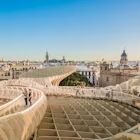
Aug 21, 2024 • 10 min read

Aug 20, 2024 • 7 min read
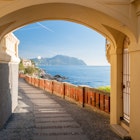
Aug 16, 2024 • 9 min read
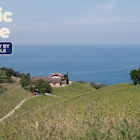
Aug 1, 2024 • 8 min read
10 epic Spain road trips to do on your own (2024)

After years on the road exploring my own country, I bring you the best Spain road trips.
If walking is one of the best ways to see a city, then driving is one of the best ways to see a country. Driving in Spain will bring you me deep, deep joy, rising through the red dust of Andalucía and plunging through the deep green of Galicia.
Book your rental car online now. Check this complete guide on how to book your rental car.
Historical city centers in Spain were designed for pedestrians and, at a stretch, horses. They were not designed for cars! Be careful when following Google Maps, Apple Maps or Waze instructions into steep, old towns. You can find yourself unable to make some tight turns and then somehow need to reverse backwards down a narrow road. Stick to the main roads in town!
Do you want to experience an amazing Spain road trip but you’re not sure where to go?
Choose from these 10 stunning routes for your road trip in Spain all with a detailed itinerary.
Table of Contents
The ultimate Spain road trip
If all you have is two weeks, then this is the best Spain road trip itinerary for you. This two week self-drive Spain itinerary brings you the highlights of the country at a reasonable, but not relaxed, pace.
However, I’d always advise that you take is slow if you can. It’s far more enjoyable to spend more time out of the car than in. With that in mind, check out some of the other regional road trip ideas below.
Of all the places in the world, Spain is disinclined to rush. People here like to take their time and savor the joys of everyday life. Racing to fit your busy schedule does not usually rank highly in that regard.
The ultimate Spain road trip itinerary
- Day 1: Arrive Barcelona
- Day 2: Barcelona
- Day 3: Barcelona
- Day 4: Girona
- Day 5: Valencia
- Day 6: Valencia to Madrid
- Day 7: Madrid
- Day 8: Madrid to Toledo
- Day 9: Toledo to Granada
- Day 10: Granada
- Day 11: Seville via Córdoba
- Day 12: Seville
- Day 13: Cádiz
- Day 14: Málaga to fly home
Road trip through Andalucía
A road trip through Andalusia, Spain’s biggest region, unsurprisingly covers a lot of ground. This passionate place is the home of flamenco , jamón and bullfighting , as well as staggering, world-renowned monuments.
You can easily fill 2 weeks with UNESCO World Heritage Sites like the Alhambra in Granada , the Real Alcázar in Seville and the unbeatable mosque turned cathedral in Córdoba .
But a self-drive road trip through Spain allows you to visit off the radar places and explore local traditions like admiring the astonishing Semana Santa processions . From the beaches to the snowy peaks of the Sierra Nevada, driving through Andalucía really is one of the best road trips in Spain.
Andalucía car journey itinerary
- Day 1: Arrive in Málaga
- Day 2: Drive to Cadiz via Mijas and Vejer de la Frontera
- Day 3: Cadiz
- Day 4: Cadiz to Seville via Doñana National Park
- Day 5: Seville
- Day 6: Seville
- Day 7: Seville to Granada via Córdoba
- Day 6: Granada
- Day 7: Back to Málaga to fly home
Road trip through Catalunya
Barcelona is the most famous part of Catalunya but to see more of the Catalan character, get behind the wheel and enjoy one of the best road trips in Spain.
Travel by car in Spain to discover the sandy coast of Costa Brava . This beautiful region offers an amazing scenery, sleepy coves and some of the best restaurants in the world. I’m not joking. That’s actually a validated claim.
Apart from the medieval city of Girona , you’ll also find flamboyant artwork from local household name Salvador Dalí.
Catalunya car journey itinerary
- Day 4: Barcelona to Begur via Calella de Palafrugell
- Day 5: Begur to Figueres via Cadaqués
- Day 6: Figueres to Girona
- Day 7: Back to Barcelona to fly home
Road Trip along Spain’s Mediterranean Coast
Start your road trip with a mini-break in Barcelona where you can visit sights such as Sagrada Familia , Park Güell and unique buildings designed by Gaudí.
Next leg takes you south to Valencia – a seriously underrated Spanish city that offers culture, food and sunshine aplenty with an amazing historical center.
Alicante is the gateway to many of the mainstream Spanish beach resorts on the Costa Blanca. But this sunny city is also a popular holiday destination itself with its trademark alleys, palm trees and historic harbor.
End your trip visiting Cabo de Gata – a National Park not only about beaches and nature, but there are also many forts, ancient ruins and tiny villages.
Mediterranean Coast car journey itinerary
- Day 3: Valencia via Tarragona
- Day 4: Valencia
- Day 5: Alicante and the Costa Blanca
- Day 6: Alicante to Cabo de Gata
- Day 7: Cabo de Gata
- Day 8: Back to Alicante to fly home
Road trip through Central Spain
Treat yourself to a literary, gastronomic and thoroughly authentic journey through this central part of Spain, the region of Castilla y León . It’s one of the best road trips in Spain for hidden gems and a sense of exploration.
Although in a short route it’s impossible to know all the historical heritage of Castilla y León, this itinerary starts in Segovia so you can visit the aqueduct and the Granja de San Ildefonso , discover Valladolid, visit the cathedral of Burgos, admire the city of León and the cozy Zamora, to end up in the university city of Salamanca.
Castilla y León car journey itinerary
- Day 1: Arrive in Madrid
- Day 2: Madrid
- Day 3: Madrid to Segovia via La Granja de San Ildefonso
- Day 4: Segovia to Valladolid
- Day 5: Valladolid to Burgos via Palencia
- Day 6: Burgos
- Day 7: Burgos to León
- Day 8: León to Zamora
- Day 9: Zamora to Salamanca
- Day 10: Return Madrid to fly home
Northern Spain road trip
Prepare to be surprised when you find out what makes this one of the best road trips in Spain.
The northern area of Spain swaps dry plains for rocky coves, and bull rings for lighthouses and salt marshes amid the green. Famed for its seafood and as the finishing point for the Santiago de Compostela pilgrimage route , this road trip adventure will show you a different side of the country.
Northern Spain car journey itinerary
- Day 1: Arrive in San Sebastián
- Day 2: San Sebastián to Bilbao
- Day 3: Bilbao to Gijón via Santillana del Mar
- Day 4: Gijón to A Coruña via Cudillero
- Day 5: A Coruña to Santiago de Compostela
- Day 6: Santiago de Compostela
- Day 7: Santiago de Compostela to fly home
Road trip around Galicia
Decked out in deep green hues and bursting with salty seafood, a road trip through Galicia provides a completely different experience of Spain.
With a coastline more reminiscent of the rugged, craggy inlets of Scotland than the white sand of the south, it’s no surprise that Galicia offers seafood to make even the uncertain smile. Expect lighthouses, green fields, great walking routes and great food.
Galicia car journey itinerary
- Day 1: Arrive in Santiago de Compostela
- Day 2: Vigo via Pontevedradeume and Redes
- Day 3: Orense via Bayona and La Guardia
- Day 4: Lugo via Monforte de Lemos
- Day 5: Ferrol via Playa de las Catedrales
- Day 6: A Coruña via Pontedeume
- Day 5: Back to Santiago de Compostela to fly home
Road trip across the Basque Country
Link up San Sebastián, Bilbao and Vitoria for an epic road trip through Spain’s Basque country. Taste arguably the best food in the country in the pintxos bars in San Sebastián and take in the curls and swirls of the Guggenheim Museum in Bilbao .
From its own modern art museum to its magnificent cathedral, add in the magic of Vitoria, and you’ll find yourself with an unforgettable Spanish road trip.
Basque Country car journey itinerary
- Day 1: Arrive in Bilbao
- Day 2: Bilbao
- Day 3: Bilbao to Vitoria via Parque Natural de Gorbeia
- Day 4: Vitoria
- Day 5: Vitoria to San Sebastián via Tolosa
- Day 6: San Sebastián
- Day 7: Back to Bilbao via Zarautz to fly home
Driving the Balearic Islands
One of the best road trips in Spain involves flying to one of this small islands and taking a laid back approach to plans and itineraries all together.
Mallorca, Menorca and Ibiza are the 3 main Balearic Islands and each has a distinctive character:
- Mallorca is full of beautiful towns, UNESCO World Heritage and wild hiking routes.
- Menorca specializes more in secluded coves, snorkeling sites, towering cliffs, and verdant hills.
- Ibiza has party spots, stunning beaches coves and an incredible music scene.
Set yourself up with one home base for a week and take a series of day trips to explore either island.
Road trip through Tenerife (Canary Islands)
As the largest Canary Island off the northwest coast of Africa, Tenerife is famous for its fly and flop beach holidays. But there are so many unusual things to do in this beautiful island, from UNESCO World Heritage cities like Laguna to primitive biosphere reserves in Anaga Natural Park. It’s a hiking paradise and if tight turns and steep roads aren’t your thing, a great wild landscape awaits.
Driving through Spain takes on new and heady heights when you’re bounding over black volcanic landscapes. This is one of the best road trips in Spain as it’s also one of the most beautiful.
It’s also easy to combine with staying in one place and organizing a series of day trips around the island. So if packing and unpacking on a road trip deters you, try this instead.
Tenerife car journey itinerary
- Day 1: Arrive and stay in UNESCO World Heritage La Laguna
- Day 2: Drive El Teide Volcano
- Day 3: Los Gigantes for a whale watching excursion
- Day 4: Hiking in Anaga National Park
- Day 5: Orotava, Icod de los Vinos and Garachico
- Day 6: Pyramids of Guimar
- Day 7: Explore La Laguna and fly home
This article is part of a complete tutorial about car rental in Spain where you can read all the information you need to organize your road trip around the country.
Here is a complete summary of all the guide:
1. Best way to travel across Spain: road trip or train? 2. Full guide on traveling to Spain by car 3. 10 epic Spain road trips to do on your own 4. How to book your rental car online 5. How to find cheap car rental rates? 6. 8 essential rental car tips to get the best deal 7. Drive in Spain with an international driver’s licence 8. Guide for getting around Spain: rental car 9. 6 essential tips for driving in Spain 10. Guide to car parking in Spain: tips, costs, and regulations
Start planning your upcoming trip to Spain
- Find the cheapest flights to Spain
- Book the best hotels at the lowest rates
- Find the cheapest train tickets ( tutorial )
- Save by choosing the best Barcelona city pass for you with my exclusive discounts. My favorite is the Barcelona Pass .
- Book the best tours and day trips in Barcelona in English
- Pay in Euros and avoid commissions with your Wise debit card ( tutorial )
- Buy your prepaid SIM card online to have internet connection as soon as you arrive ( tutorial )
- Get your travel insurance to avoid bad surprises ( review )
- Rent a car at the lowest rate
- Book your Barcelona Airport transfer
- Pronunciation
THE BEST SPANISH-ENGLISH DICTIONARY
Get more than a translation, written by experts, translate with confidence, spanish and english example sentences, examples for everything, regional translations, say it like a local.
Making educational experiences better for everyone.
Immersive learning for 25 languages
Marketplace for millions of educator-created resources
Fast, easy, reliable language certification
Fun educational games for kids
Comprehensive K-12 personalized learning
Trusted tutors for 300+ subjects
35,000+ worksheets, games, and lesson plans
Adaptive learning for English vocabulary

Spain Road Trip - The Ultimate 2 Week Itinerary
Start your road trip from barcelona.
With this road trip spanning the length of Spain, you can start at either end, but we often find ending in a hotter place more sun and sea works better.
The first few days you can take a bit more history and culture, visit sights and museums before heading for more relaxed scenery driving along the Costa del Sol towards the end of your trip.
Day 1: Barcelona - Fly in, sightseeing & seafood dinner
This epic Spanish road trip starts in the Catalan capital - Barcelona.
One of the best things about going on a road trip to Spain is the weather - check out the best time to visit Spain to pick your month of travel. Catalonia is beautiful and captivating all year round - so get ready for the adventure of a lifetime.
If you've arrived with your own car, our advice is to park it up for a few days at the nearest underground car park as you won't be needing it around town.
If you plan to hire a car, don't bother picking one up until day 3. While there is ample parking around the city, much like most of Spain, getting around on foot or using the relatively cheap metro system is a lot more convenient and relaxing.

Where to stay in Barcelona
There's a huge choice of hotels and villas to stay in when visiting Barcelona, some of them considerably more expensive than others.
A top tip is to stay somewhere within a short walk of the main sights such as La Rambla and La Plaza Real and near the old port - this is where you'll be spending a lot of your time and where the best restaurants in town are.
I would highly recommend the Onix Liceo - it's located in the Gothic Quarter, right near Las Ramblas, the city centre and the Old Port. It's really good value for money too - especially for somewhere so central. If you're looking for the perfect hotel to stay at in Barcelona, this is it.

The majority of car rentals are really close at the Placa dels Paisos Catalans so this is handy for getting your Spain road trip underway on day 3 as you can just walk across with your bags.
Having checked into your hotel and dropped your bags off, it's time to go see what this crazy (in a good way) city has to offer, so head on down towards the Plaça de Catalunya at the top end of Las Ramblas.
Walk along Las Ramblas and explore the Gothic Quarter
The two streets and the wide promenade in-between are the true heart of Barcelona. Street artists line the pavement, eager to do a caricature of you, while street dancers, human statues and various other forms of entertainment vie for tourists' attention.
The first day is always a great opportunity to relax before your Spanish road trip really gets underway so take your time as you stroll around.

Walk halfway down Las Ramblas until you get to the Liceu metro station and turn left into the Gothic Quarter, the ancient part of the city which forms the main part of the Old Town.
One of the first things you'll see is the Barcelona Cathedral. This majestic dark stone structure is a beautiful example of fine Gothic architecture and - miraculously - seems to be somewhat off the tourist radar, making the visit that much more peaceful.
As you wander around the twisting streets of the area, head towards the sea until you reach Port Vell. This marina used to be the busiest trade port of the region and today serves as a yacht harbour.
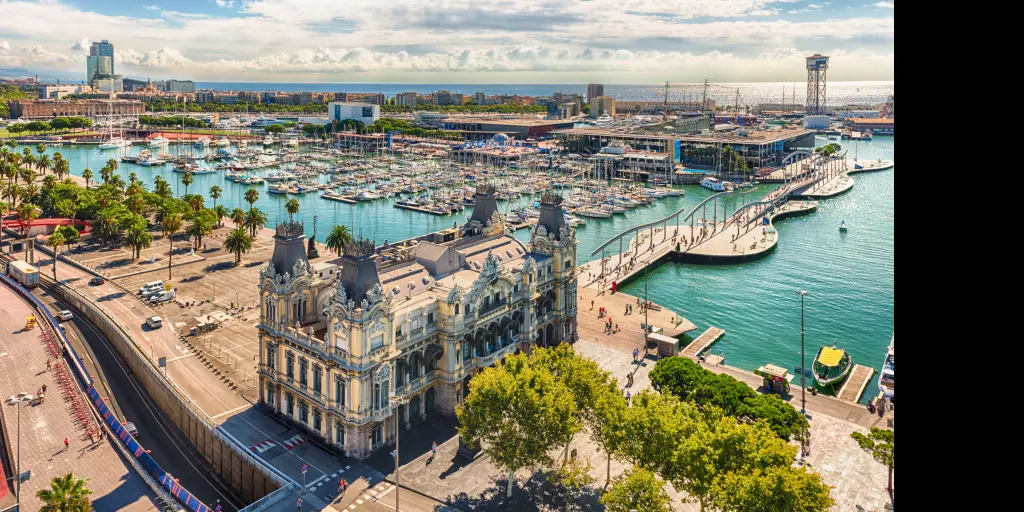
Here you'll see a large brick building which houses the Museu d'Història de Catalunya, which gives a somewhat unique perspective on the region's continuing fight for independence as well as the history of the Catalonia's relationship with other parts of Spain.
For a spot of late lunch just before you go into the museum, you can't do much better than walk into the small Barceloneta district right behind the building.
Here you'll find a large number of bars and restaurants with all manner of Catalan tapas on offer.
Grab dinner in Barcelona's Port Vell
Barcelona has a famously fabulous dining scene, and there's a multitude of outstanding restaurants dotted around the city to choose.
The majority of these are located within walking distance of Las Ramblas, with a few further afield.
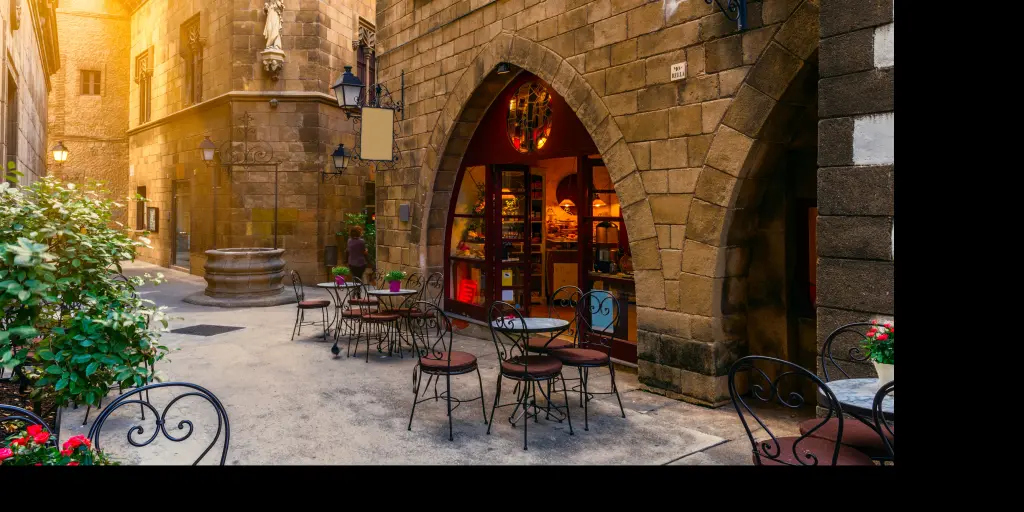
If you fancy some fish and a romantic table in the cool evening sea breeze then return to Port Vell and pick one of the dozen restaurants serving the freshest seafood in town.
Day 2: Barcelona - More sightseeing, tapas & hiking
Visit the gaudi's buildings and sights.
I know you're probably thinking that it's time to get going on your Spain road trip, but Barcelona is worth spending a full day after your arrival - you'll be very glad you did!
Your second day in Barcelona is perfect for a stroll around town taking in some of Gaudi's most famous sights. The key sights are relatively close to each other and all of them are not too far from your hotel, so it will be an easy walk!
Begin the morning in style and find a traditional café on your way to Passeig de Gràcia.
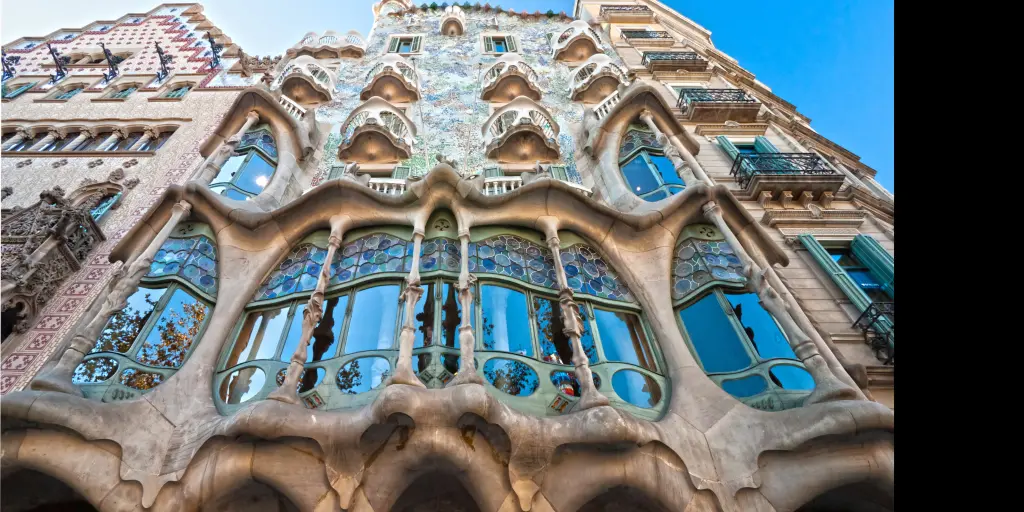
As you make your way through town, you will notice that most street crossings in Barcelona form octagonal squares and these are the best place to equip yourself with some bakery produce and fresh orange juice. If you're feeling peckish, you can indulge in one of the famous crêperies.
The first stop on your route will be the Casa Milà on Passeig de Gràcia. This famous apartment building was designed and built by Gaudi.
Just as impressive on the inside as the outside, it's worth going in to see the layout of the skeleton-like structure and get a good view of Barcelona from the wavy rooftop.

Once you're back outside, head north east on Carrer de Provença. Keep going in a straight line over the Avinguda Diagonal and you will very soon see the Sagrada Familia.
This truly unique Gothic Cathedral is still under construction, with decades of work yet to be completed; nevertheless, it's one of the most unique and jaw-dropping cathedrals in the world.
The amount of detail on the facades is astonishing, and everything from the interior decoration to the columns, towers and the naves is unlike any other in the world. You won't see another cathedral like it on your road trip through Spain... or anywhere in the world.

It's worth sitting down in one of the nearby coffee shops for a moment or two to take in the magnificent sight and do a spot of people watching before carrying on with your Barcelona tour.
Your next stop is the famous Park Güell, which is just a short walk up the Carrer de Sardenya. It's free to enter, so be prepared for crowds if you plan to visit over the weekend.
Once you're inside, have a wander and explore all the bizarre ins and outs of the park. Everything from the asymmetrical houses by the main entrance through to a large pagoda inside was born in the mysterious depths of Gaudi's brain.
Indeed, he used to live in one of the houses on the Park's grounds and frequently relaxed here himself. Be sure to walk to the highest point for fabulous views over the city.
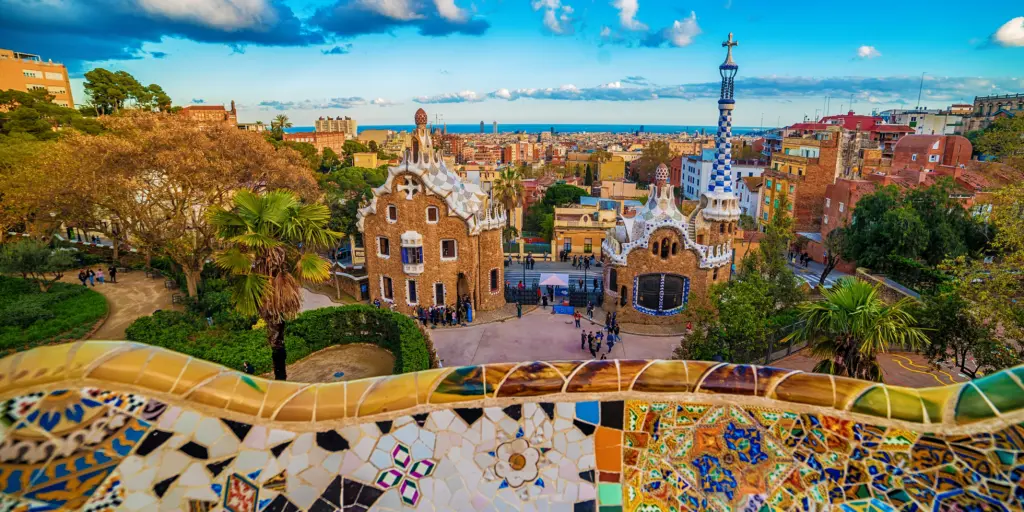
Lunch in Barcelona the Spanish way
You could spend hours discovering new bizarre things in Park Guell, but at some point your appetite is sure to kick in.
Lunch options are fairly broad around the area, with a number of great restaurants located nearby the park.
Alternatively, you can learn from the locals and stock up on some local Iberico ham, bread, olives and cheese and have a picnic in the warm sunshine somewhere within the park. Remember that Day 3 is when the Spain road trip properly starts and if you are going to stop for a picnic on the way to Valencia, plan ahead to not eat the same packed lunch two days running!

Walk up Mount Montjuïc
As the afternoon passes by and dusk approaches, it's time to head over to the last sight of the day - Mount Montjuïc, right across the other side of town.
The walk will take about an hour and a half, although the metro option is fairly straight-forward with a direct line from the Lesseps stop nearby to Poble-sec at the foot of the Montjuïc Park.
Take your time to climb to the top of the hill, where a number of monuments built for the Olympics are dotted around the green park.
The views over the city of Barcelona are spectacular from here, so spend a few minutes figuring out where you've walked and finding your hotel roof. If you walk on a little further, you can see past the Barcelona bowl and map out the route for your Spain road trip first leg towards the mountains in the distance.
On your way down, make sure you pass the Montjuïc Fountain to watch the water and light display that takes place every half hour starting from 7pm - it's worth it. Note that the shows don't happen Monday to Wednesday, so plan your route accordingly.
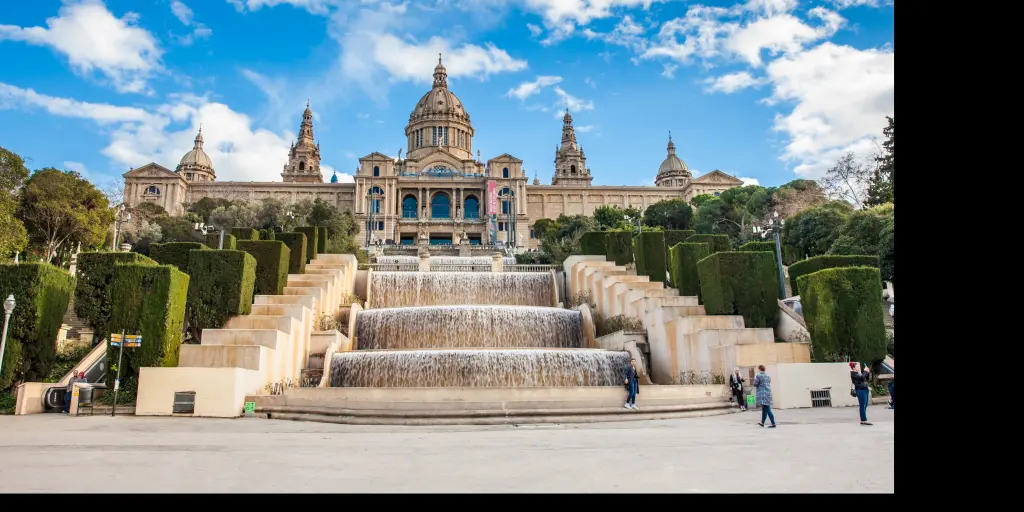
By the end of the display you will be ready for a hard-earned spot of relaxation before freshening up and heading out to town for food. Perhaps a hearty steak dinner?
Drive from Barcelona to Valencia
First stop on the way is Valencia - a historic trade city on the Costa Blanca.
Day 3: Drive from Barcelona to Montserrat to Valencia
Distance: 265 miles
Visit Montserrat Monastery to kick-start your Spain road trip
Wake up, have some breakfast and check out of your hotel. This is a road trip after all, and it's time to hit the road!
Once you've loaded your luggage and set up the GPS, drive inland. The first stop on your Spain road trip itinerary is the majestic Montserrat Monastery.
This unbelievably beautiful secluded establishment - home to Benedictine Monks - is perched atop a picturesque mountain in-between two peaks.
Here, you will see stunning interior decorations and a number of highly prized religious relics.
Driving-wise, you have a choice of going up the mountain and parking close to the Monastery, or parking at the bottom and taking the train.
The train provides great views down the mountain and of the Monastery itself, so that's our preferred option.
Beware that if you choose to park at the top, you will still have to walk a fair bit uphill to get to the monastery.

The drive from Barcelona to Valencia along the coast
The drive to Valencia along a toll road will get you there in around 3 and a half hours and is a perfect way to kick off the driving on your Spain road trip. If you want to stop for lunch along the way, your best bet is to stop in Tarragona soon after you get to the coast on your way south.
The majority of other towns along the route are fairly uninteresting, with a score of high-rise hotels lining the shore and a distinct lack of restaurants and views.
Tarragona, however, is an ancient city rich in history and culture. A decent range of restaurants in the town centre will offer plenty of choice before you jump back on the AP-7 on your way to Valencia.
If you have time for a detour, hop off the motorway (remember - you'll have to pay the toll!) and check out the Pont del Diable - the Les Ferreres Aqueduct is right by the Tarragona junction. If you head into the city, there is a large amphitheatre and ruins of a Roman Forum to see.
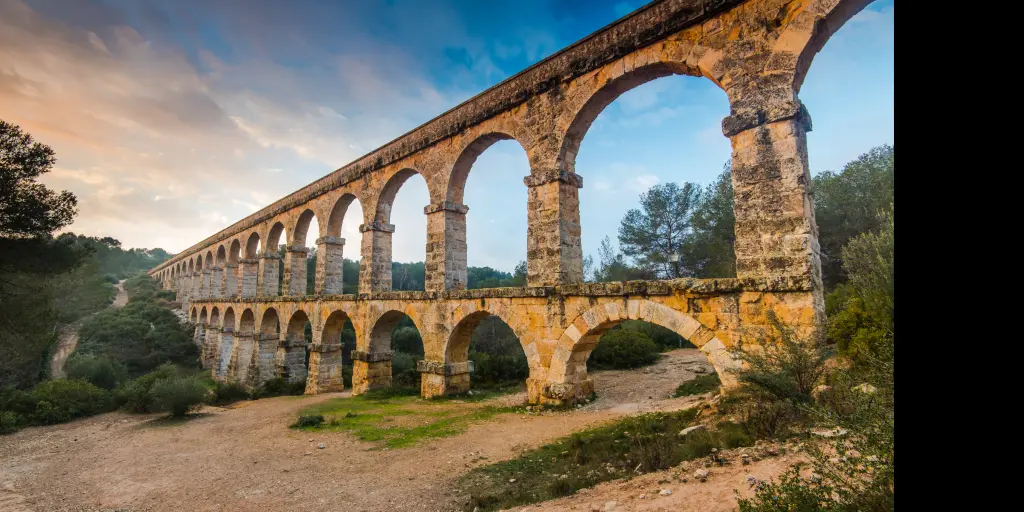
As you arrive in Valencia, you will notice that the city's Old Town is strikingly different to the rest of the city. The city centre is confined by a river to the west and a long green park that also used to be a riverbed before the river was diverted in the fifties.
As with most Spanish cities, vast numbers of affordable underground car parks are provided, so find one near your hotel and dump the car for two days as you won't be needing it to get around.
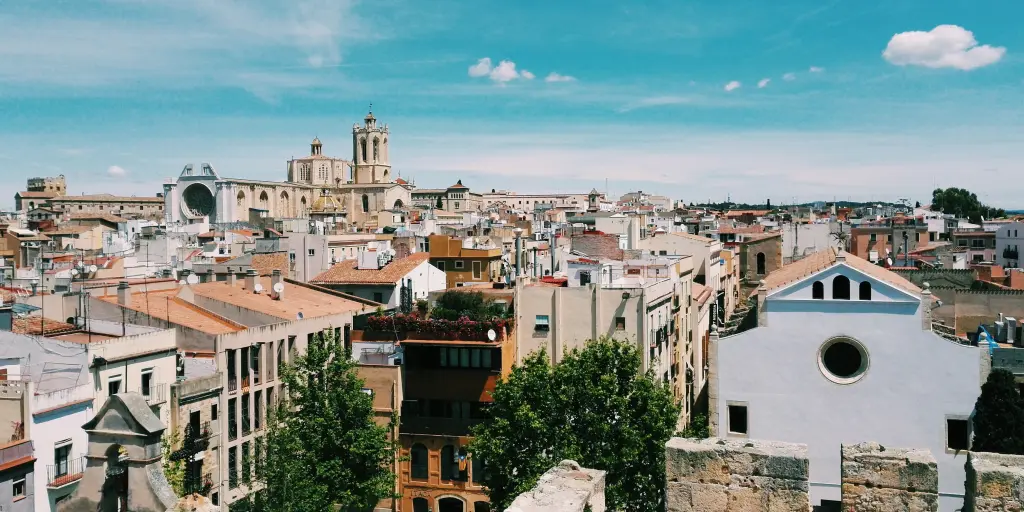
Where to stay in Valencia
Now that you're travelling by car, you'll want to pick a hotel with parking or somewhere nearby a car park.
Silken Puerta Valencia is a sleek and modern hotel with super comfortable rooms and the perfect location on the east side of Jardin del Turia. It is easy to drive to from the V-21 and it has FREE on-site parking, which is ideal for road trippers.
The rooms are super reasonably priced (especially compared to other hotels nearby) and the breakfast is truly outstanding.
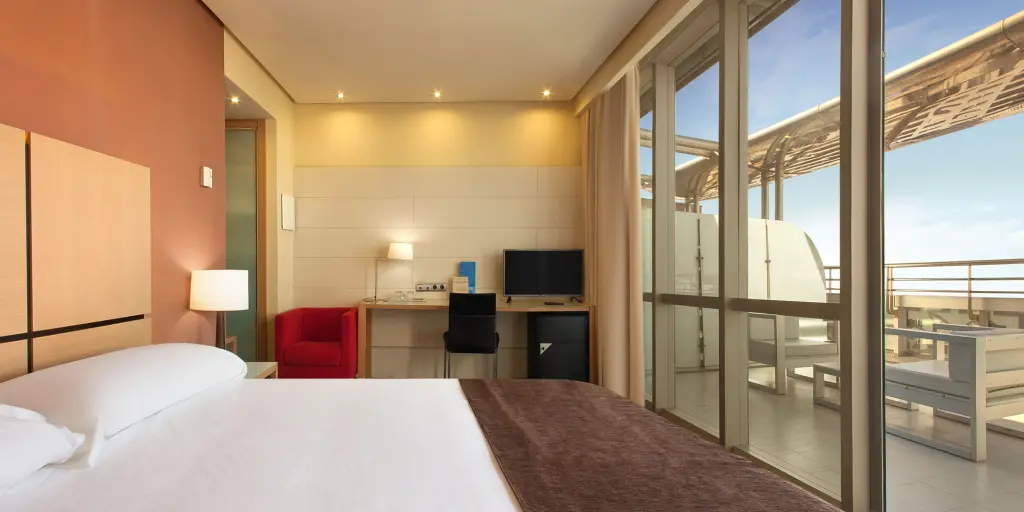
Day 4: Valencia - Market, Old Town and aquarium visit
Explore valencia old town and visit the market.
With only one full day to be spent in Valencia, you really ought to get yourself out of bed at a reasonable hour and head into town for some traditional Valencian breakfast.
Make your way towards the Mercado Central in the heart of the city (it's a 30 minute walk or a 25-minute bus ride) and stop in a cafe along the way for a couple of churros (traditional doughnut-like treats) and a coffee or a large glass of blood orange juice.

The town of Valencia is miraculously unpopular with tourists - which makes it a very appealing Spanish road trip destination!
Compared to most other Spanish cities, you will rarely see a tour guide leading a stampede of visitors here.
The only ones who make it this far away from Granada and Barcelona can typically be found in a queue outside the Oceanogràfic first thing in the morning, which is exactly why the best time to go is later on in the day.
Despite its somewhat under-the-radar status, Valencia is one of the most beautiful Spanish cities. Its Old Town is full of narrow streets criss-crossing through a mix of architecture from across the centuries.
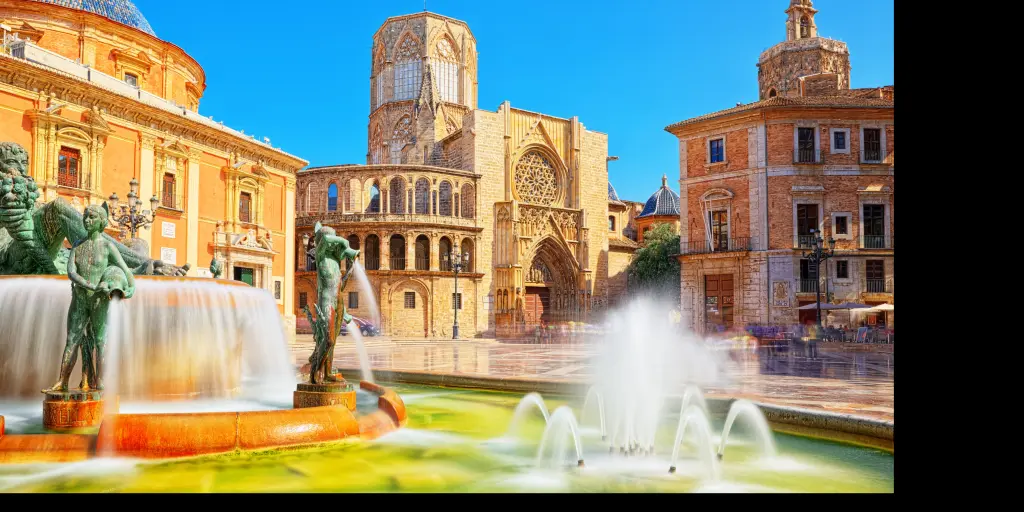
The market, one of the oldest in the country, sells a wide range of fresh produce and local delicacies. Our top tip is to try the dozens of varieties of ham and stock up on your favourite snacks for a picnic later on in the day.
Once you've purchased everything you want and are ready to move on, exit onto the Plaça del Merkat and pay a visit to the UNESCO-listed Lonja de la Seda across the street, which is free to enter.
This grand Gothic building once functioned as a Silk Exchange. Inside you'll see beautifully decorated walls, floors, ceilings and carved columns indicating the power and wealth of Valencia in the 15th and 16th centuries.
It's fascinating to see the sheer difference between the two historic trading hubs only yards away from each other.

To round off the morning, walk the short distance towards the Valencia Cathedral. This beautiful and - to a degree - austere structure can be somewhat tricky to find, as it's closely surrounded by buildings on all sides.
The Cathedral is known for holding the most likely true Holy Grail - the cup from which Jesus drank at the Last Supper.
We'd highly recommend you pay the €2 to climb up the Cathedral's tower, as the views that open up over the city and the busy harbour are truly stunning. It's quite a walk to the top (205 steps), so make sure you've done your stretches before you make the attempt. You can even plan the next leg of your road trip through Spain as you look towards the hills in the distance!

Have a picnic in the Jardín del Turia
The Cathedral is only a stone's throw away from the Jardín del Turia. This vast green belt around Valencia's Old Town used to be a river until the source was diverted following a flood in 1957.
Today this park has everything from a roller skating park to football pitches and large chess sets. This is exactly why you bought the picnic ingredients at the market earlier on in the day.
Not every part of our Spain road trip has to involve driving, so a stroll is in order. The gentle walk down to the Ciutat de les Arts i les Ciències will take you around 45 minutes, so you'll be able to pick the best spot for lunch on your way.
The park's chilled out vibe, away from the humdrum of the city, combined with the smouldering Valencian sunshine will make for a great meal alfresco.
Mingle with sharks at the Oceanogràfic
The Oceanarium is located on a large and relatively new site called the City of Arts and Sciences. The entrance is easy to miss as it is relatively small, with almost the entire structure buried beneath the ground.
Tickets are expensive but well worth it, as this is one of the best and largest marine parks in the world.
A major highlight of the attraction is a long tunnel that takes you through a tank, with various species of shark swimming alongside swarms of multicoloured fish. Dolphin shows are held regularly, so check the schedule when purchasing your ticket.
Closing times vary, with doors shutting at 6pm during the winter and as late as midnight during the summer months.
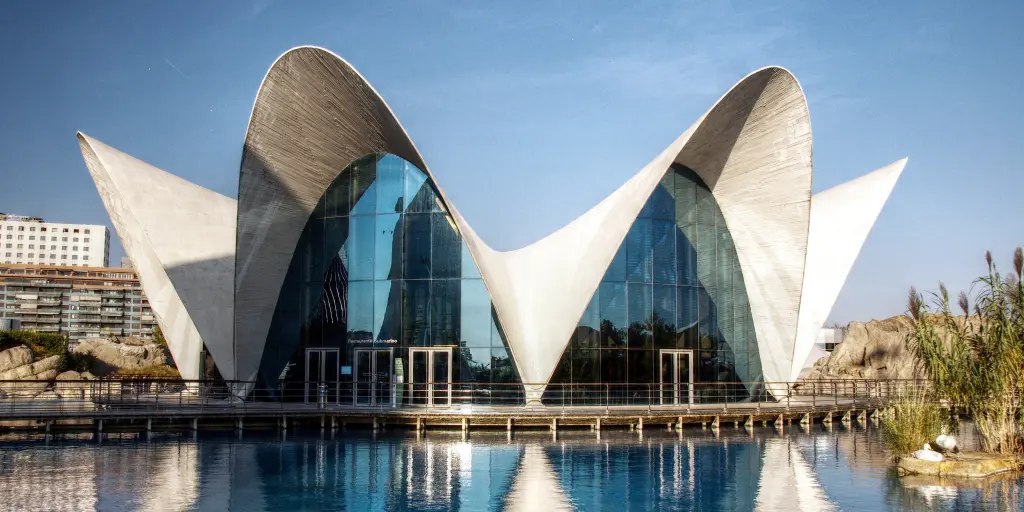
Where to go for dinner in Valencia
Once you've haddock a whale of a time, it's time to find a plaice for dinner (just couldn't resist the op-perch-tuna-ty for a fish pun!)
Your best bet is to head back into town and go towards the Plaza del Ayuntamiento. There is a very broad selection of restaurants in that part of the Old Town, with a large number of them specialising in the local specialty - fresh fish.
Of course there are other options around, but you would be doing yourself a real disservice if you do not try a good fish restaurant in Valencia.
Spain road trip arrives in Granada
Having seen the best of Valencia, it's time to scale some mountains and head towards the sunny province of Andalucia with its endless beaches and beautiful white villages.
First stop on the way is Granada - one of our favourite Spanish cities that just feels great on every single visit.
Day 5: Drive Valencia to Granada via the Sierra Nevada
The drive down from Valencia to Granada is almost a mini Spain road trip in itself. It involves following the coast south to Alicante, before heading west and going over the snowy peaks of Sierra Nevada to Granada on the other side. This may sound like an ominous route, but it's actually easy and relaxed.
Once you leave Benidorm in your rear view mirror (it's really not worth stopping for), and head past Murcia, you will suddenly notice an eerie silence.
Given that the next 70 odd miles are pretty much an empty desert on a mountain plateau, nobody other than you seems keen to drive along this route.
This complete absence of other people is perfect for a relaxing drive in some of Spain's most fantastic scenery. Contrary to any fears you may have had, the road is straight and great for driving. The snow-covered mountain peaks form a gorgeous backdrop, and you're likely to have the road almost to yourself all the way there.

Going on a Spain road trip and spectacular mountain views was maybe not the obvious association, but there are few things better for a relaxing drive.
Now we obviously do not condone speeding, but you're guaranteed to be pleasantly surprised by how quickly you get to Granada - just be careful to stay within the speed limit for the two speed cameras on the way. They're clearly marked by three separate signs, each indicating exactly how many metres separate you from a €400 speeding ticket.
We know that you might have already had more picnics on this trip than you did over the course of the last decade, but we promise that this is the last one.
Every now and then you'll come across a rest area by the side of the road which often coincides with a Mirador - a great view of some beautiful landscape.
Take your pick of the pit stops and park up to have your lunch at one of the wooden tables designed exactly for this purpose.
Where to stay in Granada
If you want to stay in central Granada, at the heart of the action, head to the boutique Hotel Palacio Santa Ines.
Tucked away in a narrow street in the historic centre, the Hotel Palacio de Santa Ines consists of two revamped 16th-century buildings designed in the traditional Mudejar style.
With its tranquil inner courtyards, lovely spacious rooms and super convenient proximity to the Alhambra fortress and the Granada Cathedral, it's the perfect place to rest for a few nights.
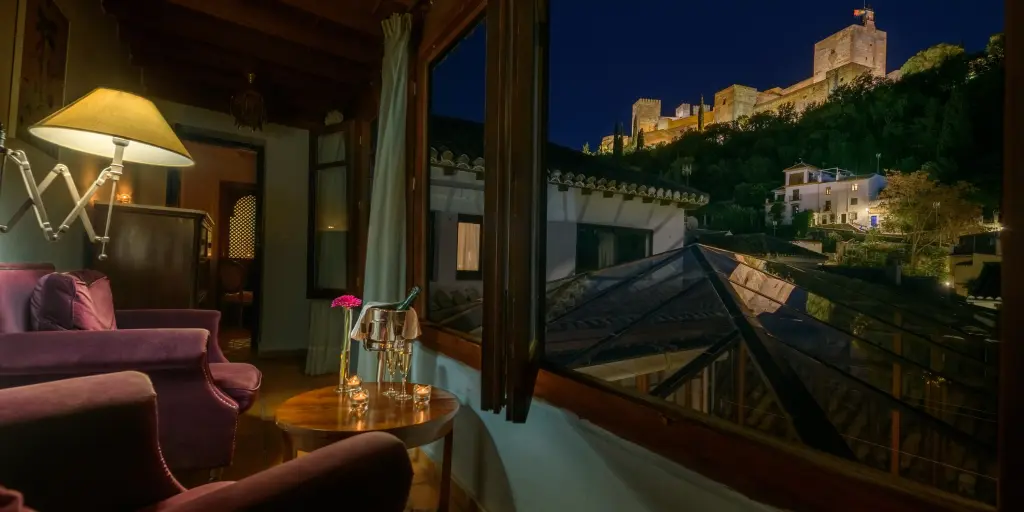
The only issue with staying in central Granada is parking.
Luckily, the hotel has thought about your Spanish road trip needs and has partnered up with two nearby public car parks, who offer a special rate just for their guests. Simply park your car and bring your parking ticket to the hotel (they'll even reimburse you for a cab ride if the car park is too far to walk).
The hotel will stamp your ticket with a lower daily rate (€19.50 for 24 hours). Simple as that!
Head out to enjoy a tapas dinner in Granada
After dropping off your bags, go out to enjoy the evening in this awe-inspiring city. We recommend a walk around the compact town centre, which is rife with cheap and cheerful tapas restaurants.
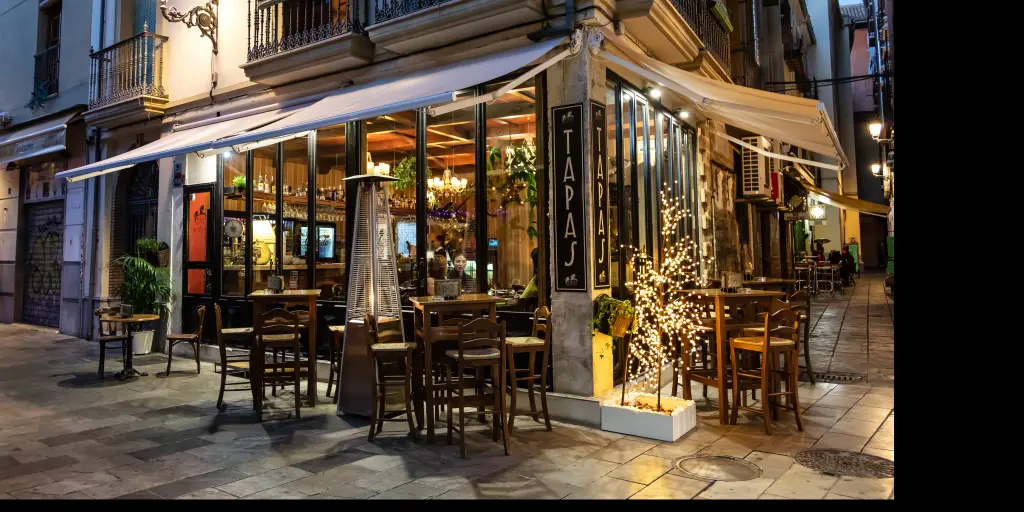
For a cosy, relaxed option, head towards Plaza de las Pasiegas. Here you will find a quaint and unassuming little restaurant called Rollo offering a number of quirky dishes.
Our tip? Try the crunchy pancakes made with tiny prawns... delicioso!
Day 6: Granada - Visit the Alhambra fortress
Spain has culture in abundance, so you simply can't ignore it! As one of the most famous and recognisable tourist attractions in Spain, the sprawling Alhambra palace is a symbolic icon of the country. It's positively enormous, so you'll need almost an entire day to see all the various sites around this old Moorish palace complex.
Spain road trip top tip : Be sure to book your tickets ahead of time (see the official Alhambra website for details) as during peak season the limited daily allowance can be sold out weeks in advance. You can't miss out on visiting the Alhambra.
There are buses that can take you to the Alhambra entrance, but the walk up the hill is not strenuous and will make for a pleasant 20-minute stroll.
Start at buy buying an ice cream on the corner of Plaza Santa Ana, where you'll find flavours ranging from marshmallow to kiwi fruit, and head up the Cuesta de Goméres through the park at the foot of the Alhambra walls.
Once you've made your way to the Alhambra's main entrance at the far side of the complex, head right past the queue of ticket hopefuls to one of the yellow machines, insert the card used in pre-booking, and walk straight in.
Pay attention to the time you selected for entering the Nasrid Palaces and be there around 25 minutes early to join the queue.
Other than that, take your time to explore the various sights and take pictures of the sprawl of Granada below you, with the majestic Sierra Nevada mountains in the background.
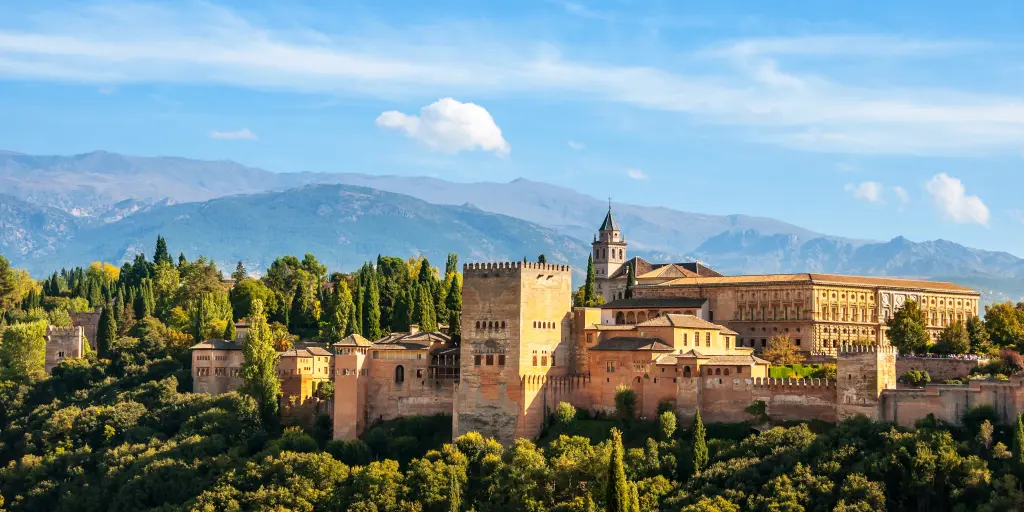
Enjoy (free) tapas for dinner
Spend your time relaxing in the evening. If you want a taste of typical local food, head for Calle Navas, right in the centre of the Old Town. This narrow street is home to dozens of small family-owned restaurants serving all manner of Andalucian and general Spanish cuisine. The tables in the street are great as the cool breeze and night sky will are a perfect compliment to your bottle of Rioja.
You will probably have tried a lot of tapas on this road trip through Spain, but Granada is known as the city of free tapas. This means you can eat very cheaply if you play your cards right. Most restaurants will give you a free tapa for each drink you order, with each tapa increasing in size as you go on.
To get the most bang for your buck, order a ca ñ a of beer (small glass) as opposed to a tubo (big glass). You'll finish the beer quicker, which means more tapas!
Day 7: Granada - Explore Old Town & Albayzin
Your second day in the city can be spent wandering around the medieval streets and seeing more of the 'real' Granada.
There are a number of distinct areas, with the west part predominantly devoted to typical high street shops. The area around the Cathedral has a large number of restaurants, so study the menus on your way around to pick out your evening meal.
Visit the Cathedral and Capilla Real
The north side of the Cathedral has a large spice stall offering every spice you've ever heard of and then some - this can be an attraction in its own right!
Once you're done smelling the various beans and roots, visit the Cathedral itself and the adjacent Capilla Real. These grand buildings are an archetypal example of southern Spanish church buildings - rich in history, with elements of the Moorish culture making their way into traditional European architecture.

Once you've done your sightseeing, head up the Calle Reyes Católicos towards Plaza Santa Ana - the town's main square, located directly beneath the Alhambra's walls.
Pay attention to one of the city's highlights: the green man traffic light at all pedestrian crossings. This green man is like no other, with a very unique moonwalk impression indicating when it's safe to cross the road.
Walk through the Albayzín neighbourhood
From Plaza Santa Ana, walk past the Church onto the Carrera del Darro. This street runs next to the river Darro, which is home to a large feline colony that spends its time roaming through the shrubs.
A little further along is a small square to your right lined with restaurants that offer a great opportunity for lunch. Take a break from tapas by ordering the fritto misto - a selection of various battered fish and seafood.
Next stop: the Albayzín, the quarter that runs uphill from this street on the opposite bank to the Alhambra.
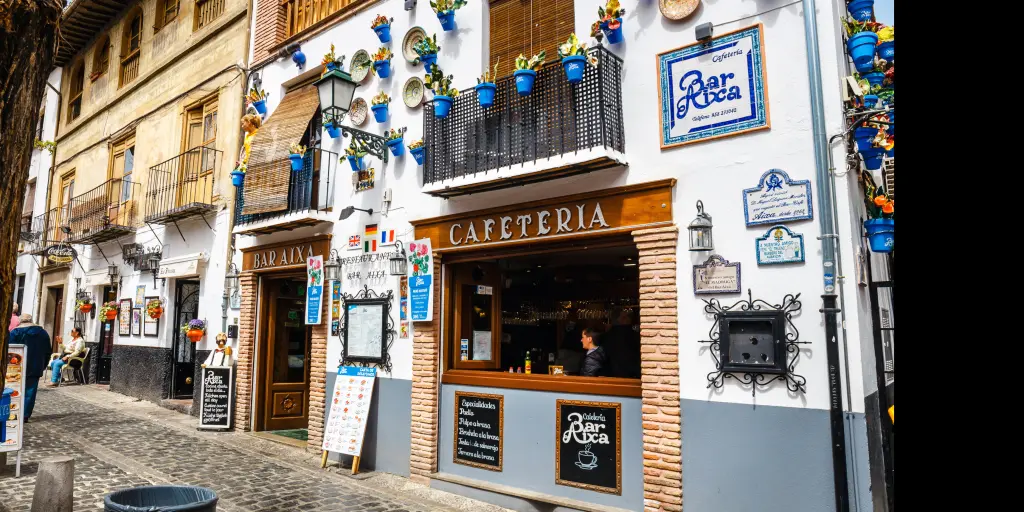
Take your time to wander through this ancient part of Granada, which is home to a vast number of small artisan shops selling everything from unusual metal work to traditional Moorish clothing.
If you head all the way to the top, the Mirador de San Nicholas is a great place to take in the views and snap some stunning shots of the Alhambra.
Day trips along the Costa del Sol
This might just be the best bit of the entire road trip through Spain. Yes - you'll be visiting some of the most amazing cathedrals and historic cities in the world, but there are few things that put as wide a smile on your face as cruising along the Costa del Sol.
The majority of the Costa has two roads running along - the free slower road along the shoreline and the fast toll road further inland.
Unless you're in a hurry or driving back to the airport, I'd stick with the coastal road for the views.
First stop is Benahavis via Malaga.
Day 8: Spain road trip continues from Granada to Benahavis
Once you have retrieved your car after breakfast, it is time to plough on with the Spanish road trip and make the short journey towards Malaga.
Once again, you will find mostly empty roads until you get close to the costas. You will know you're close to the city once the road suddenly dives down at a steep angle, and lush green vegetation appears in place of the arid rocky landscape.
As you descend towards the sea, you'll notice that the weather on the coast is mild in comparison to the hot inland Andalucia. If you don't notice this the first time round, you definitely will when you visit Cordoba.
Have a wander around Malaga
As you're passing right through Malaga, you might as well stop and have a wander.
The two forts overlooking the city are the best place for a quick break. The Alcazaba is the best preserved Moorish fort in all of Spain, and it sort of feels like the Alhambra's little cousin. The Castillo de Gibralfaro is set slightly higher and also offers brilliant views of the city and the Costa del Sol.
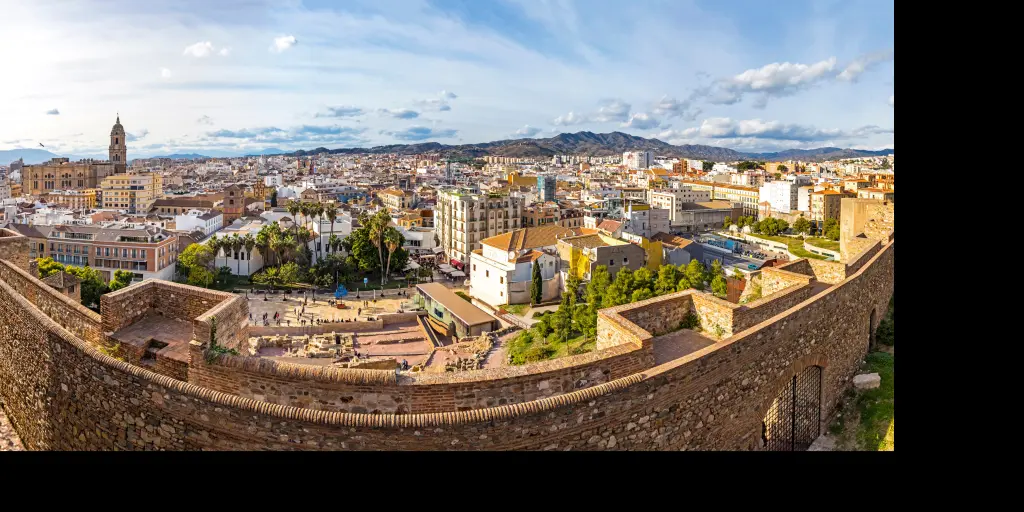
Spend a few hours in the city of Malaga itself. It may have a reputation as stag do-central, but this historic settlement is worth seeing in its own right.
The city centre is a tangle of cobbled streets, secret nooks and crannies and countless restaurants surrounding the Malaga Cathedral.
With tourists often passing Malaga by in favour of the Costa del Sol's many other attractions, take advantage of the atmosphere and treat yourself to lunch overlooking the marina, with the sun shining above you.
Spend the night in the white village of Benahavis
Getting to Benahavis is relatively straight-forward. You have a choice of the toll road AP-7 and the free A-7. The free road is more than good enough and takes a much more scenic route once the two split at Mijas. It also benefits from frequent exits, allowing you to stop along the way when you see a spot you like the look of.
The village of Benahavis is set in the Sierra de las Nieves mountains rising up from Marbella.
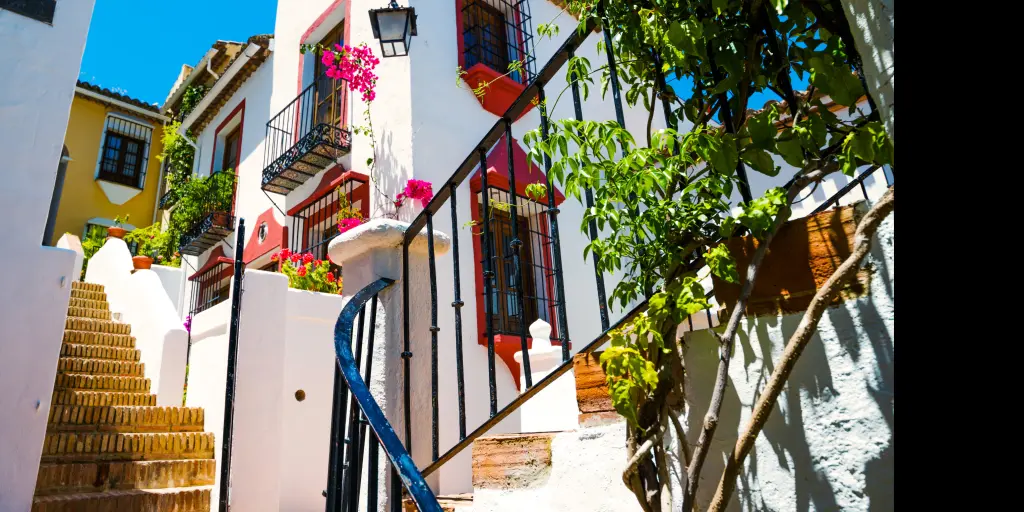
With only a 10-minute drive separating you from the beach, you benefit from staying in the culinary capital of the Costa del Sol, while also getting away from the huge package holiday hotels in the large resorts down below.
The peace and tranquillity will make for an enjoyable few evenings, and the choice of great food will make you want to come back time and again.
Where to stay in Benahavis
The best hotel to stay in the quirky Amanhavis right in the centre of Benahavis .
Set around a traditionally designed courtyard, each room has a unique theme around medieval Christian and Moorish influences. There are a lot of steps in-between the rooms and you can have dinner in the best restaurant in town in the court yard by the pool!
You can park your car for free along a couple of streets 50 yards down the hill from the hotel.
Day 9: Day trip from Benahavis - Visit Nerja and Marbella
Day 9 is perfect for seeing what the Costa del Sol is all about so this is the day your Spanish road trip takes you up and down the coast.
After a late lie-in, get in the car, put your windows down (and roof if you've got a convertible) and head down towards the sea.
Turn east along the coast and make your way past Malaga to the town of Nerja. This beautiful town takes a prime spot on the Andalucian coast and is steeped in history dating back to pre-Roman times.
Wander inside the ancient caves.
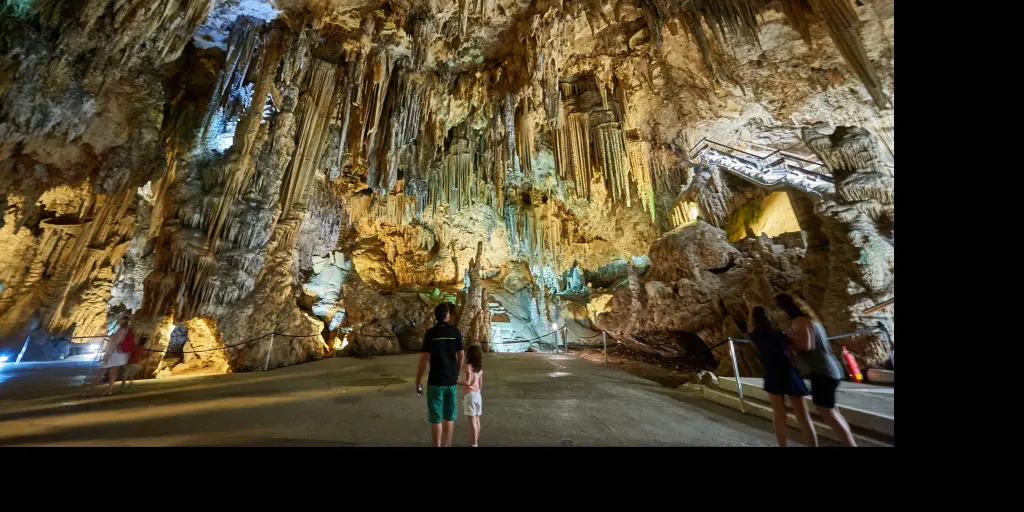
One of the main sights is a set of caves discovered in 1959.
The Nerja Caves were home to some early humans and neanderthals, with skeletal remains found throughout the linked caverns. Visitors can observe archaeological finds inside ranging from natural rock formations to prehistoric fossils and paintings.
The town of Nerja itself is a charming spot to get out and explore. Be sure to head to the elevated Balcon de Europa - a viewing platform built on top of the Nerja cliffs - for sensational views of the coast.
Two old cannons standing here remind you of the town's historical past, and the benches are a great place to enjoy an ice cream.

Drive to Marbella: the playground of the rich and famous
A late lunch is a good idea in Andalucia, as dinner is traditionally eaten later on in the evening.
Once you've seen enough of Nerja, hop back in the car and make the return trip down the coast to Marbella. No road trip in Spain is complete without driving up and down the Costa del Sol so head on right back along the beachfront.
Getting back to Marbella will take around an hour and a half. This famous resort is well-known for its beaches and countless hotels, but the Old Town is great for a midday stroll.
Park up underneath Paseo de la Alameda and cross the road to get into the historic part of town. There is a broad selection of restaurants with tables on every square, so take your pick and have some lunch here. Some of the restaurants do amazing sizzling prawns if you fancy a bit of seafood.
A number of shops sell everything from furs (no, really) to beach accessories.
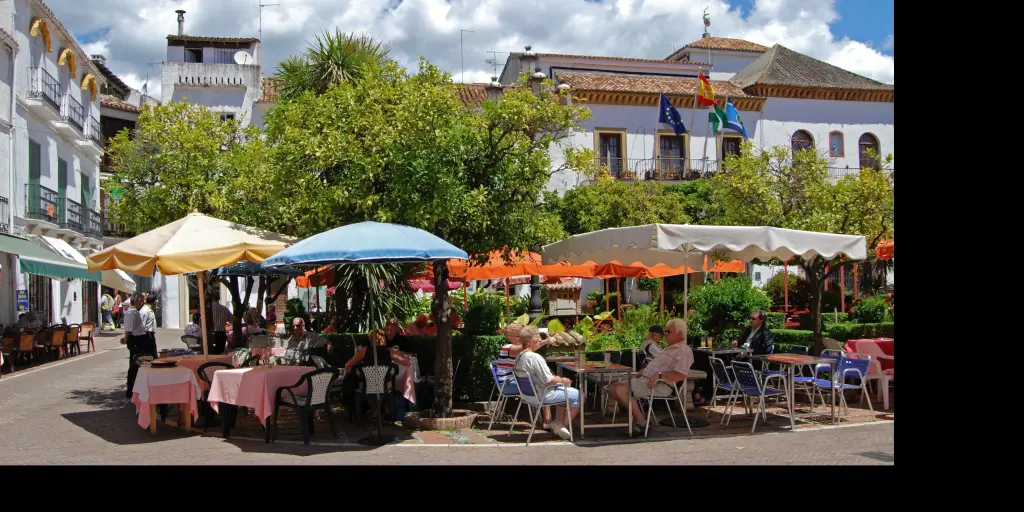
After having passed through Marbella, it's time to head to Puerto Banus only minutes away up the coast.
This is Costa del Sol's playground of the rich, with ridiculously expensive yachts in the harbour and an equally elaborate display of supercars parked next to them.
Top tip: Restaurants and shops here will sting your wallet, and the parking charges are insane. If you do want to grab some lunch, head to the west end of the marina (the one with the biggest boats) - there are a couple of spots that are less busy with reasonably priced menus.

Here's another insider tip for your road trip in Spain - park up for free at La Playa Fantastica - the closest beach to Puerto Banus.
Come back out of Puerto Banus and turn right onto the A-7 motorway towards Malaga. Stay right and take the right turn onto the N-340 towards Marbella.
As you come off onto the N-340, take the first turning right onto a narrow lane running towards the sea, then take the second street on the right and follow it down to the beach. You can park your car here for free for as long as you like and have access to one of the best beaches in the area with a great beach bar.
Puerto Banus is a mere 200 metres away, so you can stroll along at your leisure to have a closer look at how the other half live and inspect the exotic automobiles.
Spend the afternoon and early evening relaxing on the beach with the odd cocktail thrown in before making the 10-minute trip back up into the seclusion of Benahavis.
Enjoy dinner back in Benahavis
Freshen up in your hotel room before making your way through the narrow streets to select your restaurant for dinner.
Note that with many visitors coming from resorts up and down the coast, going out a little later can mean a less busy and more relaxed atmosphere.
Day 10: Road trip along the Costa del Sol to Casares and Ronda
Drive to casares - one of the most beautiful 'pueblos blancos' in spain.
Today shall be the day of the Mirador . This Spanish word encompasses everything we like about driving up into the Andalucian mountains, as there are frequent labelled roadside stops allowing you to take in the magical views.
You could break tradition and set off on this leg of your Spain road trip before having breakfast to get down to Estepona.

This relatively quiet resort town has a number of cafés and bars on the seafront where you can pause and indulge in a couple of waffles covered in chocolate sauce.
Be sure to fill up the car before heading off the main road and up towards Casares, as petrol stations off the coast are few and far between.
Casares is pretty much postcard-perfect, with neat white houses built into the mountains.
With a population of just a few thousand people, the town is definitely small, but it has a surprising number of nice restaurants and hotels to choose from.
When you arrive in Casares, park your car and head towards Plaza de España, which is the focal point of this small community.
To get some great views, make your way up the narrow street next to the Virgin del Rosario Chapel and keep heading uphill until you reach an old fort at the top.
If you walk a bit further along, you will come to a viewing platform set above a sheer cliff face. From here you'll likely see a number of falcons and kestrels up close and personal - and the views of the town below are simply spectacular.

Head to Ronda and walk along the bridge
Once you've got your snaps and feel that you've seen all there is to see in Casares, it's time to hop back in the car and make your way further inland to the majestic town of Ronda.
This unique Andalucian town is placed on top of two plateaus with sheer rock cliffs down to a river valley below. The scenery is incredible from every angle and the town itself is a real marvel too.
Parking can be troublesome, so grab any spot you see once you get near the centre. Large underground car parks are available further out, but are a fair walk from the centre - we like the Parking Martinez Astein - it's about 10 minutes' walk down the main shopping street, but easy to get in and out of.
The main attraction of the city is the Puente Nuevo - the newest and most striking of the town's three bridges across the Guadalevín gorge.
This unbelievably beautiful structure took 42 years to complete and is one of Spain's most famous sights. The view that opens up from the top of the bridge is impossible to describe and pictures do not do it justice - it's just one of those places that you have to see for yourself. If there's one place that makes your Spain road trip worth it, this is it.

Once you've gotten over the quiet gurgle of the river below and the amazing views, it's time to pay attention to the rest of the historic town and there's definitely a lot to see.
The ancient cobbled streets are home to a number of museums and a bullfighting ring which you can visit. There are also plenty restaurants that are perfect for a late lunch.
A few restaurants on the south side have rooftop or terrace seats with views over the gorge and the bridge, which can make your meal a lot more romantic.
Once you feel the need to get back and relax by the pool through the late afternoon, it's a comfortable drive along a stunning road through the mountains, which comes out almost directly at Benahavis.
Your last night on the Costa del Sol ought to be celebrated with a couple of cocktails and a fabulous dinner in the calming sea breeze.
Spanish road trip ends with Cadiz, Seville and Cordoba
The last stint of this journey will take you inland as you drive up to Seville and Cordoba via Cadiz.
Don't be fooled by driving north - this is going to be the hottest part of the drive so get some water in the car. Seville and Cordoba are only an hour apart but could not be more different. You'll see how Seville's grand wide avenues with a distinctly European feel compare to Cordoba's narrow winding streets and a Moorish style.
Day 11: Drive from Benahavis to Gibraltar, Cadiz and Seville
First on the menu is a spectacular drive along the coast, a quick detour into Gibraltar and a day full of amazing views.
Driving from Benahavis to Gibraltar is fairly straight-forward until you get to the narrow streets of La Linea de la Conceptión on the Spanish side of the border. Here, you will undoubtedly join a huge queue waiting to enter.
Many people choose to park up and walk in, but with the main part of town fairly far down, we'd recommend waiting in the queue which moves along swiftly enough and driving through.
Make sure that your passports allow you visa-free entry to Gibraltar as it is outside the Schengen zone.
Climb up the famous Gibraltar Rock
There are two distinct parts to Gibraltar and you can choose how to split up your morning.
The main town is a throwback to England of a few decades ago, which is a very unique cultural experience. You will notice a lot of expensive cars and shops selling watches and jewellery for the wealthy beneficiaries of Gibraltar's favourable tax system.
The town itself, however, is more shabby chic than flamboyant, complete with iconic British red phone boxes dotted around.
For the more adventurous types, the Gibraltar Rock is a popular destination, with a cable car taking you to the top.
At the highest point you'll find the remains of an ancient Moorish castle, with a series of linked tunnels below called the Galleries. Look out for the enterprising monkeys that populate the area and are particularly keen on anything shiny they can get their hands on.

Visit the ancient city of Cadiz
On your way up to Seville, you absolutely must stop off at Cadiz.
This radiant city is the oldest in modern Europe, with history going far back into pre-Roman times. The main part of the city is located on a thin strip of land stretching out to sea, with a stunning yellow stone Old Town centred around a Cathedral.
Oddly enough, Cadiz attracts virtually no tourists whatsoever, so you are free to roam at your own leisure and visit some genuine Andalucian shops and cafés without having to distinguish them from tourist traps.
Enjoy the views from the top of Cadiz Cathedral
We highly recommend visiting the Cathedral and climbing up the tower to get a great view over the town and surrounding water. Spanish road trips tend to involve climbing huge cathedral towers in every city you visit, but it's really worth it!
The Panorama from the top of the Poniente will leave you breathless and also give you the opportunity to plan your route towards the Santa Catalina castle.
The walk there is along a narrow route that comes off the beach and heads several hundred metres into the sea, towards the fort built to protect the city from English attacks.
While you can't enter the venue, which is used exclusively for social events and concerts, the walk itself is a great way to chill out in the cool of the Atlantic waves, get a great view of the city, and have a swim in the locals' favourite relaxation spot.
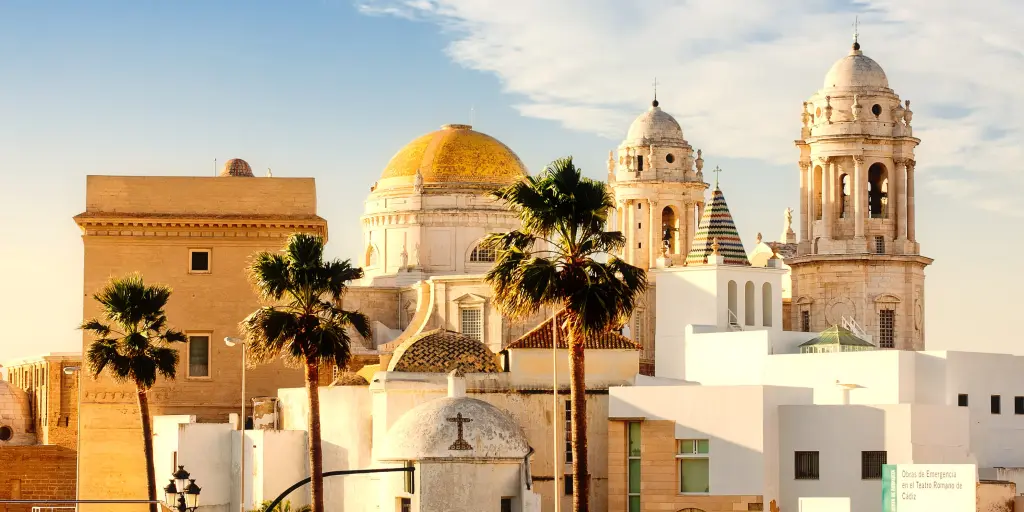
Drive to Seville in time for dinner
The final stint of day 11 of your Spain road trip is getting to Seville. This will take you just over an hour and you should comfortably arrive in time to unpack, find a place to park your car and scour the surroundings for a great restaurant.
We would highly recommend finding Calle Mesón del Moro for some of the best restaurants in town, although beware that some of these may be fully booked on Friday and Saturday nights.
Where to stay in Seville
Our pick for the very best place to stay in Seville is Posada del Lucero - an elegant 16th-century inn that's been refurbished with all the modern amenities you could possibly want.
This hotel is situated near all the best shopping streets, just north of the historic sights and right next door to Metropol Parasol - the iconic massive wooden structure that locals have nicknamed "the Mushrooms".
The stylish minimal exterior of the hotel contrasts with what you'll find inside: two beautiful courtyards flanked by marble columns and sleek arched doorways.
There's also an amazing roof terrace with a plunge pool and a bar where you can enjoy drinks with a view.
Navigating the streets of central Seville can be the toughest of this Spanish road trip The hotel doesn't have its own parking, but there is a decent public car park nearby just one block up the road so head there as you drive in.
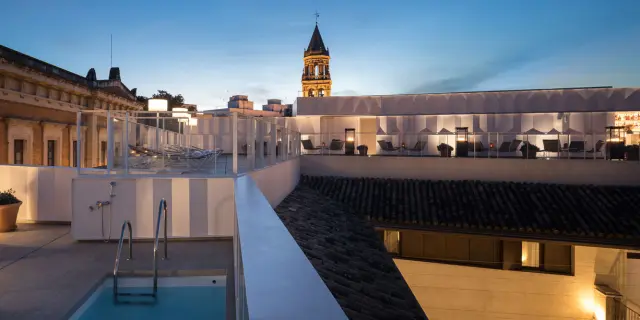
Day 12: Seville - Walking tour of all the best sights
First stop: plaza de españa.
The grand architecture and wide streets of Seville are more reminiscent of major European capitals than Andalucia, giving the city a distinct allure.
There is a lot to see around town, so get yourself out of bed at reasonable time and head down to Plaza de España. This vast open space was built in the 1920s in the middle of the Parque de María Luisa in time for the 1929 World Fair.
The large exposition building is now chiefly used for Governmental functions, but you can still go up the grand stairs for a better view.
The square itself is a semi-circle with fountains in the centre of a large paved area. Be sure to check out the perimeter of the Renaissance-style square, which is lined with Province Alcoves named after each of Spain's regions, complete with a mosaic depiction of each province.
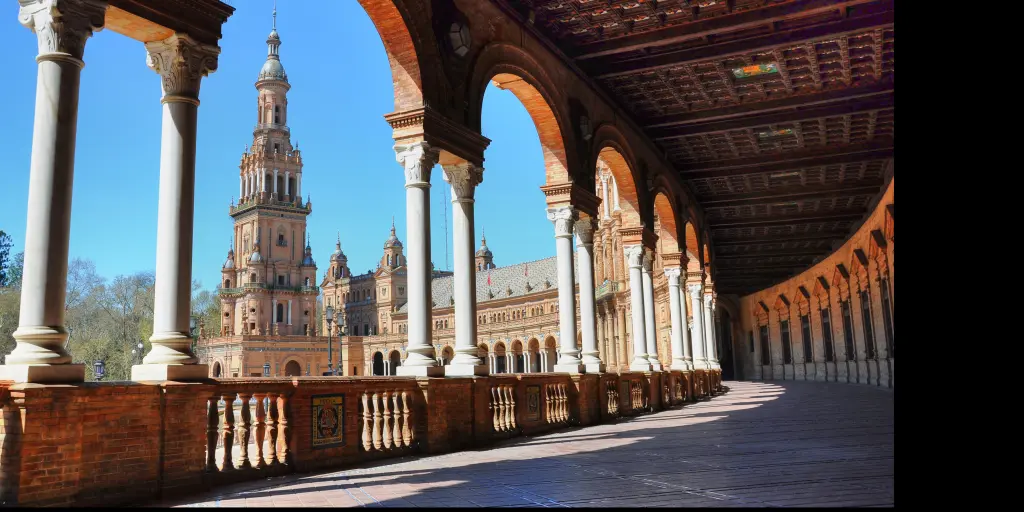
Visit Seville's Real Alcazar
The Alcazar is probably Seville's best-known attraction, famed for its unique fusion of Moorish and Christian architecture.
Originally built as a mudejar fort, it has been converted into a Royal Palace and comes complete with stunning internal courtyards, romantic baths and grandiose apartments.
Along with the Jardines Reales Alcazares gardens around the back, this palace is guaranteed to leave you speechless.
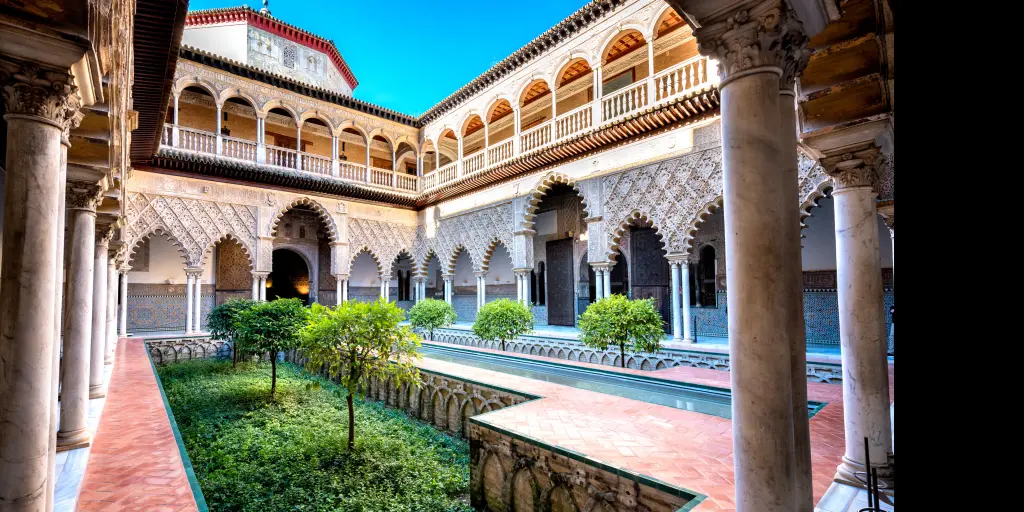
See the largest Gothic church in the world
Last but not least on your long excursion around the city is the Seville Cathedral.
As it's only a few yards away from the Alcazar, you might want to have a spot of lunch before going inside. We would recommend crossing to the other side of the Cathedral square and stocking up on traditional local black squid paella on Calle Argote de Molina.
The cathedral itself is a masterful example of Spanish Gothic architecture and is the third largest church building in the world.
The interior's opulence has traditionally been a symbol of the wealth and power of the Catholic church, so you simply must go in and take in the sight for yourself.
Note that much of the altar and surrounding parts were completely rebuilt at the turn of the 20th century after the main dome collapsed in the 1888 earthquake, but despite this, the Cathedral remains staggeringly beautiful.
Be sure to climb up the cathedral's famous main tower, the Giralda.
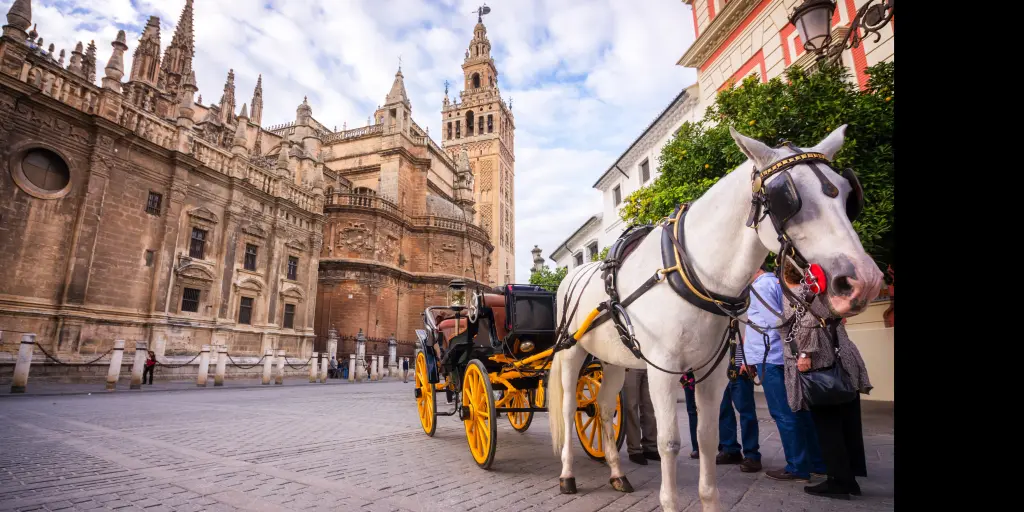
Day 13: Last full day of the Spain road trip - day trip to Cordoba
On we go with the last leg of our Spain road trip.
If you thought that Seville is hot during the summer months, wait until you get to Cordoba. The city boasts Europe's hottest summer climate, and you can expect to feel it hitting you square in the face as you get out of your air-conditioned car.
The city centre is fairly compact, so your best bet is to drive towards Avenida de la República Argentina/Paseo de la Victoria and park on the street.
Explore Cordoba's top attractions
The first stop on your Cordoba tour is the Cathedral of Cordoba - aka La Mezquita. This stunning piece of architecture is probably the most impressive sight on this road trip through Spain.
This unique cathedral in the centre of the city was built on the site of a grand Moorish mosque. When it was constructed, La Mezquita defied tradition, incorporating much of the Mosque's design into the Cathedral structure.
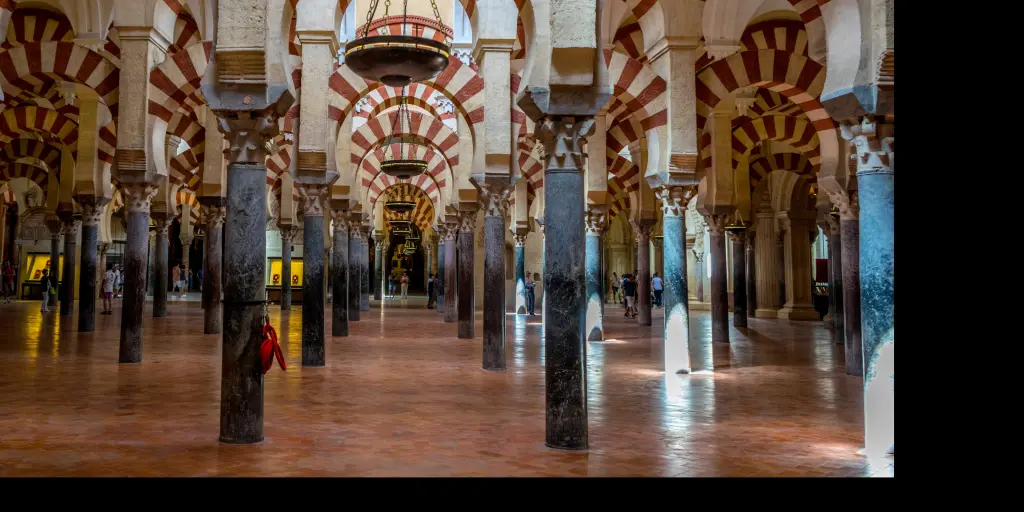
This melange of cultures reflects the history of Cordoba, which has been characterised by two religions living side by side for centuries.
The ancient city of Cordoba is surprisingly unlike any of the other major cities in Andalucia.
The ancient Moorish influences are considerably more evident here, the narrow streets, low-rise buildings and shops looking more like northern Africa than Spain.
Be sure to pass through the Jewish Quarter to see beautiful white-washed houses set out in an impossible maze.
Cordoba used to be Europe's biggest city in the early medieval period, and it was Spain's capital during the days of the Roman Empire.
This vast historical importance means there are dozens of sights and museums to visit all around town. Many of these focus on archaeology, although there are other culture-based ones such as the Casa de Sefarad in the Jewish Quarter, where you can learn about Cordoba's Jewish community throughout history.
How to spend your evening in Seville
At the end of your day out, hop back into the car and return to Seville for the last night of your road trip - Spain has been well and truly conquered.
If you feel like treating yourself, Seville has plenty of outstanding restaurants.
If you fancy some traditional local cuisine, look no further than the Eslava in San Lorenzo, which has the town's best choice of tapas. For something a little bit more exotic, try the Az-Zait - the food here is fantastic, but it is also one of the pricier options around.
Day 14: Seville - Eat a meal at the market & fly home
The last day of your stay is likely to be cut short by the need to get to the airport or get started on your drive back home.
Malaga airport offers the most flight options out of Andalucia so consider options from there. Madrid airport is over 5 hours away so it's not a great option.
If you've hired your car in Barcelona, all major car hire firms have depots right by the airport, so make your way straight there.
If you have a bit of time to kill before leaving, make sure you go and wander through Calle San Pablo and the surrounding streets for a bit of shopping and some great cafes.
For one last taste of authentic Spanish life, walk across the Puente de Isabel II bridge and head to the large market on the right. Here you'll find a great choice of cured meats and other traditional produce.
Pick up a couple of snacks and souvenirs to remind you of your lazy trip along Spain's Mediterranean coast!

Tips for your Spanish Road Trip
Almost all cities in Spain have a network of underground car parks right in the centre - don't be afraid to follow signs for the centre of the city and dip into one of the car parks to check out the sights.
The motorways and dual carriageways in Spain are some of the best in Europe - the surfaces are typically very good, traffic is generally sparse and you can literally pay to go faster (speed limits are higher on toll roads)!
To get all the details, read our Driving in Spain guide with a lot more about local rules, speed limits and general quirks.
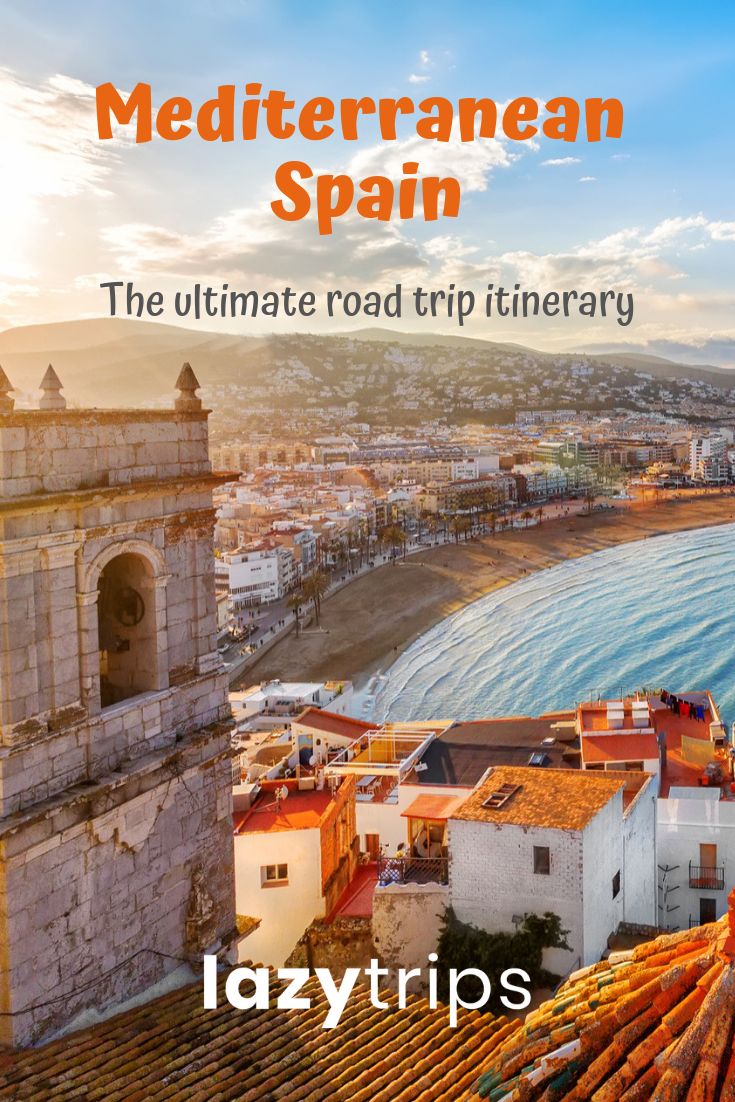
Join our email list!
By joining our email list, you give LazyTrips permission to use your email for sending you newsletters, emails and updates including for marketing purposes. Your email will not be provided to third parties.
Related posts

Already have an account? Log in

Road Trips in Spain: 18 Exciting Spanish Road Trips You Need to Take
If it’s not your first time here, you probably already know I have a minor Spain obsession. My Spain bucket list keeps growing and growing, and I’m not just looking for new city break destinations. I’m also in search of the best Spanish road trips and trust me when I say the list goes on and on.
I think my biggest dream would be to take a never-ending road trip in Spain so I could explore every inch of this incredible country.
Until that happens, I’ll have to take it one road trip at a time, so I’ve gathered some exciting routes with the help of a few fellow bloggers.
Prepare yourself for some serious travel inspiration and don’t make any decision about your driving holiday in Spain until you get to the end of this post.
* This post may contain affiliate links from which I earn a commission (for more info, read my disclosure ). As an Amazon Associate, I earn from qualifying purchases.
* I try to keep the information on this blog as updated as possible, but I still recommend consulting the latest prices, opening hours, and other details on the official website of each site, hotel, and tour, as well as checking the updated public transport routes and timetables.

Table of Contents
Best Spanish Road Trips in the Mainland
Costa brava.
By Naomi from Probe Around the Globe
Route: Circular road trip from Barcelona.
Escape Barcelona and go for a slower-paced life with one of the most scenic drives in Spain! A road trip around Spain’s Costa Brava region is perfect for discovering sandy beaches, a rugged coastline, great food, culture, and history!
A must-do on your Costa Brava road trip is going to Girona! The city became famous due to the Game of Thrones, but the medieval old town has a lot more to offer.
Stroll around, take in the cathedral and bridges and get a warm ice cream sandwich at one of the best ice cream places in Spain!
On your second day, you can drive out to the peninsula. On twisting roads, you’ll finally reach Cadaques, a dreamy fisherman’s village with lovely white houses, tiny eateries, and the water surrounding you.
Here you can visit Salvador Dali’s private home or go to the tip of the land at Cap de Creus. The views from here are stellar, and you’re at the most eastern tip of Spain.
Either spend the night at one of the seaside villages or head to Figueres. People flock here to visit the extraordinary Salvador Dali museum to understand how Dali changed the way we look at art today.
After two days, head back to Barcelona. On the way, you can visit the archaeological site with Greek and Roman ruins at Empuries or go up to Begur for sweeping views of the Costa Brava.
Finally, you follow the main road to come back to Barcelona. To read all the details about the Costa Brava road trip, go to Probe around the Globe .

The Region of la Rioja
By Pie y Pata
Route: From Logroño to Najera.
Known as one of the top wine regions in the world yet overlooked as a road trip destination, La Rioja is definitely worth exploring by car, driving through its scenic vineyards and enchanting small towns.
Start your La Rioja road trip in Logroño, the region’s capital. This beautiful historical city is not only an important stop on the Camino de Santiago but also a foodie’s heaven.
Be sure to head to Laurel street, which is filled with dozens of bars that offer delicious local dishes like migas and champis.

Next, visit the Marqués de Riscal Wineries. Taking a tour here and tasting their wines are a must, but what makes this place so iconic is the unique architecture, which is the masterpiece of Frank Gehry, who also designed the Guggenheim Museum in Bilbao.
End your route in Elciego and Najera, two of the most charming towns in La Rioja. You can also visit other places in the region like Santo Domingo de la Calzada, Haro, Ezcaray and San Millán de la Cogolla, but if you do, add a day or two to your road trip.

By Anna from At Lifestyle Crossroads
Route: Circular from Almeria.
There are so many things to do in Almeria – the sunny Spanish Province full of rural sceneries, beautiful beaches, and dusty Western-like landscapes.
No wonder its wide and dry expanses have a long history with filmmakers, from Hollywood´s most iconic films like The Good, the Bad, and the Ugly or Indiana Jones, to the recent Game of Thrones shooting. It sounds like a perfect setting for a road trip, right?!
Your journey should start in the city of Almeria. Allow yourself at least a day to wander around the main sites: The Alcazaba, The Cathedral of Almeria, The English Cable, and Port Area and museums.

Afterward, venture out to the Cabo De Gata National Park in search of out-of-this-world landscapes. Your main stops here should be Monsul Beach, Vela Blanca Tower, Cabo de Gata Lighthouse, San Felipe Castle, and Viewpoint of La Amatista.
The next two possible stops here could be the ancient mines of Rodalquilar and Cortijo del Fraile. However, keep in mind that the road towards both is unpaved.
Thereafter, head to the small fishing villages of Las Negras and Agua Amarga and finish your drive through the Cabo de Gata National Park by visiting the famous Playa de Los Muertos Beach.
Now you can head to one of the prettiest white towns in Spain – Mojacar. Next, visit the famous Wild West Parks of Las Tabernas Desert on your way back to Almeria.
This Circular Almeria Route can be done in 4 days: 1 day for Almeria, 2 days for The Cabo de Gada National Park, a couple of hours in Mojacar, and 1 day for the Las Tabernas Theme parks. However, if you’re up to a more laid-back trip, you could perfectly stretch it for a week.

Medieval Villages of Catalunya
Route: Circular from Barcelona.
Days: 5-8.
The region of Catalunya boasts an impressive number of tiny yet extremely charming villages that will make you feel like you’ve stepped back in time, and the easiest way to visit them is by car.
After spending a few days in Barcelona, head to the village of Mura, and then continue to the historic town of Vic.
Admire Vic’s beautiful Plaza Mayor, see the Roman Temple of Vic and Sant Pere Cathedral, and wander through the city center’s enchanting streets.
Continue north to the magical village of Rupit, Castellfollit de la Roca, and the picture-perfect town of Besalu, which has a fascinating Jewish history.
Head northeast to Monells, Peratallada, Pals, and the coastal town of Calella de Palafrugell.
From there, you can go back straight to Barcelona, or add another day stopping at other coastal towns like Tossa de Mar and Lloret de Mar.
The Region of Navarre
By Erick & Kirsten from Travelaar
Route: From Pamplona to the Bardenas Reales.
Navarre is an autonomous region in the north of Spain, which has a unique landscape as it has mountains in the north and a semi-desert in the south.
That’s exactly why this is one of the most scenic driving routes in Spain, and the starting point of your road trip is Pamplona, Navarre’s capital.
Pamplona truly is a beautiful city with a compact city center and lots of history. Stay a day or two to explore the city. Read more about what to do in Pamplona .
In the north of Pamplona lies the Irati Forest. It has a high altitude because it’s situated at the foot of the Pyrenees, making it the second-largest pine forest in Europe after the Black Forest in Germany. Drive around for a few hours, or spend as much as you like if you enjoy biking or hiking.
Olite is the next stop. Once, this was the capital of the Navarre region. This small historical town is dominated by the Royal Palace of Olite, which is a medieval castle. Visit the castle and enjoy the view from one of its towers.
The highlight of this road trip is definitely the Bardenas Reales, which is a semi-desert. The landscape is phenomenal and truly unique.
Bardenas Reales’ most famous place is Castilla de Tierra, a huge sandstone tower. It’s about an hour’s drive to cross the desert from north to south.

Basque Country to Galicia
Route: From San Sebastian to A Coruña.
Days: 10-14.
Driving from the Basque Country to Galicia is ambitious. There are countless places to see on a northern Spain road trip and it’s all about prioritizing.
Start your journey with a day or two in San Sebastian, which many consider the food capital of the world. Beyond the pintxo bars and Michelin-starred restaurants that will win over any foodie, you’ll fall in love with its old town, famous La Concha beach, and viewpoints like Monte Igueldo.
On your way to the Cantabria region, stop at San Juan de Gaztelugatxe, a scenic islet on the Basque coast that was also a Game of Thrones filming location.
In Cantabria, you have to visit the medieval town of Santillana del Mar, the village of Comillas where you can find one of Gaudi’s crazy creations outside of Barcelona, and the inland beach Playa de Gulpiyuri.

Continue your journey to the region of Asturias. Between the lakes of Covadonga that make you feel like you’re in Switzerland and the colorful fishing village of Cudillero, this region knows how to deliver.
Making your way towards the end of the route, Galicia is a fantastic final stop. I particularly loved the charming fishing village of Combarro, but the highlight for me was visiting the Cies Islands, a true Spanish hidden gem .
This exotic paradise is only a 20-minute ferry ride away from Vigo, and the islands are the perfect spot to relax and soak up some sun or take a few extremely scenic hikes.
Read here about the stops you should add to your road trip across Spain’s northern regions .

Extremadura Region
Route: Circular from Caceres.
Days: 6-10.
Want to explore a region in Spain that is full of history but has yet to be discovered by international travelers? Go off the beaten path and take a road trip through Extremadura!
It starts in the medieval city of Caceres, the capital of the region and a true feast for the eyes. Its highlight is the UNESCO-listed old town, packed with beautiful streets and squares, landmarks, and museums.
From there, head north to the small village of Robeldillo de Gata, the unique abandoned walled town of Granadilla, and the archeological site of the Roman city of Cáparra.
Next, the village of Hervas with its well-preserved stunning Jewish quarter is a must-visit. Not too far, you’ll find the natural pools of Los Pilones, perfect for a little relaxation.
Continue to the stunning San Jerónimo de Yuste Monastery and the town of Villanueva de la Vera.
Before going back to Caceres, stop in Guadalupe to see the impressive Royal Monastery of Nuestra Señora de Guadalupe, and spend some time in the historic town of Trujillo.
If you can add a few more days, head to the southern part of the region and visit places like Merida (and its astounding Roman Theatre), Badajoz, Zafra, and Jerez de los Caballeros.
Route: Circular from Malaga or Granada, depending on your flight.
Days: 7 (but could be extended).
It doesn’t get more classic than a road trip through southern Spain . It is the land of olive oil, sherry wine, and flamenco, and it has such a unique culture and history. It’s also the region with the most UNESCO World Heritage Sites in Spain.
Your first stop should be Granada. Spend two days exploring its beautiful streets and landmarks, and of course, the iconic Alhambra.
This complex of palaces and gardens is one of the most visited sites in Spain, with its fascinating history, intricate architectural details, and mesmerizing views over the city.

Head to Cordoba for one day of colorful patios and charming alleys, and learn about the history of Jews, Christians, and Muslims in this city.
Continue your journey with 2- 3 days in Seville , a city full of UNESCO Sites, beautiful squares and streets, tapas bars, and authentic flamenco shows.
Your next stop has to be Cadiz . It is the oldest city in Europe and a gem often overlooked by travelers. I could spend an entire month in Cadiz, and it’s all thanks to its cozy and inviting atmosphere.
Finish your southern Spain road trip route with a visit to the stunning town of Ronda and some relaxation time in the resort city of Marbella.
Read here the full and detailed Andalusia road trip itinerary (and check out a few places in southern Spain I wish I hadn’t missed ).

Castilla-la Mancha Region
Route: Across Castile-La Mancha province – from El Toboso to Argamansilla de Alba.
The province of Castile-La Mancha is one of the most authentic regions in Spain, as it is the famous homeland of the Spanish national hero and symbol Don Quixote.
Don Quixote is a novel by Miguel de Cervantes, one of the world’s best-selling books of all times and an emblematic prototype of a modern novel. Therefore, a book-themed road trip through Castile-La Mancha simply belongs on your list of best Spanish road trips.
All of the stops on this Don Quixote route are connected either to the author or to the characters of the book.
You could start your journey by exploring the small town of Toboso, then drive to one of the most famous Spanish landmarks – the windmills of Campo de Criptana.
Afterward, take your time to explore the local small towns of Alcazar de San Juan, Puerto Lapice, and Cuidad Real.
Make sure not to miss Villanueva de los Infantes, one of the prettiest villages in Spain and the local oasis of Lagunas de Ruidera Natural Park. Your road trip will end at another emblematic location of Argamansilla de Alba.
Not so many people know that the famous novel Don Quixote was written by Miguel de Cervantes during his imprisonment here, in Cueva Medrano.

The Region of Asturias
By Talek from Travels with Talek
Route: Circular from Oviedo.
This is a great circular road trip starting and ending in Oviedo , the capital of Asturias in northern Spain.
Spend two or three days visiting all the city has to offer, and then rent your car and head north to the port city of Gijon, with its Roman ruins and a surfeit of Michelin-rated restaurants. Have lunch at El Otro Mallu for a fantastic and reasonably priced, 3-course daily special of fresh seafood.
Sixty-two km east of Gijon is the picturesque seaside town of Lastres, one of many fishing villages that dot the Asturian coastline.
Another hour east of Lastres is Llanes, a charming coastal town surrounded by a remarkably well-preserved medieval wall. Within the walls is a small but lively town with great tapas bars, winding cobblestone streets, and brooding churches.
From Llanes, you can visit Cueva del Soplao, a 250-million-year-old cave with amazing rock formations, and the medieval village of Santillana del Mar which many consider the prettiest town in Spain.
Stop at Picos de Europa National Park, one of the oldest in Europe where you can hike the famed Cares River trail. Also in the park is the spectacular Sanctuary of Covadonga and the scenic Covadonga lakes.
On your way back to Oviedo, you can travel route N-634 through some of the most beautiful, lush, green mountains and valleys in all of Spain. This is a magical road trip that can be extended or reduced depending on your time.

Galicia’s Death Coast
By Inma from A World to Travel
Route: From Fisterra to Malpica.
Nobody agrees where the wonderful Costa da Morte (aka Death Coast) in Galicia begins and ends, so we will take the fishing town of Fisterra as the beginning of our route (where the pilgrims continue to walk after finishing the Camino and arrive at Santiago de Compostela) and Malpica as the end of the same.
Famous for being one of the westernmost points in all of Europe (considered the ‘end of the world’ when the existence of America was not yet known), Fisterra has a lighthouse from which to watch the sunset that attracts many on a daily basis.
Lires, Muxia, Camariñas, Camelle, Corme, and Malpica are other nearby towns that are also well worth a visit. Among them are lighthouses, capes, cliffs, and exceptional beaches that rarely fill up with people.
One of the reasons for this is because this is a raw coast, where storms enter strongly and wreak havoc like the dozens of sunken ships that lie at the bottom of the sea.
Do you already understand where the name of the Death Coast comes from? If you dare to explore it, spend at least three days there. I assure you that there are many things to do and see in Costa da Morte .

Andalusia to the Basque Country
By Joanna from The World in My Pocket
Route: From Malaga to San Sebastian.
I have driven on a regular basis from Malaga to San Sebastian, on my driving route from Spain to the UK .
This road trip is probably one of the easiest to make in Spain, with plenty of things to see along the way but also great condition roads and not much traffic.
Along the route, there are many beautiful cities where you can stop by and explore. My recommended stops are Granada, Toledo, Madrid, Vitoria Gasteiz, and San Sebastian. This would make a relaxed fantastic one-week road trip.
Granada is Andalusia’s gem, with its Moorish architecture and cultural influences and the mighty Alhambra waiting to be visited.
Toledo is an ancient museum city set on a hill, with narrow streets and three different cultures: Jewish, Moorish, and Christian. Madrid, the capital of Spain, is definitely worth a stop.
Vitoria Gasteiz, the capital of the Basque Country, is very different, with a medieval quarter and a Gothic-style cathedral. San Sebastian, the end of the road trip is an outstanding foodie destination with pristine sandy beaches and a lively atmosphere.
Extra tip: I personally prefer to stay in hotels outside the cities, located on the motorway because they are cheaper and offer free parking (as opposed to Spanish cities where you need to pay separately for parking that can easily cost as much as 20 extra Euros a day).

Madrid and the Region of Castilla Y Leon
By Corina from Another Milestone
Route: Circular from Madrid.
5 days, 4 Spanish cities, and a road trip you will remember forever! One of the best road trip routes in Spain is the one in the Castilla y Leon region, starting in Madrid and exploring the traces of kings and knights left along the way.
All your stops will be at UNESCO World Heritage Sites and that guarantees you an interesting experience.
After a day or two in Madrid , go to Avila, but before arriving there, you can spend a whole day in San Lorenzo de El Escorial. Here you can visit the royal monastery of San Lorenzo, the library, the two palaces, and the burial place of the kings of Spain.
Head to Avila, a fortified city with its medieval walls very well preserved. When you see it, you have the feeling you have traveled back in time. You can take a long walk on its walls, visit the cathedral, or get lost on the cobblestone streets inside the fortress.
Salamanca, your next stop, is famous for its university dating back to the 12th century, but once you get here as a tourist you will discover other beautiful attractions: The Cathedral or its old town with palaces and museums.
If you want to visit something different, try Casa Lis, the museum of Art Deco and Art Nouveau.
The last city you will enjoy is Segovia. A castle that inspired the Disney castle, a Roman aqueduct, and an impressive cathedral are just some of the reasons to stop here. If you have extra days to spend here, spice your road trip with some traditional villages.

Looking for more Madrid travel tips ? Here’s:
- Madrid packing list
- 4-day Madrid itinerary
- Hidden gems in Madrid
- Best areas to stay in Madrid
- Fun facts about Madrid
- Landmarks in Madrid
- Reasons to visit Madrid
- Brunch places in Madrid
- Free museums in Madrid
- Towns and cities to visit near Madrid
The Spanish Pyrenees
By Allan from It’s Sometimes Sunny in Bangor
Route: Biarritz (France) to Alquezar.
Days: 1-2 days.
This area of the Spanish Pyrenees is easily one of the least traveled routes in all of Spain, where the closest major city to our start in Biarritz would be Zaragoza which is 400 km south.
However, we chose a more scenic route through the Spanish Pyrenees traveling east into the hills of Huesca Province and to the lesser-known medieval village of Alquezar , which is one of the most secluded and picturesque destinations we have come across in Spain.
The roads are less traveled and almost empty for miles, yet they are also new and pristine as they wind between arid mountain karsts and blue lagoons, and at times, it is hard to believe you are in Europe.
Certainly, having just crossed the borders from Biarritz (France), the surroundings are more desert-like and arid, yet there is still snow on the caps of the further ranges of the Pyrenees mountains.
There is just so little traffic anywhere that it’s no problem to just pull up to the side of the roads to admire the surrounding views.
Along the way, settlements are few and scattered, and we stopped occasionally at abandoned villages like Escó, which had been left behind for further cities.
Otherwise, the first real sign of urban life would be in Pamplona, the small city famed for the running for the bulls, which makes for an ideal stopover along the way.

A Mini Road Trip Through Andalusia
By Priya from Outside Suburbia
Route: From Seville to Granada.
Days: One day, but you can overnight in one or more of the villages.
If you are visiting Andalusia, Southern Spain, you must plan a visit to the white villages. We went on a road trip from Seville to Granada and stopped at a couple of villages on the way.
The white villages , with whitewashed walls, red-tiled roofs, ornate churches on top of cliffs, and cobblestone streets are charming. Some of these villages date back to the Romans and Moors and are rich in history.
There are several little towns to stop and explore. The small town of Grazalema is where we stopped for lunch.
It’s located in a natural park with a variety of flora and fauna that varies from Spanish fir, maple woods, cork to deer, and Iberian wild goats. It’s known for its great hiking routes and outdoor activity options that are popular with climbers and hikers.
You can spend a night here or drive to Ronda and stay there. We were short on time, so we drove to Granada and reached in the evening right on time to catch the sunset over the Alhambra.
Read more about Spain:
- 55 things to know before visiting Spain
- Novels set in Spain
- 50 Spain travel quotes
- Travel quotes in Spanish
- Gifts for Spain lovers
- Long weekend breaks in Spain
Best Road Trips in Spain’s Islands
By Linn from Brainy Backpackers
Route: Circular from Palma de Mallorca.
One of the best road trips in Spain is definitely the Tramuntana mountain range on the beautiful Mediterranean island of Mallorca. To get the most out of it you should spend at least two or three days.
The UNESCO World Heritage site of Tramuntana has mesmerizing views of steep cliffs meeting the blue sea beneath. The whole mountain range is dotted with incredibly charming villages.
Start your road trip in Mallorca by driving from Palma de Mallorca to Cap de Formentor’s viewpoint where you get some of the best cliff views of the island.
Just across the parking lot, you can drive up a smaller road until you don’t get any further. These views are incredibly mesmerizing and not everyone knows about the place.
Further, you can drive to Pollensa, a small medieval town that is truly beautiful. The main attraction is to walk the 365 steps to Calvary Hill. The town is good to have some lunch in one of the many bars.
The next stop should be Lluc, which is a sacred center for pilgrims and is home to an incredible monastery. After a stop here, continue to Fornalutx and go back in history among old buildings with incredible views.
I suggest you stay the night in Soller where you find restaurants and a few hotels to choose from. The next day you can have breakfast and explore the town before taking the old-fashioned tram to Port de Soller and back.
On the way back to Palma de Mallorca you should not miss Deia and Valldemossa, two picturesque villages sitting on implausible viewpoints towards the sea.

More on Mallorca:
- One-week Mallorca itinerary
- Free things to do in Palma de Mallorca
- Breakfast and brunch spots in Palma de Mallorca
- Hidden gems in Mallorca
- Is Mallorca worth visiting
- Mallorca packing list
Fuerteventura
By Gabor and Rachele from Surfing the Planet
Route : Circular around the island.
Days: A minimum of 4 days.
Fuerteventura is one of the main islands of the archipelago of the Canary Islands. It’s considered as one of the islands of Spain with the greatest number of paradise beaches.
Nevertheless, if you plan a road trip around the island, there are many more things to do in Fuerteventura than just relaxing on the picture-perfect beaches.
Whether you arrive by plane or by boat, you can divide the island into 4 sectors, and we recommend you dedicate at least one day to each of them.
You can start with the beaches of the Jandía Peninsula, where you can find some of the longest beaches surrounded by pristine landscapes. We especially recommend you to take the dirt road to the beautiful Cofete Beach.
You should dedicate at least one day to the interior of the island, where you will find charming villages like Betancuria, lonely windmills, and fascinating viewpoints between the mountains. This is also the best area to try local food.
You must also spend at least a couple of days in the northern part of the island. On the Northwest side, there’s the area of El Cotillo with Caribbean-style white sand beaches in beautiful coves and also some of the greatest beaches for surfers.
The Northeast side of the island is famous for the large dunes of El Corralejo that tower near the golden sand beaches.

By Teresa from Brogan Abroad
Route: From Costa Adeje to Santa Cruz de Tenerife.
From relaxing beach resorts to unique mountain villages and spectacular volcanic landscapes, Tenerife offers something for everyone. To make the most of it, a road trip around Tenerife is the best way to explore the ‘Island of Eternal Spring.’
Start in Costa Adeje, in the southwest of the island. Spend your first day driving north along a rugged coast that hides countless coves and beaches. Finish in Puerto de Santiago, with its jet-black sandy beach and right next to the dramatic Los Gigantes cliffs.
On day two, head to the Teide National Park, where you can climb (or take the cable car) to the top of the volcano, and hike around otherworldly landscapes.
The following day, drive up to the northwesternmost spot on the island, Punta de Teno, with its beautiful red and white lighthouse. Make sure you stop in Masca, a little hamlet perched on top of a rocky outcrop surrounded by rugged cliffs.
On day four, visit Garachico, a picturesque town with volcanic natural pools, and Icod de los Vinos, a traditional town known for its food and wine, and the Millenary Dragon Tree.
On your final day, as you drive along the north coast, make sure you stop in Puerto de la Cruz, La Orotava, and finally Santa Cruz de Tenerife, the capital of the island .
You can visit Tenerife with kids , as a couple, and even with a group of friends.

Looking for more European road trips? Read:
- A One-week northern Italy road trip
- Northwest Italy road trip itinerary
- Best road trips in Italy
- Road trips from Milan
- The best road trip from Lisbon to Porto
- Best road trips in Portugal
- The best road trip through Northern Portugal
Did you like these Spain road trip ideas? Pin this post for later!
About Or Amir
Hey, I'm Or! I'm a passionate traveler with a severe coffee, chocolate, and pastry addiction (or any other carb for that matter). I'm always planning my next trip to Spain, Italy, or any other country in Europe, and my goal is to help you make the most of each destination.
4 thoughts on “Road Trips in Spain: 18 Exciting Spanish Road Trips You Need to Take”
we are traveling for 4 weeks beginning in Madrid ‘spiralling’ down and up through Portugal to Santiago de Compostela, across the top and down through Barcelona ending in Seville. ant tips or recommendation appreciated
What kind of recommendations are you looking for? 4 weeks is not a lot of time for this route, so I’d say – don’t try to squeeze too many places into your itinerary.
All on this page is great!! I’m interested in a 3 week driving trip but not sure where to start, Interested in: Festivals Music Dance also any information about renting a SUV rates insurance Best weather No rain and not to hot
Hey Rudy! When are you planning to have your trip? Also, I don’t have any experience renting an SUV in Spain.
*Your emil address will not be published. By using this form you agree with the storage and handling of your data by this website
Leave a Comment Cancel reply
Save my name, email, and website in this browser for the next time I comment.
Hi, I'm Or!
I'm a passionate traveler obsessed with traveling in Europe and discovering hidden gems in each place I visit. For me, it's not about ticking destinations off the bucket list but experiencing each one of them to the fullest. Read more about me and my story.


- Spain by region
- Spain Bucket List
- Life in Spain
- Undiscovered Spain
- Spain for Foodies
- Spanish Gifts
- Spain with Kids
- Nature & Hiking
- By Destination
- My Travel Tips
- Books&Movies
- Romantic Travel
- Expat Stories
- Terms & Privacy
Select Page
The Spanish Pyrenees Road Trip: My Ultimate 4-Day Itinerary
Posted by Anna | Nov 7, 2022 | Aragon , My Favorite Trips , Nature in Spain , Pyrenees , Top Posts | 7

Sharing is caring!
The Spanish Pyrenees road trip is still on the list of my favorite Spanish adventures ever . While this mountain region of Spain totally fits the bill for hikers, climbers, and ski lovers, most of the top local gems are easy to visit on a simple road trip, even if you are not a sports enthusiast. Let me share with you all the amazing places that made me fall in love with the Spanish Pyrenees!
- This post contains affiliate links from which I earn a commission (at no extra cost to you). For more info, please read my disclosure . As an Amazon Associate, I earn from qualifying purchases.
Table of Contents
The Spanish Pyrenees 4-day Road Trip Itinerary
Visiting the pyrenees of spain, my trips to the pyrenees.
Despite our recent Mediterranean cruise , a unique trip to the lesser-known Soria , and a sunny weekend getaway in Murcia the highlight of this summer for me was definitely our Spanish Pyrenees road trip.
Let me warn you that in this beautiful region of Spain, you will find everything from otherworldly landscapes , epic hikes , and magical forests , to charming villages , dreamy castles , and even top national landmarks of Spain.
Therefore, the Spanish Pyrenes is one of the unique regions of the Iberian Peninsula that might keep one gravitating back all the time.
Ever since my last trips to Huesca , Andorra , and Baqueira , I dreamed of another mountain getaway, eager to live new adventures. Quick spoiler – this trip has ended up on my list of 2022 favorite travel experiences in Spain , so you can imagine how much I have enjoyed this Spanish Pyrenees itinerary myself.

About this Pyrenees Itinerary
The Spanish Pyrenees extend for more than 400 km across the Spain-France border and include 3 Spanish regions: Aragon , Navarre , and Catalonia . As this Spanish Pyrenees road trip was not my first time in the region (plus we only had 4 days to make the most of it), I decided to build up the Itinerary within the Aragon region only. To read more about the Pyrenees of Catalonia, check this other travel story of mine .
The Spanish Pyrenees of Aragon are formed by 5 main valleys – Valle del Cinca , Valle del Chistau, Valle de Ordesa, Valle de Añisclo, Valle del Ara , and Valle de Tena . Therefore, keep in mind that even exploring each valley fully is impossible within 4 days.
Also read: The Coolest Hikes in Valencia, Spain
Nevertheless, if you have less than a week for your Spanish Pyrenees Road Trip it is absolutely enough to fall in love with the region and cross off your Spain bucket list a few adventurous experiences . You just need to pick the few places you would like to visit the most and build an itinerary around them.
To get a quick glimpse of my Spanish Pyrenees Road Trip – check Pyrenees Reel and Highlights on IG. If you have more days for this trip – feel free to steal my 10-Day Pyrenees Itinerary , 7-Day Pyrenees road trip from Barcelona , Aragon road trip itinerary , Weekend in the Pyrenees of Catalonia , and Northern Spain Road Trip Itinerary – all can be easily combined with any Pyrenees itinerary.
Also, you can read more about my hiking essentials in this post .
Favorite hotels to stay
During my first visit to the Pyrenees, we stayed at Barceló Monasterio de Boltaña . It´s one of the best hotels with SPA in the Pyrenees, with spacious rooms and quite decent prices (considering the quality of the services). While exploring the Pyrenees of Catalonia we stayed at the budget-friendly Apartamentos Chuandervera in the small town of Laspaules .
For this Pyrenees road trip we planned to do more hiking, so picked an apartment in Escalona (for some reason it´s not available on booking.com anymore).
You will find a few cute boutique hotels in Ainsa , one of the most beautiful medieval towns in Spain , like Alojamientos Ainsa Sanchez and Los Siete Reyes . I also love these hotels – Hotel Boutique Mediodía & Apartments , Casa Lascorz , and Casa de San Martín .
Books about the Pyrenees
If you are looking for more visual inspiration or historical/practical data on the Pyrenees region, there are a few books you might enjoy – Shorter Treks in the Pyrenees , Explore Pyrenees Like A Local or Walks and Climbs in the Pyrenees (focused on the French Pyrenees). Planning to read something about the Pyrenees on the road? – Check Footprints on the mountains , Boundaries , The Savage Frontier , Cruel Crossing , and If you only walk long enough .
Alternatively, you can pick something from the contemporary Spanish bestsellers or Wanderlust books .
If you know Spanish, check out: Pirineos. Mas allá de las montañas , Los Pirineos , Leyendas de brujas en el Pirineo fantástico , Pirineos: 50 joyas del arte románico , Pirineos : montaña sublime , 101 Lugares de los Pirineos sorprendentes .
Unique experiences to book in the Pyrenees
There are a few unique experience you can book in the Spanish Pyrenees in advance: Via Ferrata K3. Climbing Experience , Pyrenees Paragliding Experience , Ordesa National Park Guided Snowshoeing Tour , and Hot Air Balloon Ride and Breakfast over the Volcanoes of la Garrotxa .

Best places to visit on a Spanish Pyrenees road trip
Spanish pyrenees road trip – day 1.
For this trip, we rented an apartment in the small town of Escalona , which was close to all the places we planned to visit and had a good price/quality relationship.
Also read: 5 Epic Reasons to Visit the Spanish Pyrenees with Kids
As we were driving to the Spanish Pyrenees from Castellon – it took us around 4h 30 min to get to Escalona . Therefore, by leaving home early morning we literally had the whole afternoon to start exploring the mountains.
Cañon de Añisclo

After the check-in, our Spanish Pyrenees road trip started with a beautiful drive along the Añisclo Canyon to the parking Aparcamiento San Urbez . The local road HU-631 taking us there was so beautiful.
From Aparcamiento San Urbez you have a few hiking trail options. One of the easiest is Ruta por el Cañon de Añisclo , an easy 45-minute walk (2km) that made it to my lists of favorite hikes in Spain and Top Trails of The Pyrenees . During this route, even in the summer months, you’ll be hidden from the annoying heat by the spectacular local greenery. Along the way, you’ll encounter the remains of an ancient watermill Molino de Aso , a waterfall, the cave-church Ermita de San Urbez , and the Medieval bridge Puente Medieval de San Urbez .
Also read: The Most Epic Cliffs in Spain
Prepared hikers have a few alternatives to make this route longer by taking another trail near Ermita de San Urbez towards the village of Sercué , La Ripareta , and Fuen Blanca (you might have up to 5-6 hours of walking one way).
For dinner, we headed to one of the most beautiful Spanish Medieval towns – Ainsa. While we previously visited Ainsa on our last trip to Huesca , this charming hilltop village was so close to our apartment in Escalona that we couldn’t miss a chance to wander along its cobblestone streets once again. However this time I honestly felt like it became way more touristy. From local sights make sure not to miss La Plaza Mayor de Aínsa , Castillo de Aínsa , and Iglesia de Santa María .
For some gorgeous views head to Mirador Balcón de Aínsa and Mirador del Cinca . B y the way, only 18 km from Ainsa there’s another epic panorama at Castillo de Samitier .
Spanish Pyrenees road trip – Day 2

On our second day in the Spanish Pyrenees, we woke up early in the morning once again in order to drive to Canfranc and enjoy breakfast there. This small town is known for its iconic Canfranc Train Station (unfortunately it was closed due to the restoration works).
Also read: The Most Beautiful Gardens in Spain
The 241m-long Modernist building of Canfranc Train Station has 150 gates and nearly 350 windows. It was inaugurated by King Alfonso XIII in 1929. Back then it had a hotel, a casino, and a customs office all within one building. During World War II Canfranc Train Station was an important crossing point for the trade of gold and stolen artworks, as well as the Jewish refugees on the run.

After breakfast in Canfranc, we headed to the Astun Ski Station, where we took a lift upwards to enjoy the famous hiking trail Ruta de Los 7 Lagos de Astun (also called 7 Ibones de Astun or Ruta de lagos de Ayous ). Even for the kids, it honestly became one of the highlights of our Spanish Pyrenees road trip.
What can be more mesmerizing than the crystal-clear glacier lakes with snow caps on the backdrop and no soul around? This route is one of the most epic Spanish hiking trails I have experienced so far. It begins at the Astun Ski Station and covers the 7 glacier lakes located in both Spain and France.
Also read: 10 Epic Hikes in Castellon You Can´t Miss
Aside from the jaw-dropping views, 7 Ibones de Astun route makes you cross the Spain-France border a few times in one single day. While this trail is often described as a great match for all types of public, personally, I consider it a slightly challenging one. Keep in mind that you will be walking at an altitude of 2100 m, which means less oxygen. While the trail is only 13,55 km long, this hike is for those in a good shape.
Nevertheless, if hiking is not the option for you – consider simply taking the lift towards the first lake Ibon de Truchas , and walking around it. Also, you can easily reach the nearest lake Ibon de Escalar – till this point, the trail is very easy, but afterward, you´ll need to walk upwards to complete the trail of the 7 lakes of Astun.
Nevertheless, this stunning trail is still one of my favorite hikes in the Pyrenees .

In the afternoon/evening, we headed to Jaca. The initial plan was to visit the Museum of Military Miniatures in Ciudadela de Jaca . But they did not let us in 40 minutes before the closure: according to them, one needs at least 2 hours to see the museum. Actually, it´s not the first time I encounter this policy in Spain, but I still don’t get it. If I am willing to pay the entrance price and ready to leave before the closure, why is it their business how much time I spend inside?
Anyway, once in Jaca don’t miss Ciudadela de Jaca, San Pedro Cathedral , and San Miguel Bridge, all of which are worth visiting. Nearby the city of Jaca, you can visit Santa Cruz de la Seros (with its unique churches San Caprasio and Santa Maria ).

If you don´t plan to hike in Astun, keep in mind there are a few other interesting places nearby – the caves Cueva de las “Güixas” , Ecoparque El Juncaral , Fuerte de Rapitán . Another beautiful Pyrenees landmark to visit near Jaca is Real Monasterio de San Juan de la Peña , one of the most secret and beautiful monasteries in Spain .
Spanish Pyrenees road trip – Day 3
Ordesa y monte perdido national park.

On the 3rd day of our Spanish Pyrenees road trip, we planned a visit to one of the most beautiful national parks in Spain – Ordesa y Monte Perdido National Park. Its most iconic peak is called Monte Perdido (or “the lost mountain” in English). Also, it is the highest limestone massif in Europe.
Ordesa y Monte Perdido National Park is home to some of the most breathtaking landscapes and hikes of the Pyrenees – T ozal de Mallo, La Cascada del Estrecho, Gradas de Soaso, Bosque de las Hayas, Cañon de Añisclo, Cola de Caballo , and Gargantas de Escuain .
Access to the park is restricted. Visitors leave their vehicles at the free Parking of the small town of Torla and then take a bus to the National Park. The bus leaves from the Visitors Center of Torla-Ordesa.
Also read: The Prettiest Flower Fields in Spain
Actually, I found this system very convenient and environment-friendly. On the road, we saw a few small deer crossing the road a few times, which would have been impossible with over-tourism and private cars driving on the road 24/7.
While the most famous hike of Ordesa y Monte Perdido National Park is probably Ruta Cola de Caballo , we have picked the lesser-known option – Ruta Circo de Cotatuero . While it had some elevation, we did not encounter almost anyone on the trail.

In the evening we headed to the small town of Boltaña and made a quick stop at Broto to see the waterfall Cascada de Sorrosal. While on our last trip to Huesca, we lived in a hotel nearby, I didn’t mind visiting Boltaña again, as this small town is so charming and quiet. So, it is always a great stop to wander around and enjoy local traditional architecture and cuisine.
Spanish Pyrenees road trip – Day 4

First thing in the morning on day 4 of our Spanish Pyrenees road trip, we headed to Panticosa, located in a local valley Valle de Tena .
Valle de Tena is undeniably one of the most beautiful places in the Spanish Pyrenees. Hikers can not miss Ibón de Espelunciecha , Ibón de Piedrafita , Vuelta al pantano de Lanuza , Paseo del camino de las Palizas , and also the amazing zip line Tirolina Valle Tena .
This time we only visited Ibon de Los Baños (also called Lake of Panticosa) and a waterfall Cascadas del Argualas . Although a local Panticosa Spa with its baths could be traced back to the times of the Roman Empire in Spain, this place disappeared during medieval times. Nevertheless, in the 19th century, it was opened to the rich and famous as a luxurious villa able to host 1500 people. Many Spanish historic characters like Niceto Alcala Zamora, Santiago Ramon y Cajal, Primo de Rivera , and others, were once spotted in Panticosa.
Also read: 10 Photos to Inspire You to Visit The Canary Islands
While The Panticosa Spa is still open nowadays, its reviews suggest the place needs restoration, even though it definitely preserves the signs of its past glory.
At Ibon de los Baños or the Lake of Pantiosa, you will find hiking trails (most of which will take you to the nearest mountain peaks) and waterfalls like Salto del Pino , Argualas , Salto de El Fraile . The most beautiful views of the area could be seen from Mirador de La Reina .
Tirolina Valle de Tena

The last experience of our Spanish Pyrenees road trip was Tirolina Valle Tena . It is the longest double zip line in Europe and the views are simply to die for. On their website , you can see how different the landscape is as the seasons of the year change.
I loved the experience of Tirolina Valle de Ten a so much. While I initially expected it to be way scarier, the ride turned out to be so enjoyable. Hopefully, I will get a chance to repeat it at night or with the snowy landscape.
This experience is a must for the adventure-seekers in Spain .
Pyrenees Road Trip: My Map
On this map, you can see the exact locations of all the places I visited during this Spanish Pyrenees Road Trip. It will be helpful while deciding on where to stay.
Honestly, searching for a hotel in the Pyrenees area is a bit confusing: the region is so wide-spread that it takes forever to travel between the main landmarks. This is why it´s essential that you pick a holiday rental anywhere near the main stops of your Pyrenees road trip, otherwise you will end up driving too much.
Future Plans
There are still many places left on my Spanish Pyrenees bucket list, like Sos de Rey Catolico , Aguas Tuertas, Tella, Cueva de las Guixas , Mallos de Riglos hike , Congost de Mont-rebei , and a stay at Camping Valle de Bujaruelo – only to name a few. Therefore, you can absolutely expect new road trips to the Spanish Pyrenees anytime soon. Subscribe for blog updates not to miss out.
More Pyrenees Travel Tips
- Top Adventurous Things to Do in the Pyrenees ( read it )
- Beautiful Small Towns in the Spanish Pyrenees ( read it )
- Exploring The Pre-Pyrenees of Spain: A weekend in Sierra de Guara ( read it )
- Cogost de Montrebei: The Most Adventurous Hike in Spain ( read it)
- Epic 7 Days in the Pyrenees of Spain ( read it )
- 10-Day Pyrenees Itinerary: An Ultimate Road Trip from Madrid ( read it )
- Hiking Trails in The Pyrenees You Can Not Miss ( read it )
- Top Beautiful Places to Visit in the Spanish Pyrenees ( read it )
- Exploring the Pyrenees of Catalonia (read it)
- 5 Epic Reasons to Visit the Pyrenees with Kids ( read it )
- Top Romantic Things to do in Andorra ( read it )
- The Spanish Pyrenees Road Trip 4-Day Itinerary ( read it )
- Skiing in Spain: Our Baqueira Beret Family Getaway ( read it )
- Top Things to Do in Andorra ( read it )
- Best Foods in the Pyrenees of Spain ( read it )
- My Top Hiking Essentials On The Go ( read it )
- 3 days in the Pyrenees of Aragon with Seniors & Kids ( read it )

For more Spain travel tips check out my Pinterest board Spain Travel Collection and Flipboard Travel to Spain .

- Accommodation : For short stays, I usually book via Agoda , Booking , and Hotellook
- Tours&excursions : My favorites for guided tours are GetYourGuide , Viator , and Klook
- Museums&attractions: Get mobile tickets for attractions via Tiqets (use ATC5 code for a 5% discount via this link )
- Semi-private & private tours: LivTours is my favorite place for unique & crafted experiences in Europe
- For Foodies: Eatwith is a unique platform for finding culinary experiences with locals around the world
- Audio guides : Book audio excursions & tours in 35+ countries via WeGoTrip
- Flights : Find the best deals with Skyscanner , WayAway , and Kiwi
- Driving in a new country? – Check out Tripiamo guides (do not miss Tripiamo Driving in Spain Guide )
- Train&bus tickets : Currently, I book via Trainline , Busbud , and Omio
- Car rental: To find the best deals, I use Rental Cars and Discover Cars
- Top E-Sim: GigSky helps me to avoid roaming fees and provides connectivity everywhere (even on a cruise ship)
- Internet Security on the road : Connect safely to public Wi-Fi and bypass censorship with NordVPN
- Transfers: For individual transfer services, I like GetTransfer and Kiwitaxi
- Suitcases&Luggage : Discover where to store your luggage on the go with Radical Storage
- Travel Insurance : Find the best trip insurance plans via VisitorsCoverage and EKTA
- Compensation for delayed/canceled flights : Check out AirHelp and Compensair
- Renting Bikes: To find motorcycles, scooters, quads, and bicycles, I use BikesBooking
- Package Tours: Head to CheapOair and Expedia
- For Bloggers : To monetize my blog, I work with Travelpayouts and Stay22

About The Author
Traveling in Spain non-stop is my biggest obsession. Looking for Spanish hidden gems and local travel tips? - You are in the right place! Let me be your insider guide to Spain!
Related Posts

My magical weekend in Lucerne: First time in Switzerland
February 25, 2016

5 Stunning Places For Kayaking in Spain
March 28, 2024

Top Beautiful Places to Visit in the Spanish Pyrenees
November 24, 2023

Tarifa Beach Getaway: A Unique Place to Recharge
August 8, 2023
This looks like a beautiful part of Spain. I’m adding it to my list as I’m hoping to spend a month in Spain very soon. Is there snow around Christmas time? I’m coming from Australia.
I would love to do a road trip in this part of Spain! Definitely saving this for next year when we plan our trip.
I would love to replicate this four-day Spanish Pyrenees road trip! So beautiful! Definitely would love to explore the hiking trails.
I’ve wanted to visit this part of Spain for some time. I’ve pinned your useful blog for future reference!
Wow! Everything looks so beautiful. What a fun road trip. I would love to visit Cañon de Añisclo and Cascada de Sorrosal. Next time we are in Spain!
would you recomend this trip in a moterhome. would the roads be suitable for a 7.5 meter van
Hi, I have honestly never travelled across the Pyrenees in a van. Most of the places on this trip have an easy access and include large roads(except Añisclo) – so I assume that you could, you’ll need to research this via apps like Park4night and Caramaps
Leave a reply Cancel reply
Your email address will not be published. Required fields are marked *
Save my name, email, and website in this browser for the next time I comment.
Let´s Connect
Traveling in Spain non-stop is my biggest obsession. Looking for Spanish hidden gems and local travel tips? - You are in the right place! Let me be your insider guide to Spain! Read more...
Search my site
Recent comments.
- Jolanta | Casual Traveler September 6, 2024 on 5 Days in Lanzarote: Cool things to do in Lanzarote
- Rosemary Palmer September 6, 2024 on My Ultimate Guide to Surviving La Tomatina in Spain
- Cosette September 6, 2024 on My Ultimate Guide to Surviving La Tomatina in Spain
Search the Site

- Accommodation
The Ultimate Spain Road Trip Itinerary
A road trip in Spain – just the mere mention conjures up images of scrumptious tapas, ambrosial wine , affectionate and fun-loving people, pristine beaches, stunning landscapes, and architecture that spans pretty much all ages.
Today, we take you on a journey from Andalucía in the South of Spain all the way up to Figueres in the North-East with a suggested itinerary for a Spanish road trip that will let you savour the best of what Spain has to offer. Expect to see sights like this:

I would like to add that this was a “birthday trip” for Savi, so the idea was to hit as many carnivals and festivals in Spain as possible. Besides having tons of fun, this also made us see the real Spain and helped us understand local culture.
Spain Road Trip Itinerary
- Day 1: Fly from London to Malaga and pick up rental car
- Day 2 – 4: Malaga and some gems of Andalucia
- Day 5: Drive to Valencia via Granada
- Day 6 – 7: Explore Valencia and get bruised by tomatoes in Bunol and coloured by red wine in Valencia
- Day 8: Drive to Figueres
- Day 9 – 11: Explore Figueres and the surrounding areas
- Day 12: Fly back to London from Barcelona
Total distance : Approximately 2,000 Kms including the day-trips

Malaga and Costa Del Sol (4 days)
Malaga is a party-hub and a popular beach-side resort on the Southern coast of Spain. Popular with British tourists, it’s quite cheap to get to Malaga from London. To avoid the commotion, we opted to stay in an adjacent village called Benalmádena – great choice. The beach was quieter and nicer as compared to the one in Malaga and it was just a short drive from the centre of Malaga.
A major reason for us to fly into Malaga was to attend the annual carnival in Malaga, also known as Feria De Malaga. People take to the streets and the Feria grounds as early as 10 in the morning. There’s wine, there’s tapas, there’s dancing, and there’s a lot of happy people. We spent the entire day and the evening partying with the locals.
Read more about our exploits at the Feria De Malaga (opens in a new tab).
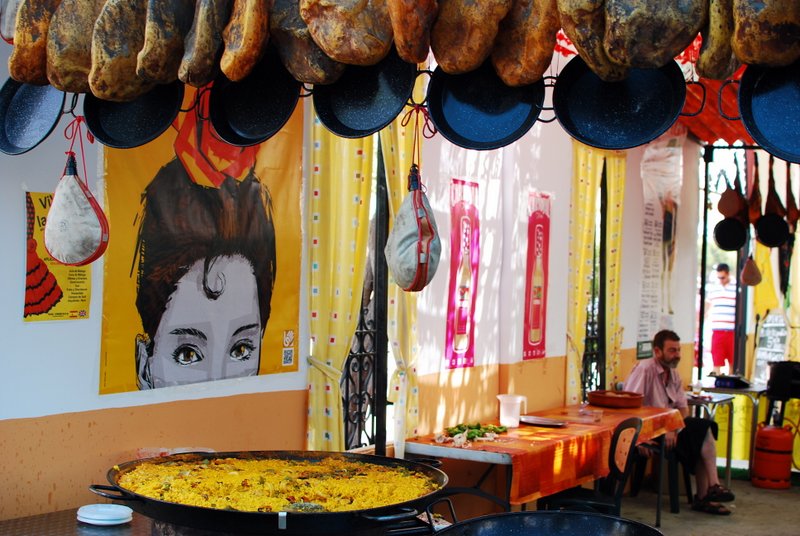
The following morning (what with the hangover!) we decided to enjoy a leisurely Spanish breakfast coupled with a strong cortado (espresso with little milk) and make friends with some locals. Morning well spent, we got into our car, put on our favourite road trip playlist over at Argus, and off we went to explore the surreal rock formations near the quaint village of Antequera. The layered rocks are a sight to behold and the neighbouring village of Antequera is right out of a Spanish fairy tale – cobbled streets, majestic churches, street side cafes, and a towering castle.
Read more about our adventures at the surreal rock formations in Antequera (opens in a new tab).

It’s not possible to visit South of Spain and not visit the mighty Alhambra. Make a day trip out of it, and instead of taking the highway, opt for what is now called the “old road to Granada”. The serpentine road will take you through vineyards, rustic houses, treacherous mountains, and our favourite, Rio Frio, a tiny hamlet which is known for Trout fishing. We’ll be writing a detailed post on this day trip soon, so watch this space.

Accommodation in Malaga
Like we mentioned before, we stayed in Benalmádena , a 20 minute drive from Malaga. The village and the beach were definitely quieter than Malaga, especially in the carnival season. You can compare and book a hotel here .
Valencia and Bunol (3 days)
Valencia is a bustling city and it’s easy to spend a couple of days just walking around countless Plazas (squares), sampling tapas in hidden tapas bars, and sipping on the local drink, Horchata, a traditional beverage made of ground almonds. The highlight of this segment of our road trip, however, was the day we spent in the tiny village of Bunol, made famous by the annual Tomato throwing festival, La Tomatina. Thousands of visitors descend upon this otherwise sleepy village to partake in the biggest food fight in the world. How could we have stayed behind? We can safely say we came out with a lot of bruises and an aversion to tomatoes, at least for the next couple of days. If you can, definitely plan your Spanish road trip so that you can enjoy the madness in Bunol. La Tomatina festival takes place on the last Wednesday of August each year.
If you do make it to Spain during the last week of August, don’t miss out on the wine fight that happens in Haro near Valencia . Participants pour wine all over each other using water pistols, glasses, and buckets at the La Batalla del Vino festival. Expect unending dancing and revelry.
Recommended Reading : Our experience at the Tomato throwing festival, La Tomatina (opens in a new tab).

Accommodation in Valencia / Bunol
We would recommend staying in Valencia instead of Bunol – Bunol is a tiny village and accommodation options are limited. Valencia has tons of places to suit all budgets and needs. You can compare all hotels and book here .
Figueres and Costa Brava (3 days)
Figueres is known for the The Dalí Theatre-Museum , which is the largest surrealistic object in the world and houses the largest collection of Dalí’s paintings and sculptures. It’s easy to spend an afternoon in the museum. Owing to the popularity of the town, accommodation is sometimes difficult to come by, so it’s best to set base in one of the neighbouring quaint villages like St. Miquel De Fluvia.
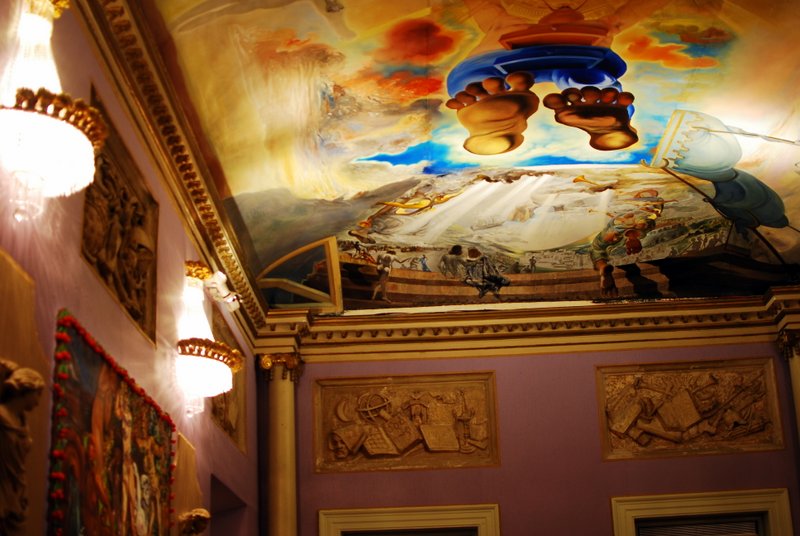
There is no dearth of picturesque towns in the Catalonian region, Cadaques being one of the most popular ones. For us, however, the medieval town of Besalu and the seaside town of Begur stole the limelight. This region boasts of some of the most spectacular drives and scenery in Spain, not to forget vast expanses of sunflower fields.

On the last day of our road trip, we spent the entire afternoon lazing on one of the hidden ‘Calas’ (coves) that are commonly found in Costa Brava. Looking back on the last 10 days, we realised that we had seen so much, met such amazing people, eaten some of the best tapas, and sampled lush wine. The following day we drove to Barcelona to catch our flight back to London.
Accommodation in Figueres / Cadaques
We stayed in a tiny village called St. Miquel De Fluvia. To be honest, you won’t go wrong if you choose any village/town to stay in this region. If you don’t mind the crowds, then definitely go for Cadaques . If you’d like to be in a quieter place, then look for a hotel or apartment near Figueres .
The next road trip to Spain, this time through central Spain, is currently being planned as we pen this post 🙂

- We opted for self-catering apartments in Malaga, Valencia, and Figueres. The cost was roughly £15 per person per night on an average. You can find more details in our Where To Stay In section .
- Car rental in Spain is cheaper than other European countries. We paid £15 per day for a 5-door economy car from Hertz. There was NO one-way drop-off fee when renting with Hertz.
- There are two kinds of highways in Spain – Autopistas and Autovias. The former are mostly toll roads, so if you want to save some money, use the Autovias which have a lower speed limit.
- All towns and cities are well connected by road and it’s easy to drive in Spain. As always, it’s handy to have a GPS during your road trip, especially if you like to take detours to discover hidden gems like we do.
- For your visit to The Alhambra, book in advance as the tickets run out fast. The combined ticket to Alhambra, Generalife, and the Nasrid Palaces costs around 14.50 Euros per person. Keep in mind that you have to choose the time of your visit to the Nasrid Palaces when booking the ticket, so plan your day-trip accordingly.
- Entrance to The Dalí Theatre-Museum is 12 Euros per person, but in summer, there is an option of a night time visit, which comes highly recommended from us. Tickets for the night time visit cost 13 Euros per person. It’s strongly advised to book in advance.
We have been to Barcelona and Madrid on city-breaks in the past, so we wanted to do a road trip that would take us to some offbeat places in Spain, and this particular itinerary did not disappoint. From grand palaces to barren deserts, from windy beaches to the snow-capped mountains of Sierra Nevada, we saw it all.
If you are planning a road trip in Spain, you can read all our posts about Spain here (opens in a new tab).
If you love driving as much as we do, you should definitely check out our epic Iceland road trip (opens in a new tab). We can guarantee you that you will be tempted to pack your bags and leave for Iceland 🙂
Drop us a line if you have questions about planning and places to visit – we’d love to help. If you have done a road trip in Spain already, share your tips with us in the comments below 🙂

Previous Post
Offbeat London – Alternative Things To Do In London

Visiting Saigon’s China Town – Travel Fashion in Vietnam
151 thoughts on “ the ultimate spain road trip itinerary ”.
I haven’t done a road trip in Spain, but watching “Spain: On the Road Again” has made me long to go on one to last for weeks, driving, photographing, eating (rinse & repeat). Fantastic! I’ll have to keep your post in mind!
Wouldn’t that be amazing ? We would love to spend 3-4 weeks (or more) driving through Spain. We absolutely love Spain !
Hi is Spain a good idea in January around 19-26th jan.. I’m planning to travel for my anniversary
Yes. Spain will be nice in January too, albeit a bit cold.
Spain Spain Spain !!! I so badly want to be a part of the Tomatina festival some day 🙁 🙁
You should go in 2014 – you’ll love La Tomatina. Maybe you can do a similar road trip to what we did 😉
Planning a similar list part of our bucket list.A bit older but looking forward to the adventure
Tell us how it went 🙂
Great job guys! I’ve been longing for Spain for a few years now and have it on my list for the next few years. Will definitely keep this in itinerary somewhere safe for future. Can I ask, how did you find driving in Spain vs driving in the UK?
If you haven’t driven in Europe before, then you might find driving on the other side a bit tricky to begin with. But you soon get used to it. Driving in Spain was fine as long as you stay out of busy cities. Spanish countryside is very beautiful 🙂
Well done! I will add this into our “to-do” list. Looking at all these road trip posts, I am desperate for one. Have you guys ever done a road trip through French alps?
Hey Snigdha,
We love driving wherever we go – we have driven in the South of France in the French Riviera but didn’t go further north. That post will be up on the site soon )
Yes, this is on my to-do list so badly! Great idea for a road trip, thanks 🙂 I’ll be looking to do something like this in the next year or so.
We are sure you’ll have an amazing time in Spain. Everything about the country is gorgeous.
Ooh, fun! Where are you planning to go for your central Spain road trip? I lived for three months in Merida, the capital of Extremadura, a town full of Roman ruins which receives so few tourists it’s almost like you have them all to yourself most of the time. And I had no idea car rental was so cheap there…if only I could remember how to drive!
Car rental was in fact super cheap. So much so that we had to check twice that the rental agency hadn’t made a mistake 😉 We’ll go to Madrid, Salamanco and Toledo. Merida sounds amazing – we’ll definitely factor that in. Cheers for the tip !
In 2008, I met my then 21 year old son at the Madrid Airport. We rented a car and did a 4 night trip that was a loop with stay-overs in Segovia, Salamanca and Toledo (with a day stop in Avila). Between Avila and Toledo, we drove through the Gredos Mountains. This was a reasonable itinerary for the amount of time we had. My son did the driving. I thought it was because he liked to drive. I only learned later that the only thing he hates worse than driving is the thought of me driving.
That is quite a funny story. I’m sure you guys have a good laugh about it now. The places that you visited sound so amazing – we will be covering those on our next road trip in Spain 🙂
Gadhe !Awesome website! Just started going through it to plan my trip to Spain in end-of-June/first-week-of-July for work+leisure.. Too bad I will miss both the bull run and tomatina, but can’t change my travel dates.. 🙁 Expect a lot of queries from my end! :))
Thanks a lot 🙂 Of course – let us know what all questions you have and we’ll help you plan an amazing itinerary for Spain 🙂
and this post goes in my Life’s top 10-to-do list !!!
Priyadarshini that’s a good choice for a top-10 list. It was definitely one of the best road trips we have done.
What’s so great about Spain is that you never run out of things to do. Most of the great stuff is hidden in the small towns anyway! My favorite villages are Mondoñedo (Lugo), Cangas de Onís (Asturias), Garganta la Olla (Cáceres) and my boyfriend’s hometown, San Nicolás del Puerto. Pueblos have the cheapest food, the best fiestas, and the cutest grandpas!
All the villages you mention sound amazing. For our next road trip through Spain, perhaps 😉 I completely agree about the cutest Grandpas 🙂
We love Malaga too – The Carnival of Malaga should not be confused with the Feria which you went to in August. Carnival is in February – Both are great parties!!!
Thanks guys ! Your tips came in very handy. Yes, we are also planning a trip to Malaga during the Carnival in February:) Absolutely loved Malaga and the Feria
I love Spain!! You guys should definitely try going to Seville and Ronda sometime. They’re both beautiful and for Ronda, you can even do just a day trip. We drove from Granada to Seville and took a 4 hour break in Ronda.
We have been to Seville – way back in 2009. We were completely bowled over by the city. It’s one of our favourite places in Spain. We really wanted to visit Ronda on this trip, but since we had to go up north and attend the La Tomatina Festival in Bunol, we had to give Ronda a miss this time. Will definitely go there next time. Thanks for the heads-up 🙂
savi and vid awesome job. Spain has been on my mind for a long long time and this is how we’d exactly want to do it. I am going to keep this bookmarked for future use 🙂 Love the name, the content everything about this site. Thumbs up from me !!
Thanks Sneha 🙂
We loved this road trip through Spain and are planning another one for next year 🙂
Hi guys, great post! I did a 6 day road trip a few years back starting in Malaga and going to Ronda, Marbella, Casares, Granada, Gibraltar, Las Alpujarras and Nerja. I loved Analucia – definitely my favourite part of Spain. The moorish history, mountain towns, hiking and white washed buildings were incredible. Looking forward to reading about your next trip!
Your trip sounds amazing Katie. We love Spain 🙂
the name says it all . Spain seems to be definitely ultimate.. !!! everything from tomato fight to scenic beaches .. all looks amazing !!! 🙂
What a great itinerary, and beautiful pictures! Was the first European country I visited, so it has a special place in my heart. I only went to Valencia and Madrid, but I’ve been dying to go back ever since. Hopefully one day I’ll be able to do a trip as cool as this!
Hannah Spain is one of our favourite countries. We’ve taken a number of trips in Spain, but this road trip itinerary ranks right up there as our favourite one 🙂
What was the total cost incurred during the road trip? Was communication ever a problem?
Hey Anmol, the cost of a road trip in Spain depends on the place you’re flying from and the accommodation you choose. Just drop us an email with the details and we’ll get back with an estimate of costs 🙂 Communication isn’t a problem. One can get away with English in most places
An indepth exploration of Spain (beyond Barcelona, which we’ve visited) is high on our travel wishlist. The Alhambra and Grenada (and Seville and Madrid) is calling to us! But we’d prefer not to deal with the stress of driving. Hopefully Spain has a good train system like the rest of Europe?
Spain does have a decent rail system but it’s possible to explore a lot more with a rental car. The Alhambra and Granada are gorgeous – you must explore them soon 🙂
I haven’t done a road trip in Spain (yet), and after reading this post, it’s now on my bucketlist!
Spain is one of our favourite countries for a road trip Valerie – one is almost guaranteed perfect weather, scrumptious food, and picture perfect villages in every corner of Spain 🙂
I was planning a 10 days trip to spain with friends.We have for 5 places in mind.Barcelona,madrid,valencia,ibiza and formentera.Could you please suggest best road trip possible from these 5 places.I was thinking of barcelona to madrid..
We’d suggest driving from Barcelona to Malaga (along the coast, via Valencia) and then flying to Ibiza. To be honest, 10 days might not be enough to enjoy all these things, but if you must, drive from Barcelona to Malaga over 6 days and spend 4 days in Ibiza and Formentera.
This looks like a perfect itinerary for a road trip!! I will be going to Spain in Winter with my family and I think theres a high probability of us using your suggested itinerary. Too cool to be missed! 🙂 Thank you for this!
Nurin a couple of our readers have followed the exact same itinerary and they loved it. We hope you have a great time too 🙂
Great post! I’m planning to do a coastal road trip similar to yours but in the last week of dec and into January. Have you been to Spain during those times? I heard the winter on the Mediterranean side is quite mild. Any advice would be appreciated. Thanks! Ps did you pass by any vine regions on this road trip?
Thanks ! Glad you like it. You’ll have a great time in Spain. We have never driven there in December, but I’m certain that as long as you don’t go up the Sierra Nevada, you should be fine. Winter will be mild (around 15 degrees Celsius). We once went to Seville (south of Spain) in December and it was amazing. As for vine regions, we did see some near Almunecar – initially we had planned to visit Bodega of Horacio Calvente (very close to Almunecar) but thanks to my constant stops for taking pictures, we had to skip the detour to the vineyard since we had to drive a long way to Valencia that day.
Have a great trip and let me know if you have any other questions 🙂
Hey guys – Enjoyed reading your travelogue. One question though – Do you guys have an international driving license or will the Indian driving license work for car rentals in Spain? I am planning to follow the same itinerary in Q1-2015 🙂 Cheers!
Hey Akash – the Indian driving licence works well 🙂 Have fun in Spain
I recently discovered your blog and I am honestly addicted to it! I love travelling so much… I just wanted to ask you, I am planning a holiday to Spain as I have never been, which one city would you recommend? I love your pictures with the sun flowers and beautiful postcard beaches, but ideally would like to go somewhere with a lot to do (kid friendly things) as I will be going with my family and we all like different things. Your response will be much appreciated! 🙂
Hey Shazia – we’re sorry for the late response. If it’s your first time in Spain, then Barcelona is a great city to begin with. The city itself offers lots of kid-friendly activities and the sun-flower fields that you love are just an hour’s drive away 🙂
Hi guys, I’m from India and live in Delhi. My wife and I are planning a short road trip in spain around end May 2015. I would really appreciate it if you could share your email or telephone number with meso that I could connect with more details. My email is [email protected] thanks guys
Hey Sanjeev – drop us an email using the ‘Contact Us’ button you see on the top right 🙂
Hey Guys, great job on the blog!
Me and my future wife are gonna be travelling to spain for my honeymoon. Were renting a car and wanting to hit all the hot spots and gems in southern spain. Any ideas on where we should be going? We originally planned on flying into Barcelona and driving south but Im thinking we should be flying into Malaga first. Is there a language barrier in the large/small towns. My fiancée has celiac disease (gluten-free), do you think it will be difficult for us/her at restaurants. If so what option/route should we go? Thanks Tony
Hey Tony – English is widely spoken (and understood) in Malaga. Communicating gets a bit harder as you go deeper into the countryside, but it’s nothing a few fervent hand gestures can’t solve 🙂 There are a few speciality restaurants in bigger cities but it might be hard for your fiancée to find food in restaurants in smaller villages. But there are always supermarkets and there’s nowhere better than Spain for dozens of picnics in the countryside 🙂 Hope you have an amazing honeymoon
Hi guys, We did a Spain road trip as well.. And your blog really helped us. We wouldn’t have discovered cadaques without you guys! I am completely hooked to your posts !
Aww thanks Shilpa – so good to know! We hope you continue to enjoy our adventures around the world 🙂
Hey Savi Vid,
Am I glad that I found this post 🙂 we are three families with teenage children from India planning a road trip in Spain in the second half of June. We have 7 days with us and plan on doing Barcelona to Valencia to Madrid.
Can you recommend if hotels are a better option or apartments ? Also the area which is central and good to stay. Also the absolutely must visit places in these cities ? Will appreciate your inputs !
Hey Reena – I think apartments are always better when you’re travelling as a family 🙂 We booked some great ones through Air B&B and GoWithO. You can check out detailed reviews of all our accommodation in Spain in our ‘Accommodation’ section here: https://www.bruisedpassports.com/category/where-to-stay-in
I’m so glad to chance upon your site as your experience would hopefully help me with my itinerary. I am planning to rent a car in Madrid and drive up to Barcelona and then back, with a stopover at Zargoza.
Here’s the thing that makes me think twice about driving. Is it really that bad to drive in the city? Understand parking will be bad but i’m searching for apartments via airbnb that offers free parking space. Is it advisable to drive in the city to places of interest or should i just park my car and use their public transport? Hear from you soon!
In places like Barcelona and Madrid, it can be tricky to drive in the city, especially in office hours. Many of the places in Madrid and Barcelona are well connected by public transport so you should just use that when you can. For driving a bit out of town or for day trips, you can use the car 🙂
He, we are planning to visit Spain and start from Barcelona for about 10-12 days and mostly a road trip… What are ideal days to be at each location.. Cities which we want to cover are Barcelona, Valencia, Seville, Costa Brava, Madrid Ibiza and granada.. Please help
You shouldn’t try to visit all these places in one trip – Ibiza is an island so you will have to take flights to and from. We would recommend 2 days in Seville, 1 day in Granada, 3 days in Madrid, 2 days in Barcelona, 3 days in Costa brava. You can leave Valencia and Ibiza from this trip or it will become too hectic.
Hope this helps.
I’ve been planning to do a roadtrip like this one…seems amazing!! I have finally a starting point in Spain and you made it easy for me to want to go. I’m portuguese and I’m planning to start in Portugal and go to Spain through the South. Since I have time I want to continue and go through the north to Pamplona, San Sebastian Vigo and back to Portugal. Do you have any recommendations to these areas? Are you considering to do a roadtrip in Portugal? We have amazing places that you would enjoy also.
Hey Pedro – we loved driving around in Portugal but we’re yet to write about it (we visited Portugal before we had our blog, so it’s one of those stories that never got written!). Pamplona is a great area, less touristy and every bit as amazing as the rest of Spain. Try to rent a cottage/apartment in the countryside – it makes for a perfect base to explore the area
Savi & Vid – if you like the occasional nature tour, check out SpainBirds, they offer several different guided tours (in English) to national parks or wilderness areas in Spain to spot local birds and if you are lucky to see an Iberian lynx. They also go to Morocco…cool! A thought for your next trip to Spain. You can learn more about SpainBirds and other eco tour companies by country destination on my new directory website, EcoTourLinQ.com. also @EcoTourLinQ Cheers!
Hi Savi & Vid,
This road trip looks enchanting. I was planning to go to Spain with my family and 6 month old nephew. Since we have never been to Spain before, is it possible to add Madrid and Barcelona to this itentiary? Do recommend.
Madrid might be a bit out of the way (or not if you have 4-5 extra days) but Barcelona can definitely be added – it was on the way from Valencia to Figueres but we didn’t stop there this time as we have been there before 🙂
Hope you have a great trip.
Amazing.. I also read ur Iceland trip.. Thanks a ton.. Now.. I m planning Spain by road in September.. 15 days.. Starting around Sevilla.. Upto barcelona.. Ibiza for a couple of days.. Harley or car? What do u suggest Thanks again
Whatever floats your boat, Tarun 🙂 We really can’t comment on that – depends on your tastes and travel style. All we can say is that irrespective of what you choose, you will have a great time in Spain 🙂
Hi Savi and Vid,
Nice post there. I am visiting Barcelona for four days in the first week of September along with a friend. We have already booked a car (a convertible BMW, thanks to much cheaper rental prices than other countries!) and would like to do some rugged road trips instead of just spending time within the city. So we were planning to drive all the way down to Valencia with little stops here and there and then of course come back to Barcelona as we have our return flight from there. (I might get to meet a friend at Valencia, so can’t change the route)
So I have come across names like Sitges, Montserrat, Tarragona, Peñíscola, etc. What stops would you suggest me? We could do some onward and some on our return.
Any kind of suggestion for this driving route would be really helpful. Thanks buddy.
Warm regards, Lalit
We didn’t stop at many places in that stretch because we wanted to get to Figueres from Valencia. We had lunch at Peniscola and it was nice.
Have a great trip – with that car and the sea on one side, it can’t really go bad 😉
Hello, coming all the way from Australia and planning to travel around Spain and Portugal for about 18 days, starting probably in Madrid or Barcelona. Must see San Sebastian and would like to see the coast,places of beauty, not toooo touristy. What would you recommend? We are in our late 50’s, fit and healthy, can get around but don’t want to ride pushbikes! We would prefer to drive, stop, look around, have a bit of lunch, drive some more, look around some more, stop again, settle for a night or two in palace of interest and then go again. Many thanks, Sue
Perhaps you could start in Barcelona, spend a few days in the city, rent a car, drive to Cadaques or a neighbouring village, spend a couple of nights in Costa Brava. Then drive to Zaragoza or Girona depending on what you prefer and on towards San Sebastian. We haven’t explored the northern part of Spain so won’t be able to comment much.
We definitely recommend Costa Brava though 🙂 Some parts might be touristy, but some are absolutely amazing. We really enjoyed Besalu and Begur. Just rent a car and explore – you’ll definitely come across a hidden gem – Spain is full of those 🙂
Hope this helps. Have a great trip in Spain 🙂
hey guys…great post !!! I think you guys can help me out. Me and my wife are landing to Valencia in early feb. We have 3 days of work there. After that we want to extend our trip for another 6 days to other parts of spain. Now we should add Barcelona side to it or go for andalucia and Marbella/Malaga. We are more interested in spanish culture, food and wines. We will prefer a self driven car with scenic beauty and stopovers at beautiful villages. What do you suggest.
Hey Nitin – both areas have their pros and cons but you should choose Andalucia and Malaga if you enjoy scenic drives and culture 🙂 There are tons of incredible villages and gourmet tours along the way
Hi guys, Have just discovered your website whilst looking for a good guide book to Spain. My husband and I are planning a road trip through Spain, driving down from France and heading to the south of Spain as quickly as possible(although I am tempted to get some info on flights and hire cars after you saying how cheap that is) We spent 4 days in Seville just before Christmas and loved it, and we are particularly interested in places that have had major peninsular war connections. Any suggestions woud be gratefully received! Alison
How about driving down the eastern coast of Spain – Girona, Costa Brava, Valencia, Almeria, Granada, and Malaga. To really enjoy this stretch, you will have to dedicate close to 10 days or so 🙂
Hi! Can we drive around with an Indian license?
Hey Richa – yes you can drive in Spain with an Indian driving license 🙂
I dont think you can drive with an Indian Driving Licence. Right now I am in Spain only for holidays and have got my International Driving Permit. I came to this conclusion after too much of search and gather info from so many people. Some car companies like sixt dont care what licence you have but if you would caught by the cop then you will have to pay hefty fine. According to my information, only EU countries issued licences are valid to drive in Spain.
Hey Nitin, an International Driving Permit is nothing but your licence translated into English. Since all driving licenses in India are already in English, we don’t think it should pose a problem. However I’d like you specify that we’ve never been stopped by the cops, so we can’t base this on experience. It’s best to verify this with local authorities before renting a car 🙂
Hey Savi Sid
I have rented a car from Gold car and specifically asked if IDP is necessary. Their reply was that the car rentals just required the regular licence in English but if in case you get caught by the cops then you will be in trouble. So I would recommend to get IDP to avoid the problems and Richa getting IDP is not a big deal in India. I got it in one day only with the validity of one year. The one thing I found strange that the Gold car rental company asks for atleast one year driving experience. Otherwise they dont give you the car.
Where is the first picture taken? I am looking into a road-trip through the south of Spain and want to go to as many beach towns as possible.
Hey Lizzy – the first photo is from Cadaquez 🙂 Have fun in Spain
Need Help in building by itinerary for spain in may. its a 10 day trip..please help. i will land and depart from madrid
Hey Vineet – you’ll find all our favourites above. Just pick and choose the towns/cities you find interesting and cover those in the 10 days you have 🙂 Cheers
Hey guys !! We are planning for Road trip through Spain this July August. Will really appreciate the guidance for Route, Things not to be missed, must visits, and accommodations… Trip duration is no bar for us… We can spend put o 3 weeks !!
Hey Sriram – we’ve written everything about our favourite route, things not to be missed in Spain and the accommodation in our articles. Just go through them when you have a moment 🙂 Here’s the link: https://www.bruisedpassports.com/category/spain
Hi We are planning a road trip spain and love the idea of road trip . how did u guys get the driving permit for spain .we r from delhi and dont have international driving permit . Althou we did a road trip thru new zealand 4 years back but they accept indian driving licences. Please help.Plan to go in sept . Also did u do skydiving and scuba if so …please share ur experience
Hey Rashmi – we used an Indian Driving License in Spain. It worked ok 🙂 September is a great time to go to Spain. We didn’t go skydiving or scuba diving in Spain.
Thanks a ton …ur blog is super cool and inspiration for travel adventures . Mite keep bugging u guys till I go to Spain .but just wondering if Ibiza and Majorca will be worth a visit in sept. Also is staying in Marbella as a base in Malaga a better option.
Thanks Rashmi – hope you have an amazing time in Spain. Ibiza and Majorca are great during September – however do beware it is still tourist season, so they will be quite busy. As for the better base out of Malaga/Marbella, that depends purely on what you have planned for your time in Spain 🙂
Hey Savi, do u advise a road trip from Malaga to Barcelona with a one night stop ever in between , maybe at valencia
Hey Rahul – you could definitely do that but do beware that you’d be driving for the majority of the time. This itinerary won’t leave you with any time to explore the places along the way
Hi I just came across your link while trying to plan a road trip to Spain.may be you can suggest what is the best wat to plan it we are planning to leave from NJ to Barcelona on sept 1st & return on Sept 7th.we would like to see Barcelona,Valencia,Sevilles,Grenada not sure if we have enough time to do Madrid also. I am open to suggestions & alternate cities if it comes highly recommended. Thank You
Hey Poonam – think that’s a LOT to fit in a week. You’ll end up spending most of it in transit. We’d suggest sticking to Barcelona, Valencia, and Costa Brava (gorgeous beaches). If you want, you could add Zaragoza to your itinerary instead of Valencia. Hope this helps 🙂
Hiiii guys.. love love your blog. Thank you for all the information you provide, so helpful!! We are planning a trip to Spain in December and were planning to do Madrid – Seville – Granada – Valencia – Barcelona. We were thinking of driving from Seville – Granada – Valencia. Would you recommend the drive? Is it beautiful or should we rather take the AVE?
Thank you in Advance! Manika
Hey Manika – that’s a great drive. Try driving by the coast as far as you can and you’ll love it 🙂
Thank you! Let me check Maps, i think i saw AP7 being the coastal route 🙂 Thanks Again!!
But, is December a good time to drive here? Wouldn’t it be windy and hence too cold, to be at the beaches? Thanks.
Yes December will be a bit cold for the beaches – we did this road trip in August!
Hey, just came across your link , very interesting and inspiring to do a road trip , just wanted to check how safe it is to drive around in Spain and do u think Madrid can be included in a 10 -12 day trip Thanks
It’s absolutely safe to drive around in Spain. Yes, of course you can definitely include Madrid on this trip 🙂
Hi, I sent a private message few days back, don’t know if you received it.
Hey Payal – we wrote back to you. Hope you got it ok
Hi Savi Vid,
glad that i found your trip internery ,, just let me know how about parking facility in spain ..can we park nearby attraction we visit?
Hey Jaya – parking varies from place to place. Generally parking in larger Spanish cities is expensive but plentiful. Hope this helps 🙂
Thanks so much for your detailed blog! My friend and I are planning a trip to Spain this April. I have a few questions!! My first two questions are about the Andalucia region specifically, because this is where we will be renting a car! 1) How is the terrain in the countryside? Is it steep/mountainous? We’re a little scared to drive in mountainous areas, especially if there’s no fence on the side of the road! 2) How are the drivers (in both the city and the country)? We’re from the states and drivers here are pretty tame, so we do not have much experience driving with aggressive drivers. 3) We are thinking of driving from Granada to Gaucin/Ronda/Grazalema area (to do some hiking). Then from there to Jerez de la Frontera. And finally from Jerez to Seville. Any general suggestions about the itinerary?
Next I wanted to ask about Costa Brava. My friend and I are thinking of renting a small boat to navigate around the coves. Is there a lot of boating traffic in this area? Would you say this is a good and safe way to get around the coves, or do you guys have any other suggestions? Thanks!!
The terrain is not very difficult to drive on, even when driving through the mountains. The drivers are absolutely fine and drive in a sane fashion. Your route sounds fantastic – try and drive on the old road to Granada (I believe your friend Divya messaged regarding that on another post).
As for Costa Brava, we didn’t hire a boat to explore the coves so can’t comment on that. Sorry 🙂
Have a great trip
hey hi how much did this road trip in spain cost?
Hey Anchal – the cost depends on the kind of hotels you choose and the place you’re flying from. But once you’re there expect to spend around $100 per day on fuel, car rental, food, activities etc
Hello! Thank you for your post. We are six friends travelling to Spain in May 2017. We land in Barcelona and take from Madrid. After spending 5 nights in Barcelona we plan to hire a self-drive a car to costa brava. There we are staying for a night and doing scuba diving next morning and spending the day there. Next Morning we plan to leave south for Valencia and drop the car there. From Valencia we would like to go to Seville. Since we are in our early 20’s and not having much experience in driving we want to avoid driving for long distances.
My questions are. 1. How much will car rental from Barcelona to Valencia cost which can accommodate 6 adults with 6 suitcases and handbags? Which car can you suggest? From where in Barcelona should we rent a car?
2. Is it a good idea to go to costa brava only for scuba diving?
3. How is the journey from Costa Brava to Valencia? Is it a costal drive?
Hey Yash – I don’t think most cars would accommodate would that much luggage with 6 adults unless it is a mini van. I’d suggest renting 2 4X4s. We use a price comparison engine to get the best prices. Here’s the link: http://www.economybookings.com/?lang=en&btag=bruisedp
Costa Brava is great for Scuba Diving and Costa Brava-Valencia is a beautiful costa drive.
Thank you for sharing your post! This is so very helpful as I’m currently trying to plan a road trip down the coast of Spain. I was wondering how long in advance you booked your car rental through Spain? It caught my eye that you didn’t pay a one-way fee, which is rare and something I was hoping to jump on as well. Any tips on renting a car? I have a rather large group of 6 that I’m planning for, so it’ll be an adventure!
You’re welcome 🙂
We booked the car 6 weeks before our trip and were happy that we didn’t have to pay a one-way fee. A lot of car rental agencies have these offers from time to time as they need to relocate the vehicles so they’re happy to waive off one-way fees 🙂
Hope you have a great trip 🙂
Hola Savi-Vid, Lovely pics there. What time of the year did you make this trip? We are contemplating if August is a good time for a road trip on the southern coast. Gracias!
We did this road trip in the carnival season – end August. As you can see, we had a great time. It can get really hot in places in August, but overall it was amazing!
We are planning a road trip to Spain this July 2017, So could you help us in brief the places we should cover, we are there for 9 days with both start and end point in Madrid. Barcelona is a must in our list. Also if you could suggest us a good festival/carnival around that time as we are going to miss La Tomatino.
Hey Rahul – we’ve mentioned all our favourite carnivals and places in Spain in this itinerary. You can pick and choose the ones that suit your interest. July isn’t carnival time, so there are a few going around.
Hi Guys! First visit to your site by searching for Road Trips to Spain. Interesting stuff here. Nice to see what you guys are doing. We are 4 adults & are planning a Spain holiday. Were looking at 2 days driving in Spain and then flying to Ibiza & Barcelona. For 2 days, what area of Spain you would recommend; to do a road journey? Though seeing your above Road trip itinerary: THE ULTIMATE SPAIN ROAD TRIP; I feel like just copying & pasting it. But people in the group want to do Ibiza.
Hi Anubhav,
Thanks for dropping by. To be honest 2 days isn’t a lot to enjoy a road trip in Spain. However, you could rent a car in Barcelona and drive up to Costa Brava and spend a couple of days driving around that area – it’s beautiful 🙂
Have a great trip.
Hey guys! Really liked the site. can you please tell me more about Valencia to Barcelona road trip? Like if it has scenic roads and sea side roads? or its just normal drive!
You can opt for the coastal route – it’s a great drive but I wouldn’t call it spectacular. You should drive to the north from Barcelona (towards Cadaquez) – that’s an amazing drive!
Hey! Loved yoour post and have aleady started planning a road trip. I understand that yoou’ll stayed at Benalmadena and did day trips in your car to Malaga, Antequera, Granada and the beaches. Could you please tell me what the car parking scene was like in these various places (Malaga, Antequera, Granada (Alhambra) and the various beaches)? Is it possible find free parking and if not, how much should one expect to shell out for parking? Also, diid your apartment in Benalmadena offer free parking? I understand that staying away from Malaga city would be comparitively cheaper and would offer parking as well.
Hey you can find free parking in quite a few places but even if you don’t it’s not so expensive (around a euro per hour if it’s not bang in the town centre). Even in Malaga city you can find many apartments with free parking 🙂
Hey guys! This is the first time I have visited your site at the recommendation of a colleague. I have been wanting to do Spain for the longest time and this post has really gotten me excited. However, would you recommend doing an 8 days trip instead of a 12 days road trip? Also, is it safe to drive around with a 3 year old?
Yes, it’s safe to drive in Spain as long as you pay heed to simple rules and common sense 🙂
Yes you can definitely do an 8 day road trip – just cut out the places that don’t tickle your fancy 🙂
Is valencia better or Ibiza? Planning for Sept. Please recommend.
They’re both very different. Of the two we like Ibiza better
Hi guys, is there an entry ticket to the feria in Malaga? Also how good was it? Should I be mentally prepared for over priced food/drinks?
Hey there – no entry ticket to the street parties. A small entry fee for the actual Feria and drinks etc are priced a bit more than usual but not crazy overpriced!
Hey Guys. I am biggggg fan. Getting married in Nov. was planning a road trip to Portugal and Spain from end Nov to mid dec . Do you think it will be a good idea ?
Yes a road trip in Spain and Portugal is always a good idea 🙂
Hi guys, We are going to Spain and Lisbon for 8 days on our honeymoon, the entry point is Madrid and exit from Lisbon. We were hoping if we can do the road trip in Spain but don’t know if it would be possible in such a short duration. Can anyone please suggest any itinerary?
Hey you can always tailor the drive according to your preferences and days at hand 🙂
Spain v/s East Europe? Your pick? (For a vegetarian adventurous crazy foodie)
Spain is better as vegetarian food is more accessible
Hello We are a family of 7 traveling to Barcelona on April 1 and leave April 10, 2019. We are interested in driving from Barcelona to Gibraltar then back to Barcelona. Can you help with best route And stops so we get to see as much as possible. Also what is a good company to rent vehicle in Barcelona
Hey unfortunately we haven’t driven that route, so will be unable to advise!
Hello Savi and Vid!
Please keep inspiring us with your stories!! We are planning a trip to Spain this summer (Barcelona, Ibiza, Granada and Madrid). Can you help us with any specific not to miss things/food/places around? It would be great if you can direct us to any of your blogs on these places 🙂
Hey Reemki – instead of particular restaurants I’d suggest trying some fun local dishes. You can find suggestions here: https://www.bruisedpassports.com/wheres/best-things-to-eat-in-spain
First of all, I love your blog and have been following it for quite a while! 🙂
I am planning a trip to Spain in May and would love to have your inputs/suggestions.
My itinerary currently looks like this – Barcelona (4 nights) -> Malaga by flight (2 nights), which would include a day trip to Granada -> Seville by road (1 night) -> Madrid by road/train (2 nights)
Have a few questions for you guys:
1) What do you think of the itinerary? Do you guys think 1 night would suffice in Seville and 2 nights in Malaga? 2) Is driving around in Spain easy, if you’ve never driven in Europe? 3) Where did you guys stay in Spain? Do you recommend booking an Airbnb or a hotel? 4) Is Madrid worth the drive? FYI I’m traveling to Spain for the first time
Sorry for bombarding you guys with so many questions, but I would love to hear out your suggestions on the points above. Please let me know! Would really appreciate it.
Cheers! Aashray
Here you go: 1) Looks good. I’d say spend 2 nights in Seville and 2 in Malaga especially if you;re going to Granada 2) Yes it is. Just get used to it on the first couple of days 3) We’d suggest AirBnB 4) Yeah why not? Madrid is nice
Hope this helps 🙂
Hi Savi and Vid – Thank you for sharing the guide, so informative . Trip looks so satisfying.
I am actually looking out for Spain + Portugal guide for the months Nov – Jan If you can share any listing of festivals around the this time that would be great.
Looking forward.
Hey Shivani – unfortunately most festivals happen during summer months, so you will only find Christmas Markets in the bigger towns around that time 🙂
Hey Savi and Vid, Hope you are enjoying at home in Delhi.
I am a avid follower and you are my first travel blog I refer to before travelling anywhere. Going to Spain in July, and this is my first trip to Europe. I wish to see Madrid, Barcelona and will surely follow this road trip (duh?!). Can you suggest something where I can include Madrid and Barcelona also and what all to cover there? If you have an itinerary for there as well.
Hey Prerna – you can easily include Barcelona and Madrid in this itinerary. However would suggest renting a car on your last day in Barcelona as it is really hard and expensive to find parking in the larger cities 🙂
we are planning a road trip in Spain in the last week of October, what would you suggest ?
Great time to go – the tourist hordes have calmed down. The only con is some of the beaches might be quite chilly to swim etc
- Pingback: How To Prepare For A Road Trip In Spain
Leave a Reply Cancel reply
Your email address will not be published. Required fields are marked *
Yes, add me to your mailing list.

Epic Spain Road Trip Ideas With Itinerary Details and Tips

A road trip through Spain is a dream, hands down. This post has over 20 Spain road trip ideas plus a detailed itinerary – I know you will be spoilt with choices to choose the perfect Spain road trip itinerary, but trust me, you will end up having a blast.
Whether you have one week in Spain or amazing 3 weeks in Spain, these Spain road trip ideas cover many regions – from the popular Barcelona to Seville route to the offbeat routes in the heart of the country.
In this post, you will get to know all about renting a car to self-drive in Spain.
Spain remains one of my favorite destinations in Europe, especially because it is perfect for road trips in Spain.
No matter how much time you have, you can hop in a car and end up having any of these epic trips covering some splendid Spanish villages amidst mountains, cities, and towns home to many UNESCO wonders to the spectacular coastal line home to turquoise beaches and fishing villages.
A road trip in Spain is the best way to explore the country’s heart, to truly go beyond its famous cities and towns to get to know its fabulous villages and smaller towns.
Renting a car for a Spanish road trip is the best way to travel in this gorgeous country, especially if you travel for the first time.
This post has both kinds of Spain road trip ideas – action-packed Spain itinerary ideas for those wanting to see more in a short time as well as leisurely covering fewer places over time, traveling slowly.
WHY YOU SHOULD PLAIN A ROAD TRIP IN SPAIN
Apart from the amazing roads and gorgeous places, there are other reasons why Spain is one of the best places to have a self-drive holiday in Europe.
The rental cars and the fuel prices are cheaper, and it is easy to get them without much hassle(more details in next sections).
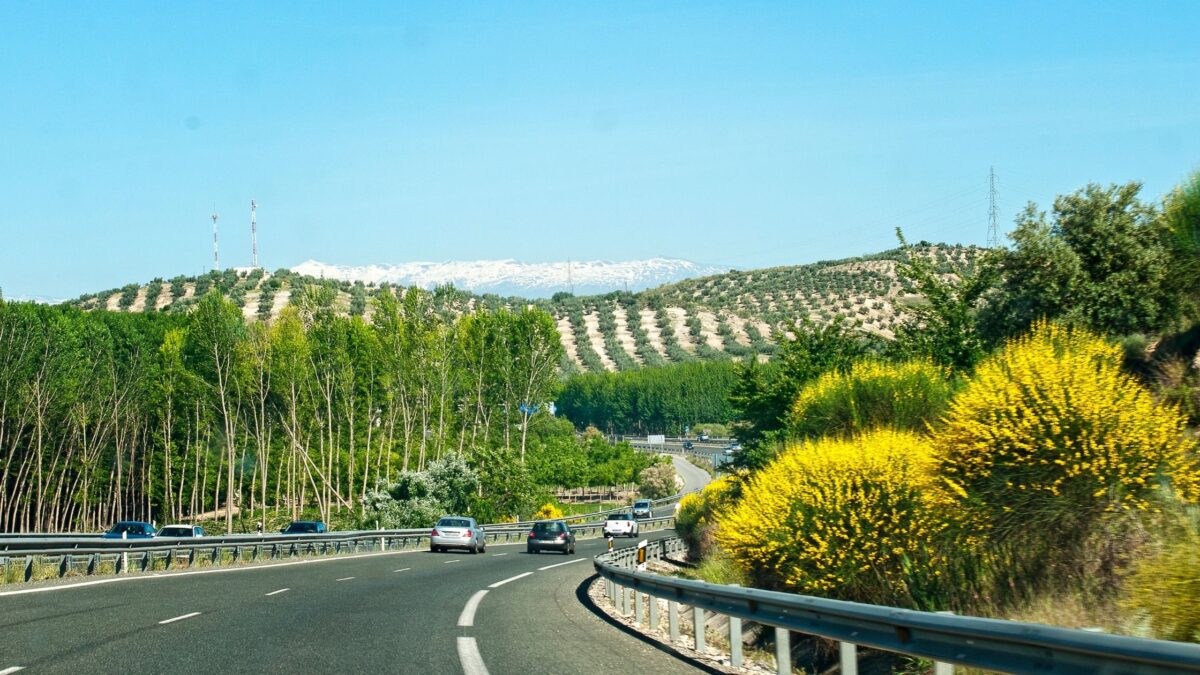
Also, unlike other countries, the parking costs are cheaper as well.
Plus, you can decide on a whim whether you want to add more places on a given day or slow down and cover as little as you want.
In short, Spain road trip = complete flexibility. Plus, hiring a car in Spain is an excellent way to see most of the country in a short period.
What is the best time for planning these Spain road trip itineraries? Summer is the most popular time and is preferred by many – thanks to the weather and the holiday season.
But peak season also means expensive accommodation and food, crowded attractions, and more vehicles on the road.
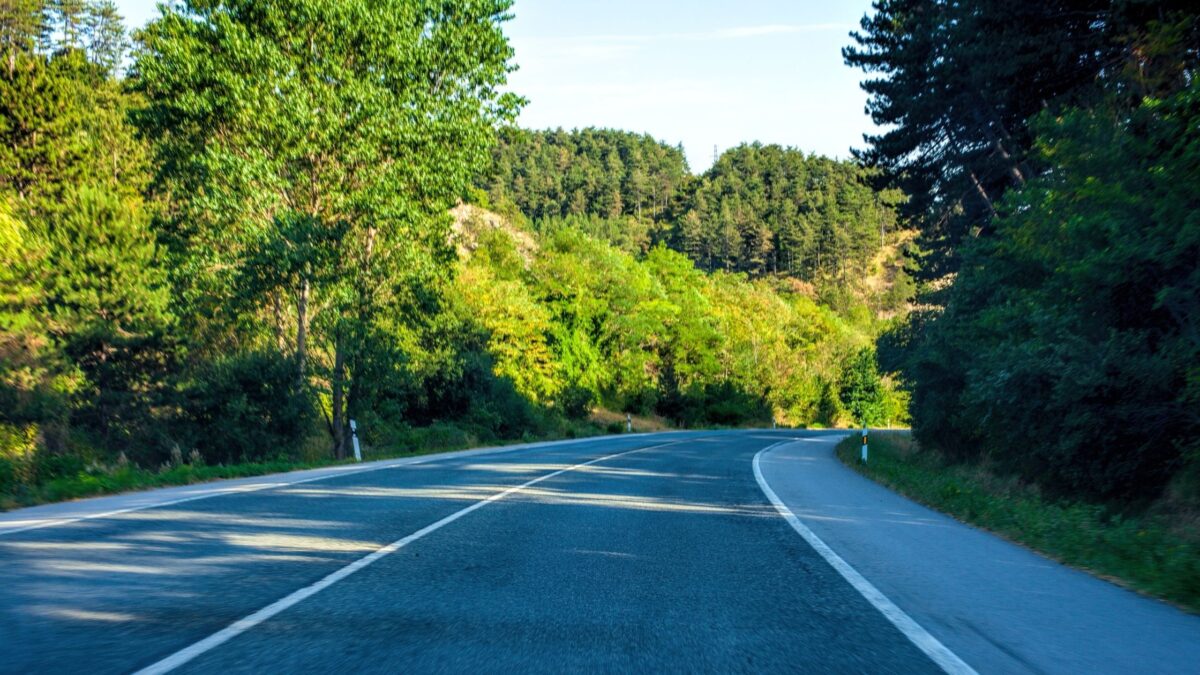
Hence, if you are like me that want to avoid all of the above, I’d recommend picking the shoulder seasons – Spring or Autumn months, or even winter as Spain is one of the best warm European destinations.
These months are great to travel to Spain with your dog as well. if you prefer not overwhelming the pet.
During these times, you would hardly find other people on the road or in tourist spots.
If you don’t mind crowds or prices, summer is, of course, the best time.
SPAIN ROAD TRIP IDEAS – HOW TO USE
I did a few of these itineraries for over three weeks spread apart, and I would say it was one of the most adventurous things I have done.
There are many itinerary combinations for seeing Spain by car.
This self-drive road trip across Spain includes things to do at all stops, unmissable activities and recommendations, and also some useful Spain driving tips, and general things to help you plan a road trip in Spain.
Each Spain road trip itinerary in this post is categorized based on the regions and routes and the number of days you need.
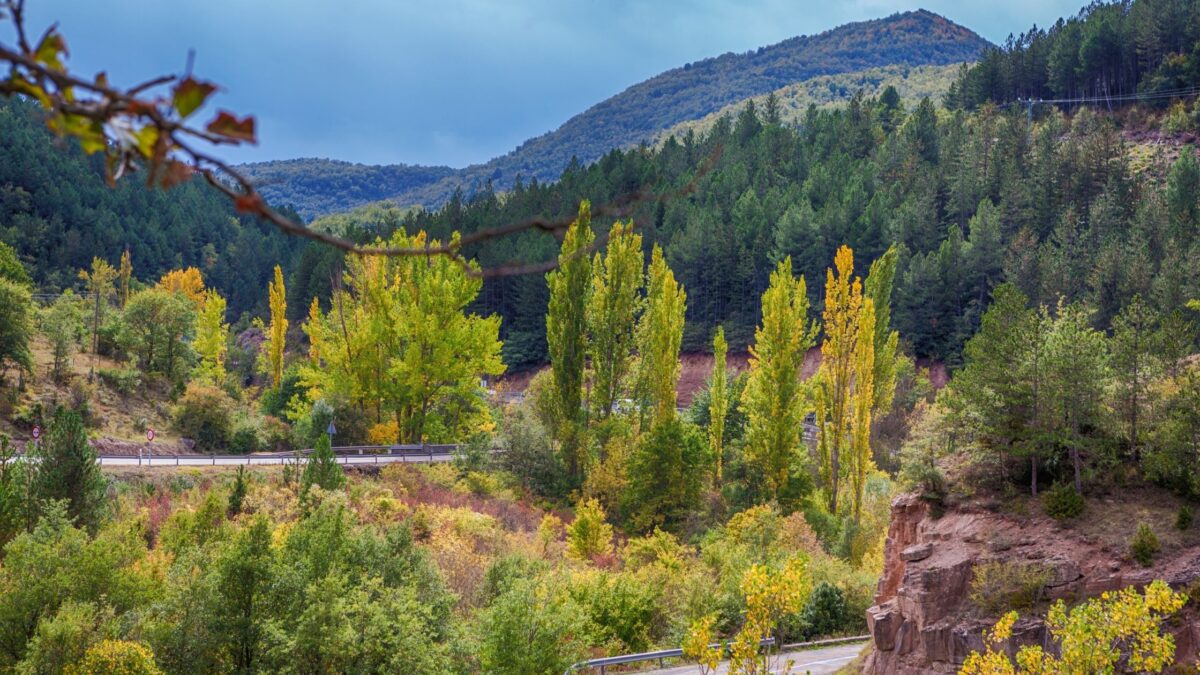
Depending on your time and the regions you wish to travel, choose a route and the itinerary accordingly from this Spain self-drive itinerary blog post.
If you are going to coming in and fly out from two different cities, I’d suggest taking the one-way rental option that allows you to drop at the same location from which you will fly out of Spain.
HOW LONG DOES A SPANISH ROAD TRIP TAKE?
The best road trip in Spain is the one that will make you feel amazing, the one where you can enjoy all the places you want to, without ending up exhausted or cramped.
You can go for a Spain road trip 2 weeks itinerary or plan a 3 weeks Spanish road trip, which you can also convert to a month-long road trip to Spain.
Ideally, you need to have at least 2 weeks if you intend to embark on a Spain road trip, which will let you cover the bare minimum destinations.
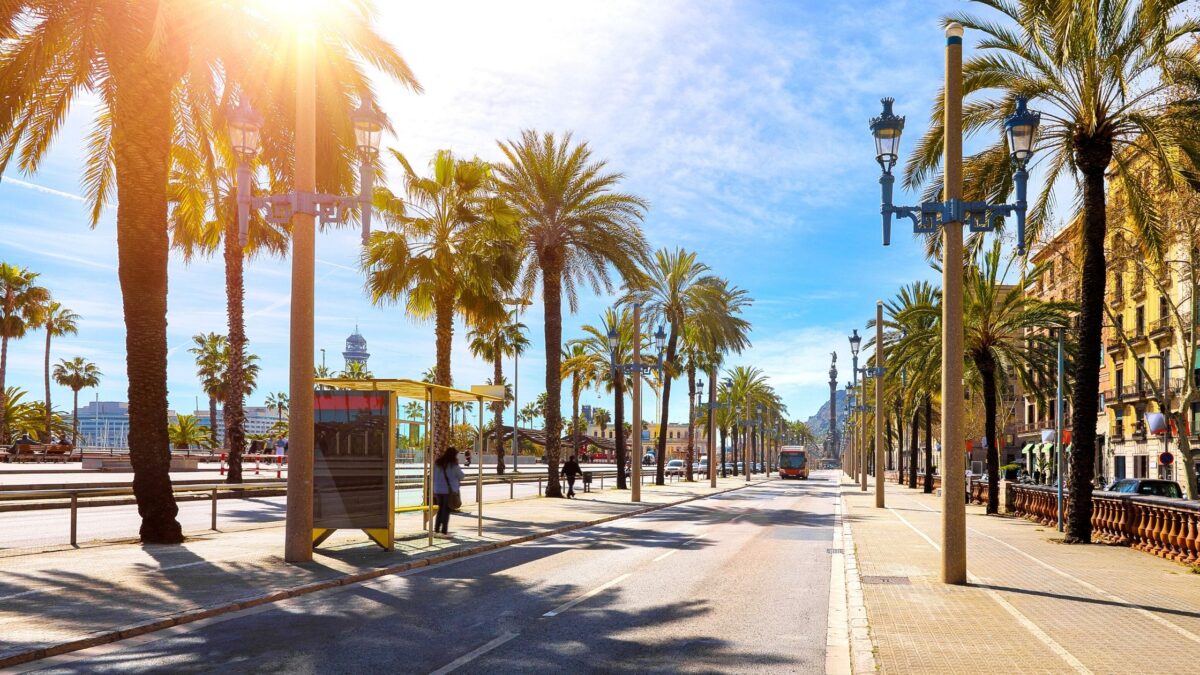
Although you can keep a Spain road trip can be as long or as short, a Three-week Spain road trip is the best period and a suggested ideal time frame.
It will allow you more time to squeeze in more attractions or take it slower if you prefer to do it without feeling rushed.
Anything less than this will make you driving across Spain most of the time, where it might be the case of more time behind the wheels rather than anywhere else.
To make the most of your time, go for all those suggested Spain day trips and guided tours in each itinerary. Add smaller towns instead of big ones if you want to go further off beaten Spain.
THINGS TO KNOW BEFORE HIRING A CAR
Here are some things to know before renting a car for a Spain road trip.
Car rental in Spain is simple, and it’s one of the cheapest countries to rent in Europe. Since Spain is a popular road trip destination, you have plenty of companies’ choices to choose from.
Also, renting for one way is available, which is best for different cities to get in and out of the country.
License requirement: For your driving holiday in Spain, you will need a driving license and an international driving permit(IDP) if you’re visiting a non-EU country.
If you’re an EU citizen, a driving license from your home country is sufficient.
Insurance: You need to have third-party insurance while renting a car in Spain. Find the best insurance quotes here.
Picking the right car: Picking the right car is essential for a hassle-free driving trip in Spain. Manual cars are in large numbers rather than automatic ones, so you will have limited book options if you are used to automatic cars.
Also, it is best to avoid bigger cars if that’s not essential. Driving inland around villages and towns, particularly in mountain areas, is easier and faster with small-sized cars.
Touring Spain by car in these areas can take longer than usual, so smaller cars will minimize the effort and risks on non-motorway roads. Driving around Spain in a small car means no difficulties in finding parking spaces, and safer on all kinds of roads.
Ensure to book your car in advance: If you are going for automated cars, I recommend booking in advance, and also, if you are planning a trip in the peak months, it is best to book your car ahead.
Google Map over Car GPS: Most car rentals in Spain charge additionally for the GPS. It is best to use Google Maps if you plan to buy a Spain Sim card or offline Maps.Me to save cost.
SPAIN ROAD TRIP ITINERARIES IN DETAIL
North spain road trip – san sebastian to santiago de compostela.
ROUTE: SAN SEBASTIAN > HONDARRIBIA > BILBAO > SANTANDER > CANGAS DE ONIS > OVIEDO > LUGO > SANTIAGO DE COMPOSTELA
When: Spring and Autumn
Duration: 12 to 14 days
Distance : 800+ KM
Northern Spain is known for its excellent culinary platter, UNESCO world heritage sites, wine, gorgeous mountainous landscapes, and spectacular coastal line.
This road trip in Spain offers a great way to discover Spain’s north in about 2 weeks minimum, covering the best of its cities, towns, and fishing villages.
This self-driving route Spain is one of the best to experience a country that is not very touristy. For the best experience, choose spring, early summer, or autumn months.
Begin from Donostia-San Sebastian or San Sebastian , the gastronomical capital of the country. You can spend 2 days in San Sebastian easily.
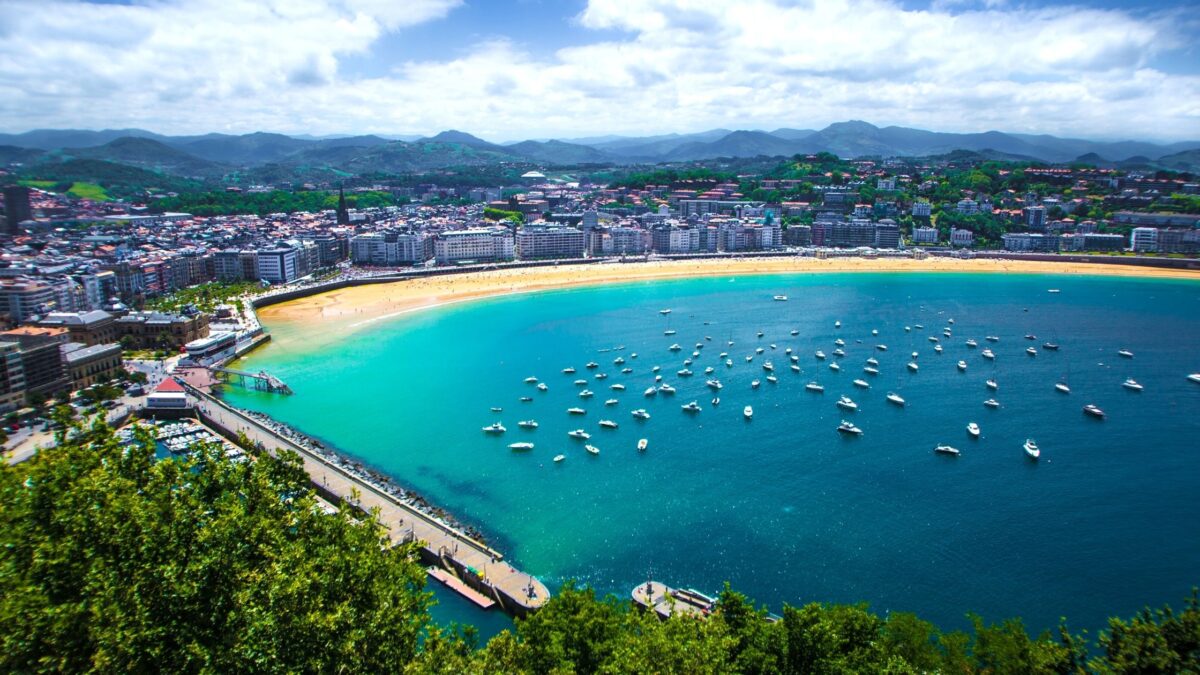
Check out the old town Parte Vieja filled with medieval monuments, the highest bars globally, and Michelin-starred restaurants, where you shouldn’t miss the many types of signature pintxos or Basque tapas.
Stroll along the famous La Playa de la Concha beach. Explore the heart of the city La Concha. Visit the local market Mercado de la Brecha to taste the local delicacies.
Recommended San Sebastian tours:
Next, plan a half-day or a day trip to Hondaribba , a tiny fishing village bordering France – known for its stunning beach and rich old town in the Casco Viejo neighborhood. Explore the castle El Parador and the medieval square Plaza de Armas.
After dipping on the beach, leave to Bilbao , one of the best cities in northern Spain . Although it’s possible to cover most of the city in a day, it would be a bit hurried.
Spend 2 days checking out the highlights, including the famed museum of Guggenheim, the old town area Ensanche, the Neo-Baroque styled oldest theatre in the town – Teatro Arriaga, La Ribera Market, and the art museum Museo de Bellas Artes.
Enjoy a funicular ride to the top of Mount Artxanda for sweeping views of the town and beyond.
Recommended Bilbao tours:
Head next to Santander , the capital of Cantabria from Bilbao, which is a 1-hour drive. You can spend one day in Santander or two if you want to relax a bit. The town is known for its national parks, castles, and coves.
If you are a nature lover or enjoy the outdoors, spend time exploring Cabarceno Natural Reserve and Reserva Natural de las Marismas in Santoña, home to many wild birds. You need a day to check out both.
Also, visit Castro Urdiales, home to a castle, church, lighthouse, and other medieval monuments.
Recommended tours in Santander:
From Santander, continue your Spain road trip to the Asturia region to arrive at Cangas de Onis, its capital. I suggest you spend one day in Santander and keep the next to explore the below attractions on the way.
I recommend you stop at Santillana village, home to the gorgeous prehistoric Altamira Caves, over 13000 years old.
Check out San Vicente de la Barquera, a gorgeous fishing village home to a castle, the stunning cave Cueva El Soplao, and Gulpilluri beach.
If these are too many to cover on a single day, keep the first part – Santillana and Altamira.
Cangas de Onis is mainly known for the beautiful lakes and nature, dominated by Picos de Europa Mountains. Many hikers make Cangas the base to check out the trails in the mountains.
Within the town, check out the landmarks like the Roman bridge and the cathedrals.
Climb the top of Covadonga Sanctuary for majestic views if the weather is clear. Then, head to the gorgeous Lakes of Covadonga, a 35-minute ride from the center.
You can keep an extra day here to check out many interesting spots on the way to the next stop, Oviedo.
Head to a unique observation deck Mirador del Fitu, for enjoying spectacular views of the Picos de Europa Mountain range. Stop at the beautiful fishing villages Lastres and Tazones.
If you have one or more days to spare, you can include a stop at Gijon , a stunning coastal city with hill cliffs, beaches, and medieval splendor.
Your next stop is Oviedo , which can be explored in a day. Check out the medieval landmarks in the old town comprising fountains, cathedrals, Campoamor Theater, and museum.
On the way to Lugo, you can stop at another UNESCO world heritage site, the 8th-century cathedral Santa Maria del Naranco.
Lugo is one of the oldest towns in Europe, dating back to Roman times. It is home to the walled old town, which is a UNESCO site.
There is not much to do in Lugo itself beyond a day but based in Lugo. You can visit some amazing places like the fishing villages of Cudillero, Luarca, and Navia. Beah bums should check out Ribadeo, Peñarronda, and Playa de las Catedrales beaches.
Next would be the last stop on this northern Spain road trip itinerary. You will be heading from Lugo to Santiago De Compostela, where you can spend 2 days and an extra day checking out day trips.
On the way to Santiago, you can plan a day trip to the gorgeous Castle of Pambre.
In Santiago De Compostela , spend a day or two checking out its highlights – The Obradorio Square, Cathedral of Santiago de Compostela, where you should head to the rooftop for amazing views and other smaller cathedrals in the old quarter.
Visit the local market Abastos, home to many bars, cafes, and excellent seafood.
Stroll in the famous Alameda Park to enjoy splendid views of the city in the evening.
Plan a day trip to Rías Baixas wine region of Galicia , a one hour drive away from Santiago de Compostela for an albariño wine tasting tour. If you have more time, you could plan another day trip to A Coruña.
Depending on whether you have planned for 12 days or 15+ days, you can add the recommendations as suggested.
If you have more time in hand, you can even cross over to Portugal and extend this itinerary further.
NORTH OF SPAIN – SAN SEBASTIAN TO A CORUNA
ROUTE: SAN SEBASTIAN > SAN JUAN DE GAZTELUGATXE > SANTANDER > GIJON > CUDILLERO > A CORUNA >
Distance: 828 KM
Duration: 14 days+
When to plant: Spring, Autumn .
Another Spain Road trip in the northern part of the country can cover this route in 2 weeks, perfect if you don’t mind exploring just a portion but slowly.
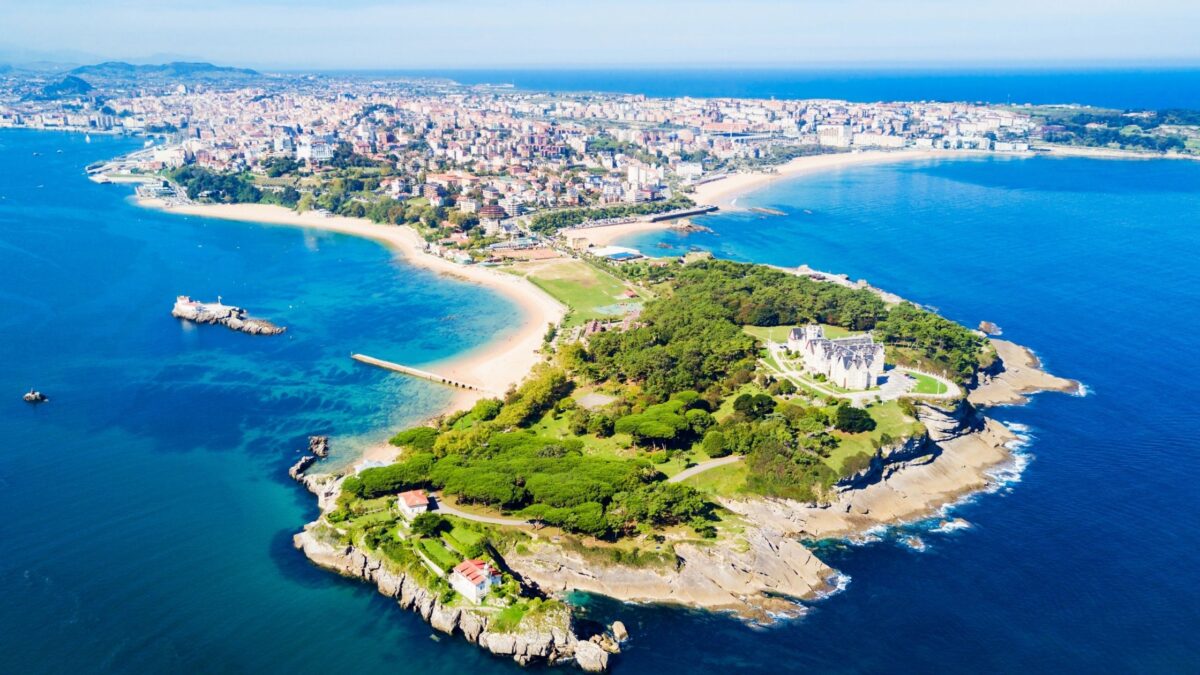
This is similar to the route above, with slight modifications. You can compare to combine these as per your preferences.
You can extend this trip by including more attractions on the way or reducing a few if you don’t like them or have other preferences.
Start your north Spain road trip itinerary with a day or two in San Sebastian , exploring the highlights – from the old town to dining at one of the Michelin-starred restaurants to tasting the different Tapas.
Relax at the beaches and get ready to head next to San Juan de Gaztelugatxe off the Basque coast.
Game of Thrones fans will instantly recognize the enchanting hilltop stone fortress, Dragonstone, in the TV show. Capture the magnificent views before continuing your drive to Santander, the capital city of Cantabria.
Spend one or two days in Santander following the above itinerary for the city covering beaches, national parks, and caves(mentioned in the 1st road trip). If you have one more day, drive along the coast to visit a few amazing fishing villages.
On the way to Gijon from Santander, there are many places for you to check out, some of which you can cover if you have one or 2 days basing yourself in either city.
As in the previous itinerary, you can stop at Covadonga for fishing villages, lakes, and parks – Depending on your time and interest; you can easily spend up to 2 days in these.
Head next to Gijon , the beautiful port city, where you can spend at least two days or one if you are short on time. You can plan a few day trips to the surrounding villages, including Cudillero, explore the castles, apart from checking out all the attractions in the city.
Galicia is one of the best places as your last stop. In this region, you next have options to visit A Coruna, Santiago De Compostela, and neighboring villages similar to the first itinerary above. Adding these will extend your trip by at least 4 days.
GALICIA ROAD TRIP
ROUTE: A CORUNA > MALPICA > LAXE > CAMELLE > CAMARINAS > MUXIA > LIRES > FISTERRA > A LANZADA > SANTIAGO DE COMPOSTALA > VIGO > LUGO
Distance: 1000 KM
Duration: 13 – 15 days
Another spectacular Spain road trip that will make you get away from the touristy destinations is the gorgeous Galician coastline in the northwest part of the country.
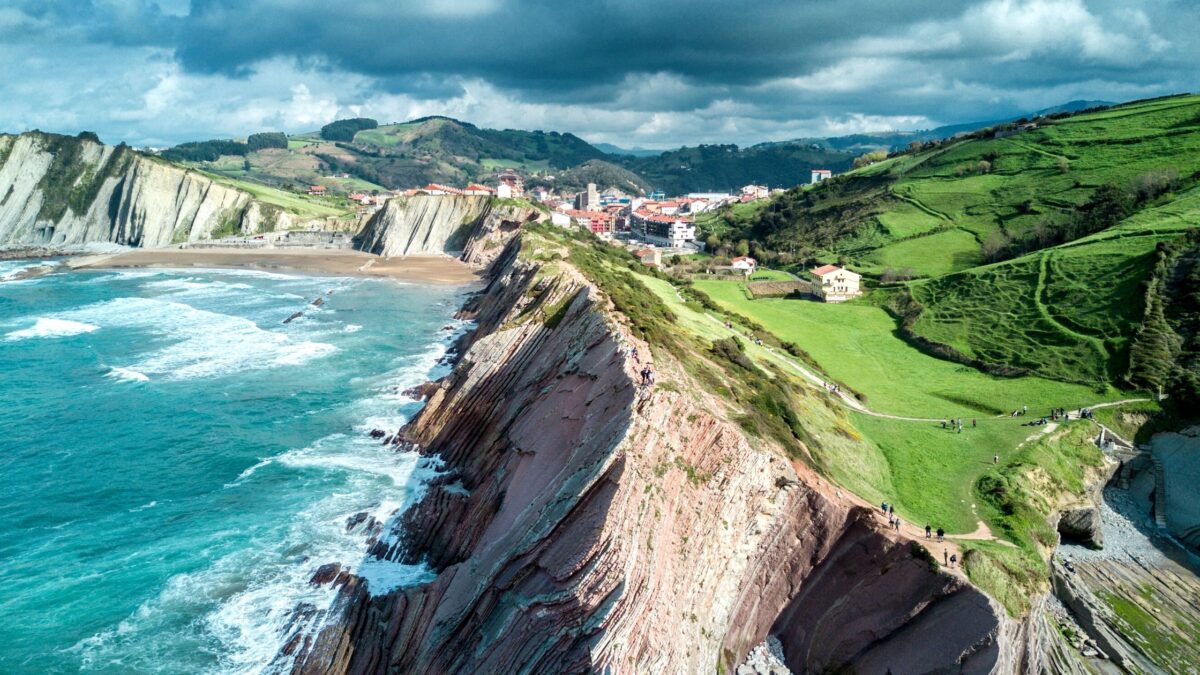
Including a few stops of the sacred Camino pilgrimage, this Galicia road trip itinerary can be kept as short as within 7 days to as long as over two weeks.
Lighthouses, rocky cliffs home to turquoise beaches leading to the North Atlantic ocean, seafood, sea breeze, dramatic views of the panorama – these are what you encounter in this route, which will make you fall in love with this slice of Spain.
This is one of the pretty Spanish road trips right along the coastline – Driving all the way watching the coast next to you is one of the surreal experiences.
Start this route from A Coruna , a pretty beach town where you can spend a day leisurely, admiring the beaches, lighthouse, and seafood. You can reach by flight from Madrid to A Coruna, or all the way by car from Madrid too.
The next day, stop at the gorgeous Vixia Herbeira cliffs and the village of Culleredo before continuing along the coast to your next stop Malpica.
Now, you have the option of basing yourself in Lires, which is the bigger town, to explore the others by short drives or cover the neighboring towns as stops first and then arriving at Lires.
Visit the towns of Muxia, Camariñas, Camelle, and Corme lying between Malpica and Lires . Depending on your time, you can include or skip some of these towns.
All of these amazing towns are home to stunning coastline filled with pretty beaches, lighthouses, rocky cliffs, and capes with viewpoints to offer 360-degree views of the horizon.
In these parts of Galicia in Northern Spain, you will realize how isolated it is from the country’s most bustling tourist hubs. This route takes you deep into the country’s heart – you will meet mostly locals and a few or no tourists at all, and all the attractions remain treasured away.
You can go sailing, try SUP boarding, and kayaking at the many fantastic Galicia beaches. Try the unique cuisines of Galicia, which you will absolutely love if you are into seafood.
After a few days, head next to Fisterra , one of the westernmost locations in Europe, for continued bliss and bounty. Fisterra is the ideal town to spend a couple of days for a bit of hiking, beach sports, and enjoying the Spanish villages.
After a day or two, continue around the coast to Santiago de Compostela , one of Spain’s beautiful places.
I suggest sticking along the coast, although Google Maps may provide you with a few inland alternatives because half of the fun lies in enjoying the sweeping views comprising of amazing landscapes along the way on this road trip.
One of the country’s sacred places and the Camino pilgrimage path’ s endpoint, explore Santiago for at least 2 days, checking out its historical attractions, including the old town, a UNESCO World Heritage Site.
Drive towards the coast again to reach the next town A Lanzada. You can spend a day in the town, and then take a day trip to Pontevedra to Vigo town.
From Vigo, plan a day trip to the beautiful Cies Islands, where you can hike and enjoy the secluded beaches.
This stretch is best for all watersports, splendid sunsets , and sunrise views . Add a visit to the amazing You can drive through within a day or spend a few days in each of these towns – the choice is yours.
On the way to Lugo, where you will drive away from the coast, you can stop at Sil Canyon , one of the magnificent gorges known for splendid views and underground wine ports.
Get to know traditional wine-making processes while you are here. You can also hike to some viewpoints before heading to Lugo.
Your last stop on this Spain road trip route in Galicia is Lugo city, known for its rich old town, gardens, and National Parks. You can spend at least 2 days checking out Lugo’s attractions before ending this fabulous road trip itinerary in Spain.
ANDALUSIA (SOUTHERN SPAIN ROAD TRIP)
ROUTE: MALAGA > NERJA > GRANADA > CORDOBA > SEVILLE > CADIS > GIBRALTAR > MARBELLA > RONDA > OSUNA > SEVILLE
When to plan: any time of the year
One of the most famous regions in Spain is Andalucia, a dreamy province home to fantastic cities, beach towns, mountains, incredible historical ruins, amazing food, and nightlife.
If you are visiting Spain for the first time and looking at a trip of about 2 weeks or so, I’d highly suggest you pick this route.
Sure, this Spain road trip route includes many famous destinations, and you can expect crowds at any time of the year, but trust me, this is the route to immerse yourself in Spain for first-time visitors.
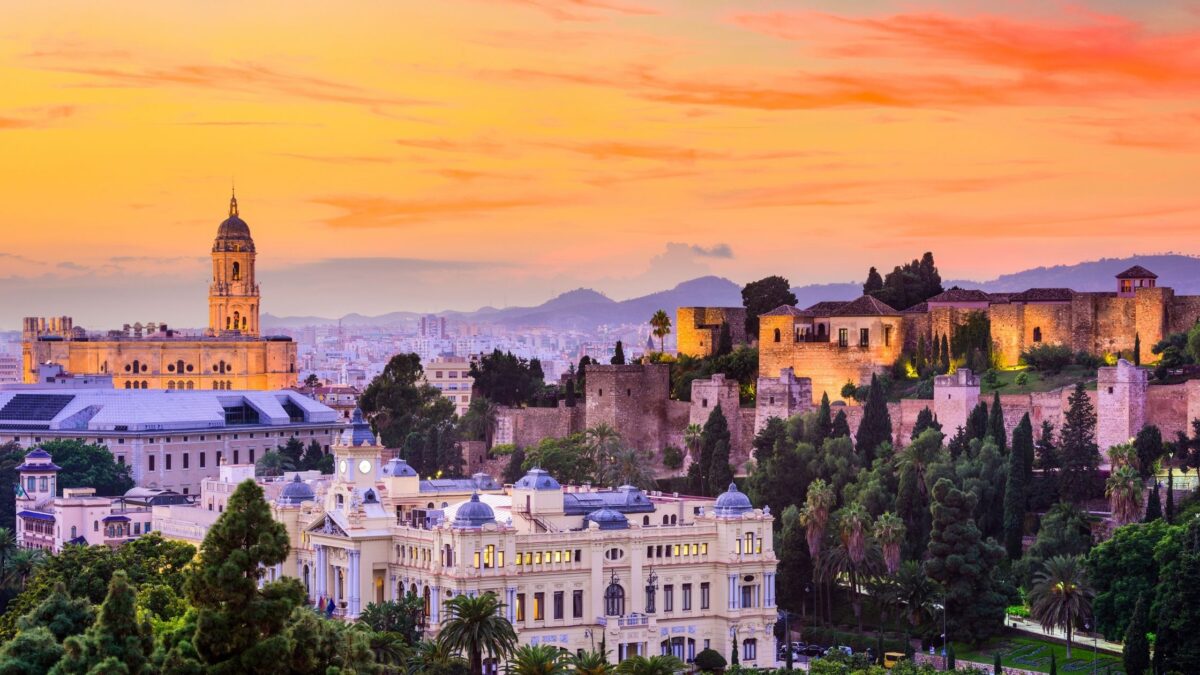
You can add more days and turn this itinerary into a full-fledged 3-week Andulacia road trip too, which is best. Or you can browse through places on a week-long road trip in Andulacia if you are short on time.
Majestic, mammoth fortresses atop hills, lavish architecture, castles, many fantastic historical sites, mountains, and beaches are the elements that makeup Andalucia astounding.
It’s the region with the most UNESCO World Heritage Sites in the country, another reason for you to choose this itinerary.
Thanks to compact towns, it is possible to see and do more on this route, so it is one of the famous self-drive Spanish road trip itineraries.
This road trip loop can be started anywhere, depending on where you will be arriving. This itinerary begins at Malaga and ends in Seville, which you can reverse if Seville is where you will arrive.
Spend 2 days in Malaga , visiting its Alcazaba, the Moorish fortresses, the Roman Theatre, cathedral, and many museums, including Picasso’s home. Relax at the beaches, try the cuisine and drinks.
Keep a day for exploring the whitewashed Andalucian villages or pueblos from Malaga, including Mijas .
Spend a day checking out the small yet pretty town of Nerja . On the way next, visit Torre Del Mar and Frigiliana, beautiful Moorish villages.
Head next to Granada , one of the beautiful towns in Spain. Admire the spectacle of the Alhambra complex, one of the iconic landmarks in the country. One of the most visited sites in Spain, explore its many palaces and gardens while enjoying the incredible views from the top.
Depending on your time, you can spend one or two days in Cordoba next, one of Spain’s best cities for its enriching history, architecture, and religion. Check out its famous monuments, colorful cobbled alleys, and stunning views.
Continue your drive to arrive at one of the top 10 places to visit in Spain – the city of Seville.
Home to flamenco dance, a vibrant maze of cobbled streets, UNESCO world heritage sites like the splendid Alcazar and royal plazas, you can spend a week just exploring Seville and around itself.
After enjoying the Tapas bars, monuments, and colorful streets of Seville, head next to Cadiz , the oldest city in Europe, dating to prehistoric times, spend a day going around the neighboring villages around Cadiz before heading to Gibraltar.
Gibraltar is not a part of Spain but rather a British overseas territory, known for its stunning rocky landscapes, tunnels, caves, and hiking trails. You can spend one to two days here. You might have to check on the visa based on your nationality, though you intend to add it to your route.
On the way next, follow the coast to visit a few Andalucian white villages, including Benahavis and Casares , before reaching Marbella, the seaside resort town.
You can spend two days in Marbella before heading to Ronda , the wonderful hilltop town, where you can spend a day, before heading to Setenil de las Bodegas.
Before heading back to Seville, your last stop is the town of Osuna, one of the Game of Thrones filming locations, where the Roman Theater was the venue for a scene including the Mother of Dragons.
Wrap up this epic itinerary at Seville, having tried some more Tapas and Sangria.
CASTILLE LEON ROAD TRIP
One of the amazing road trip itineraries for Spain is this route that takes you through the Central region of Castille Leon. Spring and Autumn are the best months to embark on this drive in Spain as the summers are hot while the winter months are cold.
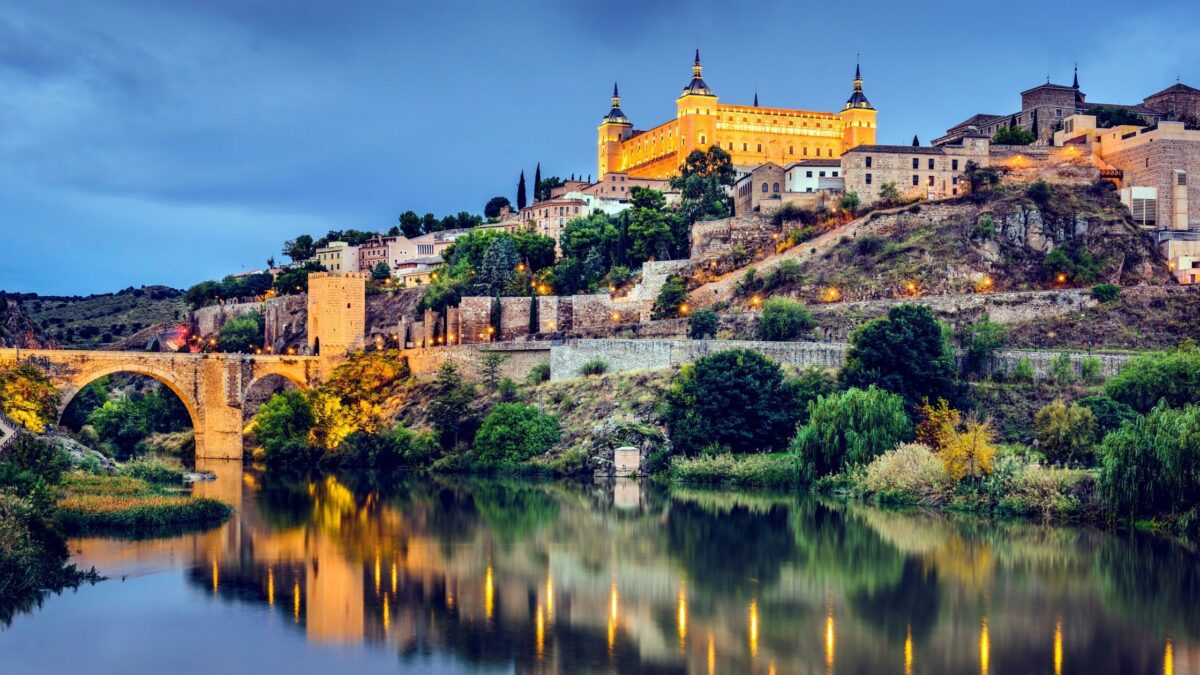
You can witness the beautiful rugged mountains carpeted with colorful wildflowers of spring. You will cover pretty towns along the winding roads, hilltop villages, and some amazing UNESCO sites on this Spain road trip itinerary. You can cover this route within a week or stretch it up to 2 weeks, the ideal being around 10 days.
After checking out the capital Madrid for a day or two, begin your trip on the road by taking the day trip to Toledo , one of the most well preserved old towns in Spain, to explore its UNESCO World Heritage Site filled with amazing ruins.
Drive next to Avila , a small town famous for being home to the well preserved, Romanesque style medieval walled old town. Get transported back in time as you wander through the old quarter’s cobbled stone streets, the walls, and the square lined with cathedral and other medieval buildings.
You can spend overnight here or continue this self-drive Spain road trip itinerary to head next to Salamanca , one of Spain’s most beautiful cities.
Sitting atop a hill, this gorgeous city is filled with pastel-colored stone buildings and the university, which is one of the oldest in Europe. A famous university city, Salamanca’s old quarter is a UNESCO heritage site.
Spend at least 2 days in Salamanca checking out all the sights before heading to your next stop Zamora . Another beautiful town known for its richness in architecture in history, Zamora is the land of castles, churches, medieval walls, and other splendid medieval buildings – all of which you can check out spend overnight there.
Continue this Spain road trip from Madrid to arrive next to Valladolid, where you can cover the attractions within a day and explore any of the lovely vineyards, after which you can head to Leon .
You can spend one to two days checking out Leon, home to many beautiful medieval attractions, including cathedrals and museums.
Plan a day trip to Aranda del Duero before your next stop Pedraza, or head directly to spend a day or two in Segovia, one of the prettiest Spanish towns known for its UNESCO World Heritage Site – a walled city home to several stunning monuments.
Don’t miss the gorgeous castle and the aqueduct here in Segovia, along with some interesting museums.
Before heading back to Madrid, you have one stop to make, at San Lorenzo de El Escorial. Housing the pretty royal monastery, palaces, and burial tombs are one of Madrid’s famous day trips.
MALLORCA ROAD TRIP
ROUTE: PALMA > CALA D OR > CALA RATJADA> POLLENCA > LLUC > SOLLER > DEIA > VALLDEMOSSA > PALMA
Duration: 7 – 10 days
When to plan: Throughout the year
One of the unique road trip itineraries in Spain to get off the mainland and explore one of its stunning islands – Mallorca.
You can complete this trail in less than a week or drive along the coast for up to 10 days on this self-drive Spain road trip itinerary.
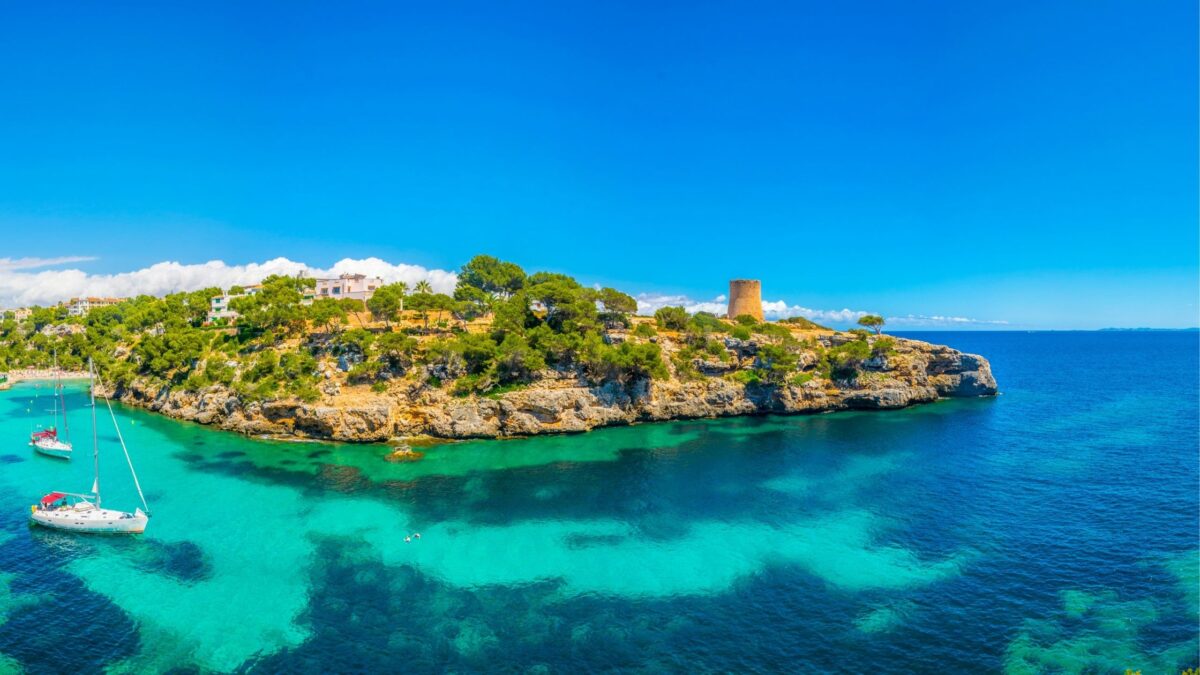
Home to the majestic Tramuntana mountain range, Mallorca is blessed with rich landscapes filled with rocky cliffs offering sweeping views of the ocean, fairytale villages, fortresses, and excellent food.
Start your trip from Palma, which would be your arrival point on the island. The capital city of Mallorca, Palma, is one of the underrated cities in Spain.
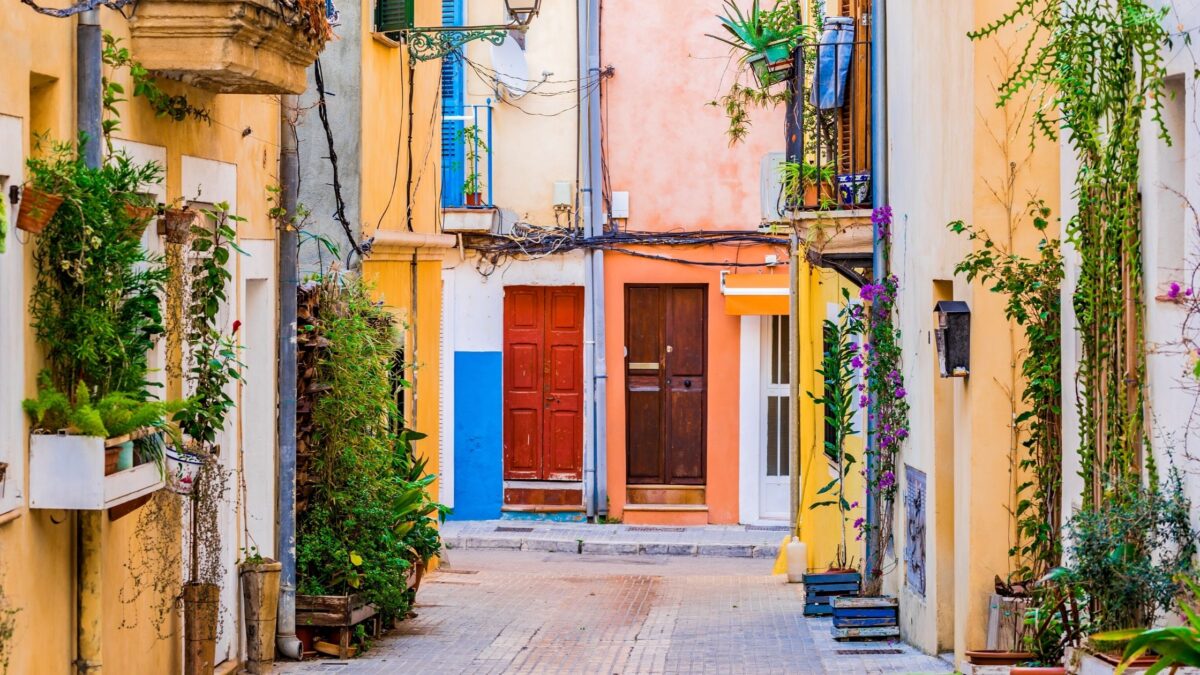
Spend a day to check out this beautiful city home to a huge medieval cathedral, a bustling morning market, and other Renaissance monuments.
From here, you have two options. If you want to keep this trip short, then continue next to Pollenca, and then afterward along the coast, circling Palma.
However, you can have a complete, bigger circle around the island if you have more than a week, which will mean you can visit the east coast of Mallorca.
Assuming the second one for this reference, drive from Palma to the east coast, all the way to Cala d’Or , a swanky resort town with some amazing viewpoints and beaches.
If you fancy a nice bungalow, spend overnight or more in one of the luxurious resorts. Or explore during the day, and drive along the coast to arrive at your next stop Cala Ratjada . You can spend a day or two exploring the nearby fishing villages and beaches.
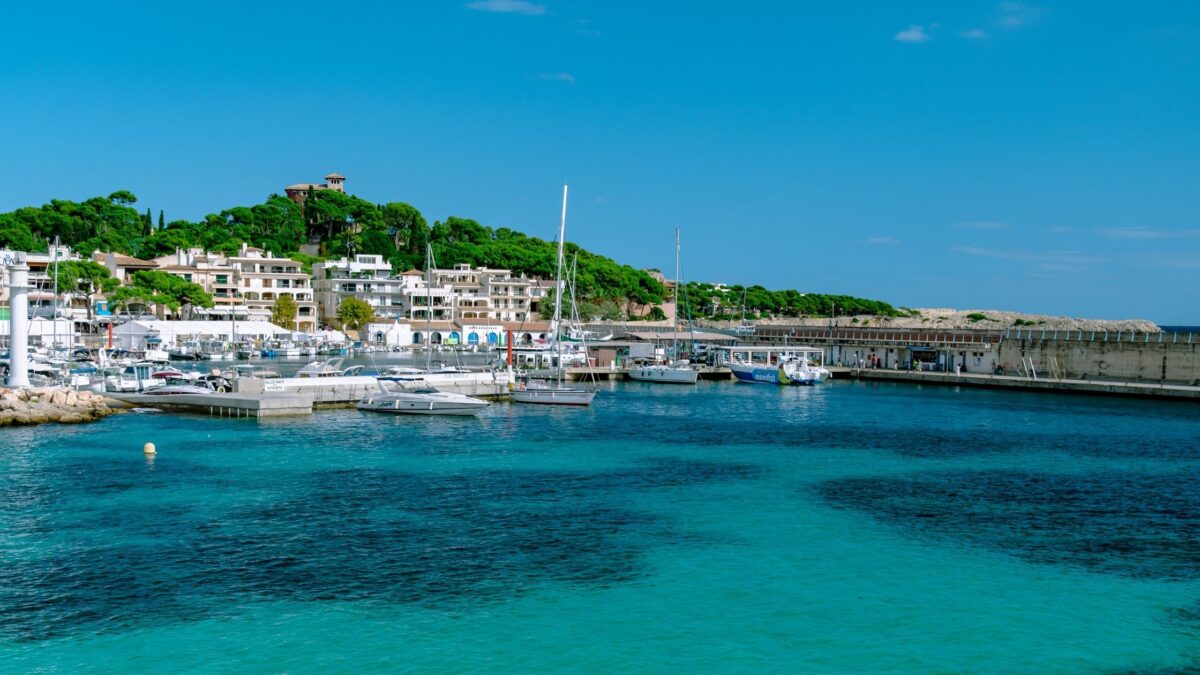
Continue to drive further to go to Pollença . It is one of the laidback towns perfect for a relaxing stop. One of the top attractions is the lovely Cap de Formentor , from where you can enjoy beautiful views of the sunrise.
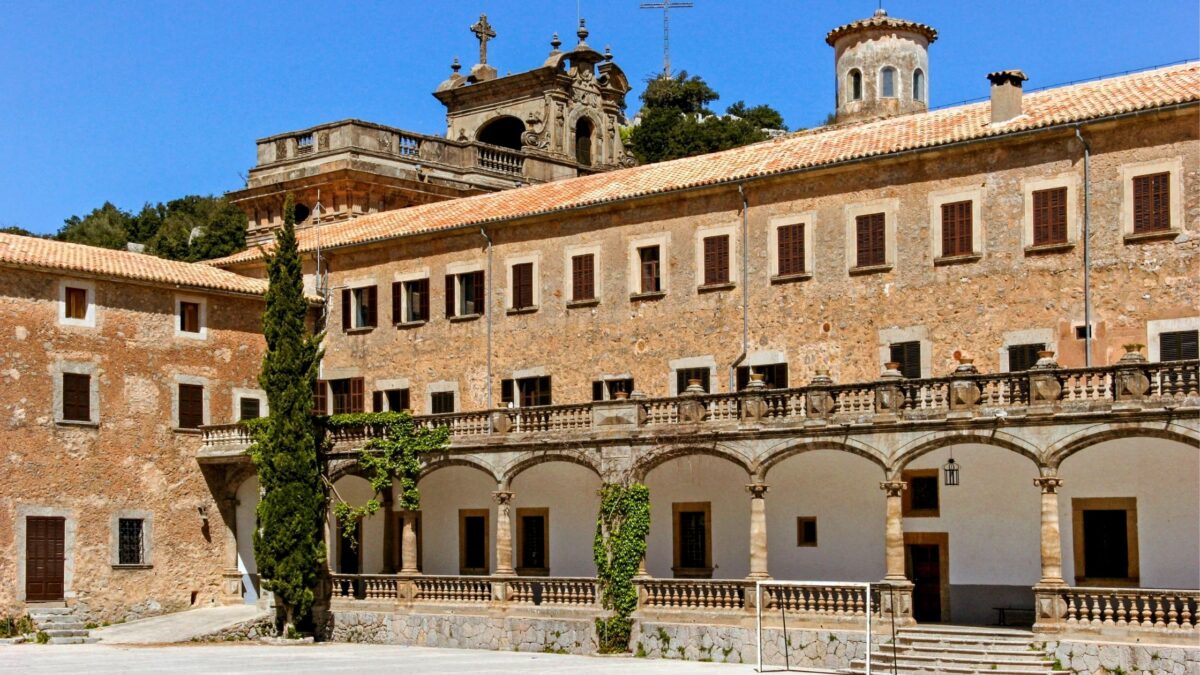
After a day in Pollenca, head next to Lluc , home to the sacred monastery, one of the country’s pilgrim sites.
You can base here and spend the next few days checking out the enchanting villages of Fornalutx, Deia, Valldemossa, and Port Valdemossa.
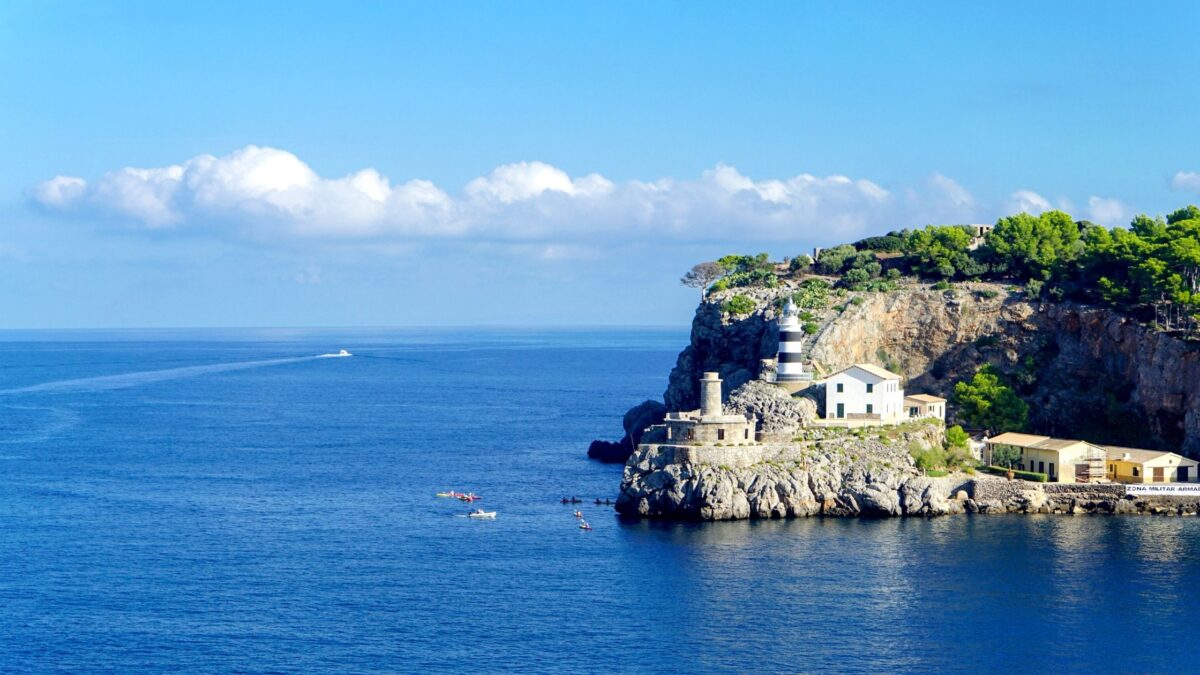
Also, spend a day or two in Soller , close to Deia, before winding up this trip in Palma.
OTHER TRAVEL TIPS
Here are a few more driving tips for Spain that you should check out.
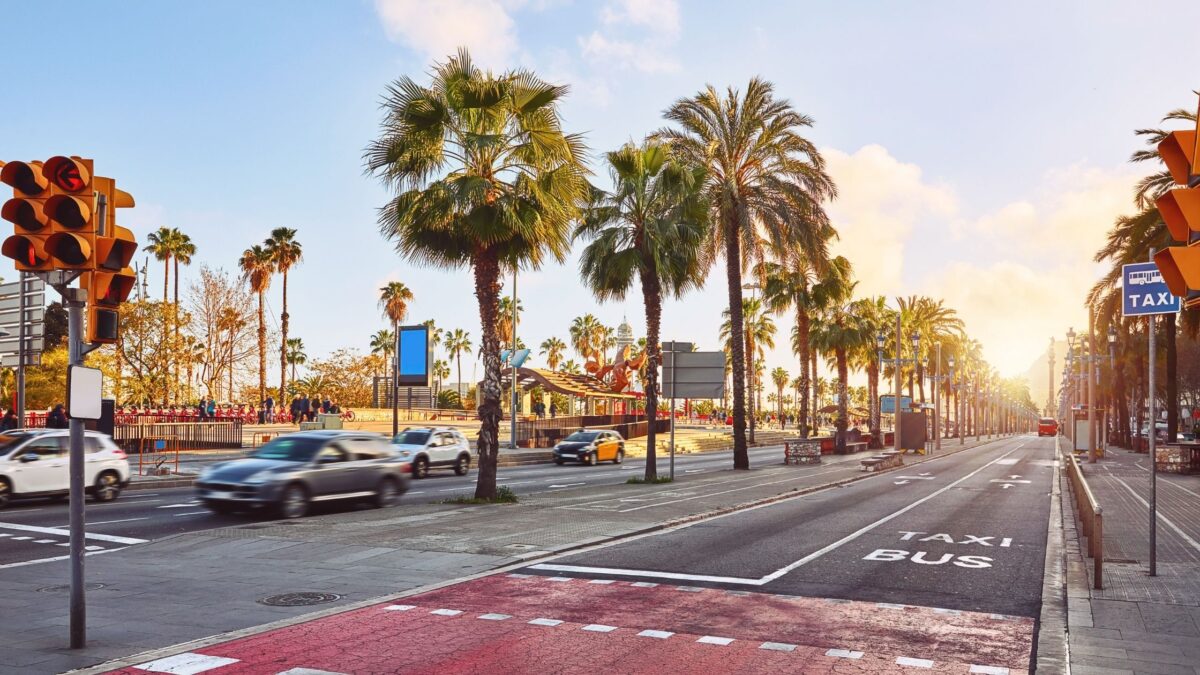
- There are two kinds of roads in Spain, with main highways having a toll fee. In some regions, the fee is costly, so make sure to divert or go for alternatives.
- Parking for travelers is usually marked in blue in the parking lots, close to which there would be ticket machines for parking. Buy the ticket and place it on the board.
- It is best to avoid using the car to go around in bigger cities like Barcelona or Madrid . Apart from traffic, you need to stay on top of parking details and manage crowds – all of which can be exhausting.
- Avoid combining drinking and driving – Although it goes without saying, sometimes on holiday, it’s easy to get carried away, especially in Spain road tripping with one too many wine or Sangria. Watch what you drink if you have to keep driving.
- Recent Posts
- Backpacking in the USA: Top Tips to Know - May 26, 2024
- Exploring the Mystical Land of Ladakh - May 26, 2024
- Your Ultimate Guide to the Best Things To Do in Krakow, Poland - April 12, 2024
Related Posts

Spain Solo Travel Bucket List – 40 Fantastic Things You Should Do Alone

20 Free Things To Do In Tenerife, The Gorgeous Island In Spain

9 Best Hidden Gems In Spain You Should Check Out
Amazing! I know nothing about traveling all over the country, what a wonderful looking place to explore.
Write A Comment Cancel Reply
Save my name, email, and website in this browser for the next time I comment.
- SOLO TRAVEL
- ARUNACHAL PRADESH
- HIMACHAL PRADESH
- UTTARAKHAND
- THE PHILIPPINES
- UNITED STATES
- TRAVEL FACTS AND TRIVIA
- WORK WITH ME
Type above and press Enter to search. Press Esc to cancel.

The Best Road Trips in Spain and Their Self-Drive Itineraries
March 11, 2021
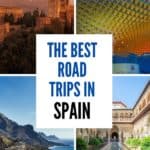
From rocky volcanic coasts to medieval city charm, driving in Spain can be an absolute joy. After years on the road as a travel writer and resident, I bring you the best road trips in Spain, plus the ultimate Spanish road trip itinerary. Bucket lists at the ready? Let’s go! Updated 2021.
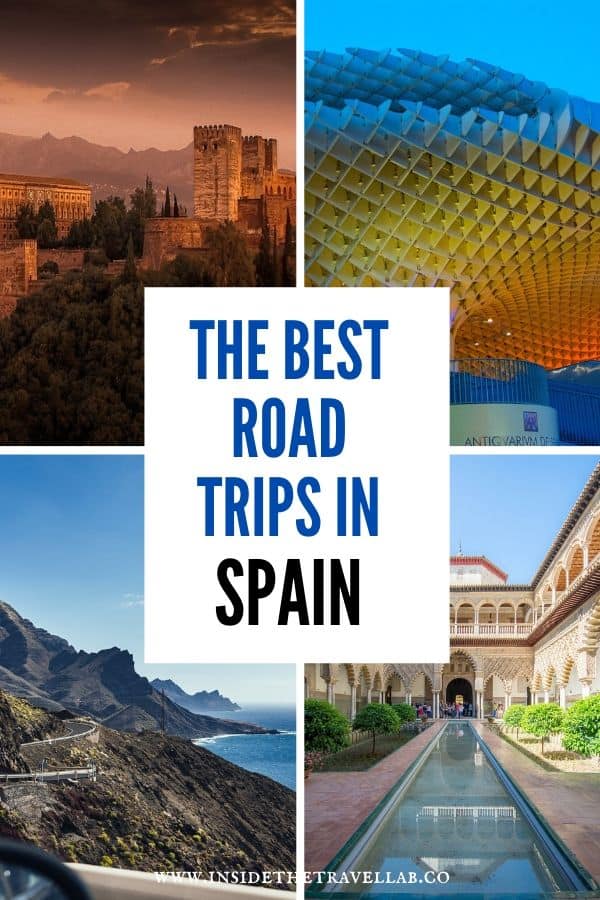
Table of Contents
THE BEST ROAD TRIPS IN SPAIN
If walking is one of the best ways to see a city, then driving is one of the best ways to see a country. Driving in Spain has brought me deep, deep joy, rising through the red dust of Andalusia and plunging through the deep green of Galicia.
You can find the separate road trip itineraries through Spain dotted throughout the article, but this article focuses on the best road trips in Spain.
- Download your free road trip essentials list and road trip packing list.
- Download the road trip planner and toolkit here.
Recommended
I love sharing the best travel resources I can find.
- I never book a flight without looking on Skyscanner first
- My favourite one stop shop for airport transfers, food tours & excursions is Get Your Guide
- Out of the big accommodation machines, I use Expedia and Booking.com the most
- I’ve hand-picked useful travel gear and tools for you in my Amazon shop . Never leave home without a travel adapter or collapsible water bottle . I’d also recommend these soft ear plugs and a sleep mask .
- Access all our planners and budget spreadsheets in the Travel Toolbox ©
- Plan the perfect road trip with our Road Trip Planner & Toolkit ©
- Use these packing cubes to make life so much easier on the road.
- Save on mobile phone roaming charges with an eSIM from Airalo .
TRAVEL SPAIN BY CAR
We start with the ultimate Spain road trip itinerary, taking in the mainland for first time visitors. But don’t forget Spain’s islands, not to mention delving deeper into the regions to find a richer, more authentic experience when you have more time.
Whether you call it fly-drive, self drive or want someone else to help you travel Spain by car, this is the collection of the best road trips in Spain.
Happy planning!
The Ultimate Spain Road Trip Itinerary
If all you have is two weeks, then this is the best Spain road trip itinerary for you. This two week self-drive Spain itinerary brings you the highlights of the country at a reasonable, but not relaxed, pace.
However, I’d always advise that you take is slow if you can. It’s far more enjoyable to spend more time out of the car than in. With that in mind, check out some of the other regional road trip ideas below.
Of all the places in the world, Spain is disinclined to rush. People here like to take their time and savour the joys of everyday life. Racing to fit your busy schedule does not usually rank highly in that regard.
The Ultimate Spain Road Trip Itinerary At a Glance
- Day 1: Arrive Barcelona
- Day 2: Barcelona
- Day 3: Girona and the Pyrenees
- Day 4: Valencia
- Day 5: Valencia to Madrid
- Day 6: Madrid
- Day 7: Madrid to Toledo
- Day 8: Toledo to Granada
- Day 9: Granada and the Alhambra
- Day 10: Alpujarras Mountains
- Day 11: Seville via Cordoba
- Day 12: Seville
- Day 13: Cadiz via Doñana National Park
- Day 14: Malaga to fly home
Historical city centres in Spain were designed for pedestrians and, at a stretch, horses. They were not designed for cars! Be careful when following SatNav instructions into steep, old towns. You can find yourself unable to make some tight turns and then somehow need to reverse backwards down a narrow road. Stick to the main roads in town!
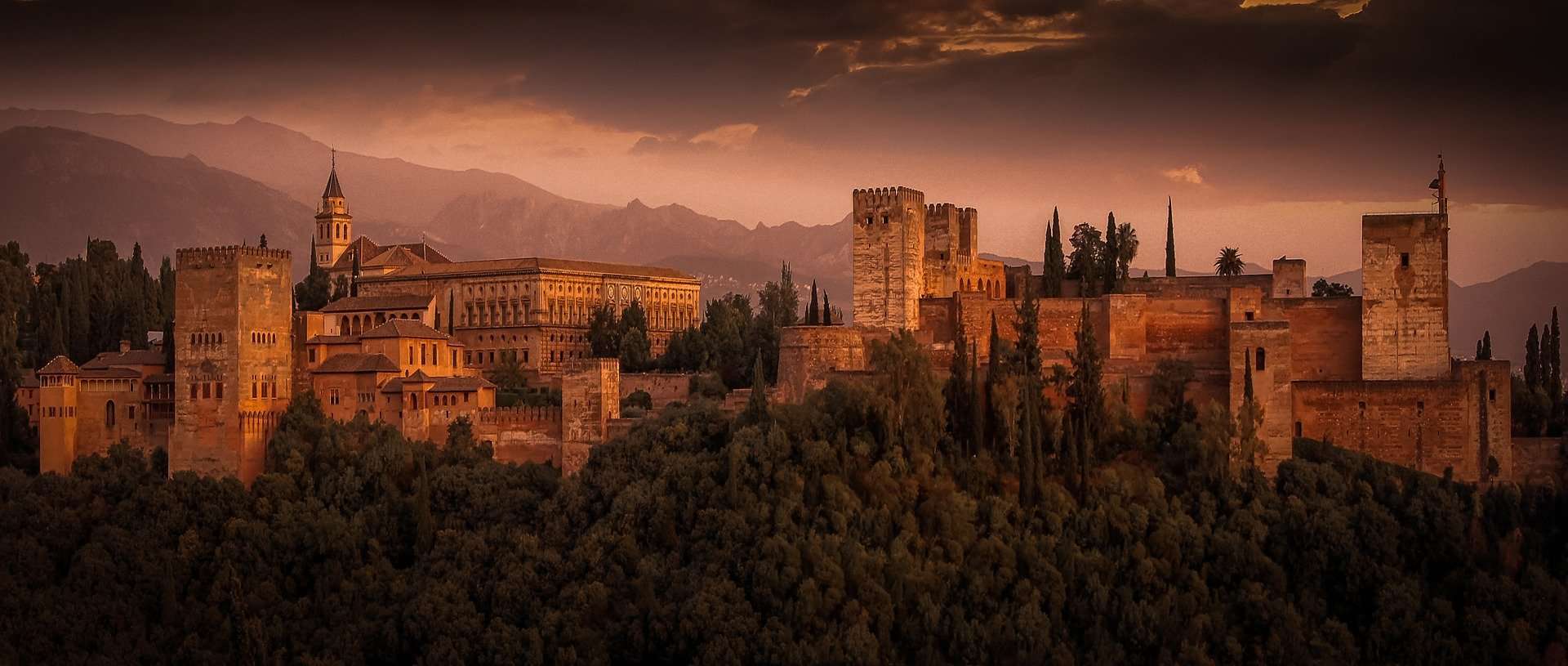
Southern Spain Road Trip Through Andalusia
A road trip through Andalusia, Spain’s biggest region, unsurprisingly covers a lot of ground. This passionate place is the home of flamenco, jamon and sherry, as well as staggering, world-renowned monuments.
You can easily fill two weeks with UNESCO World Heritage Sites like the Alhambra in Granada, the Real Alcazar in Seville and the unbeatable mosque turned cathedral in Cordoba.
But a self-drive road trip through Spain allows you to visit off the radar places and explore local traditions like joining the olive oil harvest in the mountains. From the beaches to the snowy peaks of the Sierra Nevada, driving through Andalusia really is one of the best road trips in Spain.
Andalusia Road Trip Itinerary At a Glance
- Day 1: Arrive Malaga.
- Day 2: Drive to Cadiz
- Day 3: Cadiz to Seville via Doñana National Park
- Day 4: Seville
- Day 5: Seville to Granada via Cordoba
- Day 6: Granada & Alpujarras Mountains
- Day 7: Back to Malaga to fly home. Find the complete southern Spain road trip itinerary here.
- Malaga is the biggest international airport but you can also fly into Seville and Granada with relative ease.
How about the Madrid to Seville drive?
With so many international flights arriving in Madrid, you may be wondering whether or not you should drive from Madrid to Seville or take the train instead.
A Madrid-Seville Road Trip can pass through many off the beaten path destinations, like Zafra and Merida, but in my opinion, it’s not one of Spain’s best road trips.
If you are short on time, I’d highly recommend taking the extremely fast and efficient Madrid-Seville train and then picking up your rental car in Seville to tour Andalusia.
It’s also possible to drive from Madrid to Granada by car, swerving up and down the Alpujarras Mountains, but again, I’d suggest picking up your wheels in Andalusia instead.
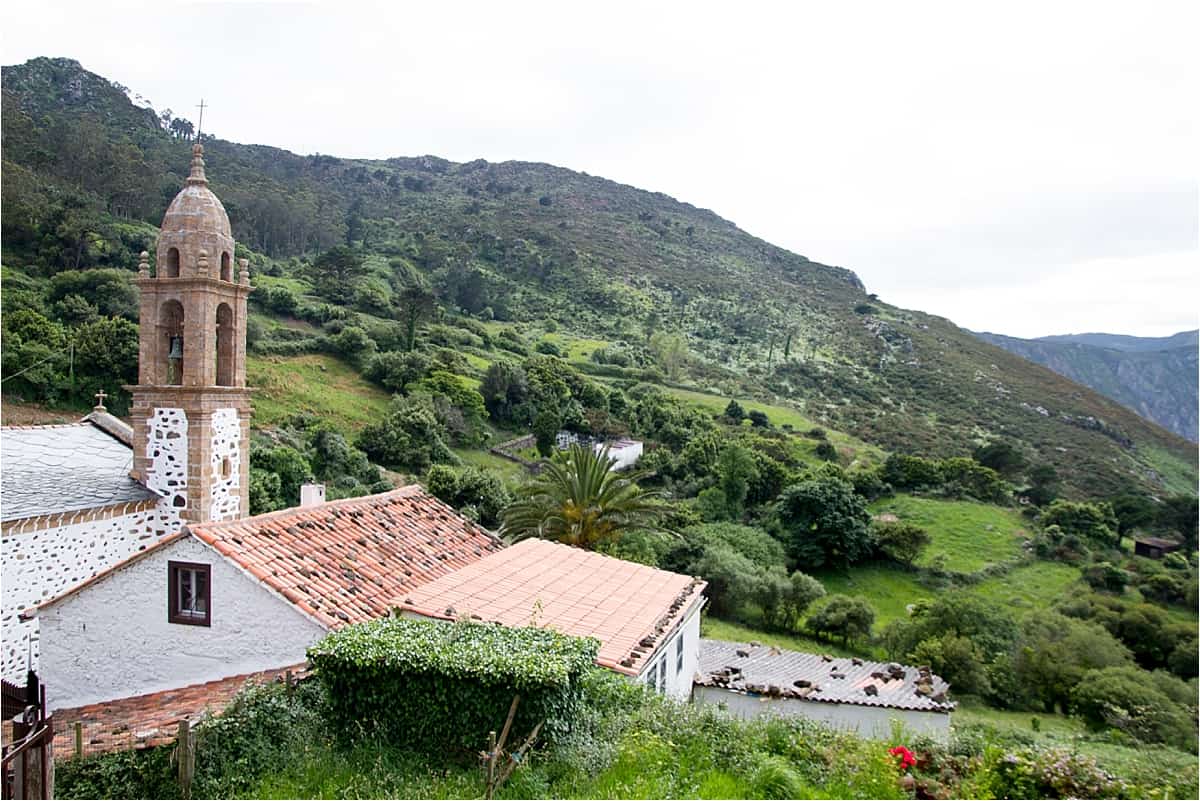
The Sanctuary of Dismembered Wax Body Parts
Northern Spain Road Trip Itinerary
Prepare to be surprised when you find out what makes this one of the best road trips in Spain.
The northern area of Spain swaps dry plains for rocky coves, and bull rings for lighthouses and salt marshes amid the green. Famed for its seafood and as the finishing point for the Santiago de Compostela pilgrimage route, this northern Spain road trip itinerary will show you a different side of the country.
- Want more detail? Explore this Galicia road trip itinerary.
Northern Spain Road Trip Itinerary At a Glance
- Day 1: Arrive San Sebastian
- Day 2: San Sebastian to Bilbao
- Day 3: Bilbao to Aviles
- Day 4: Aviles to A Coruña
- Day 5: A Coruña to Santiago de Compostela
- Day 6: Santiago de Compostela to Vigo
- Day 7: Back to San Sebastian to fly home
Recommended reading: Road Trip Galicia, Spain; The Undiscovered Northern Coast
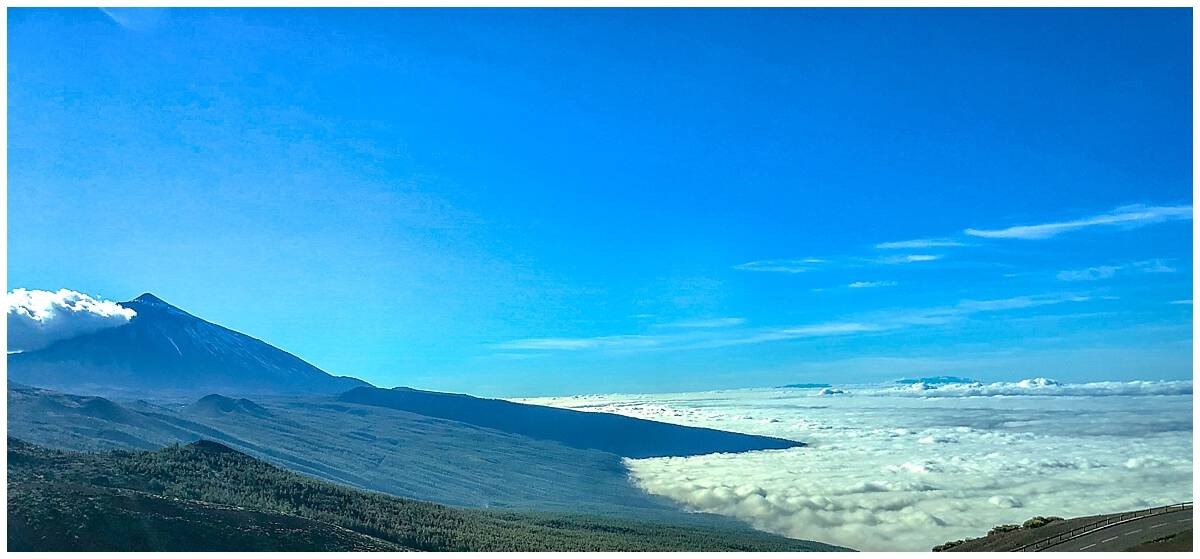
View above the clouds on El Teide in Tenerife
Road Trip Through Tenerife (Canary Islands)
As the largest Canary Island off the northwest coast of Africa, Tenerife is famous for its fly and flop beach holidays. But there are so many unusual things to do in Tenerife , from UNESCO World Heritage cities like Laguna to primitive biosphere reserves in Anaga. It’s a hiking paradise and if tight turns and steep roads don’t phase you, a great wild landscape awaits.
Driving through Spain takes on new and heady heights when you’re bounding over black volcanic stones and watching the clouds appear beneath you. This is one of the best road trips in Spain because it is also one of the most beautiful.
It’s also easy to combine with staying in one place and organising a series of day trips around the island. So if packing and unpacking on a road trip becomes a chore for you, try this instead.
Road Trip Through Tenerife at a Glance
- Day 1: Arrive and stay in UNESCO World Heritage La Laguna
- Day 2: Drive El Teide Volcano
- Day 3: Los Gigantes for a whale watching excursion
- Day 4: Hiking in Anaga National Park
- Day 5: Orotava, Icod de los Vinos and Garachico
- Day 6: Pyramids of Guimar
- Day 7: Explore La Laguna and fly home

Casa Mila: worth it on any Barcelona itinerary
Road Trip Through Catalonia (Catalunya)
Barcelona is the most famous part of Catalunya but to see more of the Catalan character, get behind the wheel and enjoy one of the best road trips in Spain.
Travel by car in Spain to discover the curious city of Girona, the sandy coast of Costa Brava and the smoky peaks of the Pyrenees.
Costa Brava offers volcanoes, sleepy coves and some of the best restaurants in the world. That’s not a boast. That’s actually a validated claim (read more about that here. )
You’ll also find flamboyant artwork from local household name Salvador Dalí, a great spot for a hot air balloon ride and a renewed appreciation for the difference between Catalan and Castilian Spanish.
- How to spend three days in Barcelona, an inside guide
- Unusual things to do in Barcelona
Road Trip from Barcelona At a Glance
- Day 3: Barcelona to Girona
- Day 4: Figueres and Cadaques
- Day 5: Garrotxa Natural Park
- Day 6: Tarragona
- Day 7: Return Barcelona to fly home
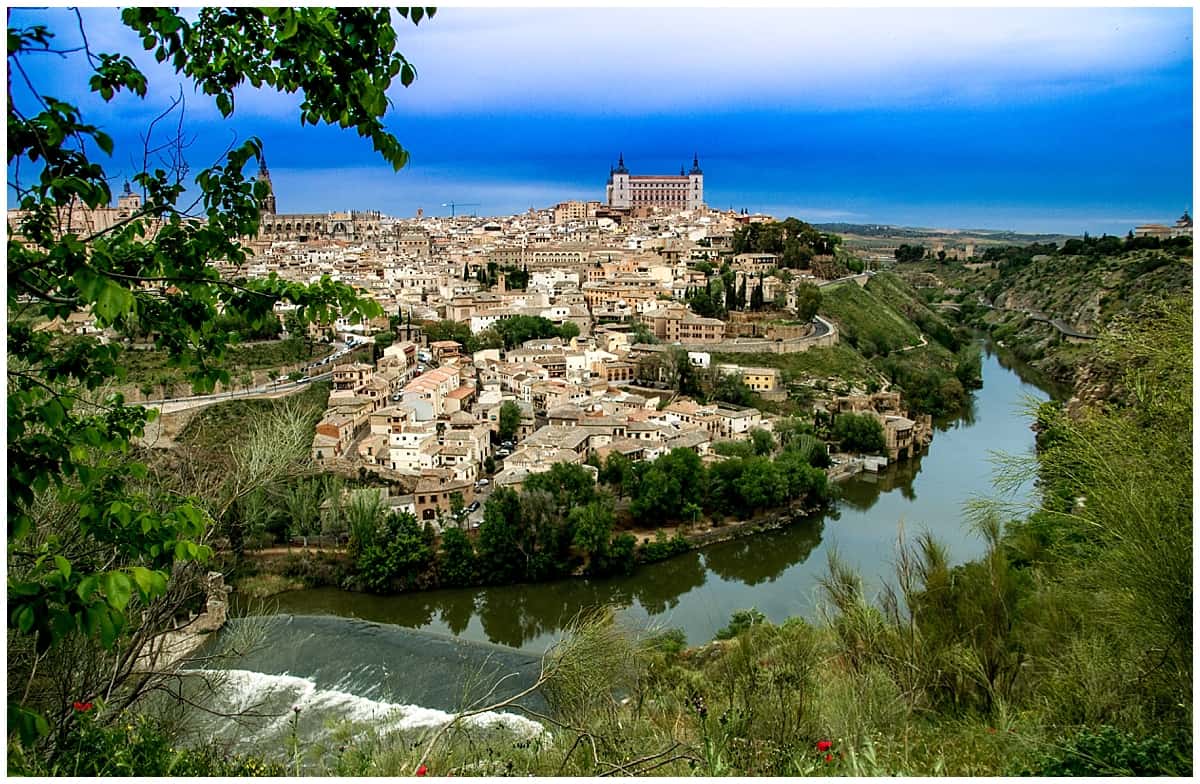
Road Trip Through Central Spain
Treat yourself to a literary, gastronomic and thoroughly authentic journey through this central part of Spain, the region of Castilla La Mancha. It’s one of the best road trips in Spain for hidden gems and a sense of exploration.
Take in Toledo, the former capital and UNESCO World Heritage Site. Search the hills for the windmills made famous by Don Quixote. Hike through one of the best bird reserves in the country. And relish taking your time amid small Spanish villages, far from the crowds.
Road Trip Through Central Spain at a Glance
- Day 1: Arrive Madrid
- Day 2: Madrid
- Day 3: Madrid to Toledo
- Day 4: Toledo
- Day 5: Don Quixote Countryside
- Day 6: Hike through the Tablas de Daimiel
- Day 7: Return Madrid to fly home
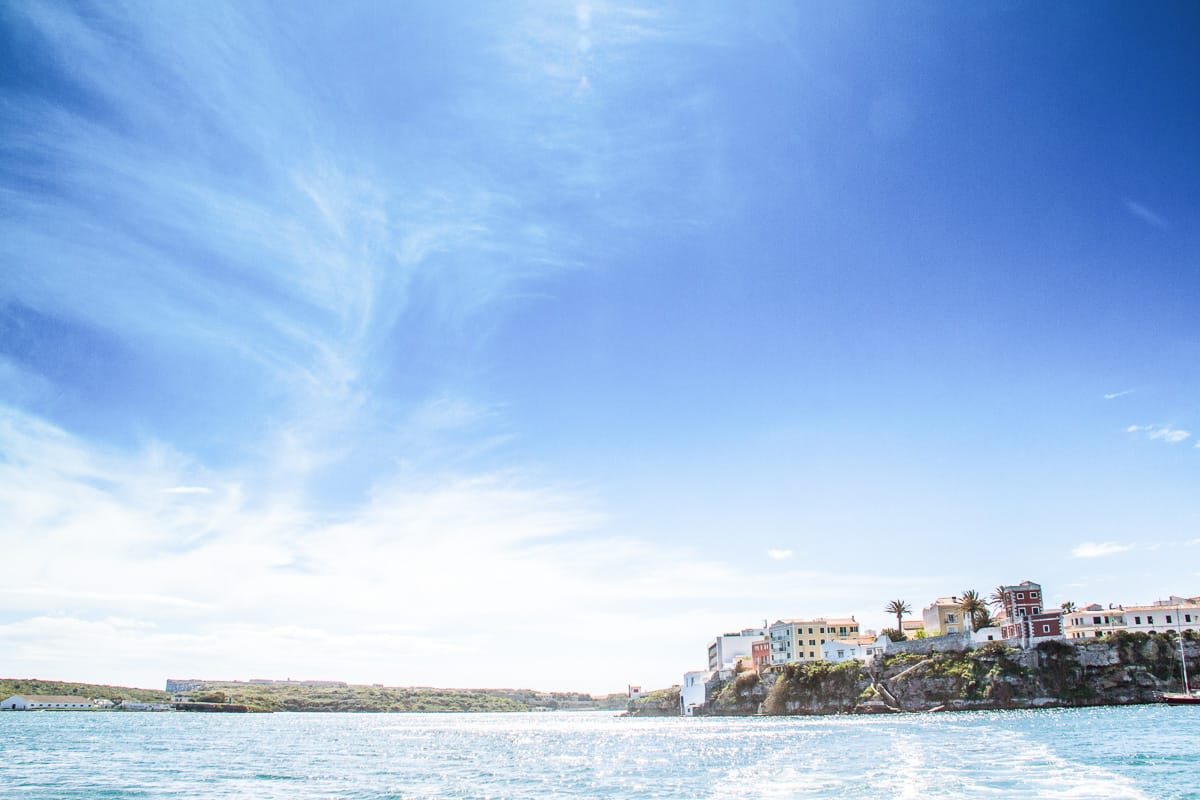
Both islands have stunning coastlines (but this place is Menorca!)
Driving the Balearic Islands
One of the best road trips in Spain involves flying to one of her smaller islands and taking a laid back approach to plans and itineraries all together. Mallorca and Menorca are the two main Balearic Islands and each has a distinctive character. Mallorca has party spots, UNESCO World Heritage and wild hiking routes. Menorca specialises more in family beaches, quiet streets, small towns and an awful lot of gin.
- Menorca or Mallorca for your Balearic Island holiday?
Set yourself up with one home base for a week and take a series of day trips to explore either island.
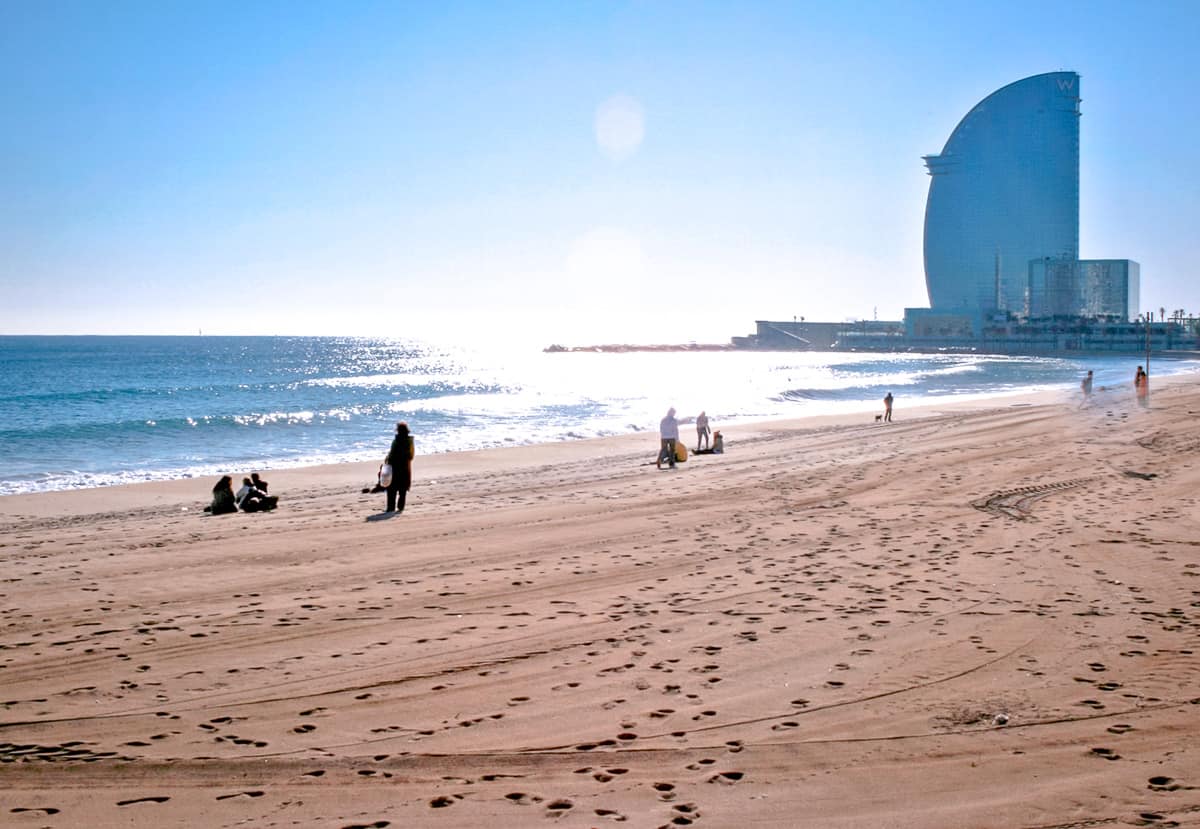
One of the best things about Barcelona is that it leads right onto a sandy beach…
Road Trip Along Spain’s East Mediterranean Coast
Drive from Barcelona to Valencia to experience two of Spain’s most interesting cities and her sparkling coastline as well. Find the Roman amphitheatre at Tarragona and the rice fields that gave us paella outside Valencia. If you have more than one week to ten days, continue south to the Moorish fortress in Amería as part of a road trip through Andalusia.
Road Trip Through the East Coast of Spain At a Glance
- Day 2: Barcelona and Girona
- Day 3: Valencia via Tarragona
- Day 5: Alicante and the Costa Blanca
- Day 6: Almeria and Cabo de Gata
- Day 7: Back to Barcelona to fly home (or to Malaga)
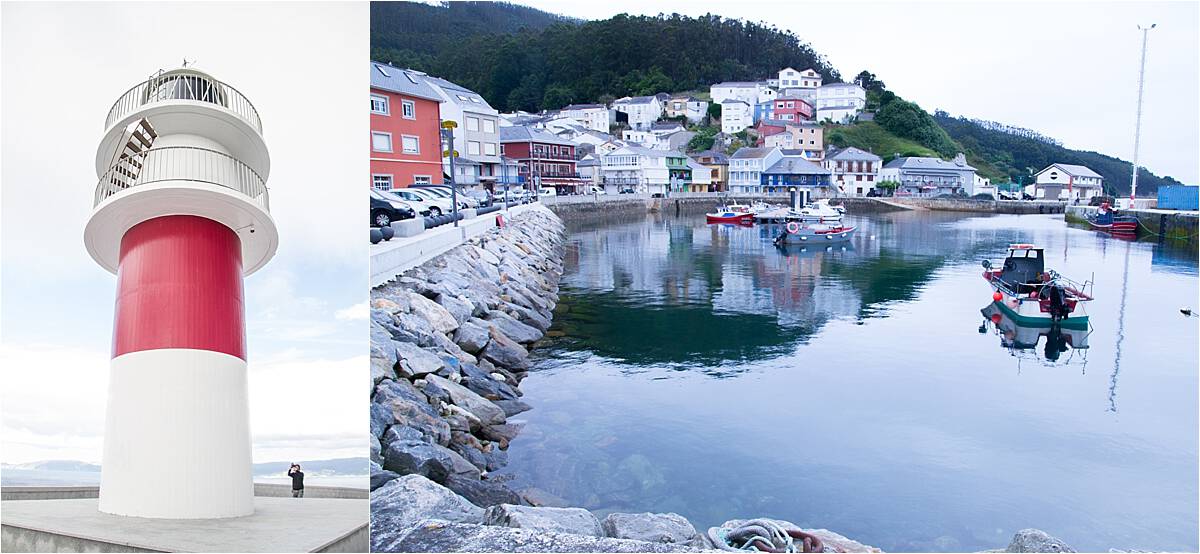
Road Trip Across Galicia
Decked out in deep green hues and bursting with salty seafood, a road trip through Galicia provides a completely different experience of Spain.
With a coastline more reminiscent of the rugged, craggy inlets of Ireland than the white sand of the south, it’s no surprise that Galicia offers seafood to make even the uncertain smile. Expect lighthouses, green fields, great walking routes and great food.
- A Galicia Road Trip: Northern Spain’s Rugged Green Coast
Road Trip Around Galicia at a Glance
- Day 1: Arrive La Coruña
- Day 2: Pontedeume and Redes
- Day 3: Porto do Barqueiro & Viveiro
- Day 4: Praia das Catedrais
- Day 5: Torre de Hercules Lighthouse & home
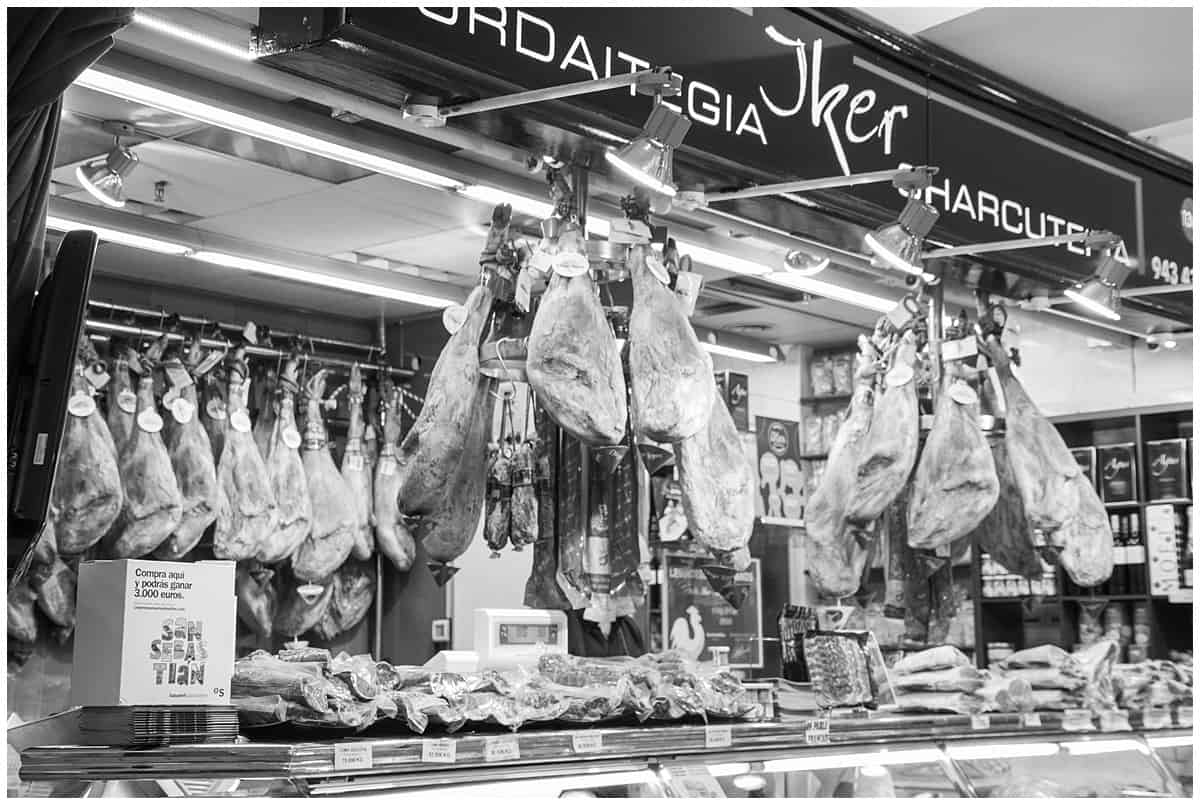
Road Trip Around the Basque Country
Link up San Sebastián, Bilbao and Santander for an epic road trip through Spain’s Basque country. Taste arguably the best food in the country in the pintxos bars in San Seb and take in the curls and swirls of the Guggenheim in Bilbao.
Add in secluded coastal curves and surprise museums, like the Balenciaga museum in Getaria , and you will find yourself with an unforgettable Spanish Road Trip.
Road Trip Through the Basque Country at a Glance
- Day 1: Arrive Bilbao
- Day 2: Bilbao
- Day 3: Bilbao to Logroño via Pamplona
- Day 4: Logroño to San Sebastian
- Day 5: San Sebastian
- Day 6: Hiking in Getaria
- Day 7: Back to Bilbao to fly home
What to know if you travel Spain by car
Cars drive on the right and you’ll need a full and valid driving license.
Tips for Spain Road Trip Itineraries
If you book through these links, we may earn a small commission at no extra cost to you. Cheers!
Typically, it’s best to pick up a vehicle at at the airport unless you have your heart set on exploring an historic city centre first. Bring your full driving license and book in advance. I’d highly recommend booking your car rental through Hertz.
Planning in Detail
I rely on the AA Route Planner to give me times and directions in Spain. Make sure you check for:
- Tolls (or factor them into your budget anyway)
What You Need to Drive in Spain
For a robust rundown of what you need to drive in Spain head to the Government website . From here you can check the latest recommendations and legal requirements, including information on an international driving permit.
Booking Hotels
Many smaller, boutique hotels in the centre of cities will not have parking options. It’s best to either park on the outskirts of town and walk in (in some places, such as Seville, taxis will struggle to get in as well) or if that’s too difficult for you then book a hotel on the outskirts of town and use their transport to travel in.
Highlights of Driving in Spain
Travel Spain by car and you’ll find all the following benefits.
While the big cities can get the pulse racing, for the most part, driving in Spain is a beautiful experience. Here are five reasons why:
1) THE ROADS ARE EMPTY
Outside the main cities that is. Gleaming wide main roads covered with smooth tarmac are the rule rather than the exception. Drive from Granada to Seville or Segovia to Merida and you’ll hardly see another car for miles.
2) THE SCENERY IS STUNNING
Low swirling mist rising over olive groves, intense sunshine hugging the contours of rust-red rock. Sparkling coastlines and white-washed towns with church towers spiking out of scorched plains. The green cloaked mountains of Galicia, the almond-scented mountains of Alpujarras and the Catalan curves of the eastern Pyrenees. Unlike driving in some countries, these views are visible from the windscreen of the car – you don’t have to wait until you park and get away from the roads.
3) GIANT BULLS ON THE HORIZON
Not real ones, of course. But building-sized, black, one-dimensional bull cutouts. Apparently, these first appeared as part of an advertising campaign for sherry. They were due to be removed until people clamoured for them to stay. Now, they add to the fun, as you never quite know when the next one will appear.
4) FRESH TAPAS AT SERVICE STATIONS
Forget about crisps, biscuits and overpriced coffee. Most petrol stations along the road in Spain are family run affairs with a chef on site. Coffee costs less than a euro while a plateful of patatas bravas, chocos, gambas or more is only a few minutes away. And if you’re feeling too hot? Try refreshing gazpacho instead.
5) FREEDOM AND GETTING OFF THE BEATEN TRACK
For reasons I’ll never quite understand, Spain has a reputation as a sand-and-sea destination and that’s about it. Visitors tend to cling to the coast and never realise just what they’re missing. Hiring a car and hitting the roads is the first step towards fixing that. Stop off in one of Andalucia’s pueblos blancos, for example, and you’ll probably be the only foreigner in town.
And that’s just for starters.
What is the best way to travel across Spain? Road trip or by train?
Great question. And the answer is: it depends.
Driving through Spain is an absolute joy, once you are out of the cities. Road tripping through Spain allows you to reach hidden villages and hike through unspoilt landscapes. It also makes life much easier if you are travelling with your children.
If you mainly wish to city hop between the big cities like Madrid, Barcelona and Seville, then the train is the better option. If you want to get off the beaten track and explore, go for a road trip.
Tools & Planners for the Best Road Trips in Spain
You’re in road trip heaven here, as we have everything from a full list of road trip essentials to the Ultimate Road Trip Planner for people who love freedom and hate spreadsheets.
And just for fun, we have the best road trip quotes and some road trip questions and games to help everyone get along.
Also, check out our road trip planning series on YouTube:
- The 5 biggest road trip planning mistakes people make (and how to fix them)
- The 7 best road trip planning tools.
1 thought on “The Best Road Trips in Spain and Their Self-Drive Itineraries”
The scenery is stunning indeed. I didn’t have to go driving to notice that. It’s wonderful!
Comments are closed.

The Ultimate Spain Road Trip Itineraries: Routes, Sights, Guides, Maps And More
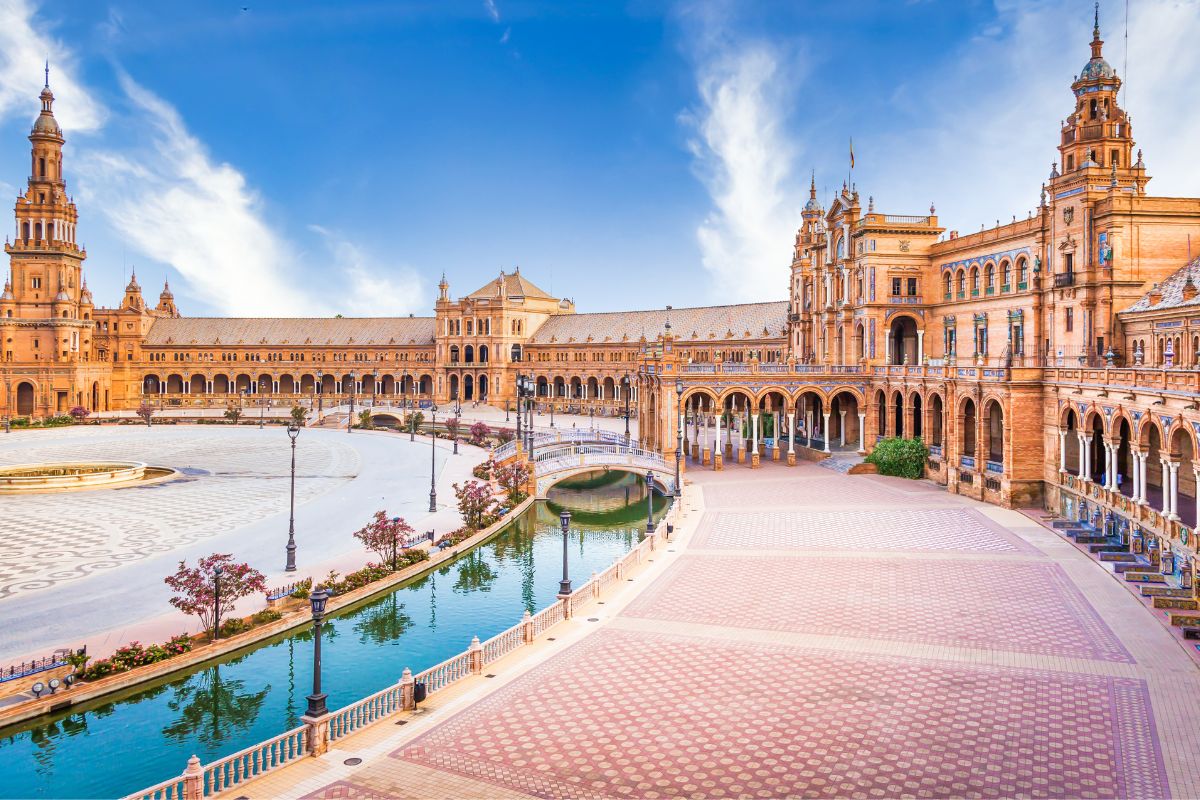
From San Sebastian’s world-famous food scene and the attractions of Barcelona, to the incredible museums of Madrid, history of Granada and beaches on the Costa del Sol, this Spain road trip has it all!
Road tripping past perfect beaches, huge mountains and ancient monuments sounds like a pretty perfect holiday doesn’t it? If you’ve dreamed of exploring Spain, this guide is guaranteed to help you plan your trip.
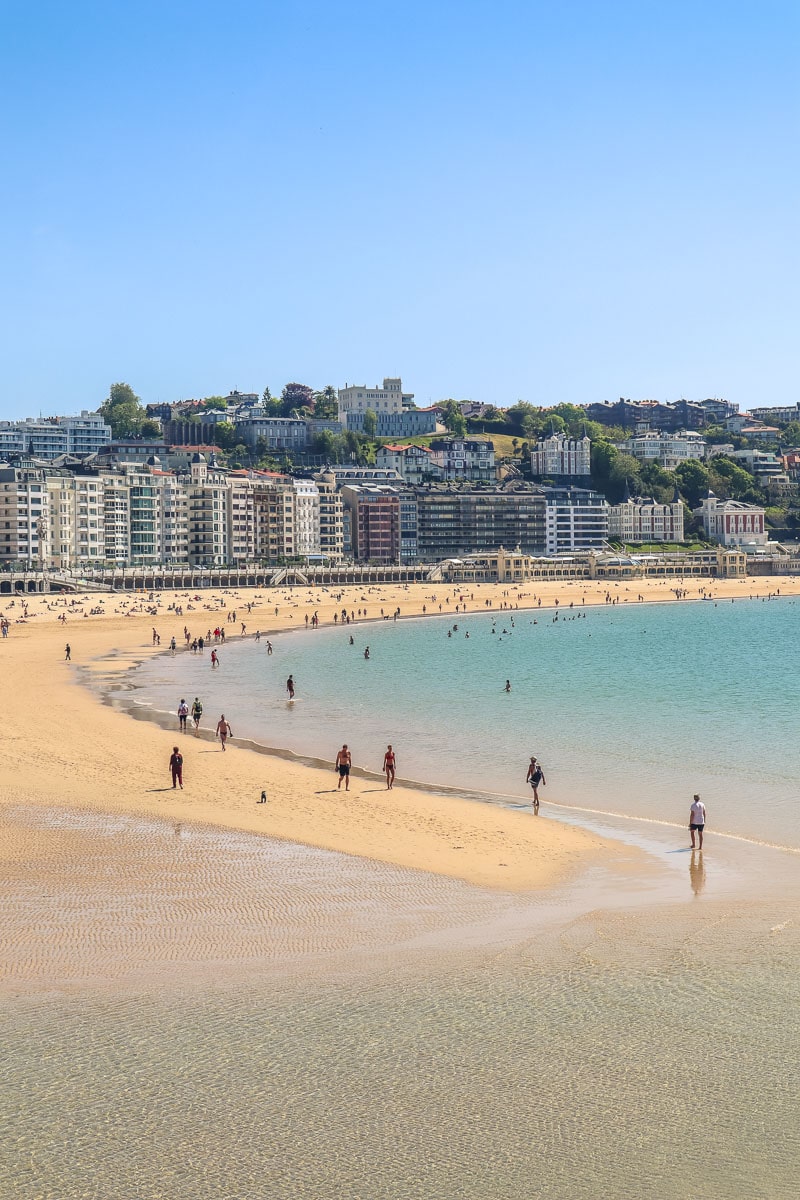
It’s the country I’ve visited the most in the world. Why does it keep me coming back for more? Because it’s so varied. I love the fact that you can spend mornings exploring pretty Medieval cities, lunchtimes feasting on plates of tapas, afternoons on the beach and evenings enjoying the nightlife.
In the south of Spain you can even ski in the morning in Sierra Nevada and then hit the beach on the Costa del Sol in the afternoon – how amazing is that?
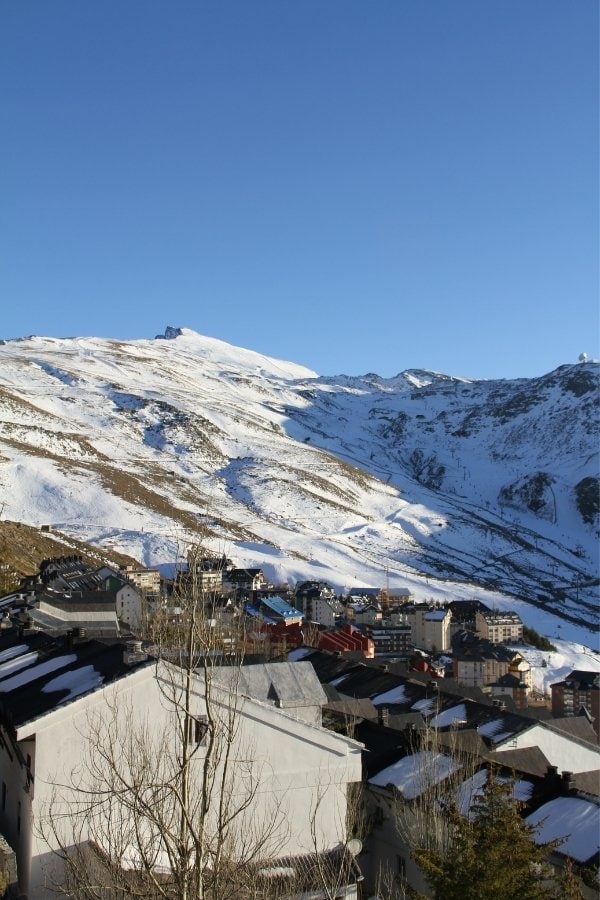
Whether you’re interested in art, architecture, history, food or fashion, a trip to Spain will no doubt appeal.
If you’re interested in art, you’ll enjoy visiting Barcelona’s Picasso and Miro Galleries, the architectural wonder that is Bilbao’s Guggenheim Museum, Madrid’s impressive art collection at the Prado Museum and the modern artworks in Malaga’s Pompidou Centre.
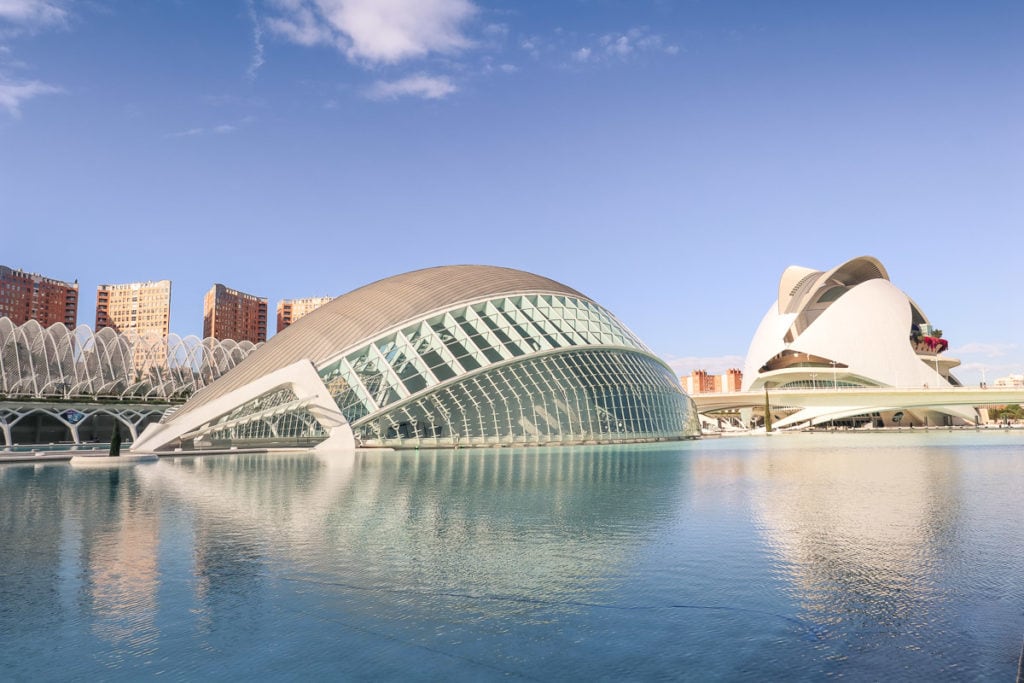
If you enjoy the great outdoors there are plenty of beautiful landscapes in Spain . You could hike in Ordesa y Monte Perdido National Park in the north, explore Valencia’s Turia Gardens, explore Murcia’s weird and wonderful sandstone wonders at Bolnuevo or even ski in Sierra Nevada.
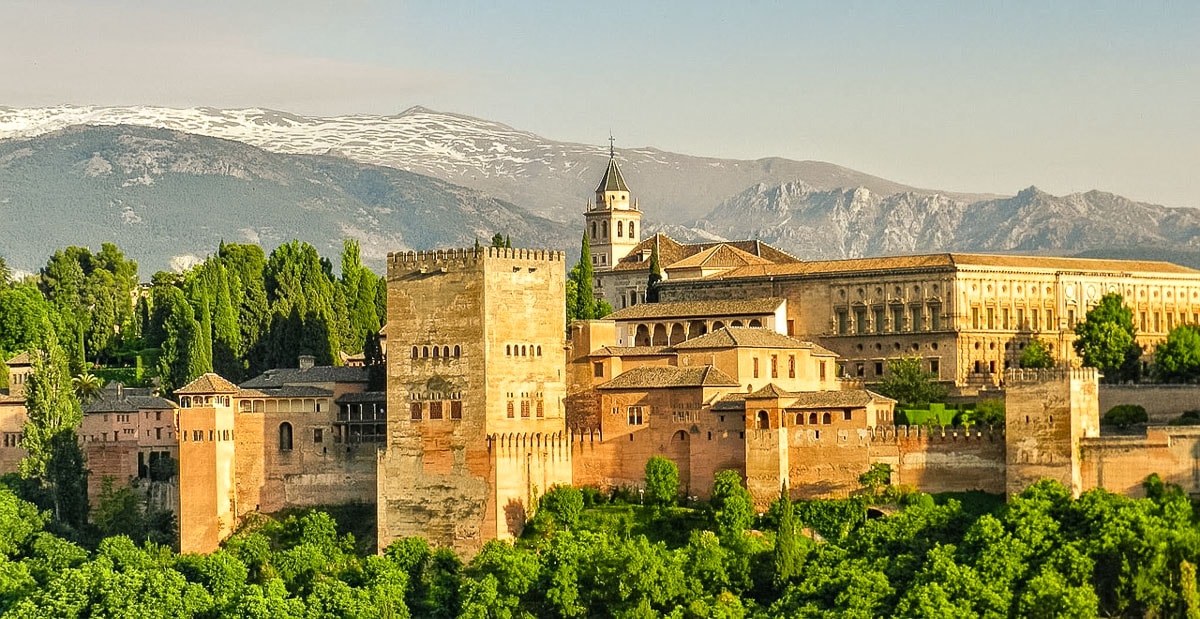
I’m a firm believer that the best way to get to know a country is through its cuisine, and in Spain, you’re in for a treat! San Sebastian in the Basque Country has the most Michelin-starred eateries per capita in Europe. There’s a great culture across this region for pintxos – small dishes often showcasing local ingredients.
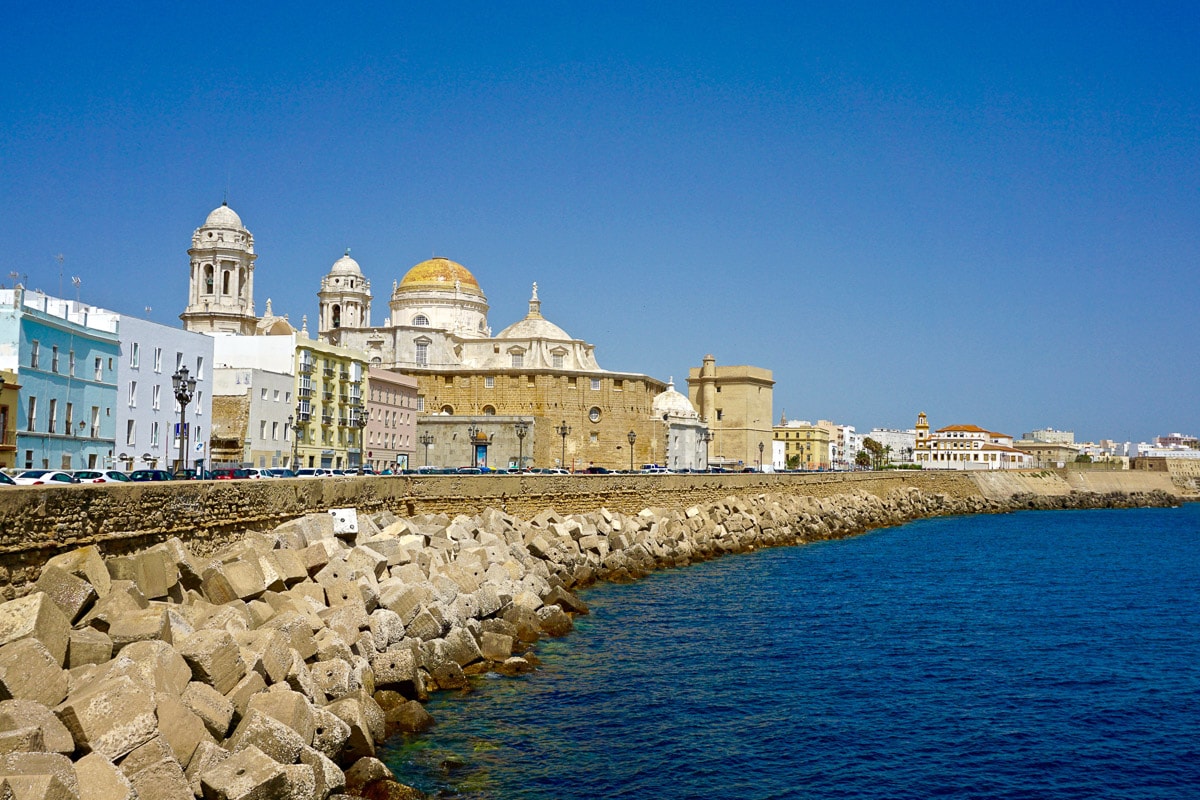
Head south and you’ll enjoy plates and plates of delicious tapas. From Spanish hams and cheeses, to griddled peppers, calamari and fresh fish, there’s so much to taste along the way,
And the best part about a Spain road trip? The freedom! You don’t have to stick to the obvious routes. I’d 100% encourage veering off course from time to time.
Often it’s when you decide to travel slowly and go off the beaten track, you start stumbling across hidden gems. You’ll take a wrong turning and end up in an authentic Spanish town that isn’t in any of the tourist guide books!
Spain is often associated with summer beach holidays, but it’s worth remembering that many of the interior parts of the country offer just as much natural beauty, with vineyards, mountains, canyons, olive groves and whitewashed towns.
So, rather than create one epic Spain road trip, I’m diving it in tow: a northern Spain road trip and a southern Spain road trip . That way you can just pick one and break the country up into manageable chunks. If you’ve got a while, then simply join the two up and continue on from Salamanca to Madrid.
Click through to take a look at each itinerary, and figure out which one is right for you…
The Ultimate Spain Road Trip Itinerary
From sampling some of the best Spanish food in the Basque Country and enjoying the vibrant colours of Barcelona, to visiting the Alhambra in Granada and relaxing on the beautiful beaches on the Costa del Sol, it's time to plan the ultimate Spain road trip!
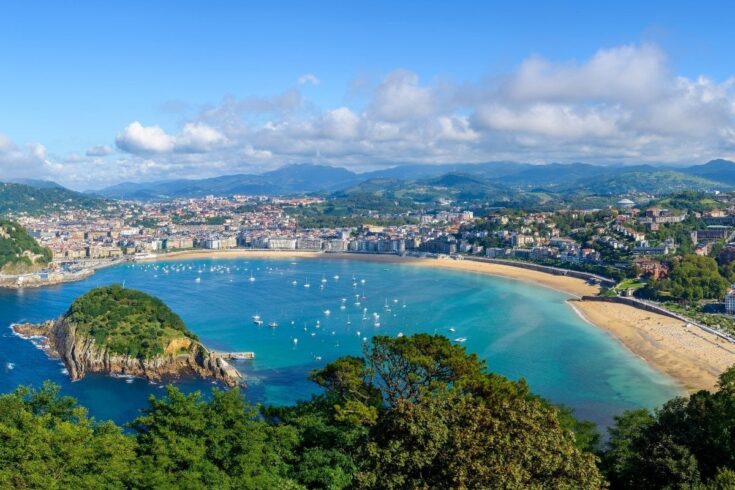
The Ultimate Northern Spain Road Trip: Routes, Sights, Guides, Maps And More
From Catalonia’s unspoilt coastline and Aragon’s scenic architecture to quaint cities in the Basque Country, this northern Spain road trip offers something for everyone.
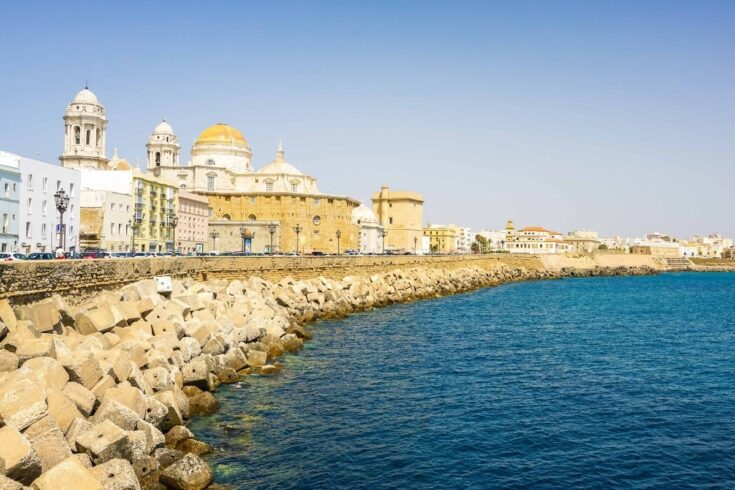
The Ultimate Southern Spain Road Trip: Routes, Sights, Guides, Maps And More
From the historic cities of Seville and Cordoba, to the natural beauty of Ronda and the spectacular beaches of Cadiz and Valencia, this southern Spain road trip offers something for everyone.
When Is The Best Time To Visit Spain?
You might think that Spain has a Mediterranean climate, but that’s only true for the southern parts of the country. Spain’s location and geography means that the north has a cooler climate and the east around Murcia has a more arid climate. Obviously the mountainous areas in the Pyrenees and Sierra Nevada are completely different too.
Temperatures vary greatly by region, but as a quick example, you can expect temperatures as low as -10 in around Sierra Nevada (in the mountains near Granada) in January, and as high as 40°C in July in cities such as Seville. Temperatures in the south remain mild in winter, making destinations along the Costa del Sol including Malaga and Marbella, great options for a winter holiday.
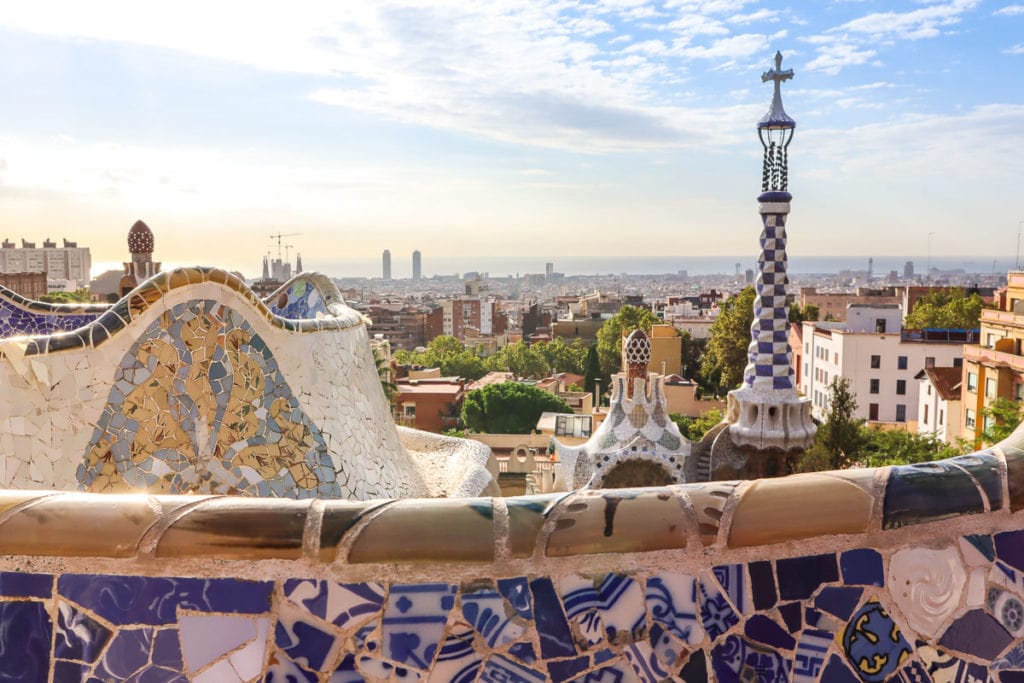
If you’re wondering when is the best time to visit Spain, I’d suggest planning a trip between April and June, or between September and October, just after the peak summer season.
The weather tends to be consistent in these months and you’ll skip the peak season so should benefit from lower prices and fewer people.
What to pack for your road trip
If you’re wondering what to pack for your trip, this guide to road trip essentials has you covered. From portable chargers to ways to stay entertained on long journeys, it’ll help you create your road trip packing list.
I hope you’ve enjoyed checking out my Spain road trip itineraries. Let me know where you decide to go and what your highlights are!
Chloe Gunning
With a passion for food, fun and adventure, Chloe is the content creator behind one of the UK's top travel blogs Wanderlust Chloe. From volcano boarding in Nicaragua, to sailing around Sicily and eating her way around Japan, her travels have taken her to some of the coolest spots on the planet. Named Travel Influencer of the Year in 2022, Chloe regularly works with a number of tourism boards, producing inspirational travel content across multiple platforms. Find out more about Chloe here.
Leave a comment Cancel reply
Travel Safe
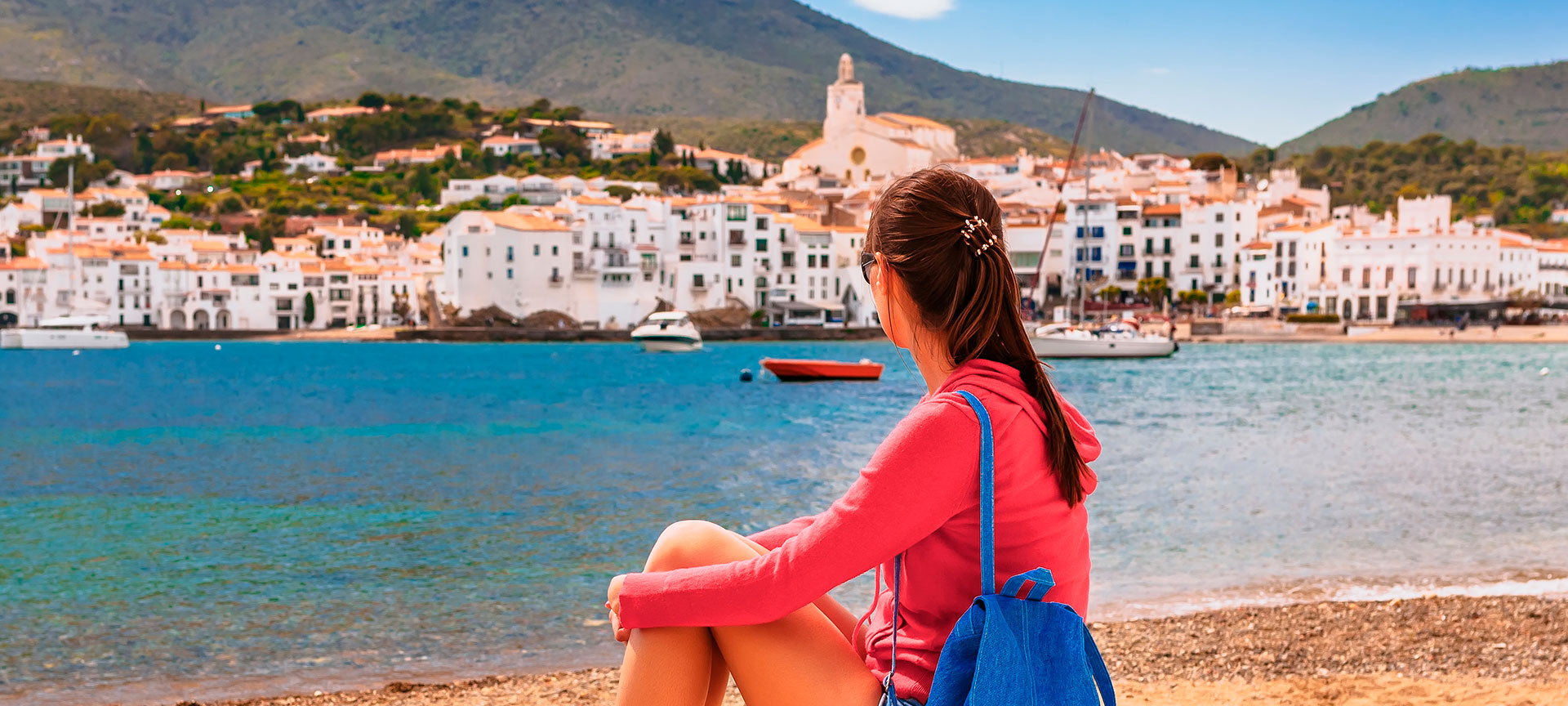
A road trip along Spain’s east coast
On the shores of the Mediterranean
A road trip along Spain’s Mediterranean coast is a guarantee of sunshine, lovely beaches, and plenty of destinations with things to see and do. We suggest following the coastline at your own pace, without a fixed timetable and with room to improvise. We provide some tips on what to see along the way, so you can plan your route to suit your tastes. Let yourself feel the freedom of the open road and take the Mediterranean road trip of a lifetime. The route we suggest runs from Barcelona to Cabo de Gata (in the southern province of Almería, Andalusia), mainly on the Mediterranean motorways (A-7, AP-7) with short trips on side roads to enjoy the scenery or to do some sightseeing.
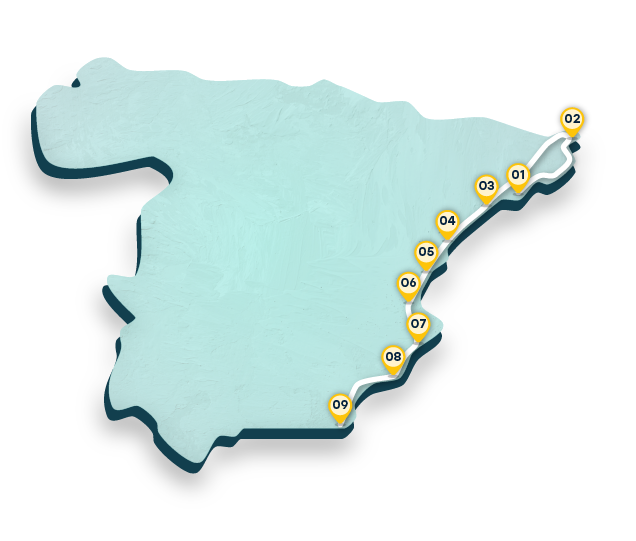
Step 1: From Barcelona to the Costa Brava: northbound
We choose barcelona as a starting point because it’s a huge transport hub. a good idea might be to head north for a couple of days to see the costa brava (girona)..
Distance:310km Journey: By car / Duration: 2 days
- Barcelona – Roses: around 160 kilometres.
- Roses – Cadaqués: around 20 kilometres.
- Cadaqués – Platja d’Aro: around 100 kilometres.
- Tossa de Mar – Sant Feliu de Guíxols: around 20 kilometres.
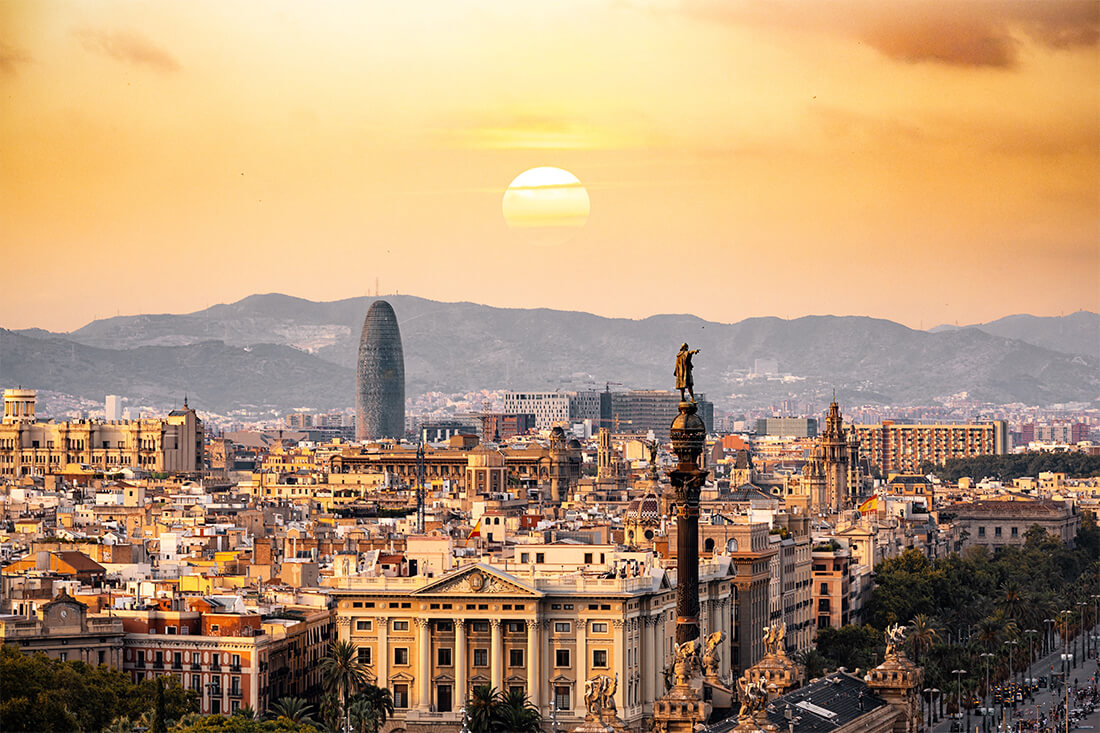
Step 2: From Barcelona to the Costa Daurada and Terres de l’Ebre: southbound
A road for lovers of hairpin bends and cliff-top views, the c-31 runs from castelldefels to sitges . its proximity to the coast means fantastic views are guaranteed, but remember to drive very carefully..
Distance:240km Journey: By car
- Barcelona – Sitges: around 40 kilometres.
- Sitges – Tarragona: around 75 kilometres.
- Tarragona – Salou: around 15 kilometres.
- Salou – Reus: around 10 kilometres.
- Salou – Delta de l’Ebre Natural Park: around 75 kilometres.
- Delta de l’Ebre Natural Park – Sant Carles de la Rápita: around 25 kilometres.
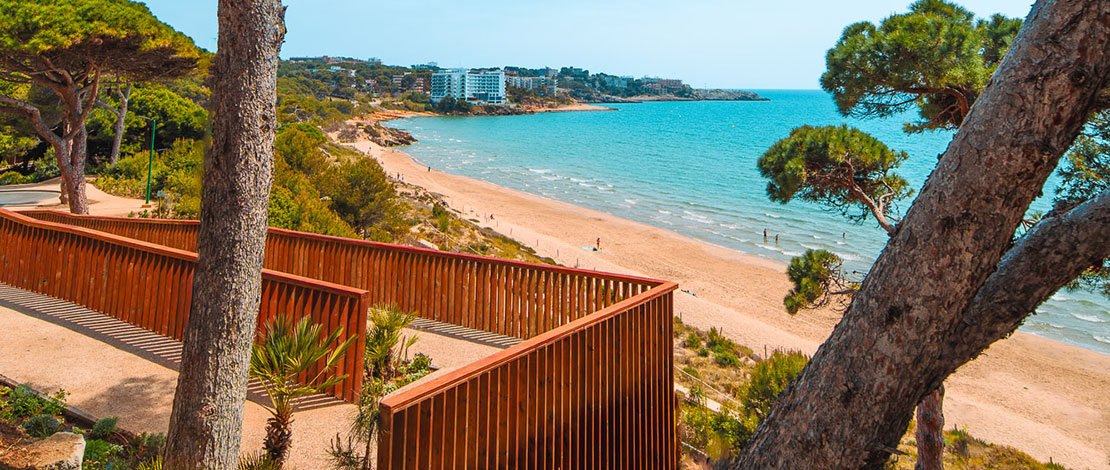
Step 3: The Valencian coast
The route southwards brings you to the land of the paella, the region of valencia. as well as enjoying the delicious food (paella or any other of the many local dishes), you’ll find many places to stop along the valencian coast..
Distance:240km
- Sant Carles de la Rápita – Peñíscola: around 50 kilometres.
- Peñíscola – Alcossebre: around 30 kilometres.
- Peñíscola – Morella: around 75 kilometres.
- Alcossebre – Oropesa: around 30 kilometres.
- Oropesa – Benicassim: around 15 kilometres.
- Benicàssim – Castellón de la Plana: around 20 kilometres.
- Castellón de la Plana – Vilafamés: around 20 kilometres.

Step 4: In and around the city of Valencia
Valencia is the second largest city on the east coast of spain, after barcelona. you should reserve at least a day to see it, explore its city of arts and sciences and its medieval quarter, and enjoy a paella beside the sea. .
Distance:305km
- Castellón de la Plana – Valencia: around 70 kilometres.
- Valencia – Sagunto: around 35 kilometres north.
- Valencia – Segorbe: around 60 kilometres.
- Segorbe – Rubielos de Mora: around 60 kilometres.
- Valencia – Cullera: around 50 kilometres.
- Cullera – Gandía: around 30 kilometres.
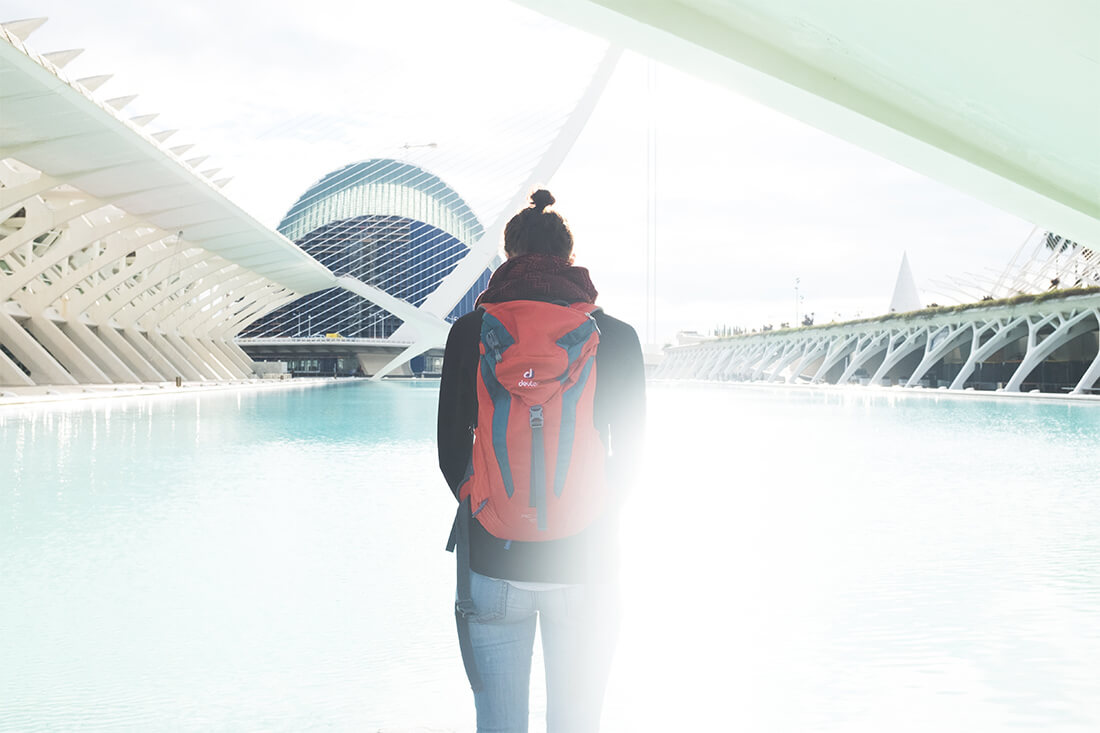
Step 5: The Costa Blanca, Alicante
The ap-7 motorway brings you to the famous costa blanca . the coast here is studded with fishing villages of whitewashed houses and lovely beaches, with plenty of beautiful views to take photos of. .
Distance:225km
- Valencia – Dénia: around 100 kilometres.
- Dénia – Jávea: around 10 kilometres.
- Dénia – Altea: around 45 kilometres.
- Altea – Alicante: around 60 kilometres.
- Alicante – Elche: around 25 kilometres.
- Alicante – Torrevieja: around 50 kilometres.
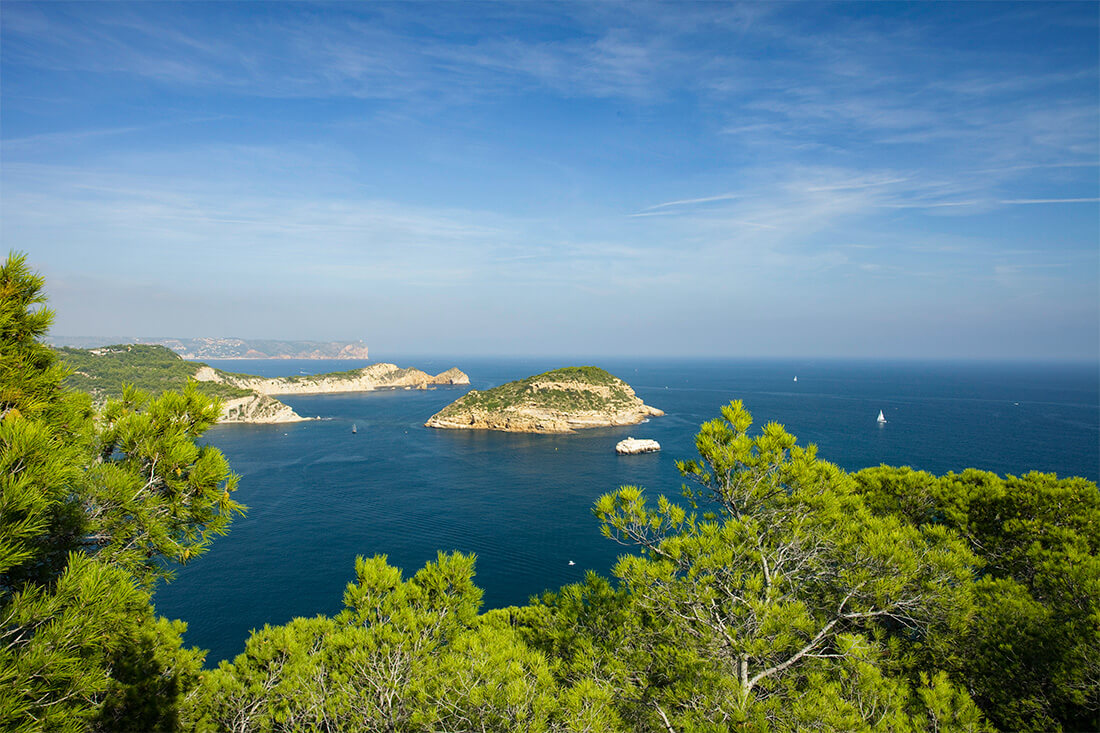
Step 6: Costa Cálida, in the Region of Murcia
Our mediterranean road trip now takes us to the coast of the region of murcia, known as the costa cálida and notable for its family-friendly beaches..
Distance:220km
- Torrevieja – San Pedro del Pinatar: around 25 kilometres.
- San Pedro del Pinatar – Cabo de Palos: around 50 kilometres.
- Cabo de Palos – Calblanque Beach: around 10 kilometres.
- Cabo de Palos – Cartagena: around 40 kilometres.
- Cartagena – La Unión: around 15 kilometres.
- Cartagena – Mazarrón: around 40 kilometres.
- Mazarrón – Águilas: around 40 kilometres.
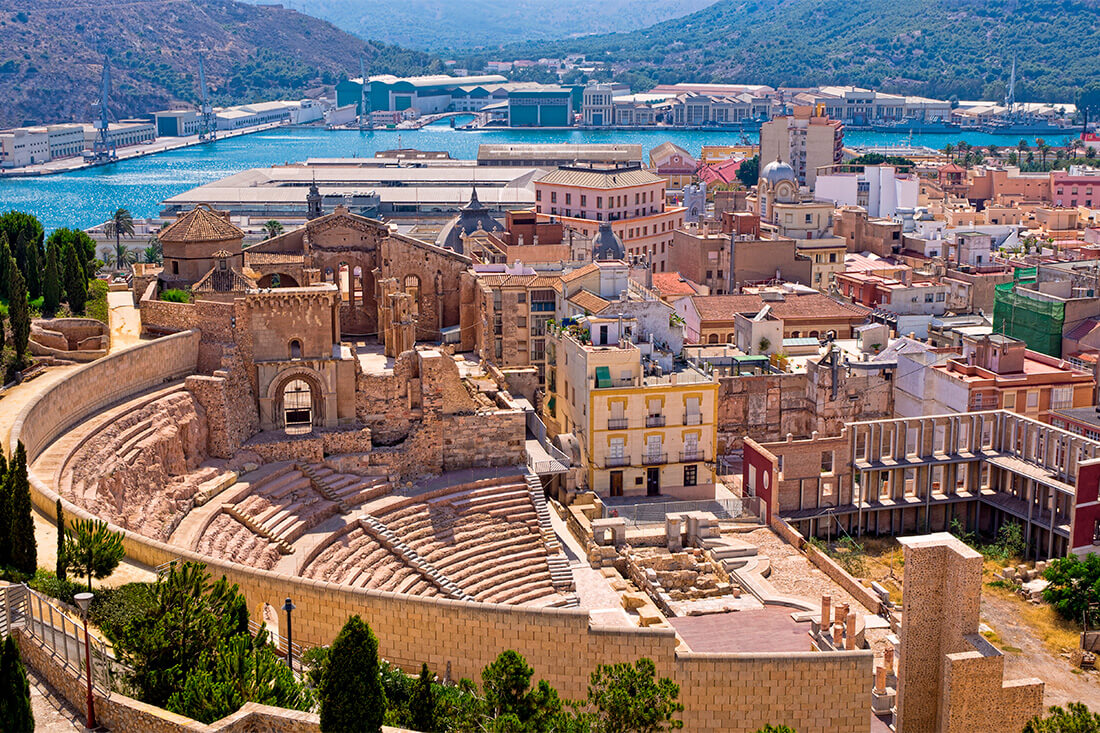
Step 7: Almería and Cabo de Gata
Our coastal road trip now comes to almería province, in andalusia. here the coast is full of secluded little coves, surrounded by desert landscapes. destinations like mojácar , níjar, carboneras, and cabo de gata-níjar natural park all have fantastic beaches. .
Distance:185km
- Águilas – Mojácar: around 65 kilometres.
- Mójacar – Níjar and Cabo de Gata beaches: around 60 kilometres.
- Cabo de Gata – Tabernas: around 60 kilometres.
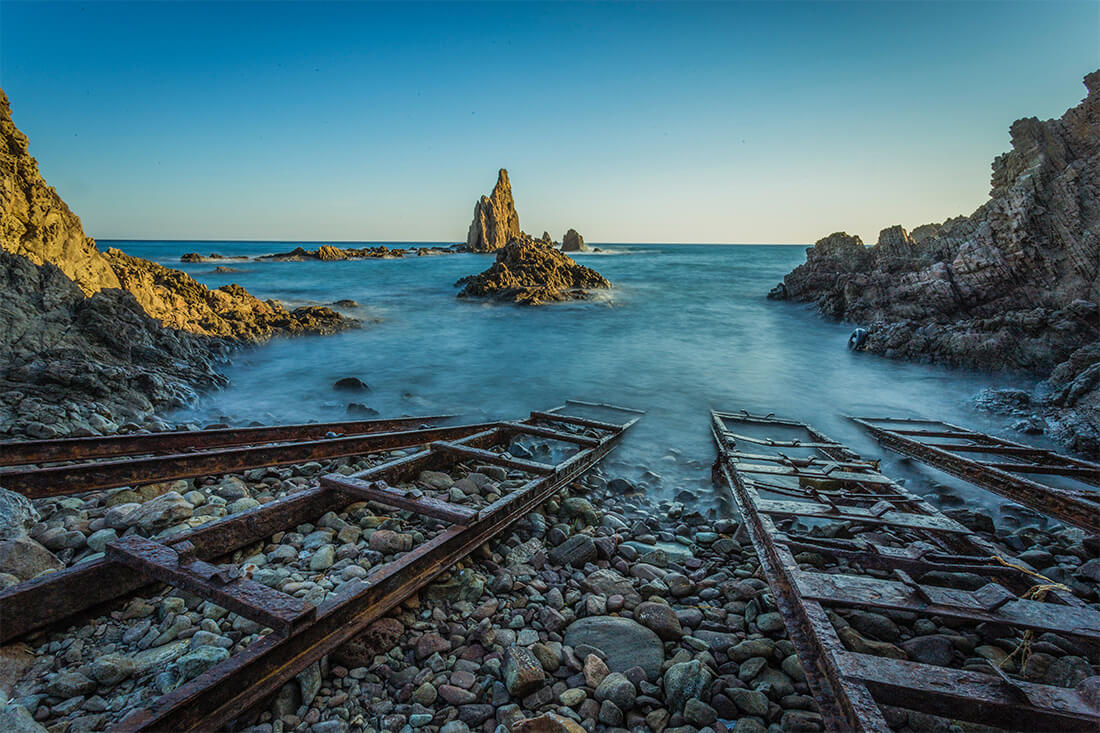
Travel plans for inspiring you

Five great road trips through Catalonia
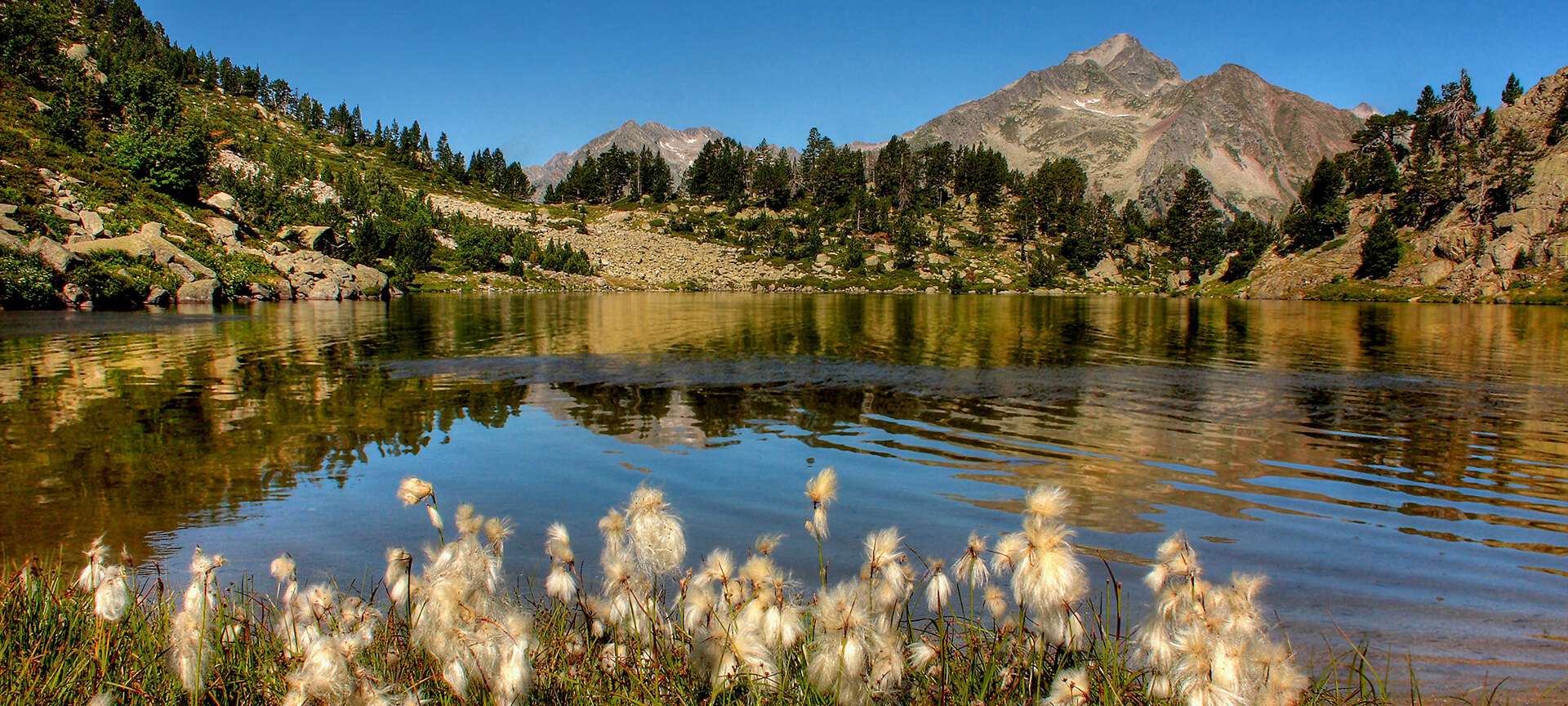
Routes along the Catalan coast and Pyrenees

Switch yourself on: 10 ideas for travelling with friends and getting back to normal

Choose between thousands of activities to live your best life on holiday.
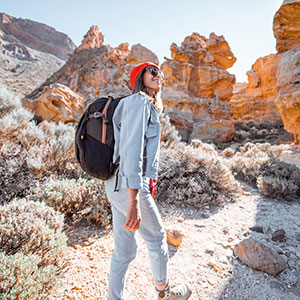
855-997-4652 Login Try a Free Class
A Vocabulary Guide to Roads and Traffic in Spanish
Get ready to take a road trip with this awesome guide to roads in Spanish!
Become your friend group’s guide with all these words and phrases about roads and traffic in Spanish and make the best out of your upcoming adventures.
Driving Vocabulary
Whether you drive within your city or you plan a cross-country trip, this driving vocabulary is a must when talking about roads and traffic in Spanish!
Example Sentences in Spanish
Asegúrate de revisar el carro antes del viaje. Be sure to check the car before the trip.
El conductor debe estar atento al camino. The driver must be aware of the road ahead.
Revisa la fecha de vencimiento de tu licencia de conducir. Check the expiration date of your driver’s license.
Utiliza los pidevías antes de cada cruce. Use the turn signals before each turn.
Driving Verbs in Spanish
Here are some useful verbs to make your way along the roads in Spanish!
To Accelerate – Acelerar
Acelera el auto cuando la carretera esté libre. Accelerate the car when the road is clear.
To Brake – Frenar
Frenar de golpe es peligroso. Hitting the breaks all of a sudden is dangerous.
To Change Lanes – Cambiarse de carril
Utiliza el retrovisor antes de cambiarte de carril. Use your rearview mirror before changing lanes.
To Cross the Street – Cruzar la calle
Mira hacia ambos lados antes de cruzar la calle. Glance both ways before crossing the street.
To Decelerate – Desacelerar
Desacelera con cuidado en el semáforo. Decelerate carefully at the stoplight.
To Drive – Manejar
Sé cuidadoso al manejar en carretera, por favor. Be careful when driving along the road, please.
To Drive By – Pasar por
Pasé por un pueblo hermoso durante mi viaje. I drove by a beautiful small town during my trip.
To Have the Right of Way – Llevar la vía
Siempre debes saber si llevas la vía. You should always know if you have the right of way.
To Honk – Bocinar
Bocinar es útil para advertir a otros conductores. Honking is useful to warn other drivers.
To Pull Over – Orillarse
Debes orillar el auto si el motor falla. You should pull over if your engine fails.
To Slow Down – Reducir la velocidad
Reduce la velocidad en los pasos peatonales. Slow down at crosswalks.
To Speed Up – Aumentar la velocidad
Aumenta la velocidad si vas en el carril izquierdo. Speed up if you’re in the left lane.
To Stop – Detenerse
Siempre debes detenerte ante un semáforo en rojo. You always have to stop before a red light.
To Swerve – Cruzar abruptamente
Cruzar abruptamente es peligroso. Swerving is dangerous.
Basic Road Vocabulary
Make the best out of your trips with your Spanish speaking friends by using these words about roads in Spanish!
Revisa el mapa; no queremos llegar a un callejón sin salida. Check the map; we don’t want to end up in a dead-end.
Mantén tu carril para evitar accidentes. Stay in your lane to avoid accidents.
No conozco las carreteras de Guatemala. I’m not familiar with Guatemala’s roads.
No excedas el límite de velocidad, puede ser peligroso. Don’t go over the speed limit, it might be dangerous.
Naming the Roads in Spanish
When I think of big countries like the United States, I can only think of the tons of long road trips I would like to take. Knowing how to refer to the roads—small or big—is important to make the best of your travels!
Here are the names of the different types of roads in Spanish!
Country Roads
Las carreteras rurales tienen paisajes increíbles. Country roads have incredible landscapes.
Maneja con cuidado en las carreteras de terracería. Drive carefully along the dirt roads.
Identifica las rampas de emergencia cuando manejes. Spot the off-ramps when you’re driving.
Siempre debes detenerte antes de un cruce de ferrocarril. You should always stop before a railroad crossing.
Be an expert traveler! See also: Useful Travel Phrases in Spanish: Listen and Practice!
Small Town Roads
Small towns have an undeniable charm. Be sure to find your way the next time you drive along their roads with these words in Spanish!
Ten cuidado en las encrucijadas. ¡Los autos vienen de todos lados! Be careful at crossroads. Cars are coming everywhere!
¡El peatón cruzó la calle y tuve que frenar de golpe! The pedestrian crossed the street and I had to brake suddenly!
Cuando estás en un redondel, siempre llevas la vía. When you’re on a roundabout, you always have the right of way.
Las bandas de frenado evitaron el accidente. Speed bumps avoided the accident.
Long-Distance Roads
Ese puente parece eterno. ¡Es muy largo! That bridge seems endless. It’s so long!
Me encanta manejar en la autopista. I love driving along the highway.
Mañana debo manejar una larga distancia; tendré que usar la interestatal. I have to drive a long distance tomorrow; I’ll have to take the interstate.
Traffic Signs in Spanish
Road safety is a life-saving subject! Be sure you know what the traffic signs in Spanish mean !
Cuando hay señales de construcción, las carreteras pueden estar bloqueadas. Whenever there are construction signs, roads might be blocked.
No ignores las señales de guía. ¡Podrías perderte! Don’t ignore the guide signs. You might get lost!
Ignorar las señales reguladoras puede costarte una multa. Ignoring the regulatory signs can cost you a ticket.
Ese semáforo no funciona. ¿Cómo sabemos cuándo cruzar? That traffic light is not working. How will we know when to cross?
Guide Signs
La señal de distancia de destino te ayuda a saber si estás cerca de tu destino. The destination distance sign helps you to know if you’re close to your destination.
Toma precauciones en el cruce de carreteras. Take your precautions at the roadway junction.
Regulatory Signs
PRO TIP: Add la señal de before mentioning any of these signs.
La señal dice “no estacionarse.” Si te estacionas, tendrás una multa. The sign says “no parking.” If you park, you get a ticket.
¡Tienes el alto, cuidado! You have the stop sign, watch out!
Si no cedes el paso, podrías tener un accidente. If you don’t yield, you might have an accident.
Esta calle es de doble vía, puedes cruzar. This is a two-way street, you can turn here.
Recreation Signs
Never forget you need to rest and eat during a road trip. Hit the roads in Spanish with these awesome words!
¿Podemos hacer una parada para comer? Hay una señal de comida justo ahí. Can we make a stop to eat? There is a food sign right there.
Deberíamos buscar alojamiento. No arreglarán el auto hasta mañana. We should look for lodging. They won’t fix the car until tomorrow.
¡Mira! Un área para nadar. ¡Vamos! Look! A swimming area. Let’s go!
Warning Signs
Mira la señal de advertencia de velocidad. No te excedas del límite. Look out for the advisory speed sign. Don’t drive over the limit.
Ahí hay una señal de cruce hacia la derecha. Ya casi llegamos. There’s a right turn sign. We are almost there.
Detente en la intersección. ¡Creo que nos perdimos! Stop at the intersection. I think we’re lost!
Other Signs
If I included every existing sign in this post it’d be endless! But here are some more useful traffic signs in Spanish!
Hay muchos niños en el cruce peatonal escolar, reduce la velocidad. There are a lot of kids in the school crosswalk, slow down.
¡Esta calle es muy larga y no permiten bicicletas! This is a long street and there are no bicycles allowed!
Muchos carros circulan en esta área, por eso no se permiten peatones. Many cars drive around this area, that’s why no pedestrians are allowed.
Traffic in Spanish
Nobody likes traffic, but we’ve got to get into it! Use these words in Spanish to let your friends know you’ll be late to the party!
Hay un embotellamiento; no sé cuánto tiempo estaré aquí. There’s a bottleneck; I don’t know how long I’m going to be here.
El GPS indica que hay tráfico ligero. Deberíamos irnos ahora. The GPS says there’s light traffic. We should go now.
Hoy me pusieron una multa. ¿Puedes creerlo? I got a ticket today. Can you believe it?
Sigo en el atasco. Lo siento, no podré llegar. I’m still in the traffic jam. I’m sorry, I am not going to make it.
If you want to avoid traffic and make your trips unique, taking trains is always an option! With these words in Spanish, you’ll be ready to plan your next journey.
Compré mi boleto de tren. Sólo debo empacar y me iré. I bought my train ticket. I just have to pack and then I will leave.
Nos encontraremos en la estación de ferrocarril, ¿cierto? We will meet at the railway station, right?
Me encanta viajar en tren, es una experiencia única. I love traveling by train. It is a one-of-a-kind experience.
Travel to marvelous places. Check out: 12 Ways To Enjoy Ecotourism in Panama on Your Next Trip
Keep Up
Did you know that year by year, the number of Spanish speakers around the world and in the United States increases? Spanish is a diverse language with a fascinating history and amazing backgrounds that make it unique in each region they speak it.
Keep up with our modern world and increase your chances of traveling and having new experiences in Spanish-speaking countries by learning the language!
Our academy offers a method friendly to those with busy lives yet ambitious goals. Our one-on-one classes with native speakers guarantee to make you a fearless and natural Spanish speaker. Not only do we show you the ropes with grammar, but we give you insight on everything to know to sound natural and carefree.
Sign up for a free class today and discover how simple, fun, and effective it is to learn Spanish with us.
Join one of the 40,000 classes that we teach each month and you can experience results like these
“This is the best way for your kid to learn Spanish. It’s one-on-one, taught by native Spanish speakers, and uses a curriculum.”
– Sharon K, Parent of 3
“It’s a great way to learn Spanish, from native Spanish speakers in a 1-on-1 environment. It’s been fairly easy to schedule classes around my daughter’s other classes. The best value for us has been ordering multiple classes at a time. All the instructors have been great!”
– Cindy D, Parent of 3
“HSA offers very affordable, quality, one on one classes with a native speaker. My son has greatly benefited from taking classes. We have seen his confidence increase as well as his pronunciation improve, because he learns from a native Spanish speaker. HSA has quick, personal customer service. Our family has been very pleased with our experience so far!”
– Erica P. Parent of 1
Ready to learn more Spanish vocabulary? Check these out!
- The Most Extensive Guide Ever to House Vocabulary in Spanish
- ‘How Much Is It?’ in Spanish: A Guide to Travel and Shopping
- Familial Bonds: Expressing ‘Sister-in-Law’ in Spanish and Family Vocabulary
- 100 Easy Spanish Words for True Beginners
- Earth Day Projects for Kids + Spanish Earth Day Vocabulary
- How to Talk About the Temperature in Spanish: Fahrenheit, Celcius, and Descriptions
- Car Parts Spanish Vocabulary List: Learn Using Pictures
- Top 15 New Year’s Resolutions in Spanish
- Recent Posts
- Christmas Songs and Vocabulary for Kids in Spanish - December 13, 2022
- 100 Sentences With the Spanish Verb Ser - September 1, 2022
- Learn the Shapes (Free Spanish Lessons for Kids) - January 13, 2022
Related Posts
45+ mission trip spanish phrases you need to know, 44 essential spanish quotes and proverbs to fuel your motivation, spanish body parts: vocabulary, idioms, and culture, spanish 101: greetings and farewells, leave a comment cancel reply.
Your email address will not be published. Required fields are marked *

Road Trip In Spain: Itineraries
by Melissa Giroux | Last updated Feb 4, 2023 | Europe , Spain , Travel Tips
Taking a road trip is one of the best ways to explore a new destination – and – thanks to its cheap fuel and low-cost parking – a road trip in Spain is particularly enjoyable!
Not only does Spain’s excellent road network make it easy to travel by car , but the scenery everywhere is simply spectacular.
Ready To Travel? Don't Go Without Travel Insurance.
Check Prices
In fact, it always feels as if there is another outstanding view waiting for you at every turn in the road.
This guide to the best road trips in Spain focuses on 3 parts of the country – northern, eastern, and southern Spain.
I have suggested some great destinations to visit in each area, along with the best attractions to look out for while you are there.

Road Trip Itinerary For North Of Spain
One of the best road trips in Spain , this route has it all, taking in everything from vibrant cities to sleepy coastal towns.
No matter which leg of your journey you are on, the landscape is beautiful, with lush countryside and awesome views.
Your route will include:
- Santillana del Mar
- Santiago de Compostela
Bilbao – Days 1 To 3
This city in the northern Basque region is a fascinating blend of urbanity, stunning countryside, and beautiful beaches.
Surrounded by the Basque mountains, it is located on an estuary that leads to the Atlantic.
Whether you at looking for an excellent hiking spot or somewhere to indulge in a spot of surfing, you will find it here!
The city itself is particularly well known for its world-famous museum of contemporary art – the eye-catching Guggenheim.
Art lovers can also enjoy a stroll through the Bilbao Art District, with its large-scale sculptures and unique architecture.
The Basque culture is strong in Bilbao and you will often hear the Basque language spoken here.
Be sure to experience ‘pintxos’ – the local version of tapas. This consists of small pieces of bread topped with all kinds of tasty ingredients, which you can find lined up on bars for you to help yourself.
And don’t miss the art-deco style La Ribera Market – the largest indoor market in Europe.
Santillana Del Mar – Days 3 To 4
From Bilbao take the A8 for the first leg of your Spain road trip, on to Santillana del Mar.
This is an easy drive, crossing scenic ravines and with coastal views at many points. It takes around 1 hour 25 minutes and covers 123 km.
Located in Cantabria, Santillana del Mar is considered by many to be one of Spain’s most beautiful towns.
To visit it is to take a step back in time, with the entire town registered as a National Monument because of its stunning medieval architecture, cobbled streets, and golden sandstone buildings.
The town hall, Torre del Merino, and Torre de Don Borja are all well worth a visit, as is the monastery – La Colegiata.
Try the delicious local cheese, along with ‘bizcochos’ – tasty little pastries that are traditionally enjoyed with a glass of milk.
And if you are looking for souvenirs from your road tripping in Spain, this is the place to buy excellent local pottery.
Whilst in Santillana del Mar, take the short drive out to visit the Altamira Caves. These contain some of the oldest and best-preserved prehistoric art in the world.

Gijón – Days 4 To 5
A further 152 km along the A8 takes you to the coastal city of Gijon in the region of Asturias.
Once an industrial city, it is now an important tourist area, offering a mixture of lush green scenery, windswept clifftops, and rugged, natural beaches.
Gijón is famous for its cider bars – cozy, rustic establishments with dark wood furnishings where you can enjoy good cider, always poured into your glass from a height to aerate it.
Cider bars also serve delicious seafood and cheese platters.
If you are traveling with kids, pay a visit to the Asturias Railway Museum which houses a fascinating collection of steam engines, many of which they can climb right inside.
And don’t miss the city’s most famous sight – Elogio del Horizonte, which translates as ‘Eulogy to the Horizon’.
This massive sculpture at the top of Santa Catalina Hill is made of concrete blocks and has been nicknamed ‘King Kong’s water closet’ by locals because of its unique shape!
A Coruña – Days 5 To 6
The drive from Gijón to A Coruña is the longest part of your journey, taking 2 hours 45 minutes and covering 282 km.
Located in the community of Galicia, A Coruña is sometimes referred to as the Glass City, on account of its unique style of architecture with enclosed glass balconies on the sides of its buildings.
This beautiful city also boasts 1.4 km of golden beach. The highlight of a visit here is the trip to the Torre de Hércules – the world’s oldest working lighthouse that dates back to Roman times.
Both a symbol of the city and a UNESCO World Heritage site, this lighthouse is open to the public and you can climb to the top for awesome 360-degree views of the city and coastline.
Another fun option is to ascend San Pedro Hill in a massive, spherical glass lift that gives you incredible views all the way up and especially so at the very top!
You’ll also find a restaurant at the top of the hill, along with a children’s playground and a picnic area.
The region is famous for its Estrella Galicia beer, which you can try fresh, unpasteurized, and straight from the brewery at the Estrella de Galicia restaurant, built on the site of the very first brewery.

Santiago De Compostela – Days 6 To 7
The final leg of your journey is also the shortest, taking just 50 minutes and covering just over 74 km.
But if you don’t mind a little extra travel time, then instead of driving directly between the cities you could take a detour out to Cape Finisterre, Spain’s most western point and an area of outstanding beauty.
Santiago de Compostela is Galicia’s capital and has been an important holy city since medieval times.
Here you will find Santiago de Compostela Archcathedral Basilica, the Romanesque-Baroque cathedral reputed to be the burial place of the apostle James.
For this reason, it has become a focus for pilgrims who travel hundreds of kilometers along the Way of Saint James to visit.
The city is filled with winding, narrow streets and historic buildings, with its small Old Town completely closed to vehicles and easy to explore on foot.
Yet – thanks to its large student population – Santiago de Compostela also has a very vibrant nightlife, with bars and clubs open well into the small hours!
It’s also a great area for outstanding seafood, where you can try zamburiñas (mini scallops) and percebes (goose barnacles).
Road Trip Itinerary For East Of Spain
If you are looking for a road trip around Spain where you are virtually guaranteed endless sunshine and golden beaches, then take this route along its Mediterranean coast.
You will be torn between breathtaking sea views and the fascinating history of the towns and cities you visit.
Your route will include some of the best cities on the Spanish coast :

Barcelona – Days 1 To 3
There is so much to do and see in this vibrant and eclectic coastal city that it would be easy to spend a week or more here! This is exactly why many expats decide to move to Barcelona. It’s one of the best places to live in Spain !
Considered to be one of Spain’s most avant-garde cities, Barcelona also has many historic elements to explore. Its chief attraction is the splendid – but decidedly quirky – Sagrada Família.
Work on this Roman Catholic Basilica – designed by Spanish architect Gaudi – began in 1882 and continues to this day.
It has something of a fairy-tale feel to it, with soaring columns and brightly colored stained glass windows.
Another Gaudi building you must see is the reptilian-looking Casa Batlló, nicknamed the House of the Dragon for its unique architectural curves.
You can spot modernist design elements throughout this city of art and explore its museums, such as the Contemporary Art Museum and the Picasso Museum, honoring the artist who began his professional career here.
Also not to be missed is the Parc Güell – 17 hectares of gardens, sculptures, and beautiful tile work – and La Rambla, a large boulevard packed with trendy shops, cafes, and the La Boqueria food market.
Tortosa – Days 3 To 4
Your route to Tortosa hugs the coastline via the C-32 and AP7, covering 180 km and taking just under 2 hours and 10 minutes.
This Catalan city is located on the banks of the River Ebro and offers its visitors a delightful mixture of castles and palaces, plus a cathedral and an abundance of modernist architecture.
One of its most popular attractions is the Jardins del Príncep – a botanical park with almost 50 unique – and sometimes provocative – sculptures that tell the story of mankind.
Or head to the top of Tortosa’s castle for the stunning views, which take in both the city and river and look across to the mountains of Cardó Massif.
Pay a visit to the Town Market, which is housed in a 19th-century building beside the river – and try esperedat, a popular salad sandwich with cod and beans.
If you have time, I recommend taking the 20-minute drive to the nearby Delta de l’Ebre Natural Park, a unique wetland nature reserve known for its diverse birdlife, dunes, beaches, and trails.
Peñíscola – Days 4 To 5
Just 66.3 km and a 50-minute drive from Tortosa is the gorgeous town of Peñíscola.
It is often referred to as the ‘City in the Sea’ because it sits on a rocky headland which is joined to the mainland only by a narrow strip of land (its name comes from the Latin word ‘peninsula’).
The view of the city’s medieval walls surrounded by blue sea is incredibly striking and maybe why Peñíscola is on the official list of Spain’s most beautiful towns.
The streets of the old town are winding and cobbled, with lots of little shops and cafes, and amazing views at every turn.
The town’s most recent claim to fame is that scenes from Game of Thrones were filmed here.
Peñíscola also has its own castle – the Castle of Pope Luna – which was built by the Knights Templar, plus a very modern new town.
And if you want to simply relax for an afternoon, there are several beautiful beaches to enjoy, with the 5 km North Beach being the best of them all.
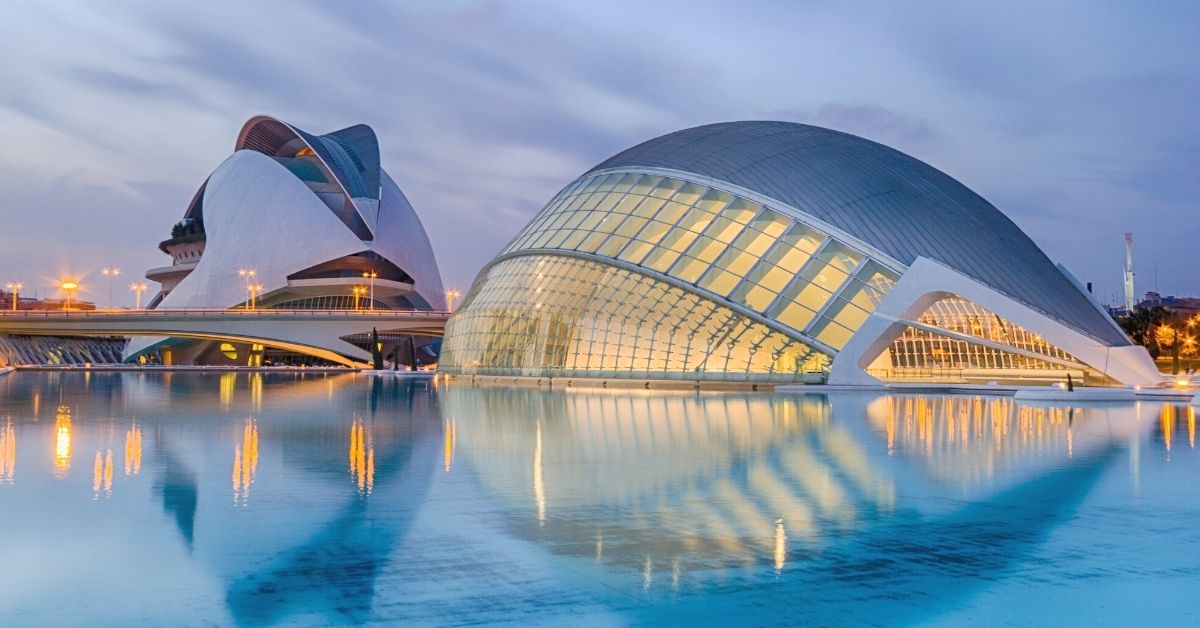
Valencia – Days 5 To 6
A 144 km drive further along the coast takes you to Valencia, the third-largest city in Spain.
There is some spectacular architecture to admire here, most notably the Old City Gate, the Torres de Serrano, and the main cathedral.
Much like Barcelona, the city’s historic architecture is interspersed with modern, arty buildings, making for interesting viewing!
For a real glimpse into Valencia’s everyday life, be sure to visit the Central Market, where you can choose from a wide variety of fresh food and produce.
Or – to get away from the hustle and bustle of the city – take a stroll through Jardines del Turia.
One of Spain’s largest urban parks, it is made up of 9 km of footpaths and secluded romantic spots, crossed by 18 bridges.
Not to be missed is The City of Arts and Sciences, a set of six buildings located at one end of the park and containing a botanical collection, oceanarium, opera house, theater, and more.
Murcia – Days 6 To 7
The last leg of this road trip around Spain runs from Valencia to Murcia and covers 228 km, taking around 2.5 hours.
Murcia is relatively undiscovered in terms of tourism, which makes it quieter than some of the busier spots and far more authentically Spanish.
Some excellent wines are made here and there are several vineyards to enjoy wine tasting experiences in the Bullas area.
Murcia’s old quarter is an excellent spot for shopping, with a nice mixture of designer boutiques and shops selling locally made arts and crafts.
But if you want to escape the crowds, one of the nicest places to walk is the Cape Palos peninsula, where you can visit the lighthouse at the tip for unspoiled views across the region.
From Murcia town, a 30-minute drive will take you to Archena, where you can visit a natural thermal spa and enjoy a mud massage – a great way to relax at the end of your trip!

Road Trip Itinerary For South Of Spain
This road trip in Spain takes in the beautiful Andalucía region.
This is an area of startling contrasts, where you can see everything from ancient cities and arid deserts, to soaring mountains and golden beaches.
- Granada
Almería – Days 1 To 3
The starting point for your trip is the fascinating city of Almería. There is so much to do here that I recommend spending one full day here and preferably two, to see as much as possible.
It happens to be one of the least crowded of the major Andalucían cities, making it easier to enjoy its many charms, and it is also the most affordable.
The most popular attraction is the Alcazaba, an enormous Moorish fortress. It is an interesting mixture of ancient ruins and rebuilt sections, along with much of the original building.
Be sure to also check out Almería’s cathedral, a 17th-century gothic building with Renaissance façades just 15 minutes away by road.
Almería receives a great deal of sunshine and such little rainfall that it has the only true desert climate in Europe.
Nowhere is this more clearly evidenced than in Cabo de Gata-Níjar Natural Park, a protected area to the east of the city.
Desolate and rugged, it allows you to see a stretch of desert with a backdrop of the blue sea – a unique and breathtaking view!
On your second day head west from the city to visit the vast, golden beaches of Roquetas de Mar, a popular tourist area where you can enjoy free tapas served with your drinks.
Granada – Days 3 To 4
Next, enjoy the 168 km drive to Granada, which should take around 1 hour and 50 minutes without stops.
The route takes you around the Sierra Nevada National Park which offers some great hiking opportunities, should you wish to stop off along the way.
Like Almería, Granada’s chief attraction is its stunning Moorish fortress, the Alhambra, made even more eye-catching with its background of the Sierra Nevada peaks.
This incredible compound – made up of palaces, courtyards, and gardens – started life as a citadel but eventually became the seat of Granada’s emirs.
Make sure you book your visit in advance as it gets very busy.
Spend an hour or two wandering around the Albaicín, the city’s old town, with its ancient streets rich in Islamic architecture.
And don’t miss Granada’s cathedral, built on top of its mosque at the start of the 16th century and the 2nd largest cathedral in Spain.
For souvenir hunting, head to Alcaiceria, originally the home of Granada’s Great Bazaar and the ideal place to find Moorish style earthenware and Taracea – beautifully inlaid wooden furniture and other wooden objects.
Other attractions in the area include the rock-hewn homes at Sacromonte and the lavishly decorated monastery Granada Charterhouse.

Málaga – Days 4 To 5
From Granada take the coastal route towards Málaga, a 149 km trip that should take around 1 3/4 hours without stops. Wondering if Malaga is worth visiting ? It is!
One of the best road trip routes in Spain, it passes Nerja and Torre del Mar, where it is worth stopping en route to enjoy some of the very best beaches in the area!
Due to its location on the touristy Costa del Sol, Málaga is sometimes overlooked as an interesting place to visit – but there is more to it than its lovely beaches!
The city has a fun and youthful vibe and – as the birthplace of Picasso – is an art lover’s dream, with galleries throughout the city.
There are also some stunning contrasts here, from lush gardens to rocky canyons!
Set aside time to visit the Jardín Botánico – Histórico La Concepción located at the northern entrance to the city.
Covering 23 hectares, these tranquil gardens have Europe’s largest collection of sub-tropical plans and are a wonderful place to get away from the lively buzz of the city.
If you are feeling adventurous, then check out the King’s Pathway (Caminito del Rey), once dubbed Spain’s most dangerous hike.
Jutting out from sheer cliff faces, the trail sits more than 100 meters over a ravine and gives incredible views across valleys, gorges, and reservoirs.
Seville – Days 5 To 6
The journey from Málaga to Seville is the longest of this road trip, covering 206 km and taking 2.25 hours.
There is lots to see and do in the colorful city of Seville, but for a short visit there are 3 ‘must see’ attractions to look out for.
The first is Real Alcázar – the royal residence of Andalucia’s capital and the oldest royal palace in Europe. It is extravagantly decorated, with every inch of its rooms and courtyards covered in amazing designs.
Boasting extensive gardens, sparkling fountains, and beautiful flowerbeds, Alcázar is home to the King of Spain whenever he visits the city.
Equally impressive is Seville’s vast cathedral – the third biggest in the world. Its awesome scale is reason enough to visit, but the fact that it contains the tomb of Christopher Columbus gives it even more appeal!
The cathedral’s bell tower – the Giralda Tower – is an attraction in itself, and you can walk right to the very top and get some incredible views across the city.
The tower has no steps – you can reach the top via a series of inclined ramps. But for the most unforgettable views of all, head to the recently built Metropol Parasol.
This controversial wooden structure resembles large mushrooms and is quite out of keeping with the local architecture.
But the 360 degrees from the top have made this a popular visitor attraction – there is even a cafe at the top to enjoy a relaxing drink as you look across the city.
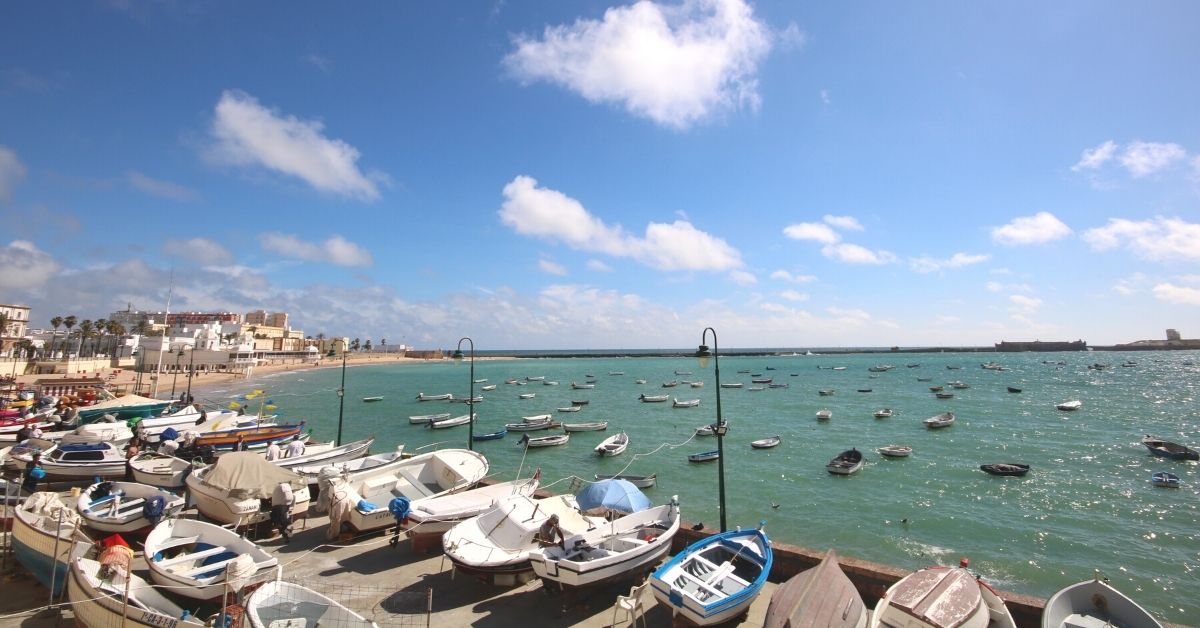
Cadiz – Days 6 To 7
The final leg of your journey is also the shortest, covering 121 km and taking around 1 hour and 20 minutes along highway AP4.
But if you don’t mind adding a little to your journey, it is well worth stopping in Jerez de la Frontera on the way.
One of southern Spain’s most beautiful destinations, it is relatively quiet compared to the better-known big cities but is popular for its horse fairs, its sherry, and flamenco.
Cadiz is the perfect spot to end your Spanish road trip. Covering just 4 square miles in area, this charming and authentically Spanish city is easy to explore on foot.
It is one of the oldest cities in western Europe and was also one of the continent’s most important ports, making for a fascinating history that is evident at every turn.
Admire the remains of a large Roman amphitheater as you stroll along the main street, or climb Torre Tavira and enjoy the spectacular views.
There are attractions for sun-worshippers here too, with award-winning golden beaches. La Caleta – located at the end of the peninsula – is a popular choice.
But if you want somewhere a little quieter, head into the new city and visit Santa María Del Mar.
Final Thoughts On Road Tripping In Spain
There are so many lovely Spanish road trips to choose from that it’s not always easy to decide where to visit.
Whether you want to see the lush green landscape of the north, the golden beaches of Spain’s east coast, or the amazing Moorish architecture of the south, I hope that you have been inspired by the best road trips listed here.
Enjoy your journey! If you need more inspiration, make sure to read our Spain bucket list .
Don’t forget any items on your road trip in Spain, with this essential road trip packing list .
Traveling to Europe soon? Read one of the following blog posts:
- How many days in Seville
- How many days in Lisbon
- How many days in Porto
- How to elope in Spain

MY TOP RECOMMENDATIONS
BOOK HOTEL ON BOOKING.COM
BOOK HOSTEL ON HOSTELWORLD
GET YOUR TRAVEL INSURANCE
LEARN HOW TO START A TRAVEL BLOG
LEARN HOW TO VOLUNTEER ABROAD


Travel in Spanish: How to Say It, Translations, and Pronunciation Tips
To say “travel” in Spanish, use “viajar.” This verb means to take a trip or journey. It relates to movement between places. Related terms include “el viaje” (the trip) and “mover” (to move). In casual contexts, you can say “ir a toda pastilla” to express quick movement.
Common travel-related phrases include “¿Dónde está la estación?” which means “Where is the station?” and “Necesito un taxi,” translating to “I need a taxi.” Understanding these terms can greatly enhance a traveler’s experience in a Spanish-speaking environment.
Pronunciation Tips: The letter “v” in Spanish sounds closer to a “b” in English. Therefore, “viajar” is pronounced like “bee-ah-har.” Emphasizing the sound of the “j” as similar to the English “h” will also aid in clear communication. Listen carefully to native speakers to grasp the nuances of pronunciation.
As you learn more about travel in Spanish, consider how to navigate common travel scenarios, such as ordering food or asking for directions. Next, we will explore essential vocabulary for dining and transportation.
Table of Contents
How Do You Say “Travel” in Spanish?
The word “travel” in Spanish is translated as “viajar.”
“Viajar” is a verb that forms the basis of discussing travel in the Spanish language. It conveys the action of moving from one place to another. Here are important aspects of the term “viajar”:
Verb Nature: “Viajar” is an infinitive verb. Infinitives in Spanish, like “viajar,” do not change with the subject. This makes it straightforward to use for expressing the concept of travel.
Usage in Sentences: You can create simple sentences using “viajar.” For example, “Me gusta viajar” means “I like to travel.”
Conjugation: The verb “viajar” can be conjugated to reflect different subjects and tenses. For instance, “yo viajo” means “I travel” in the present tense.
Related Terms: Understanding related terms helps to expand your vocabulary. “Viaje” means “trip,” while “viajero” translates to “traveler.”
Cultural Context: In many Spanish-speaking countries, travel is a common practice, often tied to family visits, tourism, and cultural exploration.
By learning the term “viajar” and its applications, you gain a valuable tool for discussing travel in Spanish.
What Is the Meaning of “Travel” in Spanish Context?
Travel refers to the act of moving from one place to another, often for leisure or exploration. In Spanish, this concept is translated as “viajar.”
The Royal Spanish Academy defines “viajar” as “desplazarse de un lugar a otro,” meaning “to move from one place to another.” This definition highlights the basic action involved in traveling.
Travel encompasses various aspects, including transportation, cultural experiences, and the pursuit of leisure activities. It allows individuals to explore diverse landscapes and engage with different communities and cultures.
According to Collins Dictionary, traveling can also involve “the journey and experiences associated with it,” emphasizing not only the physical movement but also the emotional and social impacts of the experience.
Several factors contribute to the act of traveling, including economic conditions, technological advancements, and changes in personal priorities. People travel for work, adventure, and personal enrichment.
In 2022, the United Nations World Tourism Organization reported that international tourist arrivals reached 917 million, showing a significant rebound from the pandemic. They project further growth, potentially exceeding pre-pandemic levels by 2024.
Travel impacts various sectors, such as economic growth, cultural exchange, and environmental sustainability. The tourism industry can generate jobs and foster international relations but may also lead to over-tourism and ecological damage.
Factors such as increased travel contribute to environmental challenges, including carbon emissions and local resource depletion. These influences can disrupt local ecosystems and strain community infrastructure.
To address the challenges of travel, experts recommend sustainable tourism practices. Initiatives may include promoting eco-friendly travel options and supporting local businesses.
Specific strategies include adopting carbon-neutral travel methods, utilizing smart booking technologies, and encouraging responsible tourism behaviors, which can maximize benefits while minimizing adverse effects.
What Are the Different Translations for “Travel” in Spanish?
The primary translations for “travel” in Spanish are “viajar” and “trasladarse.”
- “Trasladarse”
- “Viaje” (as a noun)
- “Desplazarse”
“Viajar” generally refers to the act of going from one place to another for pleasure, work, or other reasons. In contrast, “trasladarse” often implies moving between locations for various purposes, including relocation. “Viaje” refers to the trip or journey itself, often emphasizing the experience. “Desplazarse” is used to describe movement or transfer, often in the context of commuting. Understanding these nuances can help in choosing the right term based on context.
“Viajar”: “Viajar” is the most common translation of “travel” in Spanish. It specifically denotes the act of journeying for leisure or business. For example, “Me gusta viajar a España” means “I like to travel to Spain.” According to the Instituto Cervantes, this verb is widely understood across Spanish-speaking countries.
“Trasladarse”: “Trasladarse” translates to “to move” or “to transfer.” It is often used when discussing relocation or moving from one place to another, usually for work or other obligations. For example, “Me trasladé a otra ciudad por trabajo” means “I moved to another city for work.” This term emphasizes the act of moving rather than the experience of traveling.
“Viaje”: The term “viaje” means “trip” or “journey.” It is a noun that describes the specific travel experience. For instance, “El viaje fue increíble” translates to “The trip was amazing.” This word highlights the duration or event of travel rather than the act itself.
“Desplazarse”: “Desplazarse” refers to the act of moving or commuting and can be used in various contexts, such as daily commuting. An example is, “Me desplazo al trabajo en autobús,” meaning “I commute to work by bus.” This term is useful in formal or technical discussions about movement.
Understanding these translations and their contexts enables effective communication about travel in Spanish-speaking environments.
How Is “Travel” Translated in Various Tenses?
To translate “travel” in various tenses, we look at the verb “viajar” in Spanish. Here are the translations in different tenses:
- Present: yo viajo (I travel)
- Preterite: yo viajé (I traveled)
- Imperfect: yo viajaba (I was traveling)
- Future: yo viajaré (I will travel)
- Conditional: yo viajaría (I would travel)
- Present Perfect: yo he viajado (I have traveled)
- Past Perfect: yo había viajado (I had traveled)
- Future Perfect: yo habré viajado (I will have traveled)
Each tense provides a different context for when the travel action occurs. Present tense indicates an ongoing action. Preterite shows completed actions in the past. Imperfect expresses actions that were habitual in the past. Future and Conditional tenses describe actions that will happen or would happen. Perfect tenses reflect completed actions concerning another time frame. This structured approach ensures clarity in understanding how to use “viajar” in different temporal contexts.
What Are Common Synonyms for “Travel” in Spanish?
Common synonyms for “travel” in Spanish include “viajar,” “desplazarse,” and “moverse.”
- Desplazarse
These synonyms cover various aspects of movement and journeying. Next, let’s explore each synonym in detail.
Viajar : “Viajar” is the most common term for “travel” in Spanish. It encompasses the idea of going from one location to another, often for leisure or exploration. According to the Royal Spanish Academy, “viajar” implies a sense of adventure and experience connected to exploring new places. For example, “Voy a viajar a España” translates to “I am going to travel to Spain.” This term is widely understood in various Spanish-speaking countries.
Desplazarse : “Desplazarse” refers to the act of relocating or moving from one place to another. It is more formal than “viajar” and is often used in contexts involving commuting or migration. The term can apply to both short and long distances. A relevant example is “Me desplazo al trabajo en tren,” meaning “I commute to work by train.” This synonym may have nuances related to movement due to necessity rather than leisure.
Moverse : “Moverse” literally means “to move.” It conveys a broader sense of movement, not strictly related to long-distance travel. It can refer to changing positions or locations casually. For instance, “Debemos movernos a un lugar más seguro,” translates to “We must move to a safer place.” This term may lack the connotation of a journey compared to “viajar.”
Transitar : “Transitar” is a more formal term, often used in legal or technical contexts. It means to pass through or go across a particular area. For example, “Los vehículos no pueden transitar por esta calle,” translates to “Vehicles cannot pass through this street.” This term emphasizes the act of traveling through a specific route or area rather than the journey itself.
Understanding these synonyms will enhance your Spanish vocabulary and fluency in discussing various aspects of travel.
How Do You Pronounce “Travel” in Spanish Correctly?
The word “travel” in Spanish is pronounced as “viajar.”
To pronounce “viajar” correctly, consider the following details:
- Syllables: The word “viajar” has three syllables: vi-a-jar. Each syllable should be articulated clearly.
- Vowel Sounds: The “vi” sounds like “bee” in English. The “a” is pronounced like the letter “a” in “car.” The “jar” sounds similar to “har” in “hard,” but with a softer ‘j’ sound, much like the ‘h’ in “happy.”
- Stress: The emphasis in “viajar” falls on the second syllable. Pronounce “a” slightly louder and longer than the others.
- Phonetic Spelling: The phonetic spelling of “viajar” can be represented as “vee-ah-HAR.”
- Example Usage: A simple sentence would be “Me gusta viajar,” meaning “I like to travel.”
Practicing these elements will help with proper pronunciation of “viajar” in Spanish.
What Are Some Tips for Practicing Spanish Pronunciation?
To practice Spanish pronunciation effectively, consider these strategies.
- Listen to native speakers.
- Use pronunciation guides.
- Practice with tongue twisters.
- Record and playback your voice.
- Engage in shadowing exercises.
- Use language learning apps.
- Join conversation groups.
These tips provide varied approaches to improving pronunciation. Each method emphasizes practice and reinforcement in different contexts. Now, let’s delve deeper into each technique for better understanding.
Listening to Native Speakers : Listening to native speakers helps with pronunciation by exposing learners to authentic sounds and rhythms of the language. Resources like podcasts or Spanish songs are useful. For example, Werner (2023) in his research noted that exposure to natural speech patterns enhances pronunciation skills.
Using Pronunciation Guides : Pronunciation guides offer visual and audio cues for proper sound articulation. These guides may include phonetic alphabets like the International Phonetic Alphabet (IPA) that represent each Spanish phoneme. Studies by Ramirez (2022) indicate that the use of IPA in education improves learner retention of pronunciation techniques.
Practicing with Tongue Twisters : Tongue twisters challenge learners to articulate tricky sounds quickly, improving fluency and clarity. Phrases like “Tres tristes tigres” not only enhance pronunciation but also build confidence in speaking. Research by Lopez (2021) shows that engaging with tongue twisters can lead to higher levels of cognitive processing during speech.
Recording and Playback : Recording your speech allows learners to evaluate their pronunciation against native standards. This method fosters self-awareness and highlights areas needing improvement. A 2022 study by Gonzalez suggested that consistent playback of recordings can significantly enhance pronunciation accuracy.
Engaging in Shadowing Exercises : Shadowing involves mimicking a speaker in real-time while listening. This technique helps with intonation and rhythm, making speech sound more natural. Studies by Martinez (2023) confirm that shadowing improves linguistic rehearsal, leading to better retention of pronunciation patterns.
Using Language Learning Apps : Many language apps provide pronunciation practice with feedback features. Applications like Duolingo or Babbel facilitate learning through gamified experiences and interactive pronunciation tasks. Lee (2021) reports that apps enhance learner motivation, leading to more frequent practice.
Joining Conversation Groups : Participating in conversation groups promotes practical application of pronunciation skills in real dialogues. Interaction with peers or native speakers encourages learners to practice and refine their speech. According to a study by Torres (2020), social interaction is vital for language acquisition, including pronunciation improvement.
By incorporating these techniques regularly, learners can achieve better pronunciation in Spanish over time.
How Can You Use the Word “Travel” in Everyday Spanish Conversations?
You can use the word “travel” in everyday Spanish conversations by using its translations, understanding its conjugations, and applying it in common phrases.
The Spanish word for “travel” is “viajar.” Here are detailed explanations for using “viajar” in conversation:
Basic Usage: “Viajar” is a verb that means to move from one place to another, typically for leisure or education. For example, “Me gusta viajar” translates to “I like to travel.”
Present Tense Conjugation: In everyday conversation, you often use the present tense conjugation. For a singular subject, say “yo viajo” (I travel) or “tú viajas” (you travel). For a plural subject, use “nosotros viajamos” (we travel).
Common Phrases: Incorporate “viajar” in phrases. For example:
- “¿Dónde quieres viajar?” translates to “Where do you want to travel?”
“Viajar es una aventura” means “Traveling is an adventure.”
Expressing Plans: Use “viajar” to discuss future travel plans. For example, “Voy a viajar a España” translates to “I am going to travel to Spain.”
Past Tense Usage: When discussing past travel experiences, use the preterite form. For example, “Viajé a México” translates to “I traveled to Mexico.”
Related Vocabulary: Incorporate related words such as “el viaje” (the trip) or “viajero” (traveler) to expand your conversation.
By understanding these elements, you can effectively use “travel” in daily Spanish conversations.
What Related Phrases Can Enhance Your Travel Vocabulary in Spanish?
To enhance your travel vocabulary in Spanish, focus on learning related phrases that are commonly used in travel contexts. These phrases will help you communicate effectively during your trips.
- Greetings and Basic Expressions
- Transportation Vocabulary
- Accommodation Phrases
- Dining and Food Terminology
- Emergency and Safety Terms
- Sightseeing and Entertainment Vocabulary
Knowing these phrases is essential for smooth communication while traveling. Here’s a detailed explanation of each type.
Greetings and Basic Expressions : Greeting phrases establish rapport and show courtesy. Common expressions include “Hola” (Hello), “¿Cómo estás?” (How are you?), and “Gracias” (Thank you). Using these phrases can help you engage with locals and foster a positive interaction.
Transportation Vocabulary : Transportation phrases are critical for navigating cities and finding your way. Key terms include “autobús” (bus), “taxi” (taxi), and “estación” (station). Knowing these terms aids in asking for directions and understanding schedules.
Accommodation Phrases : Accommodation phrases are useful for booking and checking into hotels or hostels. Essential vocabulary includes “reserva” (reservation), “habitación” (room), and “check-in” (check-in). Mastering these terms can simplify the process of finding a place to stay.
Dining and Food Terminology : Dining vocabulary enhances your experiences in restaurants. Important phrases include “menú” (menu), “cuenta” (check/bill), and “comida” (food). This vocabulary helps in ordering meals and understanding local cuisine.
Emergency and Safety Terms : Emergency phrases are vital for safety and well-being. Key terms include “ayuda” (help), “póliza” (insurance), and “policía” (police). Familiarity with these words ensures you can seek assistance when necessary.
Sightseeing and Entertainment Vocabulary : Sightseeing phrases allow you to engage in cultural experiences. Important terms include “museo” (museum), “entrada” (ticket), and “tour” (tour). Knowledge of these words enriches your interactions at attractions and events.
By learning these phrases, you can improve your Spanish vocabulary and navigate travel situations more effectively.
How Does Knowing How to Say “Travel” Improve Your Spanish Skills?
Knowing how to say “travel” improves your Spanish skills in multiple ways. First, it enhances vocabulary. “Travel” translates to “viajar” in Spanish. Learning this word allows you to express the concept of going from one place to another. Second, it improves communication. You can use “viajar” in sentences, such as “Me gusta viajar,” which means “I like to travel.” This practice helps you construct more complex sentences.
Third, it aids in understanding context. Recognizing “viajar” in conversations boosts your comprehension. You start to grasp the nuances of discussions about trips, vacations, and journeys. Fourth, it builds confidence. Using the word “viajar” helps you participate in conversations about travel more effectively.
Finally, it connects to cultural aspects. Understanding the importance of travel in Spanish-speaking cultures enriches your learning experience. Thus, mastering the word “travel” is a foundational step that supports overall language development.
Why Is Travel Vocabulary Important for Spanish Learners?
Travel vocabulary is important for Spanish learners because it enhances communication skills in various travel situations. Knowing the right words allows learners to navigate transportation, accommodation, dining, and cultural interactions effectively.
The American Council on the Teaching of Foreign Languages (ACTFL) emphasizes that vocabulary acquisition plays a critical role in language proficiency. According to their framework, travel-related vocabulary aids learners in practical communication, thereby facilitating immersive experiences while traveling.
The significance of travel vocabulary stems from several reasons:
- Practical Communication : Spanish learners need specific words and phrases to interact with locals.
- Cultural Understanding : Knowing travel vocabulary also helps learners understand cultural nuances related to travel.
- Safety and Navigation : Familiarity with terms related to directions, transportation, and emergency situations is essential for personal safety.
Key terms associated with travel vocabulary include:
- Accommodation : The various options for places to stay while traveling, such as hotels and hostels.
- Itinerary : A detailed plan or schedule of travel activities.
These terms facilitate effective communication during travels.
Understanding travel vocabulary involves recognizing how words function in context. For instance, knowing how to ask for directions improves the traveler’s ability to navigate new environments. Learning vocabulary is more than memorizing words; it is about understanding their use in a sentence.
Conditions that enhance the learning of travel vocabulary include frequent practice, immersion in Spanish-speaking environments, and the use of language apps or online courses. For example, learners can practice asking questions in a market, ordering food in a restaurant, or planning a route using public transport. These scenarios reinforce vocabulary retention and improve fluency.
In summary, travel vocabulary is essential for Spanish learners to communicate effectively, understand cultural contexts, and ensure personal safety during travel. Knowing specific terms enhances the overall travel experience.
- How do you put a travel cot up
- How do you normally travel
- How do you fast travel in tomb raider
- What is astral travel
- How do you apply for a gsa smartpay travel account

COMMENTS
10 Epic Spain Road Trips - Maps, Itineraries and Tips
Spanish road trip map. Spain driving map. Screenshot via Google Maps. Click the map to open. Detailed self drive Spain itinerary. This section includes a detailed day-by-day breakdown of our 3 weeks in Spain, including the best things to do in each city, where to stay, and where to break up longer drives.
5. Ibiza road trip. Best road trip for coves and beaches Ibiza Town - Cala d'Hort; 35km (22 miles), allow 1-2 days. Renting a car in Ibiza is the best way to explore the island's stunning calas (or coves): having your own wheels will save you both time and expensive taxi fares. While the island has a reputation as a 24/7 party ...
Day 4: Hiking in Anaga National Park. Day 5: Orotava, Icod de los Vinos and Garachico. Day 6: Pyramids of Guimar. Day 7: Explore La Laguna and fly home. This article is part of a complete tutorial about car rental in Spain where you can read all the information you need to organize your road trip around the country.
Translate Road trip. See 2 authoritative translations of Road trip in Spanish with example sentences and audio pronunciations.
This epic Spanish road trip starts in the Catalan capital - Barcelona. One of the best things about going on a road trip to Spain is the weather - check out the best time to visit Spain to pick your month of travel. Catalonia is beautiful and captivating all year round - so get ready for the adventure of a lifetime.
Spanish Road Trip. Spain is known for annual celebrations and traditions and so if you fancy getting involved whilst on your Spanish road trip, it is a good idea to plan your travel accordingly. Use Get Your Guide to pre-book tours and attractions. Top 5 events unmissable events to see on your Spain road trip: 'Las Fallas' in Valencia on 15 ...
Driving in Spain: Things to Know. The Best Road Trip Routes in Spain. Galicia. Cantabria & Asturias. Basque Country. Catalonia. Barcelona to Madrid. Mediterranean Coast: Catalonia to Andalusia. Ruta de la Plata: Northern to Southern Spain.
Best Spanish Road Trips in the Mainland Costa Brava. By Naomi from Probe Around the Globe. Route: Circular road trip from Barcelona. Days: 3. Escape Barcelona and go for a slower-paced life with one of the most scenic drives in Spain! A road trip around Spain's Costa Brava region is perfect for discovering sandy beaches, a rugged coastline, great food, culture, and history!
The Spanish Pyrenees 4-day Road Trip Itinerary Visiting the Pyrenees of Spain My trips to the Pyrenees. Despite our recent Mediterranean cruise, a unique trip to the lesser-known Soria, and a sunny weekend getaway in Murcia the highlight of this summer for me was definitely our Spanish Pyrenees road trip.. Let me warn you that in this beautiful region of Spain, you will find everything from ...
A road trip in Spain - just the mere mention conjures up images of scrumptious tapas, ambrosial wine, affectionate and fun-loving people, pristine beaches, stunning landscapes, and architecture that spans pretty much all ages.. Today, we take you on a journey from Andalucía in the South of Spain all the way up to Figueres in the North-East with a suggested itinerary for a Spanish road trip ...
A Spain Road Trip: Perfect for Slow Travelers. Spain is one of Europe's top places to slow travel, and these 13 ideas for Spanish road trips — from the verdant north of Spain to the mountainous interior down to the stunning Andalucia coast and the arid Natural Park of Cabo de Gata — are some of the best road trips in Spain.. You'll even find several road trip routes in the Spanish ...
15 days in Spain: Planning the best route for a 2 weeks road trip! Days 1 & 2: Barcelona - 1st stop of your Spanish road trip! Day 3: Girona. Days 4 & 5: Valencia. Days 6 & 7: Madrid - A must in your Spain Roadtrip. Day 8: Toledo. Days 9 & 10: Seville. Days 11 & 12: Malaga. Day 13: Ronda and Pueblos Blancos road trip.
A road trip in Spain is the best way to explore the country's heart, to truly go beyond its famous cities and towns to get to know its fabulous villages and smaller towns. Renting a car for a Spanish road trip is the best way to travel in this gorgeous country, especially if you travel for the first time.
Madrid, Toledo and Central Spain. 640. Historical cities, Spanish cuisine. Toledo is known as the "City of the Three Cultures". Fuerteventura, the Best Itinerary in the Canary Islands. 300. Beaches, natural parks. Fuerteventura is famous for its wind sports. Costa Brava Road Trip along Spain's Mediterranean Sea.
Northern Spain Road Trip Itinerary. Road Trip Through Tenerife (Canary Islands) Road Trip Through Catalonia (Catalunya) Road Trip Through Central Spain. Driving the Balearic Islands. Road Trip Along Spain's East Mediterranean Coast. Road Trip Across Galicia. Road Trip Around the Basque Country.
The Ultimate Spain Road Trip Itineraries: Routes, Sights, Guides, Maps And More. Last Updated: May 21, 2024. From San Sebastian's world-famous food scene and the attractions of Barcelona, to the incredible museums of Madrid, history of Granada and beaches on the Costa del Sol, this Spain road trip has it all! Road tripping past perfect ...
Northern Spain Road Trip: Santander — San Sebastian — Zaragoza — Barcelona — La Molina. Driving Distance: 924 km Driving Time: 10 hours and 20 minutes Route: See map. This Northern Spain road trip from Santander to Barcelona and the Pyrenees packs fantastic diversity in a relatively small area.
Step 2: From Barcelona to the Costa Daurada and Terres de l'Ebre: southbound. A road for lovers of hairpin bends and cliff-top views, the C-31 runs from Castelldefels to Sitges. Its proximity to the coast means fantastic views are guaranteed, but remember to drive very carefully. Distance:240km Journey: By car.
Barcelona, the start of the Costa Brava road trip. 📍 Google Maps Route | 🛣️ End-to-End Length: 144 miles (4 hours driving) | 🗺️ Highlights: Barcelona, Blanes, Lloret De Mar, Tossa De Mar, Palafrugell, Begur, Figueres, Cadaqués. The Costa Brava route is one of the best road trips for beach lovers with limited time.
Whether you drive within your city or you plan a cross-country trip, this driving vocabulary is a must when talking about roads and traffic in Spanish! English. Spanish. back seat. el asiento trasero. blinker. la luz de emergencia. car. el automóvil, el carro.
A Southern Spain road trip.. What started as an innocent hunt for early spring sunshine was, it turned out, the start of a Spanish love affair; unexpected and instant, Southern Spain would become a strong contender for the perfect European road trip and no itinerary in Spain is complete without a visit to this extraordinary province.
Santiago De Compostela - Days 6 To 7. Road Trip Itinerary For East Of Spain. Barcelona - Days 1 To 3. Tortosa - Days 3 To 4. Peñíscola - Days 4 To 5. Valencia - Days 5 To 6. Murcia - Days 6 To 7. Road Trip Itinerary For South Of Spain. Almería - Days 1 To 3.
To say "travel" in Spanish, use "viajar." This verb means to take a trip or journey. It relates to movement between places. Related terms include "el viaje" (the trip) and "mover" (to move).